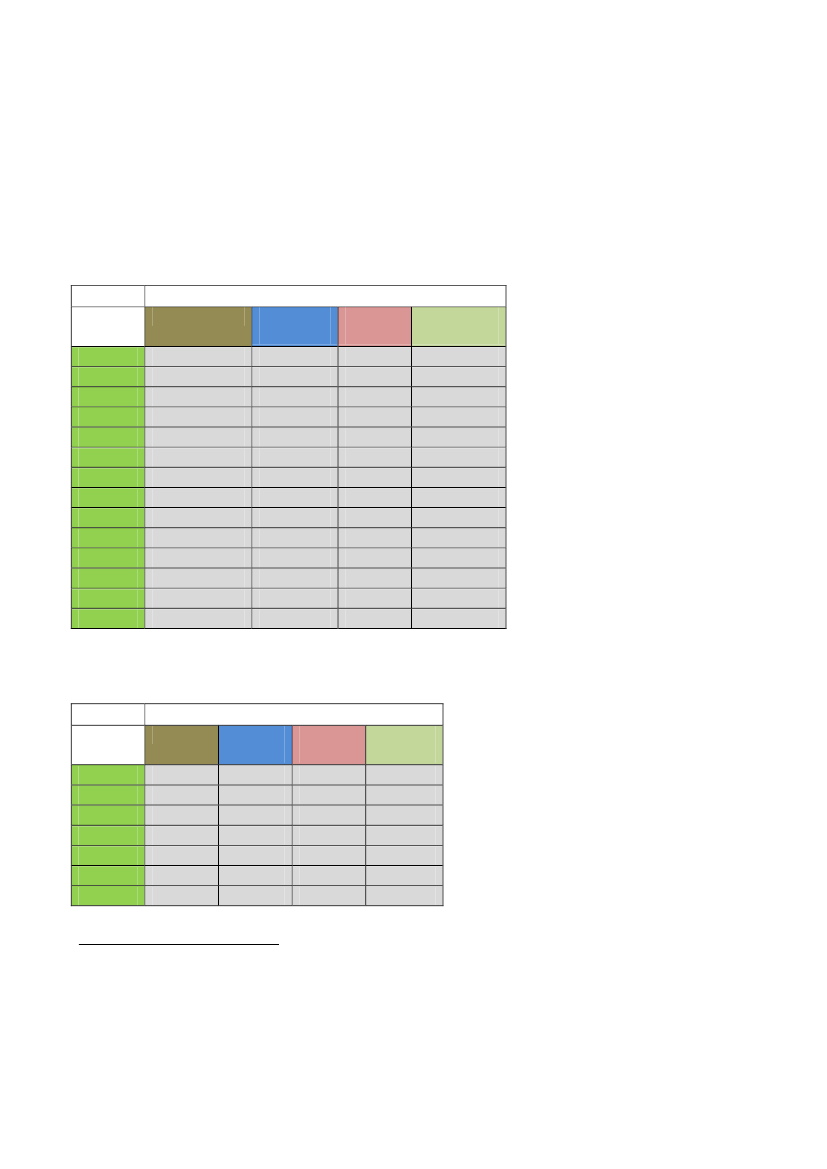Beskæftigelsesudvalget 2012-13
BEU Alm.del
Offentligt
Ref. Ares(2012)763789 - 25/06/2012
Final Study
Authors:
Yves JorensSaskia PetersMijke HouwerzijlJune 2012
Study on the protection of workers' rights in subcontracting processes in theEuropean UnionProject DG EMPL/B2 - VC/2011/0015Contractor:Ghent University, Department of Social Law, Universiteitstraat 4, B-9000 Gent (in consortiumwith University of Amsterdam)Disclaimer:The information contained in this publication does not necessarily reflect the position oropinion of the European Commission.
National ExpertsFlorian BurgerYves JorensKrassimira SredkovaEva SoumeliPetr HurkaMartin Gräs LindMerle MudaUlla LiukkunenBarbara PalliMonika SchlachterCostas PapadimitriouJózsef HajdúMichael DohertyGiovanni OrlandiniKristine DupateTomas DuvalisGuy CastegnaroAriane ClaverieRoselyn KnightLucy van den BergSaskia PetersStein EvjuMonika TomaszewskaJulio GomesMaria Cristina AnaAndrea OlsovskaLuka TicarJoaquin Garcia MurciaAngeles Ceinos SuárezKerstin AhlbergLinda ClarkeIan FitzgeraldLucinda HudsonAustriaBelgiumBulgariaCyprusCzech RepublicDenmarkEstoniaFinlandFranceGermanyGreeceHungaryIrelandItalyLatviaLithuaniaLuxembourgLuxembourgMaltathe Netherlandsthe NetherlandsNorwayPolandPortugalRomaniaSlovak RepublicSloveniaSpainSpainSwedenUnited KingdomUnited KingdomUnited Kingdom
2/192
ContentsChapter 1 Introduction .......................................................................................................................................... 5I.II.Background/policy context of the project ...................................................................................................... 5Aims, method and outline of the study .......................................................................................................... 7A. Aims and outline of the study ................................................................................................................ 7B. Research method.................................................................................................................................... 8Definitions of key terminology used ............................................................................................................... 8
III.
Chapter 2 Setting the scene ................................................................................................................................. 12I.II.III.Introduction .................................................................................................................................................. 12Relevant measures at EU level ...................................................................................................................... 12An overview of ‘general’ responsibility/liability measures ........................................................................... 15A. Measures regarding wages, including holiday payments ..................................................................... 15B. Measures regarding social fund payments........................................................................................... 17C. Measures regarding occupational health & safety, including working time ........................................ 18D. Measures regarding tax on wages and social security contributions ................................................... 20E. Functional equivalents/alternatives, including corporate social responsibility ................................... 24An overview of ‘specific’ responsibility/liability measures ........................................................................... 27A. Measures regarding undeclared/illegal (migrant) labour .................................................................... 27B. Measures regarding temporary agency workers.................................................................................. 28C. Measures within the framework of public procurement/public works ............................................... 29An overview of responsibility/liability measures from a country perspective ............................................. 34A. No measures, government measures or measures initiated by social partners .................................. 34B. Sectoral or general scope ..................................................................................................................... 37C. Nature of responsibility/liability measures .......................................................................................... 38Liability systems and the case Law of the European Court of Justice ........................................................... 40Summarising and concluding remarks .......................................................................................................... 44A. A brief summary of the findings ........................................................................................................... 44B. Concluding remarks .............................................................................................................................. 45
IV.
V.
VI.VII.
Chapter 3 A detailed review of relevant national laws on responsibility and joint and several liability insubcontracting processes .................................................................................................................... 46I.II.Introduction .................................................................................................................................................. 46(Statutory, conventional, soft law) arrangements on wages ........................................................................ 46A. Origins and main objectives ................................................................................................................. 46B. Nature and coverage ............................................................................................................................ 50C. Preventive measures ............................................................................................................................ 58D. Sanctions .............................................................................................................................................. 61(Statutory, conventional) arrangements on social funds payments ............................................................. 63A. Origins and objectives .......................................................................................................................... 63B. Nature and coverage ............................................................................................................................ 64C. Preventive measures ............................................................................................................................ 66D. Sanctions .............................................................................................................................................. 67Health & Safety arrangements ...................................................................................................................... 67A. Origin and objectives ............................................................................................................................ 67B. Nature and coverage ............................................................................................................................ 68C. Preventive measures ............................................................................................................................ 75D. Sanctions & complaint mechanisms ..................................................................................................... 763/192
III.
IV.
V.
Other arrangements ..................................................................................................................................... 76A. Origins and objectives .......................................................................................................................... 76B. Nature and coverage ............................................................................................................................ 81C. Preventive measures ............................................................................................................................ 88D. Sanctions .............................................................................................................................................. 90Concluding remarks ...................................................................................................................................... 92
VI.
Chapter 4 The practical impact of the rules – particularly in the framework of cross-border subcontracting ......... 97I.II.Introduction .................................................................................................................................................. 97Application of the rules in practice – specifically in cross-border situations ................................................ 98A. Wages and other employment conditions ........................................................................................... 99B. Health & safety arrangements ........................................................................................................... 108Enforcement of the implemented norms and instruments – specifically in cross-border situations......... 113A. Wages and other employment conditions ......................................................................................... 113B. Health and safety................................................................................................................................ 118C. Collaboration with foreign actors and institutions ............................................................................. 120D. The relevance of EU level cross-border legal instruments in force allowing foreign administrationsand other creditors to be paid............................................................................................................ 122E. The place and role of the measures in the overall system of enforcement of labour law ................. 123Social fund payments .................................................................................................................................. 124Temporary agency work ............................................................................................................................. 125SMEs............................................................................................................................................................ 128A comparative examination of positive issues, problems, deficiencies or shortcomings ........................... 134
III.
IV.V.VI.VII.
Chapter 5 Conclusions and recommendations ................................................................................................... 144I.A schematic overview ................................................................................................................................. 144A. Joint and several liability mechanisms for labour conditions: a widespread phenomenon in theEuropean Union? ................................................................................................................................ 144B. Occupational health and safety .......................................................................................................... 145C. Illegal Employment ............................................................................................................................. 146D. The legal nature of the provisions ...................................................................................................... 148E. A limited scope? ................................................................................................................................. 150F. Direct versus chain liability ................................................................................................................. 151G. Possibilities to exclude liability ........................................................................................................... 152H. Conclusion .......................................................................................................................................... 153Some general conclusions and recommendations ..................................................................................... 154A. The reasons why the introduction of a system of joint and several liability for the protection ofworkers’ rights and to fight unfair competition is called for .............................................................. 154B. Arguments pro and contra the introduction of a system of joint and several liability ...................... 157C. Up to the future: How to protect the workers of subcontractors? Joint and several liability and theneed for flanking measures ................................................................................................................ 160National jurisprudence on liability (core reports) ....................................................................................... 165Interviewed organizations (core reports) ................................................................................................... 171National legislations and liability ................................................................................................................ 175Summary table identifying the different types of measures and variables upon which authorities canintervene to enforce joint liability in the field of wages. ............................................................................ 191
II.
Annex I:Annex II:Annex III:Annex IV:
4/192
Chapter 1I.
Introduction
Background/policy context of the project
Since the late 1980s, the Member States of the European Union have witnessed a rapid growth ofsubcontracting as a method for firms and organisations to externalise certain tasks, encompassingincreasingly long and sometimes parallel chains of interconnected companies. Due to the steadily evolvingintegration and enlargement of the internal market, leading to a greater movement of capital and labouracross countries, subcontracting chains more and more often involve companies from different MemberStates. The phenomenon is particularly widespread in the construction sector, but it is also a commonfeature of other economic sectors such as transport, tourism or the cleaning industry. On the one hand,subcontracting has been encouraged by national and European policy makers and stakeholders because ofthe flexibility it creates for companies, which was deemed to benefit economic activity and job creation. Onthe other hand, the growing use of subcontracting especially in labour intensive industries led to concernsabout the possible deterioration of workers’ rights at the lower ends of long subcontracting chains, sincethe client and/or the principal contractor have no direct legal and social responsibility for the payment ofwages, taxes and social security contributions on behalf of the employees of their subcontractors.The European Commission has addressed this issue in the 2006 Green Paper on ‘Modernising labour law tomeet the challenges of the 21st century’ and in its Communication of 2007 on the outcome of the EU-widepublic consultation on the green paper. The latter reflected the conflicting opinions of various stakeholdersabout the systems of joint and several liability adopted by several Member States to tackle the problematicprotection of workers’ rights in subcontracting processes. The question whether such joint and severalliability arrangements are in accordance with Community law, in particular the free provision of services inthe internal market, was raised in two judgements of the European Court of Justice in 2004 and 2006. Inthe Wolff-Müller case (C-60/03), the Court ruled that the German liability scheme for wage payments couldbe assessed (under certain conditions) as a justified measure, whereas the Belgium scheme of joint liabilityfor tax debts was deemed to be a disproportionate and thus an unjustified measure in the Commission vBelgium case (C-433/04).Meanwhile, the issue of workers’ rights protection in subcontracting processes also caused debate in theEuropean Parliament, which adopted several resolutions on the issue. The last one, dating from 2009,called on the Commission to develop a legal instrument introducing joint and several liability for general orprincipal undertakings. Indeed, by adopting Directive 2009/52/EC on sanctions and measures againstemployers of illegally staying third-country nationals, the EU legislator did for the first time introduce chainliability rules in the framework of subcontracting processes. Where the employer is a subcontractor, theDirective, under certain conditions, provides for a mechanism of joint and several liability with respect tofinancial sanctions as well as back payments relating to outstanding remuneration; liability may also beextended to those in the subcontracting chain who knew that the subcontractor employed illegally stayingthird-country nationals.In its resolution of 2009, the European Parliament also asked the European Commission to launch a cross-sectoral impact assessment on the added value and feasibility of such an instrument at Community level,referring to the study carried out in 2008 by the European Foundation for the Improvement of Living andWorking Conditions (Dublin) on 'Liability in subcontracting processes in the European construction sector'(hereinafter ‘the Dublin study’). The Dublin study identified eight Member States where legislative and/orself-regulatory instruments on joint and several liability in subcontracting chains have been introduced. Thestudy was limited to the construction sector and did therefore neither cover possible arrangements inother sectors nor protective measures which are neither part of nor linked to any liability scheme. One ofthe study’s findings was that most of the liability arrangements did not seem to be very effective in theprotection of workers' rights in cross-border subcontracting processes.
5/192
In this regard, Directive 1996/711is of specific relevance. This so-called Posting of Workers Directive(hereinafter PWD) sets the employment conditions of workers who are temporarily posted to provideservices in a Member State different from the one where they have their original employment contract. Itestablishes a hard core of clearly defined terms and conditions of work and employment for minimumprotection of workers (laid down in Article 3 (1) a - g) that must be complied with by the service provider(for the purpose of this study: the subcontractor) in the host Member State. So, the PWD establishes forwhich subject matters mandatory (minimum) local labour standards must be fulfilled by the employer vis-à-vis the workers he posts in e.g. the framework of providing cross-border services in his capacity as asubcontractor.Despite the protection offered by the PWD, the phenomenon of the posting of workers in the framework ofthe provision of services still raises complex issues that have made this one of the most controversialaspects of EU labour legislation. Especially after the 2004 enlargement, the difficulties with the applicationof the PWD have become more numerous, in particular in situations where transitional measures withrespect to the free movement of workers were applied. Moreover, the judgements of the European Courtof Justice in the Viking, Laval, Rüffert and Commission vs Luxembourg cases gave rise to an intense debatebetween EU and national policy makers, academics and social partners on the interpretation of the PWD, aswell as more generally on their consequences for the protection of workers' rights and the right to takecollective action by trade unions.In this context, several research projects were launched by or supported by the EC, which are closelyconnected to the cross-border aspects of the topic covered by the present study.2The impression thatposted workers may be vulnerable given their situation (temporary employment in a foreign country,difficulty to obtain proper representation, lack of knowledge of local laws, institutions and language) wasclearly confirmed by the commissioned or supported research and recommendations that were made toaddress identified shortcomings. In the meantime, the EC’s Single Market Action Plan adopted as one of itskey actions “Legislation aimed at improving and reinforcing the transposition, implementation andenforcement in practice of the Posting of Workers Directive, which will include measures to prevent andsanction any abuse and circumvention of the applicable rules, together with legislation aimed at clarifyingthe exercise of freedom of establishment and the freedom to provide services alongside fundamental socialrights.”3An impact assessment study is currently being undertaken.For the situation of posted workers involved in subcontracting processes, the studies by Van Hoek andHouwerzijl on the implementation, application and enforcement of the Posting of Workers Directive in all27 Member States are of particular relevance.4In these two legal studies, firstly a detailed overview can befound of the obligations of the direct employer (for the purposes of the current study: the subcontractor)with regard to his cross-border posted workers. Where appropriate, explicit reference is made to thesereports, under the abbreviation PWD1 and PWD2.51
2
34
5
Directive 96/71/EC of 16 December 1996 concerning the posting of workers in the framework of the provision ofservices.These projects resulted in the following studies: “Posted workers in the European Union", by EIRO October 2010;"The legal aspects of the posting of workers in the framework of the provision of services in the EuropeanUnion", by Aukje van Hoek and Mijke Houwerzijl, March 2011; "Economic and social effects associated with thephenomenon of posting of workers in the EU", by IDEA consult/Ecorys, March 2011; “In search of cheap labour inEurope", by CLR/EFBWW, December 2010; "Information delivered as regards posted workers", by FabienneMüller/ Strasbourg, October 2010; “Joining up in the fight against undeclared work in Europe. Feasibility study onestablishing a European platform for cooperation between labour inspectorates, and other relevant monitoringand enforcement bodies, to prevent and fight undeclared work” by Regioplan, December 2010.COM (2011) 206, April 2011.See for the ‘PWD1 study’ of 31 March 2011: ec.europa.eu/social/BlobServlet?docId=6677&langId=en . This studyconcerns the following 12 EU Member States: BE, DE, DK, EE, FR, IT, LU, NL, PL, RO, SE, UK. The complementaryPWD2 study of November 2011 on the other 15 Member States (AT, BG, CY, CZ, EL, ES, FI, HU, IE, LT, LV, MT, PT,SI, SK) is not yet published.See in particular section 2.3 of PWD1 and section 2.3 of PWD2.6/192
Norway is not included in the PWD1 and PWD2 studies. Therefore, we provide here a brief description ofthe extent to which labour standards in Norway as a host country apply to posted workers. In this country,the General Applicability Act (GAA) may be seen as a statutory machinery for fixing minimum standards,including minimum wages. The Act itself does not provide for any substantive rules, but grants devolvedlegislative power to issue regulations regarding terms and conditions of employment toTariffnemnda– anindependent administrative law body, with representation from the relevant social partners. Theseregulations apply to all employees, domestic and foreign, irrespective of whether they are posted workersor not and regardless of whether they are EU/EEA or third country nationals. The General Application Actwas adopted in 1993 with a view to counteracting social dumping and safeguarding prevailing standards ofwages and working conditions. The PWD was implemented in 2000 by, inter alia, separate Regulations onPosted Workers. These Regulations refer to the General Application Act with regard to pay. In case of cross-border postingTariffnemndamay only extend minimum wage standards in collective agreements.
II.A.
Aims, method and outline of the studyAims and outline of the study
The overall objective of this project is to describe, analyse and assess the aims, objectives, functioning andeffectiveness of existing mechanisms, notably joined and several liability and chain liability schemes, withrespect to ensuring the protection of workers' rights in subcontracting processes in the EU and Norway,understood in the broadest possible way. Subcontracting refers to situations where an entity (B) contractsout to another entity (C) the provision of goods or services for its own needs. This includes cases commonlydenoted “outsourcing”, i.e. where B’s contracting-out to C is not directly linked to A having ordered theprovision of certain goods or services by B.On the basis of this comparative study, the analysis will further focus on the degree of effectiveness ofprovisions aimed at ensuring the protection of workers’ rights in subcontracting processes and identifyfeatures, which are common to several Member States, as well as to their interaction with other existinginstruments and mechanisms.Finally, this study will also formulate recommendations for possible improvements in the protection ofworkers' rights in the framework of subcontracting, including in cross-border situations.To these ends:In Chapter 2, a comparative survey is given of (legislative, administrative and conventional) measurescurrently applied in the EU Member States and Norway, which were identified as aiming, directly orindirectly, at making actors other than the direct employer co-responsible or liable for ensuring the socialprotection of workers employed by undertakings acting as subcontractors for a client undertaking.
In Chapter 3 and 4, a detailed review of relevant national law on responsibility and joint and several liabilityin (cross-border) subcontracting processes is presented. For this reason, the measures and mechanismsapplicable in a representative sample of ‘core’ countries were explored more in detail than the situation inthe other countries. The ‘core countries’ are : Austria, Belgium, Finland, France, Germany, Ireland, Italy,Luxembourg , the Netherlands, Norway, Poland, Spain, Sweden and United Kingdom.Chapter 3 deals with the details of the relevant protective measures regarding workers in subcontractingprocesses, predominantly concerning wages and other employment conditions. The origin of legislation,objectives, coverage, types of tools (preventive measures and sanctions) and common features and
7/192
elements between the liability arrangements in the Member States are identified. Subsequently, Chapter 4describes and analyses their degree of relevance and effectiveness in practice. Here again, we identifycommonalities and differences and we assess the overall difficulties and best practices encountered in theapplication and enforcement of the national liability arrangements.In Chapter 5, conclusions are drawn and recommendations are made as to the ways and means to ensureand/or improve the protection of the employment conditions of workers in subcontracting processes,including in cross-border situations, as well as the formulation of relevant mechanisms.
B.
Research method
In light of the exploratory nature of the study, the research in all the countries studied (the 27 MemberStates and Norway) was based on qualitative review and analysis of primary sources such as legislative andself-regulatory measures, as well as secondary sources such as existing literature, (case) studies, policystatements, reports and publications by social partners and policy makers, relevant statistical data –if any –and case law.Although in this manner a systematic review has been undertaken with a view to measures andmechanisms that make actors other than the direct employer co-responsible or liable for ensuring thesocial protection of workers in subcontracting processes, it must be noted here that the findings in somecountry studies are more often highlighted than others. The reason for this rather uneven spread ofattention is that in many of the countries reviewed, the kind of responsibility/liability measures looked forare virtually non-existent. Hence, we would like to emphasise that all the country studies have contributedto the comparative overview and analysis in this study, also the ones which are not highlighted because not(m)any relevant measures were found.Next to the abovementioned method of qualitative review and analysis of primary and secondary sources,information for the representative sample of 14 core countries was also collected by approaching thecompetent authorities and/or offices of the countries covered by the study, employers' associations,businesses and trade unions, especially in sectors where subcontracting is widespread (e.g. construction).For this purpose, the national experts conducted, where appropriate, face-to-face or telephone interviewswith the national authorities, such as labour inspectors, the relevant social partners and other professionalbodies involved (for an overview see Annex II) , based on questionnaires drafted by the lead researchers ofthis research project.
III.
Definitions of key terminology used6
Below, we introduce the key terminology used in this report.The actors involved in subcontracting processesIn terms of the parties involved, subcontracting processes usually feature a ‘client’, ‘owner’, ‘principalcontractor’ and one or more ‘subcontractors’.
6
Mainly drawing from Chapter 1 of the ‘Dublin report’, where, in turn, the definitions of the client, owner andcontractor were drawn from the GAIPEC report of 1992 coordinated by FIEC on product liability in theconstruction industry.8/192
The clientThe subcontracting chain starts with the client, who is defined as: ‘any natural or legal person, public orprivate, who orders and/or pays for the works that are the object of a contract’ (the term ‘customer’ issometimes used but avoided in this study).The ownerOften, the client will also be the ‘owner’. The latter term refers to ‘any natural or legal person, public orprivate, who has for the time being, whether permanently or temporarily, legal title to the building or whois legally responsible for its care and maintenance’. In this study, the use of the term ‘client’ is preferredand shall be taken to include the term ‘owner’, except where the context does not permit this.The contractorThe client hires one or more ‘contractors’. A contractor may be defined as ‘any participant who agrees tocarry out the physical execution of the works that are the object of a contract’.The principal contractorIf the client only engages the services of one contractor to carry out all the work, then obviously no chain ofsubcontracting exists. However, the client may also employ the services of a single contractor who isresponsible for the entire building project, but who, in turn, outsources part of the work to othercontractors. In this case, the first contractor is referred to as the ‘principal contractor’ (sometimes alsoreferred to as the ‘main contractor’).The subcontractorsThe contractors hired by the principal contractor are known as the ‘subcontractors’, sometimes alsoreferred to as intermediary contractors (apart from the last contractor in a chain).The recipientIn their contractual relationship, the principal contractor and also the intermediary contractor in the chainare deemed the ‘recipient’ parties, who order and pay for the work or services. The recipient party mayalso be labelled the ‘order provider’, since this party gives the order to carry out the work. However, inorder to avoid confusion, this term is not used in this study.The providerThe subcontractor – who may also be an intermediary contractor – is considered the ‘provider’, who carriesout the work or services requested.Temporary work agencies (labour-only subcontracting)Apart from outsourcing work to specialised subcontractors – who may carry out the work themselves asself-employed operators or through their own employees – contractors may also engage external labour toperform some of the work under their supervision. In some sectors and/or countries, the practice of hiringworkers from temporary work agencies is less accepted than in others. In this study, the parties that onlyoffer the services of their workers to a contractor are referred to as ‘temporary work agencies’ (the moregeneral term ‘supplier’ may also be used, but is avoided in this study).Agency workerThe term ‘agency worker’ is used to refer to those employed by temporary work agenciesHirer/user companyThe terms ‘hirer’ and ‘user company’ refer to the parties that hire the agency workers.
9/192
The subcontracting chainTogether, the principal contractor and all the subcontractors may be labelled as a ‘subcontracting chain’. Itis also possible that the client himself carries out, or could have carried out, part of the physical works. Inthis case, he may function in a double capacity as both the client and principal contractor towards (someof) the subcontractors.A subcontracting chain constitutes a logistical chain, as well as a value chain of an economic and productivenature – ‘from conception to completion’. Single specialities or tasks are often ‘externalised’ to smallcompanies or self-employed workers. Subcontracting chains may sometimes take the form of a multiplechain of production – a chain which has both lengthened and broadened.These activities are carried out simultaneously or in several, subsequent phases. The chain can be seen as ahierarchical, socioeconomic dependency network, based on a linked series of contract sand connections.LiabilityFrom the Dublin study it is known that the problems at the lower ends of a subcontracting chain have led toso-called liability arrangements in the eight Member States examined in that study. In the context ofliability arrangements, relevant parties may include the ‘guarantor’, ‘debtor’ and ‘creditor’.GuarantorA ‘guarantor’ is someone who is made liable for paying the debts of the subcontractor if the latter partydefaults; in practice, this is usually the principal contractor and/or client.DebtorA ‘debtor’ in the context of this study is someone who is in debt regarding the obligation to pay wages(social security contributions and income tax), In practice, this mostly concerns the subcontractor, beingthe employer of the employees involved.CreditorIf the debtor does not fulfil the said obligations in respect of the ‘creditor’, he will therefore be indebted tothis party – for instance to the employee, the social fund, the Inland Revenue, social security authorities.Thus, the creditor can be a person, company or institution to whom or which the money is owed.Joint and several liabilityThe concept of joint and several liability in subcontracting processes can be explained as follows. If, forexample, a subcontractor does not fulfil its obligations regarding wages in respect of the Inland Revenue,the contractor together with the subcontractor can be held liable by the Inland Revenue authorities for theentire tax debt of the subcontractor. Therefore, the creditor – in this case the Inland Revenue – can recoverthe whole indebtedness from either the contractor (guarantor) or the subcontractor (debtor). Thecontractor is made liable for the total tax debt, regardless of its degree of fault or responsibility. Theguarantor (contractor) and debtor (subcontractor) are then left to sort out their respective contributionsbetween themselves. The logic behind this concept is that it should enable the creditor to address the partywith the best financial resources, which is usually a contractor higher in the subcontracting chain – oftenthe principal contractor.Chain liabilitySometimes, the liability is not only of a joint and several nature, but is a ‘chain liability’ as well. This meansthat the joint and several liability not only applies to the contracting party, but also to the whole chain. Inthe example cited above, this would mean that the Inland Revenue can address all parties in the chain,which are all jointly and severally liable, for the entire debt. In other words, it could include not only thecontractor but also, for instance, the principal contractor.
10/192
Preventive measuresSeveral (soft and/or hard law) tools have been developed to either prevent the possibility forliability/responsibility among the relevant parties or to sanction the parties which did not follow the rules.Preventive tools may be divided into two main categories:measures seeking to check the general reliability of the subcontracting party;measures aiming to guarantee working conditions such as the payment of wages.SanctionsParties who do not abide by the rules in place for the protection of workers’ rights in subcontractingprocesses may be sanctioned through a number of means, notably back payment obligations, fines and/oralternative or additional penalties.(Corporate) social responsibilityAt several levels of governance actions are taken which may be labelled as (corporate or sector-based)social responsibility initiatives in subcontracting processes. These actions can be seen as a voluntarycommitment by clients or contractors to manage their relationships with subcontractors in a responsibleway. Contractor selection is of crucial importance in chain responsibility arrangements. For example, in thecontext of public procurement, Directive 2004/18/EC and Directive 2004/17/EC as well as Convention No.94 of the International Labour Organization (ILO) on labour clauses in public contracts respectively enableand require provisions or social clauses in government procurement contracts to ensure the compliance ofsubcontractors with labour standards. The objective is to ensure that conditions imposed by publicauthorities in their role as clients, such as low pricing policies or tight deadlines, do not undermine thecapacity of subcontractors to comply with relevant labour and social standards.Effectiveness / effective impact / practical impactIt is important that no misunderstandings arise from the use of terms such as ‘effectiveness’ and ‘effectiveimpact’ or ‘practical impact’. For this study, these terms refer to whether a specific regulation/mechanismin operation produces the intended result. In other words, the report examines whether the objectives of aregulation are fulfilled in practice. An important indication for the effectiveness of a regulation is its level ofcompliance.However, the extent to which a regulation is effective may only be estimated in an approximate manner,since – up until now – no standard, quantifiable indicators exist in this field. When purely based oninterviews, the assessment of the practical impact or effectiveness of a regulation may inevitably involvesome subjective elements. In the national reports, this problem will be tackled in two ways: firstly, theinterviews will be conducted with all of the most important stakeholders which represent different andsometimes opposing views on the issue addressed – the government, employer organisations and tradeunions. Secondly, wherever possible, other sources of factual evidence will be used and referred to, such ascase law or policy reports.
11/192
Chapter 2I.
Setting the scene
Introduction
This chapter consists of an overview of measures currently applied in the 27 EU Member States andNorway which were identified as aiming directly or indirectly at making actors other than the directemployer co-responsible or liable for ensuring the social protection of workers employed by undertakingsacting as subcontractors for a client undertaking. For a more detailed perspective on existingresponsibility/liability arrangements concerning employment law protection, we refer to Chapters 3 and 4.For the purpose of the current Chapter, the 28 country experts gathered and analysed information on awide range of protective measures, not only limited to wages and other working conditions, but alsoincluding social security contributions and income tax. The results of this exploration of relevant measuresand mechanisms currently applied in the Member States and Norway are compiled below.Although in this manner a representative picture is given with a view to measures and mechanisms thatmake actors other than the direct employer co-responsible or liable for ensuring the social protection ofworkers in subcontracting processes, it must be noted from the outset that the findings in some countrystudies are much more often highlighted than others. The reason for this rather uneven spread of attentionis that in many of the countries reviewed, the kind of responsibility/liability measures we looked for arevirtually non-existent.7Hence, as already emphasised in Chapter 1-II B, it is important to note that all thecountry studies have contributed to the comparative analysis in this chapter, also the ones which are not(often) highlighted because not (m)any relevant measures were found.The chapter is organised as follows. Since the national mechanisms are partly based on existing EUinstruments, in the next section (Chapter 2-II) we identify relevant EU law in the context ofresponsibility/liability for employee protection in subcontracting processes. For the rest of this chapter wefocus on applicable rules at the national level. One way to categorise the different measures andmechanisms is by their material scope. We did this in Chapter 2-III, where we subsequently present anoverview of tools related to (minimum) wages, social funds, health & safety, social security premiums andincome tax, as well as a category of functional equivalents/alternatives including corporate socialresponsibility. Next, in Chapter 2-IV, we provide an overview of measures from a different angle. Here, themeasures are classified per group of workers or the client they aim at (illegal workers; temporary agencyworkers; procuring public entities). In Chapter 2-V, we take yet another point of view: here, we look at the(non-)existence of said measures from a country perspective. As some liability systems were the subject ofreview by the European Court of Justice, Chapter 2-VI consists of an analysis of this rather succinct caselaw, with the aim to find out what guidance the ECJ gives with respect to the possible benefits anddrawbacks of such measures in place in the Member States. This may also be useful knowledge withrespect to a possible introduction of an EU-wide liability system. The chapter ends with some concludingremarks (Chapter 2-VI).
II.
Relevant measures at EU level
As was confirmed in the country reports, several provisions that directly or (more often) indirectly benefitworkers involved in subcontracting processes are based on EU law. In particular the following Directives arerelevant: Directive 89/391 (general framework on health & safety) and Directive 92/57 (regarding health
7
For more details see Chapter 2-V A, where the (non-)existence of responsibility/liability measures is looked atfrom a country perspective and also Chapter 2-VI and the schematic overview in Chapter 5-I.12/192
&safety on temporary and mobile construction sites);8Directive 2004/18 and 2004/17 (on publicprocurement);9Directive 2008/104 (on temporary agency work, to be implemented before 5 December2011)10and Directive 2009/52 (sanctions on employment of illegally staying third-country national workers,including as an option joint & several liability, to be implemented before 19 June 2011).11Few country reports also mention legislation implementing Directive 80/987 (now repealed and replacedby Directive 2008/94 on employee rights in the event of insolvency of their employer) (IE),12legislation8
9
1011
12
Directive 89/391/EEC on the introduction of measures to encourage improvements in the safety and health ofworkers at work – OJ L 183, 29 June 1989, pp. 1-8. Directive 92/57/EEC on the implementation of minimumsafety and health requirements at temporary or mobile construction sites (eighth individual Directive within themeaning of Article 16 (1) of Directive 89/391/EEC) – OJ L 245, 26 August 1992, pp. 6-22. In particular, article 6 ofDirective 89/391/EEC states “4. Without prejudice to the other provisions of this Directive, where severalundertakings share a work place, the employers shall cooperate in implementing the safety, health andoccupational hygiene provisions and, taking into account the nature of the activities, shall coordinate theiractions in matters of the protection and prevention of occupational risks, and shall inform one another and theirrespective workers and/or workers' representatives of these risks”. Furthermore, Article 8 of said Directivestates:“3. The employer shall:(a) as soon as possible, inform all workers who are, or may be, exposed to serious and imminent dangerof the risk involved and of the steps taken or to be taken as regards protection;(b) take action and give instructions to enable workers in the event of serious, imminent andunavoidable danger to stop work and/or immediately to leave the work place and proceed to a place ofsafety;(c) save in exceptional cases for reasons duly substantiated, refrain from asking workers to resume workin a working situation where there is still a serious and imminent danger.”.Moreover, Article 10 of this Directive stipulates:“2. The employer shall take appropriate measures so that employers of workers from any outside undertakingsand/or establishments engaged in work in his undertaking and/or establishment receive, in accordance withnational laws and/or practices, adequate information concerning the points referred to in paragraph 1 (a) and (b)which is to be provided to the workers in question.” Article 12 of Directive 89/391/EEC provides: “2. Theemployer shall ensure that workers from outside undertakings and/or establishments engaged in work in hisundertaking and/or establishment have in fact received appropriate instructions regarding health and safety risksduring their activities in his undertaking and/or establishment.”Article 7 of Council Directive 92/57/EEC of 24 June 1992 on the implementation of minimum safety and healthrequirements at temporary or mobile construction sites (eighth individual Directive within the meaning of Article16 (1) of Directive 89/391/EEC) clearly states the responsibilities of clients, project supervisors and employers:“1. Where a client or project supervisor has appointed a coordinator or coordinators to perform the dutiesreferred to in Articles 5 and 6 [regarding the duties of the coordinators for safety and health matters], this doesnot relieve the client or project supervisor of his responsibilities in that respect. 2. The implementation of Articles5 and 6, and of paragraph 1 of this Article shall not affect the principle of employers' responsibility as providedfor in Directive 89/391/EEC. “.Directive 2004/17/EC coordinating the procurement procedures of entities operating in the water, energy,transport and postal services sectors – OJ L 134, 30 April 2004, pp. 1-113. Directive 2004/18/EC on thecoordination of procedures for the award of public works contracts, public supply contracts and public servicecontracts – OJ L 134, 30 April 2004, pp. 114-240.Directive 2008/104/EC of 19 November 2008 on temporary agency work.Directive 2009/52/EC providing for minimum standards on sanctions and measures against employers of illegallystaying third-country nationals – OJ L 168, 30 June 2009, pp. 24-32.Directive 2008/94/EC of 22 October 2008 on the protection of employees in the event of the insolvency of theiremployer. This Directive protects the interests of employees in respect of old-age benefits, also of thoseemployees who left the business before the insolvency occurred. In particular article 8 stipulates: Member Statesshall ensure that the necessary measures are taken to protect the interests of employees and of persons havingalready left the employer’s undertaking or business at the date of the onset of the employer’s insolvency inrespect of rights conferring on them immediate or prospective entitlement to old-age benefits, includingsurvivors’ benefits, under supplementary occupational or inter-occupational pension schemes outside thenational statutory social security schemes.13/192
and/or case law based on Directive 2001/23 (consolidating the old Directives 98/50 and 77/187) on thesafeguarding of employees’ rights in the event of transfers of undertakings, businesses or parts ofbusinesses or undertakings (LU, MT),13and legislation (partly) transposing Directives 2002/14/EC andDirectives 98/59/EC and 2001/23/EC that bring obligations of information and consultation into play (NO,NL).It is important to note that almost all relevant provisions in the Directives mentioned above only establishprotection of worker’s rights by defining obligations of the employer. This is not surprising, since saidDirectives are not specifically meant for the protection of workers employed by subcontractors. Instead,they aim at protecting workers in general or in a certain sector (the construction and the sector of thetemporary work agency), or, in the case of Directives 2004/17 and 2004/18 the aim is coordination ofprocurement procedures. Although the focus of Directive 2009/52 is neither specifically on workersemployed by subcontractors, the EU legislator did in this Directive for the first time introduce adirect wayof extending the responsibility/liability for protectingworker’s rights in subcontracting processes to othersthan the direct employer only.14For this purpose, chain liability rules were adopted in the framework ofsubcontracting processes covering illegally staying employees with a third country nationality. Where theiremployer is a subcontractor, the Directive, under certain conditions, provides for a mechanism of joint andseveral liability with respect to financial sanctions as well as back payments relating to outstandingremuneration. The liability may also be extended to those contractors further in the subcontracting chainwho knew that the subcontractor employed illegally staying third-country nationals.Another important point to note from the outset is that this existing EU acquis of directives is based onminimum harmonisation. This means that Member States are free to stick to the lowest commondenominator as provided by the set of rules in a directive. In fact, in several of the Member States whichjoined the EU in 2004 and 2007, the national implementation of said EU Directives was reported to be of aminimalist character – for instance (in LT), it was reported that the legislative provisions just repeatrelevant provisions from the Directives with no particular emphasis on their implementation mechanisms inthe national context. However, Member States can also choose to go beyond the degree of protectiongranted by a directive by introducing or maintaining rules with a higher level of protection.See for instance the Preamble of Directive 2009/52, which states that:As this Directive provides for minimum standards, Member States should remain free to adoptor maintain stricter sanctions and measures and impose stricter obligations on employers.Hence, a uniform application of national law on the topic covered by said Directives is neither aimed at, norguaranteed. As a consequence, great differences exist in the level of protection implemented and appliedby the Member States.
1314
The Acquired Rights Directive 2001/23/EC of 12 March 2001 (‘Business Transfers Directive’).See article 8 Directive 2009/52:“1. Where the employer is a subcontractor and without prejudice to the provisions of national law concerningthe rights of contribution or recourse or to the provisions of national law in the field of social security, MemberStates shall ensure that the contractor of which the employer is a direct subcontractor may, in addition to or inplace of the employer, be liable to pay… any back payments (outstanding remuneration).… Here a directcontractual relationship is required.2. Where the employer is a subcontractor, Member States shall ensure that the main contractor and anyintermediate subcontractor, where they knew that the employing subcontractor employed illegally staying third-country nationals, may be liable to make the back- payments in addition to or in place of the employingsubcontractor or the contractor of which the employer is a direct subcontractor.” Here there is a chain liability.
14/192
Finally, it must be noted that all Directives mentioned above primarily focus on establishing substantiverules to be implemented in the national legal orders. Although their scope may include situations with across-border element (or even specifically aim at that in the case of Directive 2009/52), no particularsolutions are provided for problems that may arise in this context.
III.
An overview of ‘general’ responsibility/liability measures
Below, we present an overview of measures establishing responsibility and/or liability of other parties thanthe direct employer with regard to (minimum) wages, social funds, health & safety, social securitypremiums and income tax, as well as any functional equivalents/alternatives, including corporate socialresponsibility (soft law codes of conduct).The measures are partly of a statutory nature and partly embedded in collective agreements or in codes ofconduct and other ‘soft law’ tools. Where we refer to ‘statutory law’, this is meant as a commondenominator for Acts and Regulations.15Where we refer to ‘collective agreements’, it must be noted thatthis term does cover various kinds of agreements that are not in use (in exactly the same way) in allMember States and Norway. In some countries (e.g. BE, NO16) national collective agreements exist. Thesecontain ‘basic agreements’ on general and overarching issues, mostly concluded on the confederationslevel. Sometimes, specific agreements of an industry or part of an industry, setting out provisions on wages,working time, and other concrete terms and conditions, are also included (NO). However, in this study wealways refer to such specific agreements as ‘sectoral agreements’, regardless of whether a country has orhas not linked these to national collective agreements. Sometimes, mention may also be made of(subordinate) local collective agreements concluded at the workplace. A brief overview of collective labourlaw systems in the 27 Member States was recently given in the PWD1 and PWD2 studies.17A.Measures regarding wages, including holiday payments18
With regard to the extension of responsibility and/or liability for wages to other parties than the employerof the employees involved in subcontracting processes, several instruments were identified in ten MemberStates in total, which may be distinguished in (full) chain liability and social clauses.General wage liability arrangementsIn eight countries (AT, DE, EL, ES, FI, IT, NL, NO) some kind of ‘general’ wage liability is established. With‘general’ we mean here that the liability arrangement protects the wages of all workers employed by asubcontractor. This general wage liability may be enacted at a national or at a sectoral level. Next to this, inseveral Member States also ‘specific’ wage liability instruments exist, either limited to a specific group of
15
16
1718
Definition taken from the Norwegian report by S. Evju. We also adopt his description of Acts, Regulations andCirculars: WhereasActsare legislative instruments adopted by Parliament,Regulationsare legislativeinstruments adopted by the government, by a Minister, or by an administrative body. Regulations may only beadopted in accordance with devolved (delegated) power in pursuance of an Act and are thus subordinate to Acts.Circularsetc are (internal) instructions / policy guidelines to the administrative bodies concerned.In Norway a basic agreement contains provisions of a general nature and is designed to span all or mostindustries within the umbrella of the employer side organisation.See section 2.3 of PWD1 and section 2.3 of PWD2.See in the particular context of posted workers also section 3.6 of PWD1 from p. 72 onwards, and section 3.5 ofPWD2 from p. 109 onwards.15/192
workers (such as agency workers or illegal/undeclared workers) or in the framework of publicprocurement.19These more specific tools are grouped together in Chapter 2-IV.In six of these countries (AT, DE, EL, ES, IT, NO) general wage liability tools are based on statutory rules.Additional arrangements in collective agreements exist in Greece (only in the sandblasting profession) andItaly. Regarding Norway, the General Applicability Act (GAA) contains a joint and several chain liability.Hence, Norway uses a statutory tool, which can be invoked by social partners with regard to their specificcollective agreements.Applicable to all sectorsIn Austria, a statutory liability regime regarding wages applies to all sectors, but it is not a full chain liability.There are in fact two different regimes depending on whether the subcontractor is based inside or outsidethe European Economic Area. If the subcontractor is based within the European Economic Area, adistinction is made between legitimate and illegitimate situations of subcontracting. In the latter case, astricter regime of liability applies (see also below in Chapter 2-IV A).Italy and Spain have enacted a statutory liability system for minimum wages encompassing all sectors ofindustry and binding all contractors in the chain. In the Italian and the Spanish construction sectoradditional requirements exist for the client and the contractors. The Italian law implementing the PWD,includes a special rule on joint and several liability for the Italian recipient with regard to the obligations ofthe foreign service provider.Limited to one or more sectorsIn Germany, the different rules on joint and several liability differ with respect to the sectors they apply to.The main provision on liability for minimum wage is in principle applicable to a wide category of industries,ranging from construction to industrial cleaning, postal delivery services, security services, special miningwork, laundry services, waste management and education and training services.In Greece, there are specific (mostly statutory, one conventional) rules regarding different branches of theeconomy such as construction, temporary agency employment, public works, etc. These rules coverresponsibility/liability regarding wages, including holiday payments. In the Netherlands a liabilityarrangement is set up in several extended collective agreements (for a specific statutory minimum wageliability regarding agency workers, see below under Chapter 2-IV B).Also in Finland, wage liability is incorporated in (only) some nation-wide collective agreements for instancein the construction industry. This liability of the principal contractor is however only a (albeit strong) moralobligation.20Not yet (fully) adopted and implementedNext to the arrangements in the seven Member States mentioned, in Belgium the social partners and inparticular the construction sector recently agreed to a kind of liability system with respect to the labourconditions of the employees of subcontractors including wages. However, the legal implementation is notyet finished.Social clausesSeven Member States (DK, FI, IE, IT, NL, NO, UK) are familiar with so-called ‘social clauses’ in collectivelabour agreements. In Danish collective agreements, through either a direct or an indirect clause,employees of foreign subcontractors often have to be treated like Danish employees. In Finland, several19
20
For social clauses and/or liabilities in the context of public procurement law (AT, BE, DE, EL and NO), see belowunder Chapter 2-IV C. For social clauses and/or liabilities in the context of illegal work (e.g. FR, NL), see belowunder Chapter 2-IV A.See in this regard also the Dublin study, p. 3016/192
collective agreements, for instance in the construction sector, state that a contract on subcontracting(including temporary agency work) must include a provision obliging the subcontractor (and the temporarywork agency) to respect the sector’s national collective agreement regarding the terms and conditions ofemployment. Also in the Irish and Italian construction sector and in some other branches (more or less far-reaching) social clauses are laid down in binding collective agreements.21In the Netherlands, several generally applicable collective agreements contain ‘social clauses’ which imposeon principal contractors the obligation to contract subcontractors only on the condition that they will applythe provisions of the collective agreement concerned to their employees. Under the General ApplicationAct in Norway the client is under the obligation to inform a contractor of the duty to abide by the relevantprovisions on wages and other terms and conditions of employment by the contractor himself and by allsubcontractors, and to include this in the contract for the assignment.In the UK, the main objectives of collective agreements in the construction industry are to maintaindifferentials for the differing trades and to detail all other agreed payments. They often provide a minimumrate for jobs which can be exceeded at site level. Overall, they have been the first means to maintain labourstandards in the industry and apply to all workers, including posted and migrant workers, with the NAECIagreement in particular recognising that foreign workers have been used to undermine labour standards.Measures regarding social fund payments22
B.
Responsibility/liability arrangements regarding social fund payments exist in five Member States (AT, BE,DE, IT and NL).In Austria, a liability system is applied with regard to outstanding contributions to be paid to the AnnualLeave and Severance Payment Fund by the subcontractor.In Germany, a similar system exists with regard to the contributions to be paid to the holiday pay funds.In Belgium, a liability system is enacted including social fund payments, combining this with liability for taxon wages and social security contributions.In Italy, in the construction sector a tripartite regulation exists concerning contribution payments (SingleInsurance Contribution Pay Certificate, abbrev. ‘DURC’) to e.g. social funds which contains a liability clause.A generally applicable collective agreement in the Dutch construction industry establishes two social fundschemes (a vacation fund and a risk fund). The first scheme mentioned is strengthened by a guaranteescheme, which may be invoked by the employee in case his employer defaults – this also applies in case ofsubcontracting and temporary agency work. Moreover, the collective agreement establishes, in case ofnon-compliance with the collective agreement provisions, several liability of the recipient next to thesupplier.
21
22
Under Part III of the Irish Industrial Relations Act 1946, collective agreements made between unions andemployers that are registered with the Labour Court are legally binding. While many of these are companyagreements, they can be applied to all employers and employees working in a particular sector or industry, solong as the parties to such agreements are ‘substantially representative’ of workers and employers in that sector.The most important of these so-called Registered Employment Agreements (REAs) are undoubtedly the REA forthe Construction Industry and the related, but separate, REA for the Electrical Contracting Industry.See in the particular context of posted workers also section 3.6 of PWD1 from p. 73 onwards, and section 3.5 ofPWD2, p. 118.17/192
C.
Measures regarding occupational health & safety, including working time23
With regard to health & safety, at least a certain minimum layer of responsibility of other actors in thesubcontracting chain than the immediate employer is established all across the EU and Norway, thanks torelatively elaborate EU law in this field. Below, an impression is given of arrangements in several MemberStates which clearly shows how similarities and differences go hand in hand.24A distinction is madebetween measures which pertain to jointly securing health & safety at the workplace and measures whichpertain to the prevention of or liability in case of industrial accidents.Responsibilities and liability for a healthy and safe working environmentIn Austria, the legislation on health and safety knows specific regulations containing the respectiveobligations of the employer-client and the employer-subcontractor, dealing with the exchange ofinformation, coordination and cooperation, leading to a liability system. An elaborated system exists thatdeals with occupational health and safety. In this system, the contractor has certain obligations whenemployees of the subcontractor execute their work in their business premises. It is also foreseen that incase employees of the contractor and the subcontractor are working in a joint place of work, on aconstruction site or an external place of work, the employers have to cooperate regarding theimplementation of the guidelines for the health and safety conditions. They do not only have to coordinatetheir activities, but they also have to inform each other as well as their employees about possible dangers.This can lead to certain obligations with liability aspects.Also in Belgium, the legislation on health and safety knows specific regulations containing the respectiveobligations of the employer-client and the employer-subcontractor, dealing with the exchange ofinformation, coordination and cooperation, leading to a liability system.In Bulgaria, securing health and safety work conditions is a duty of the client who makes use of theworkforce. For instance, natural persons and legal entities using workers made temporarily available byanother company must notify the contractor/subcontractor-employer about the specific characteristics ofthe workplace, the professional hazards and the professional qualification required. In Estonia in the fieldof occupational health and safety, employers have specific obligations and responsibility when employeesof at least two employers work at the workplace at the same time.In Greece, regarding health & safety, several liability arrangements exist, most importantly in theconstruction sector and the shipbuilding sector.In Spain, there are specific statutory obligations regarding health and safety in case of subcontracting. Non-compliance with these obligations also leads to joint and several liability. The latter (Act 32/2006) containsspecial rules for subcontracting in the construction sector.25In Hungary, responsibility for health and safety issues is in fact the only issue concerning employeeprotection in subcontracting processes at construction sites, which is widely discussed. The employers’liability for various types of damage is under debate regarding the contract between general contractorsand subcontractors. Formerly, the subcontractor was in principle liable for any kind of damage caused. Thatsituation changed when Hungary joined the EU in May 2004, as a ministerial decree regulated the ‘minimalhealth and safety standards at construction sites and in the course of construction processes’. This decree23
2425
See in the particular context of posted workers also section 3.7 of PWD1 from p. 78 onwards, and section 3.6 ofPWD2For a more developed account of applicable arrangements in the field of health & safety, see Chapter 3-IV below.See for more information on the specific measure in the shipbuilding industry Chapter 3-IV B under ‘additionalmeasures’.18/192
prescribes the nomination of a coordinator – that is, a natural person responsible for health and safetyissues for the overall construction project; prior to the actual work, this individual’s name must be reportedto the Labour Inspectorate (OrszágosMunkavédelemiés Munkaügyi Főfelügyelőség,OMMF).In Ireland, under the Construction Registered Employment Agreement, principal contractors are required toengage only ‘approved’ subcontractors, which they must ensure are compliant with e.g. health and safetylegislation (section 10 of the Construction REA).26In Italy, the legislation provides for some specific obligations for the client and the contractor regardinghealth & safety aiming at preventing the risk that arises from the fact that two or more parties are involved.For example, the client (as every other contractor in the subcontracting chain) is held to check the technicaland professional qualifications of the contractor (by means of a certificate of registration at the Chamber ofCommerce and a certification delivered by the contractor him or herself). All employers involved in thechain of subcontracting must also cooperate in the implementation of prevention and protection measuresthat have to be taken and coordinate their activities informing each other, as well as eliminate or minimisethe risks due to interference between the work of each undertaking. To this aim, the client is required toprepare the DUVRI (single document of interferential risk assessment), which lists all measures taken tocombat the risk of interference. The contractor and subcontractor must also equip al workers with a specialidentification card.In the report on Latvia, mention was made of requirements regarding a joint health & safety plan and thesupervision of all workers of subcontractors employed at a construction site, including those subcontractorswhich are employed at a site in their capacity of a self-employed subcontractor. Furthermore, the lawrequires the joint and coordinated liability of all employers involved where several undertakings share aworkplace or where an employer sends his workers to perform work in a workplace of another employer.In Sweden, the client or user undertaking is directly responsible for the health and safety of employees ofthe subcontractor or the temporary work agency.Responsibility for the prevention of and/or liability for industrial accidentsAlthough in France the client or user undertaking has no direct and automatic liability for accidents thatoccur at the workplace, he is responsible for the coordination of preventive measures (put in place by the(sub)contractor).Notwithstanding the fact that in Greece liability arrangements are as a rule only regulated sector-specifically, Art. 8 of Act 551/1915, which provides that the client, the contractors and the subcontractorsare jointly liable for compensation of workers in the event of an accident at work, seems to have a generalpersonal scope.In Italy, with regard to health and safety there is a joint liability for injuries suffered by the contractor’s orsubcontractors’ employees.In order to protect workers from accidents at work and occupational diseases in Lithuania, employers mustcooperate and coordinate actions in the implementation of provisions of the legal acts concerning safetyand health at work. Moreover, they must inform each other, the workers’ representatives, the employers’representatives for safety and health at work, as well as the workers about possible dangers and riskfactors. Where necessary, the employers must draw up a description of the procedure to coordinatecooperation and actions. Despite the lack of a clear liability regulated by the legislator, the case law gave avery broad interpretation to the provisions just mentioned. Both the Supreme Court of Lithuania and the26
For more information, e.g. on how principal contractors and ‘approved’ subcontractors in practice ensurecompliance and how this is enforced, see in subsections C (preventive measures), p. 58 and D (sanctions), p. 61of Chapter 3-II under ‘conventional liability arrangements and (soft law) social clauses’.19/192
Court of Appeal of Lithuania embraced the principle of several (proportional) liability of companies involvedin the accident at work level. This means that, in practice, under certain circumstances not only the directemployer, but also other contractors and the principal contractor (and/or client) can be held responsible.Regulation in the Netherlands makes the ‘actual employer’ (e.g. the contractor/user undertaking)responsible for the health and safety (i.e. working conditions and working time) of the hired/postedworkers. There is a joint safety obligation and joint liability for the agency or company which posts theworker together with the user undertaking with regard to industrial accidents or work related diseases (incertain cases of subcontracting). Furthermore, there is a special liability for user undertakings regardingworking time in cases of cross-border subcontracting.27Measures regarding tax on wages and social security contributions28
D.
In the field of tax on wages and social security contributions,twelveMember States haveresponsibility/liability arrangements in place. Measures that extend the liability for the fulfilment ofemployer’s obligations in the field of both income tax and social security contributions are enacted insixMember States (AT, BE, DE, ES, IT and NL).Fourother Member States (EL, FR, IT and LU) have such a systemin place only regarding social security contributions. Below follows a brief description per category.29Nextto this, two Member States have imposed a certain responsibility on the client and/or principal contractor(FI, IE).Liability systems regarding both subject mattersAT knows a liability system with respect to the obligations of a subcontractor to pay social securitycontributions in the country, as well as with respect to tax on wages. This is also the case in Belgium, wherea combined liability system deals with tax on wages and social security contributions and social fundpayments. Dutch statutory rules stipulate a joint and several liability for social security contributions andincome tax in case of subcontracting (including temporary agency work).However, in Germany, Italy and Spain, two separate mechanisms exist with respect to liability for taxationof wages and social security contributions. In Germany, these are both limited to the construction sector.In Austria the liability provided by Sect. 67a of the General Social Security Act is, in legal terms it is linked toSect. 19(1a) of the Turnover Tax Act. The contractor is liable for all social security contributions of thesubcontractor.30The liability of the contractor vis à vis the subcontractor is limited to a maximum of 20% ofthe wage paid. This liability is a direct liability. However, in some cases, the direct liability can become achain liability: according to Sect. 67a(10) of the General Social Security Act, the liability of the contractorincludes all (sub-)subcontractors, when the subcontracting is considered a transaction with the aim tocircumvent the liability. This way, the contractor does not succeed to evade the liability by formallyinterposing a subcontractor between himself and a sub-subcontractor. Sect. 67a of the General SocialSecurity Act provides two possibilities for the client to avoid liability: in the first place, when thesubcontractor appears on theHFU-Gesamtliste,a comprehensive listing of the companies which are2728
29
30
For more detailed information see Ch. 3-IV B, p.74, just above ‘some additional measures’.For detailed information on liability arrangements regarding this subject matter in AT, BE, DE, FI, FR, IT, NL and ES(the ‘Dublin countries’), see the Dublin report, Dublin 2008, Chapter 2.Although slightly more information is given on arrangements in the ‘non-Dublin countries’ presented under thisheading (EL, IE and LU).These include not only the contributions for the statutory health, accident or pension insurance, but alsocontributions for the statutory unemployment insurance, for the insurance against non-payment in case ofinsolvency, and for the statutory licensed severance and retirement funds, the apportionment of the employeeto the Federal Chamber of Labour, and the contribution for housing subsidies.20/192
exempted from liability and, in the second place, a money transfer of 20% of the wage to the ServiceCentre. The confirmation provided for in Sect. 7 of the Guidelines for the Consistent Enforcement of theInsurers in the Area of the Employers’ Liability 2011 doesn’t exclude the contractor’s liability, but limits it.Sect. 82a of the Austrian Income Tax Actprovides for a liability of the contractor, which is linked to theliability according to Sect. 67a of the General Social Security Act, partially by a literal repetition, partiallythrough a direct reference to Sect. 67a of the General Social Security Act, which shall ensure wage-relatedcontributions, collected by the tax authorities (Sect. 82a of the Income Tax Act).31Similar rules are provided by Article 30 bis of the RSZ-Act and the Code of Income Tax for Belgium32and by§ 28e para. 3aSozialgesetzbuchIV (SGB IV) and by § 48 para. 1 of the Income Tax Act(Einkommenssteuergesetz– EStG)for Germany.Again, these mechanisms are characterised by fierce limitations. In Austria, as well as in Belgium and inGermany, the liability for social security contributions and taxes is not only limited to a certain amount,relative to both the debt of the subcontractor as to the amount the client owes the latter. The scope is alsolimited to the construction sector.The Netherlands have an interesting system: Articles 34 and 35 of the Collection of State Taxes Act 1990(Invorderingswet1990(Dutch abrevv: IW) provide for the liability of the user firm or the principalcontractor, relating to social security contributions and wage tax.33These provisions stipulate a joint andseveral liability for the user firm (client) as well as for the principal contractor for the whole chain oftemporary work agencies and/ or (sub)contractors, who follow in line and who are at work on the sameproject at the building site, concerning their obligations about social security contributions and wage tax.34The liability does not apply in the case the whole chain is not culpable. Employers may escape this liabilityby opening a special blocked account, known as a Guarantee account or G-account. This is a blocked bankaccount in the agency’s or subcontractor’s name. This account may only be used for paying social securitycontributions and wage taxes to the Inland Revenue. User companies and (principal) contractors that use31
32
33
34
The liability under the Social Security and Income Tax Act are in some ways similar to the liability mechanismsprovided for in Belgium and Germany (cf. infra).In the case Commission v Belgium (ECJ 9 November 2006, case C-433/04), the Court condemned at least thefiscal part of an older version of this Belgium liability arrangement as contrary to the free movement of services.Although the prevention of tax avoidance and the need for effective fiscal supervision may be considered anoverriding reason of general interest, this is not true for a general presumption of tax avoidance or fraud (point35). Hence, the ECJ ruled that the need to combat tax fraud is not sufficient to justify application of thewithholding obligation and joint liability, generally and on a precautionary basis, to all service providers who arenot established and not registered in Belgium, while some of those providers are in principle not liable for thementioned taxes and deductions (point 37). As they apply in an automatic and unconditional manner, thedisputed measures do not allow any account to be taken of the individual circumstances of service providers whoare not established and not registered in Belgium (point 38). See on this judgement also Chapter 2-VI.In the case of Rheinhold and Mahla (ECJ 18 May 1995, case C-327/92), the Court decided that the old Article 16of the CSV – now replaced by Articles 34 and 35 of the IW – did not fall within the scope of Regulation (EEC) No.1408/71. See dictum in point 34 where the Court states that provisions which make a main contractor liable forsocial security contributions left unpaid by a defaulting subcontractor do not fall within the scope of Regulation1408/71 (now: Regulation 833/2004). Hence, it has been concluded from this judgement that when a Dutchsubcontractor carries out work abroad, the principal contractor established abroad could probably not bedeemed liable for Dutch social security contributions not deducted by Dutch subcontractors. The ECJ stated thatthe situation could be different when it is indisputably established that fraud is committed by the principalcontractor. ‘Such might be the case if it were proved that the latter was in fact the true employer of theworkforce for which social security liabilities remained unpaid’ (point 31). See on this judgement also Chapter 2-VIAccording to art. 49 (1) IW, the (principal) contractor or user company or any entity upward in the chain can onlybe held liable if the employer – as the party which is primarily responsible for the payment of wages to itsemployees – fails to meet its financial obligations in relation to the Inland Revenue.21/192
the G-account for the payment of social security contributions and wage taxes are protected againstliability for the portion paid, provided that they observe the rules pertaining to G-account transfers.Furthermore in the Netherlands, Art. 36b IW, in force since 1 January 2008, provides for an additionalprovision concerning the liability of directors of user companies and principal contractors for their liabilitydebt regarding the chain liability for social security contributions and wage tax of the principal contractorand the user company, ensuing from art. 34 and art. 35 IW. Art. 36b stipulates a joint and several liabilityfor every director of a legal person that is subject to corporation tax, for the liability debt of the latter legalperson, deriving from art. 34 or art. 35 IW. The non-exculpable violation of the obligation to report theincapacity to pay the liability debt, leads to the non-refutable suspicion of manifestly impropermanagement by the director, which is the base for the liability. With the introduction of art. 36b IW thelegislator aimed at terminating the abusive practices of mala fide subcontractors and temporary workagencies, which tried to avoid liability for social security contributions and wage tax by inserting a legalperson. With this provision, the tax collector has a new instrument in order to held liable mala fidedirectors of legal persons and to have recourse against the aforementioned.Spain has enacted a statutory liability system for social security contributions encompassing all sectors ofindustry and binding all contractors in the chain. Article 127 of the Spanish Social Security Law (RoyalLegislative Decree 1/1994, 20 June) establishes a liability for the client regarding the debts of Social Securityarising during the term of the subcontracting. In contrast to the liability for wages, the liability for socialsecurity contributions applies to all forms of subcontracting and “own activity” criterion does not apply.This responsibility does not affect Social Security contributions, but only the benefits the employer hasbeen held responsible. In order to generate this responsibility, the principal debtor must have beendeclared totally or partially insolvent. Furthermore, Article 43(1)(f) of Law 58/2003, 17 December, onGeneral Tax, also provides for a liability of the client in relation to tax debts. In particular, this article statesthat individuals or entities that contract or subcontract the execution of works or the provision of servicesrelated to its main economic activity have secondary liability for tax obligations relating to taxes to bepassed or amounts to be retained to workers, professionals and other entrepreneurs for these works orservices. Again in contrast with the liability for wages, the liability for taxes isnotstrictly limited to thesubcontracting of the “own activity” of the client.The Italian regulations with regard to minimum wages also apply to social security contributions. Article 29paragraph 2 extends the chain liability to the payment of social security contributions. In this case thecreditor is the Social Security Institute to whom contributions have to be paid (and not the worker as thelaw incorrectly states) and who can act against the client for contributions due not paid by the contractorand against both of them for contributions not paid by subcontractors, under the same rules regardingemployees’ wages.Article 35, paragraph 28 Law Decree (D.L.) 4 July 2006, n.223, “Urgent provisions for the economic andsocial revitalization, for the control and rationalization of public spending, and interventions on publicincome and on contrast of tax evasion” states: “the contractor is jointly and severally liable together withthe subcontractor for the retention and payment of withholding tax on income from dependent labour”.The joint and several liability for the tax obligations integrates the provisions of Article 29, paragraph 2,with some important differences. First of all, the joint and several liability applies to taxes on “income fromdependent labour”. It does not apply to the income of the self-employed protected by the joint and severalliability in Article 29 paragraph 2. Secondly, it is a direct liability: the bond applies only to contractor anddoes not extend to the entire chain of subcontracting. Especially the principal client is excluded.Furthermore, the liability for taxes is not subject to the limitation period of two years, but to the normaltime limit for the action in court.
22/192
Liability system regarding social securityIn Greece, in the context of public procurement (see also Chapter 2-IV C below), regarding public servicesand private companies employing more than 50 employees, the (principal) contractor and thesubcontractor are jointly and severally liable towards workers concerning e.g. their social securitycontributions. This law seems to provide a broader liability mechanisms, yet still limited to the constructionsector: Article 8 of Law 1846/1951 (OJ/A/179/1951) provides that the owner of the house or the building aswell as the client of a technical project are liable for social security contributions of their and ofsubcontractors’ workers.Joint liability of the client together with the principal contractor and subcontractor for the payment of e.g.social security contributions due to the subcontractors’ workers is established in France, limited to the caseof recourse to illegal work (see also Chapter 2-IV A below).This liability is a direct liability that does not rundown the chain. Illegal work mainly encompasses three different circumstances corresponding to threedifferent criminal offences: undeclared work, bogus subcontracting and trafficking.The Social Security Code of Luxembourg provides for a joint and several liability between the maincontractor and subcontractors for the payment of social security contributions and for other obligationswhich the Social Security Code and its regulations imposes on them.ResponsibilityIn Finland, the client has an obligation to gather certain evidence proving the reliability of a candidate(sub)contractor or temporary work agency before concluding a contract with them. This reliability checkalso concerns social security and fiscal law. The main contents of the Finnish Liability’s Act are based oninvestigating and assessing the reliability of the subcontractors and temporary work agencies with regard tosocial security and fiscal law.35In terms of conformity with the labour law, the obligations of a client orsubscriber are limited to gathering information on the applicable collective agreement or, if suchagreement is exceptionally lacking, on the principal conditions of work. The general obligation of anemployer to respect and apply the generally applicable collective agreement of the sector or professionunder the Employment Contract Act naturally also covers a subcontractor’s workers and temporary agencyworkers, and is subject to supervision by the labour protection authorities.However, the Liability Act does not impose a liability throughout the chain, the liability is limited only to thecontracting partner. The Act defines the liability indirectly, thus via the liability’s substantive contents. Itcontains a narrow definition of the responsibilities within a subcontracting chain. In this sense, the lawestablishes the client’s obligation to require certain information on the reliability of the candidate,
35
According to Section 5(1) of the Liability’s Act, the client is under the obligation to check before concluding acontract on the use of a temporary agency worker or on work based on a subcontract: 1) an account of whetherthe enterprise is entered in the Prepayment Register in compliance with the Act on Prepayment of Tax(1118/1996) and the Employer Register, and is registered as VAT-liable in the Value Added Tax Register incompliance with the Value Added Tax Act (1501/1993); 2) an extract from the Trade Register; 3) a certificate oftax payment or of tax debt, or an account that a payment plan has been made regarding a tax debt; 4)certificates of pension insurances taken out and of pension insurance premiums paid, or an account that apayment agreement on outstanding pension insurance premiums has been made; and 5) an account of thecollective agreement or the principal terms of employment applicable to the work.23/192
(sub)contractor or temporary work agency – therefore, an ‘evidence obligation’.36In building activities thismeans that the client or the developer has an evidence obligation in relation to the principal contractor,which is the contracting partner – unless the general derogations apply.In Ireland, under the Construction REA (collective agreement), principal contractors bear someresponsibility in this respect, since they must ensure that their ‘approved’ subcontractors, are compliantwith e.g. relevant tax and social welfare legislation (section 10 of the Construction REA).Some responsibility regarding income taxFinally, also a kind of responsibility tool regarding income tax is worth mentioning here.In Ireland, some obligations for clients and or main contractors/user companies in the field of tax law existin the context of (bogus) self-employment. The rules are as follows: when a subcontractor enters into acontract with a (principal) contractor to carry, or supply labour for, the performance of relevant operationsin the construction, forestry or meat processing industry, Relevant Contracts Tax (RCT) applies (both forresident and non-resident contractors in these industries). The principal contractor and the subcontractorsupply tax and VAT registration details and answer a series of questions designed to clearly indicate thattheir relationship is not that of employer-employee; otherwise the principal contractor (in his role as‘employer’) must deduct tax at either 20 or 35 per cent from payments to subcontractors. Each(sub)contractor is obliged to comply with RCT rules only in respect of his direct contractual link withanother (sub)contractor.37
E.
Functional equivalents/alternatives, including corporate social responsibility
FortenMember States (ES, FR, FI, IE, LT, LU, NO, SE, PL, UK) alternative measures to the ones reportedabove were identified, which may all add to strengthening the position of workers involved insubcontracting processes, albeit sometimes in a rather indirect or soft manner. The tools presented belowinclude checking the reliability of subcontractors and temporary work agencies (FI), other ‘compliancetools’ (IE, NO, ES), information and consultation rights for worker’s representatives such as trade unions(NO, SE, UK), liability of the client/contractor for paying the subcontractors (FR, IE, PL) and a range ofcorporate social responsibility measures (FR, IE, LT, UK).Reliability check or other measures aiming at control and complianceIn Finland, the protection of workers’ rights in subcontracting is based first and foremost on the Act of theContractor’s Obligations and Liability when Work is Contracted Out (‘Liabilities Act’), as already explainedabove. The client has an obligation to gather certain evidence proving the reliability of a candidate(sub)contractor or temporary work agency, before concluding a contract with them. With regard to labourlaw, this reliability check is limited to gathering information on the applicable collective agreement. Thecheck also concerns social security and fiscal law. These obligations not only apply to domesticsubcontractors but also in case the subcontractor is a foreign undertaking.36
37
The client does not need to request the accounts and certificates referred to in subsections 1, 2 and 5 when: 1)the contracting partner is a state, a municipality, a joint municipal authority, the Region of Aland, a municipalityor joint municipal authority in Aland, a parish, a parish union, the Social Insurance Institution or the Bank ofFinland, a public limited company as referred to in the Companies Act (Osakeyhtiölaki No 624/2006), a stateenterprise, a company subject to private law wholly owned by a municipality, or an equivalent foreignorganisation or enterprise; 2) the operations of the contracting partner are established; 3) the contractualrelationship between the client and the contracting partner can be held to be established on the basis of earliercontractual relationships; or 4) there is a reason for trust comparable to what is provided above in paragraphs1―3. (Section 5(4)).An amendment to the rules of 2011 includes an explicit statement on the declaration form (RCT1 form)reminding principal contractors that they arenotrequired to independently verify the information provided bythe subcontractor.24/192
In July 2011, in Ireland, a new multi-employer REA came into force which sets legally binding minimum payand conditions for up to 300 workers who work for seven companies that install and maintain overheadpower lines. The employers covered by the agreement are not to enter into a contract with a client, unlessthe client company has given an undertaking that it will employ the services of an audit services companyto conduct an investigation at least once a year into the terms and conditions of employment of alloverhead powerline contractors carrying out works on its behalf, to ensure these are compliant with theterms of the REA.In situations of outsourcing or subcontracting, or when temporary agency workers are hired out, since 2004in Norway, a considerable number of collective agreements impose obligations on client undertakings toproduce evidence of the terms and conditions that apply at the enterprise where the personnel is drawnfrom. Moreover, in situations of subcontracting and outsourcing the client undertaking is obliged to ensurethat the (sub)contractors’ employment contracts are in keeping with the regulations pertaining to thecross-border posting of workers.Notification systems regarding posted workersSpecifically in the context of cross-border subcontracting, an indirect protection for the posted workersconcerned may derive from so-called notification schemes run in eighteen Member States for cross-borderservice providers who post workers to their territories. Within this group, two countries (BE and DK) extendthe liability/responsibility for notification to the client and/or contractor. Hence, in Belgium a moreelaborated form of chain liability can be found in the so-called LIMOSA obligation, the system forregistration of foreign employees temporarily working in Belgium. Here, a multilevel responsibility isapplicable, so that every end user and client is responsible for supervising the compliance with theregistration obligation for all posted workers of all subcontractors in every level of the subcontracting.The new system for registration and notification in Denmark, which entered into force from 1 June 2010,foresees that the notification requirement not only relates to the foreign service provider (subcontractor),but in case the service includes construction, forestry or horticulture, also to the principal. In two otherMember States (CZ and SK), it is not the service provider (subcontractor), but the direct contractorestablished in the territory of the host country who has the duty to notify the presence of posted workersto the authorities.Measures regarding the engagement of subcontractors (including rights for workers’ representatives toco-decide or to be consulted on this)In Sweden, a functional equivalent to liability arrangements for wages and other employment conditionscan be found in the Co-Determination Act: trade unions have the right to negotiate and to ultimately vetothe employer’s plan to engage a certain (dishonest) contractor (on the condition that they are both boundby the same applicable CLA).In Norway, no veto right exists, but a number of unique collective rules were developed in the course of thelast few years concerning e.g. the hiring for a fixed term/specific task and the hiring of labour. Theprevailing collective agreement regulation requires the employer to inform and consult with workers’representatives before making a decision, and to provide those concerned with information on terms andconditions. Some collective agreements also have specific provisions pertaining to subcontractingsituations.In Spain, Act 32/2006, containing specific statutory obligations regarding health and safety in case ofsubcontracting, limits subcontracting in the construction sector to three vertical levels in the chain.In the UK, the Olympic Games Memorandum of Agreement fits into this category. It was introduced in 2007and seeks to ensure direct employment and to guarantee minimum rates according to the collective25/192
agreement. Its key objective is to involve trade unions in the Olympic construction programme. Thisagreement drew on the more stringent and regulated Major Projects Agreement applied in the building ofHeathrow Terminal 5.The liability of the client/contractor for paying the subcontractorsFrance knows statutory provisions specific to subcontracting that introduce the joint liability of the clientfor the benefit of the subcontractor (including independent workers) in case the principle contractordefaults payment (because of insolvency/default/disappearance); these provisions may indirectly benefitthe workers of the subcontractor.In Ireland as well, legislative provisions indirectly benefit the employees of a subcontractor by providingmechanisms for the subcontractor to be paid by the main contractor.In Poland, with regard to construction works, a joint and several liability exists for the benefit of thesubcontractor himself: pursuant to Article 647 of the Polish Civil Code, liability will be established if boththe client and the contractor have given their consent. Implicit consent is presumed unless client and/orcontractor within 14 days rise their objections regarding a subcontractor and any subsequentsubcontractors. Furthermore, in order to guarantee the validity and effectiveness of a subcontract or achain of subcontracts, it is also necessary that the contracts are in written form. Only under these twoconditions a subcontractor is entitled to claim payment of remuneration for construction works jointly andseverally from a client and a contractor. Indirectly this may also be beneficial to his employees. However,the Polish Supreme Court ruled (in a judgement of 29 April 2008) that lack of approval by a client does notaffect the validity of the contract entered into with a subcontractor, but only means that the contract doesnot result in joint and several liability of a contractor and client towards the subcontractor. Hence, inpractice many subcontractors are deprived of this protection.38Corporate social responsibility (soft law)In France, many soft law instruments have been developed in recent years. Some were initiated by theMinistry of Economy, Industry and Employment, for example the ‘Business Credit Mediator’, which seeks tomake sure that big clients do not abuse their dominant position in relation to suppliers and subcontractorsto cut down prices. Again, this is an instrument that strengthens the position of the subcontractor, whichmay indirectly also benefit the employees. Many corporate groups also adopted corporate socialresponsibility instruments, either unilaterally or as a result of an agreement with social partners. Many ofthese initiatives (EDF, Rhodia, Renault and Peugeot) include commitments on workers’ rights andprotection. The initiatives also tend to make sure that those commitments are followed by subcontractors.Recently, there were some strongly promoted corporate social responsibility campaigns in Lithuania. Inthose campaigns the social responsibility issues were raised actively but they mostly concentrated on thecompliance of the direct employers with labour law standards. Among various political and unilateraldeclarations of the companies there were no statements indicating that companies oblige themselves tokeep watch upon the compliance with social standards amongst their subcontractors and providers ofservices.Because of their soft law character, the Irish social clauses in the building sector mentioned above under 2-III A and the model clauses in public contracts for goods and services making it the responsibility of theprincipal contractor to ensure that all its representatives and subcontractors act in accordance with goodindustry practice (see under 2-IV C below) can also be classified as corporate social responsibility or‘P(ublic)SR’ measures. Similar ‘PSR’ codes and protocols exist in the UK. The public sector codes of practicein England, Scotland and Wales also oblige public sector organisations (the client) to actively engage in the38
For instance in the Baltic Arena Euro 2012 project, the awarding entity made the written approval andconsequently assumed joint and several liability only vis-à-vis 10 of the 120 subcontractors.26/192
compliance of service providers with their codes (see also below under Chapter 2-IV C). Furthermore, insome of the (voluntary) collective agreements in the construction industry, the client is obliged to activelymonitor and coordinate the ‘fair’ application of the memorandum principles to all contractors engaged towork on the programme.Finally, it is worth mentioning the contents of a mediation agreement of the Department of LabourRelations in Cyprus. An open-ended strike at Limassol Marina in April 2011 was resolved after four dayswith that mediation agreement. It states that the sectoral collective labour agreement must be observedfor all contractors and subcontractors; that all dismissals of employees at J&P and Cybarco will besuspended; and that the collective labour agreement will be implemented immediately by the twocontractors. The workers' decision to strike against the consortium of J&P and Cybarco was prompted bythe consortium’s decision to assign part of the construction work in the Marina to subcontractors, throughindividual contracts and in violation of the sectoral collective agreement.In the aftermath of this conflict, an interesting proposal was debated which would affect the use ofsubcontracted labour in the construction industry in Cyprus: In dealing with increasing unemployment ratesin the construction sector, there has recently been a discussion between the Department of LabourRelations and the sectoral social partners on the implementation of a quota for setting minimum numbersof permanent staff in subcontracted construction projects. Despite the fact that in the context of theframework agreement, too, the social partners active in the sector do not disagree in principle, OSEOKdisagrees with the Ministry’s proposal as it stands today, whereas the unions PEO and SEK have not yettaken a position. The Ministry has proposed that in the projects as a whole, permanent staff shouldconstitute at least 50 per cent of all employment, and in each separate project the respective figure shouldbe 40 per cent.
IV.
An overview of ‘specific’ responsibility/liability measures
As mentioned in the introduction to this Chapter, the current section provides an overview of measuresclassified per group of workers or the client they aim at. These concern three categories: illegally employedand/or staying workers; temporary agency workers and public procuring entities. Under each heading thecountries are presented in alphabetical order, since no further distinction is made with regard to the natureof the arrangement in place (as this has already been done in Chapter 2-III).A.Measures regarding undeclared/illegal (migrant) labour
In seven country reports (AT, CY, DK, FR, DE, LV, NL) measures concerning illegal and/or undeclared workwere elaborated upon. In this category, several rather new measures feature as a consequence of therecent expiry of the threshold to implement Directive 2009/52.For instance, the Austrian wage liability regime contains additional (stricter) rules on illegitimate situationsof subcontracting (see above under 2.2.1). A profound difference is that where the level of client-principalis excluded in cases where the subcontractor is situated inside the EEA, this relation is covered whendealing with subcontractors based outside the European Economic Area.Linked to this liability regime, new provisions were adopted to implement Directive 2009/52, addressingthe situation that the contractor tolerates violations against the regulations of the employment offoreigners by the subcontractor.In Cyprus, any initiatives so far are placed in the framework of the debate on cross-border mobility, as wellas of the debate on undeclared and illegal work. In this context, the few existing arrangements refer27/192
particularly and exclusively to the construction sector, since both the social partners and the governmentsee the building industry as one of the sectors that are the most affected by unfair business competitionand illegal activity, including illegal immigration. However, the arrangements do not include any liabilitybeyond the direct contractual partners.In contrast, the violation of the Immigration Act in Denmark leads to high sanctions for the client (contractprovider) or main contractor who hires a subcontractor whose employees are working in violation of thisAct.Also in France, there is a strong focus on combating illegal work. Hence, the most far-reaching provisions inthe context of protecting workers’ rights in subcontracting processes establish the joint liability of the clientalong with the principal contractor and the subcontractor for the payment of the salaries, taxes and socialsecurity contributions due to the subcontractor’s workers in case of recourse to illegal work (includingundeclared work, bogus subcontracting and trafficking).
Germany has already implemented the sanctions directive, leading to a liability system to pay thecompensations to illegally employed workers.Latvia adopted some specific rules which protect workers’ rights in subcontracting directly or indirectly inorder to fight undeclared employment and consequently to protect rights of workers and ensure faircompetition on the labour market.In the Netherlands, not only the direct employer, but also the user firm or principal contractor is liable foremploying a (third country) foreigner without a working permit. If that foreign worker is not paid(correctly), he may initiate a wage claim which is legally presumed to extend to at least six months for awage customary in the relevant branch; in subcontracting chains this presumption of law can also beinvoked against the principal contractor and the user firm.Measures regarding temporary agency workers39
B.
Measures in the field of the temporary work agencies vary from ‘traditional’ license systems (e.g. CZ) andother measures restricting the use of agency workers, to liability/responsibility arrangements specificallyaiming at the protection of agency worker’s rights or containing additional (stricter) rules for the –sector ofthe temporary work agencies. A lot of additional provisions on agency workers embedded in a generalarrangement exist in the field of health & safety (e.g. SE) and also with regard to migrant workers. Aselection of measures is highlighted below.In Finland, the Liabilities Act applies to any kind of temporary agency work, whereas in subcontracting a linkto the client’s normal operations is required.40Moreover, several collective agreements, for instance in theconstruction sector, state that a contract on subcontracting (including temporary agency work) mustinclude a provision obliging the subcontractor (and the temporary work agency) to respect the sector’snational collective agreement regarding the terms and conditions of employment (see also above 2-III Aunder social clauses). Also in Germany, the general joint and several liability system applies to workers ofcommissioned temporary work agencies.
39
40
See in the particular context of posted workers also section 3.7 of PWD1 from p. 88 onwards, and section 3.6 ofPWD2 from p. 148 onwards.Apart from in building and civil engineering works, where the link to normal operations is not a prerequisite forthe application of the Act.28/192
Regarding the Netherlands, the national statutory rules stipulating a joint and several liability for socialsecurity contributions and income tax in case of subcontracting include temporary agency work. Since 2010there is also a statutory joint and several liability for user undertakings regarding the payment of thestatutory minimum wage and minimum holiday allowance to hired agency workers. (see also thearrangement mentioned above in Chapter 2-III B on social funds in the construction sector with a guaranteearrangement that also applies to agency work).In Portugal, temporary agency legislation makes liability subsidiary, which implies that the user will onlyhave to act in case a temporary work agency was not capable of paying its debts.In the UK, no real liability/responsibility arrangements exist. However, there are some sanctioned clientobligations in the Gangmaster Licensing Act (GLA). The GLA only regulates companies that providetemporary labour. It states that any gangmaster supplying workers into agriculture, forestry, horticulture,shellfish gathering and food processing and packaging requires a licence. The client is required to exercisedue diligence and ensure that they only use licensed labour providers to supply workers. The rules apply toall appropriate labour providers including those based outside the UK.The GLA has a wide interpretation of supply and this includes those who engage workers through both acontract of employment and a contract for services.
C.
Measures within the framework of public procurement/public works
Twelve Member States (AT, BE, CY, DE, DK, EL, IE, IT, MT, NO, PL, UK) have enacted more or less far-reaching measures in the field of public procurement.41In Austria and Belgium, rather similar systems are in place, including certain social clauses. In thesecountries, the public procurement regulations contain particular measures that should guarantee therespect of some minimum labour conditions. The contracting authority may indeed impose conditions ofperformance, which basically means that subcontractors have to obey certain ILO conventions. Theregulations also include a clause providing that the contractor has to guarantee that every person of asubcontractor complies with the general employment conditions or provisions regarding the well-being atwork, as well as with regard to taxes and social security.In Austria, Sect. 19(1) of the Federal Act on Public Procurement 2006, provides public contractors can onlyhire authorised, capable and reliable (sub)contractors. Reasons for exclusions, provided for inSect. 68(1)(5+6) of the Federal Act on Public Procurement 2006, are, among others: serious professionalmisconduct, especially non-compliance with tax, labour and social law.42According to Sect. 72(1) of theFederal Act on Public Procurement 2006, the public contractor has to obtain information from the centralAdministrative Penalty Register of the Federal Ministry of Finance. This screening relates to the entiresubcontracting chain. According to Sect. 108(1)(2) of the Federal Act on Public Procurement 2006, thesubcontracting of the entire purchase order is illegal with some exceptions, and in any case, subcontractingis permitted only when the subcontractor(s) also hold(s) the legally required authorisation, capability and41
42
For ‘general’ social clauses (DK, FI, IE, NL, NO, UK) and/or wage liabilities (AT, DE, EL, ES, FI, IT, NL, NO), see aboveunder Chapter 2-III A. n Spain, Article 42 of Workers' Statute also applies to administrative concessions involvingthe indirect management of a public service [Supreme Court 24-06-2008 (app. 345/2007)]. But there are somepeculiarities, includes in Law 30/2007, 30 October, of public sector contracts, and in Law 24/2011, 1 August, ofpublic sector contracts in the fields of defence and security.Applicants have to prove they have fulfilled their obligation of paying the social security contributions in theirhome state by presenting a confirmation of the social security bodies (Sect. 72(2) of the Federal Act on PublicProcurement 2006) or by an affidavit (Sect. 72(3) of the Federal Act on Public Procurement 2006).29/192
professional reliability. The consequences for a tenderer who does not comply are extensive. According tothe jurisdiction of the Federal Trade Commission (“Bundesvergabeamt”), the exclusion of a tenderer isjustified if his quote is based on a calculation for staff costs which is not in line with the regulations thatapply in Austria regarding the payment for overtime. On the other hand, only the circumstance that thequote (with the highest costs) shows a remarkably higher grand total in comparison with the othertenderers, does not justify the conclusion that all other tenderers violate the regulations under labour andsocial security law, and thus have to be compulsorily excluded.43In Belgium, the Act on public contracts which was adopted in implementation of Directive 2004/18.However, amongst other parts of this act, the provisions with regard to subcontracting and liability stillhave not entered into force. However, the act of 24 December 1993 provided for similar provisions. Article40 stipulates that, pursuant to the basic principles of the Treaty on the functioning of the European Unionand insofar as they are not directly or indirectly discriminating and, as the case may be, as they are statedin the contract notice or in the contract documents, the contracting authority may impose conditions ofperformance which make it possible to take into account objectives such as: 4� the obligation to, basically,comply with the provisions of basic conventions of the International Labour Organization, in thesupposition that they are not already applied in the national law of the country where the productionoccurs.44These conditions of performance may be applied both above and below the European thresholds.Nonetheless, they must abide by Community law and may, especially, may not be directly or indirectlydiscriminatory with respect to non-national tenderers.Furthermore, in Article 42, the Act states that the contractor of the works must comply with all legal,statutory or agreed provisions and must make every person who acts as a subcontractor in whatever phaseand every person who employs workers at the building site comply with the provisions with regard to thewell-being of the workers in the performance of their work, as well as with regard to the generalemployment conditions, irrespective of whether these arise from the law or from a sectoral agreement atnational, regional or local level; and that the contractor must comply with all legal, statutory or agreedprovisions with regard to taxes and social security and must make his or her own subcontractors and everyperson who puts workers at his or her disposal comply with these provisions.In the event that the contractor fails to pay the amounts due to the employees who worked or are stillworking on the building site for one of his or her subcontractors, the principal contractor must pay theamounts owed to these workers for the works executed on the building site in the form of wages, socialsecurity contributions or payroll taxes. The same goes for the workers which he or one of hissubcontractors had or has at his disposal. As well as in the event that the employer fails to pay the amountswhich are owed as wages to the workers who worked or are still working on the building site for which he isresponsible by each subcontractor or person who put workers at the disposal on this building site, for thelabour performed on this building site. These provisions foresee a difference. Where in the first place theamount that has to be paid, is higher (also dealing with social security contributions and payroll taxes), thenumber of people to which the principal contractor is responsible, is more limited (limited to the personnelof his or her own subcontractors). The second provision is more limited with respect to the amount to bepaid (only wages, but no contributions or payroll taxes), but broader with respect to the persons for whomthe principal contractor is responsible, i.e. every person, who has worked on the site of every possiblesubcontractor. The supplier or the service provider to a public contract must comply with all legal, statutory4344
Federal Trade Commission, 28 August 2008, N/0101-BVA/12/2008-34.In particular, ILO Conventions no. 29 (forced or compulsory labour), no. 105 (abolition forced labour), no. 87(freedom of association), no. 98 (right to organise and bargain); no. 100 (equal remuneration for men andwomen), no. 111 (non-discrimination employment and opportunities), no. 132 (paid vacation) and no. 182(prohibition child labour) are referred to here.30/192
or agreed provisions stated above and must make their own subcontractors and every person who putsworkers at their disposal comply with these provisions. Under the same conditions, the subcontractors aswell must, just as the contractors, comply with the legal, statutory or agreed provisions stated above andmake their own subcontractors and every person who puts workers at their disposal comply with theseprovisions.These measures also apply for the sectors in which more stringent measures are applied in the fight againstgangmaster practices (see Article 30 bis of the “RSZ” law), insofar as the obligations imposed by thesemeasure are fulfilled.In Cyprus, the few existing protective arrangements refer exclusively to a small part of the constructionsector, as particularly laid down in the “Contract Terms for the Construction of Public Construction Projects(with approximate quantities), General Terms” (hereafter the Contract Terms).The violations of the social and tax obligations which the contractor must comply with himself and which hemust make other parties comply with may be proven with any kind of legal remedy.Without prejudice to the application of the sanctions as provided for in other legal, statutory or agreedprovisions, the violations of these obligations are identified by the contracting authority and result in theapplication of the measures in the event of violations of the agreement’s provisions.Special liability provisions in Germany are foreseen in the public procurement laws of different GermanBundesländer.The systems however differ considerably. Some apply to every professional activity, whileothers only apply in certain sectors. In some systems the chain of parties involved is limited, while in othersystems the principal contractor has the possibility to exempt oneself.In Denmark, it is quite common in tenders in the public sector to include an obligation for the tenderer thatcontracts with foreign suppliers must be concluded under Danish contractual terms (this is often achievedby the requirement that companies operating under contract must be enrolled in a Danish employerorganisation).In Greece, pursuant to Art. 37 of Act 3669/2008 (OJ/A/116/18.6.2008), when the contractor in publictechnical contracts delays the payment of salaries of workers employed in the project, the competentpublic service controlling the contract may request the contractor to pay employees within 15 days. If thecontractor does not pay the employees, then the service pays directly to beneficiary workers from the sumdue to the contractor. In this way the salaries of up to three months may be paid to the workers.Pursuant to Art. 63 of Act 3863/2010 (OJ/A/115/15.7.2010), public services that wish to close a publicprocurement contract for the provision of security services or cleaning services should require thetendering companies to report the number of workers who will be employed, the number of days andhours of work and the collective agreement regulating the working conditions of these employees. When acontractor hires a subcontractor, he must inform the client in writing. The contractor and the subcontractorare jointly and severally liable towards workers concerning the payment of their salaries and the socialsecurity contributions. The same rules (information of the recipient, liability of contractor, payment ofsalaries by the recipient) must be applied by private companies which employ more than 50 employees.In Ireland, in other sectors than the construction sector (where social clauses are in use, see above under 2-III A), public contracts for goods and services should contain model clauses making it the responsibility ofthe principal contractor to ensure that all his representatives and subcontractors act in accordance withgood industry practice and comply with all applicable employment legislation, as well as all legally bindingsectoral agreements. It should nevertheless be emphasised that the use of these ‘model’ contracts (withlabour law compliance clauses) is not a legal obligation imposed on public procurers, but rather isgovernment policy and advised as best practice (soft law, see also above Chapter 2-III E).31/192
Also Italian law provides specific rules for the protection of the rights of workers executing a public contractand for the selection of the contractors and subcontractors are laid down in the Code on public works,supply and service contracts. First of all quantitative and qualitative conditions limit the awarding ofsubcontracts. The subcontract must be authorised by the contracting authority which verifies the contentof the contract, the kind of activity subcontracted and the qualifying requirements of the subcontractor. Amaximum of 30% of the value of the prevailing work (“categoria”, that must be specified in the tender) forwhich the contract is to be awarded can be subcontracted to a third party. Further subcontracting is notpermitted.Article 118, paragraph 6, D.lgs.163/06 establishes further that: “Prior to commencement of the work, thecontractor and, through him, the subcontractors shall provide the client with documentation confirmingthat the social security authorities, including the Local Construction Fund have been notified of the workand a copy of the plan of which in paragraph 7 [the plan on safety at workplace]. In order to enablepayment of the amounts due on completion of various stages of the work and completion of the work as awhole, the contractor and, through him, the subcontractors shall provide the client authority oradministration with a Single Insurance Contribution Payment Certificate (DURC)”’The construction sector in Italy adopted this tripartite regulation concerning contribution payments. TheDURC is mandatory to perform construction contracts under a building permit (public works). The effect ofthis regulation is that all the employers in the construction sector must abide by the applicable collectiveagreements, for otherwise the certificate is not issued. Hence, without this certificate it is not possible tobe awarded public contracts. As a consequence of these rules, the tenderer that does not apply thecollective agreement is excluded by the tender. The tenderer must apply the sector collective agreementrelated with the object of the procurement, but he could apply a collective agreement different than theone signed by the most representative trade unions and employers’ organizations of the sector. The sameArticle 118, paragraph 6 states that: “the contractor is also jointly and severally liable for ensuringobservance of the aforementioned regulations by any subcontractors vis-à-vis all their employees involvedin supplying the work or services which are the purpose of the subcontracting agreement”. As clarified bythe Ministry of Labour in the circular n.5/2011, this provision implies that within public procurements ajoint liability exists between the contractor and the subcontractor “without any time or quantitative limits”,which is wider than the one established by Article 29, paragraph 2, D.lgs.276/03.Both the Code of public procurement (Articles 86, paragraph 3-bis, and 88, paragraph 7, D.lgs.163/06) andthe D.lgs.81/08 (Article 26, paragraph 6) provide for another mechanism aimed at avoiding that theadjudication of a public procurement favours contractors who makes most economic tenders reducinglabour costs and not applying collective agreements signed by the more representative trade unions. Whenthe adjudication is based on the criterion of the lowest price (Article 55, Directive 2004/18/EC), thecontracting authority has to assess that the economic value of the tender is “adequate and sufficient to thelabours and safety measures costs” and if it’s “reasonable compared with the size and characteristics ofworks, services and supplies”. The “adequate and sufficient” labour cost is calculated on the basis of tablesthat are periodically compiled by the Ministry of Labour “based on economic values of welfare and socialsecurity rules provided for by collective agreements signed by the comparatively more representative tradeunions”.In order to further promote the application of the sector collective agreement signed by the mostrepresentative social partners, a recent reform added a new general criteria for the awarding of thecontractors in public procurements: the best tender (Article 53, Directive 2004/18/EC and Art. 55 Directive2004/17/EC) must be selected net of “the labour cost, evaluated on the basis of the minimum rates of paylaid down by sector collective agreements signed by the comparatively more representative workers andemployers organizations at national level, and of the measure adopted for implementing legal provisionson health and safety” (Article 81, paragraph 3-bis, D.lgs.163/06, inserted by Article 4, D.L. 70/11). Thanks to32/192
this new provision, the application of sector collective agreement signed by the most representativeorganizations becomes a more stringent criteria for awarding the contract, even if only in an indirect way.Specific rules for subcontracting situations can be found in the Procurement Regulations of Norway. Thepublic procurement regulations lay down minimum standards that benefit employees ofcontractors/subcontractors if in their employment relation with their employer the ordinary terms andconditions are less favourable. This applies to domestic employees, with a domestic employer, in the sameway as it applies to employees of a foreign, cross-border service provider.The main provision is § 5 of the Regulations on ‘Wagesand working conditions in public procurementcontract’on ‘Wagesand working conditions in public procurement contract’,which lays down thesubstantive requirements on public entities as regards wages and working conditions. The section reads:‘The client entity in contracts shall require that employees of contractors, and of possiblesubcontractors who contribute directly to the performance of the contract, have terms of wages andworking conditions that are not inferior to those prevailing under an existing national collectiveagreement or otherwise are customary at the place and for the profession in question. This appliesalso to work performed abroad.The client entity shall require of the contractor and possible subcontractors to provide, upon request,documentary evidence of the terms of wages and working conditions of employees involved in theperformance of the contract.The client entity shall reserve the right to effectuate requisite sanctions if the contractor or a possiblesubcontractor does not comply with the contract clause on terms of wages and working conditions.The sanction shall be suited to influence the contractor or subcontractor to comply with the contractclause.’Moreover, pursuant to § 7 of the Regulations the client entity is under an obligation to carry out ‘necessarycontrols’, adapted to the circumstances, to ascertain that the contract clause requirements are compliedwith.The Department for Contracts, which is responsible for public procurement in Malta, in its tendertemplates has included the requirement for any bidder to any tender to sign a declaration stating thatemployees’ rights shall be respected. It is clear from the wording of this declaration that, should asubcontractor be found to be in breach of any employment conditions, the principal contractor would havethe legal right to terminate the contract without any risk of being sued for damages. Hence, if a bidder whois assigned the tender is found to be in breach of such an obligation, then the contract may be terminatedwith immediate effect. Individual workers can complain to a trade union or the Employment and IndustrialRelations Department. The Department is involved in the application and enforcement of the generalemployment conditions. However it does not carry out any specific tasks in relation to subcontracting. Theunion states that it plays a role in ensuring the protection of workers' rights in subcontracting where theworkforce is unionised. Where the main employer is unionised and subcontracting is engaged, the unionpresses for clauses in the tender document. This is not always successful as the price considerationoutweighs employment conditions.In Poland, provisions on subcontracting can be found in regulations regarding public procurement andconstruction works. With regard to building contracts contractors may only resort to subcontracting withconsent of the client. If a subcontractor wants to enter into subsequent subcontracting contracts, theconsent of both the client and the contractor is required.
33/192
In the public sector of the UK, the social partners have recently universally adopted codes of practicedesigned to prevent the emergence of a two-tier workforce due to subcontracting. Subcontracting hadgrown, as central government encouraged a “procurement and commissioning” model for many local andcentral services. However, in England the coalition government has recently withdrawn the two mostsignificant codes of practice and instead replaced them with Principles of Good Employment Practice. InScotland, subnational collective agreements are enforced through the Public Private Partnerships StaffingProtocol (PPP protocol) guidance and through the Statutory Guidance to Local Authorities on Contractingnoted above. In Wales, the Code of Practice for Workforce Matters in Public Sector Service Contracts stillremains, but there is no overarching national agreement with regard to procurement. Finally, in NorthernIreland, local councils are comparatively small and deliver a limited number of services, whilst health andsocial care services are delivered through an NHS trust model with a lobbying approach being used toprotect against the creation of a two-tier workforce.
V.
An overview of responsibility/liability measures from a country perspective
In this section we provide a comparative overview of existing rules per country under three headings. InChapter 2-V A information is given on the actor(s) that initiated the arrangements (government or socialpartners), whereas in Chapter 2-V B the sectoral or national scope of the rules is the central issue. Thesubject of the overview in Chapter 2-V C is the nature of the responsibility/liability measures in place.A.No measures, government measures or measures initiated by social partners
Below, the (non-)existence of responsibility/liability measures is sketched with a view to the actors behindit. Did the initiative come from the government (statutory law) or from the social partners or other actors(conventional law)?(Apart from health & safety) no initiatives of particular relevanceSubcontracting in general is not covered by labour law in many Member States (BG, CY, CZ, EE, IE, HU, LV,LU, UK, PL, PT, RO). Other countries as well (LT, MT, SI, SK) only refer to general protective labour law thatmay benefit employees involved in subcontracting chains, but is not directly targeted at this group. Hence,no specific legal framework on liability/responsibility for minimum wages or labour conditions insubcontracting processes exists in either of said countries. The general position is that employee rights areguaranteed by the immediate employer and few, if any, obligations attach to other ‘links’ or parties in thecontracting chain. In particular, the law in these countries does not require contractors, whether public orprivate, to insert in their contracts a social responsibility clause requiring them to verify the employees'working conditions at the end of the subcontracting chain or providing joint and several responsibility ofdifferent contractors vis-à-vis such employees. In several Member States mentioned above, the system ofcollective agreements is not developed enough to deal with the topic on a ‘conventional’ level either(Latvia, Estonia, Bulgaria). Nevertheless, collective agreements might set specific rules, for instanceregarding the protection of posted workers in the construction sector (Romania in its capacity as a sendingcountry).45Initiatives stemming from both government and social partnersIn Finland, next to the Liabilities Act (statutory), some nation-wide collective agreements contain provisionson the principal contractors’ liability, for instance in the construction industry. This liability of the principalcontractor is however only a moral obligation. Several collective agreements, for instance in the45
See on such bilateral agreements in the context of posting of workers also section 4.5, p. 149-150 of PWD1 andsection 4.4 of PWD2, p. 206-213.34/192
construction sector, state that a subcontracting contract (including temporary agency work) must include aprovision obliging the subcontractor (and the temporary work agency) to respect the sector’s nationalcollective agreement regarding the terms and conditions of employment.The protection of workers’ rights in subcontracting processes in Greece is mainly regulated by nationalstatutes. There is one collective labour agreement (the collective labour agreement of workers insandblasting) that provides for the liability of the principal contractor.In Italy, besides the protection given by the law, the main sector collective agreements contain clauses onsubcontracting, often obliging the client to require that his contractor applies the same collectiveagreement.In the Netherlands, next to statutory rules, a considerable number of (extended) collective agreementscontain provisions relating to workers’ rights in subcontracting processes: for instance ‘social clauses’,which impose on principal contractors the obligation to contract subcontractors only on the condition thatthey apply the provisions of the collective agreement concerned to their employees. Sometimes, theseclauses are strengthened by a liability (regarding non-compliance with the Collective agreement provisions)for the principal contractor. Regarding compliance with collective agreement provisions, no supervisingstate authorities are involved. Hence, it is usually up to the employee involved to start judicial proceedings.In most situations, the social clauses are not accompanied by a liability measure. Then it is questionablewhether the employee of the subcontractor may base his claim against the (principal) contractor on thesocial clause provision which establishes no real liability. The trade unions may defend the individual rightsof the employees of the subcontractors, and they are also entitled to start judicial proceedings on the basisof their own capacity as parties to the CLA. In this capacity, they have an own interest in enforcement ofthe CLA.In Norway, apart from the General Application Act, there are few statutory regulations, but some collectiveagreements have specific provisions pertaining to subcontracting situations. Since 2004,in situations ofoutsourcing or subcontracting, or when temporary agency workers are hired out, a considerable number ofcollective agreements impose obligations on client undertakings to produce evidence of the terms andconditions that apply at the enterprise where the personnel is drawn from. Moreover, in case ofsubcontracting and outsourcing the client undertaking is obliged to ensure that the (sub)contractor’semployment contracts are in keeping with the regulations pertaining to cross-border posting of workers.In Sweden, because of a tradition of strong trade unions and high rates of organisation the legislator reliedvery much on self-regulation and enforcement by the social partners as a guarantee for workers’ interests.Nevertheless, two important regulations are of a statutory nature (the Co-Determination Act and the WorkEnvironment Act).In the UK, no direct protection of workers’ rights in subcontracting processes exists in general employmentlaw, nor in binding collective agreements. Nevertheless, in legislation and in the construction sector and inthe public sector some (indirect) measures are issued in (voluntary applied) collective labour agreementsand in (soft law) codes and/or model contracts.Initiatives stemming from the governmentAustria and Belgium have systems where protection is laid down in national legislation. It nevertheless hasto be mentioned that, for the moment, in Belgium the social partners in the construction sector for the firsttime agreed on a limited system of joint and several liability. This system has however not yet beentranslated into legal terms.In Cyprus, as mentioned (see Chapter 2-IV C), the few existing protective arrangements refer exclusively toa small part of the construction sector, as particularly laid down in the “Contract Terms for the Construction35/192
of Public Construction Projects (with approximate quantities), General Terms”.In France, applicable rules ensuring the protection of workers’ rights in subcontracting processes take theform of statutory regulations. There are no collective agreements specifically dealing with worker’s rights inthe subcontracting processes. In Germany as well, almost all of the provisions result from legislation.In Luxembourg, direct protection of workers’ rights in subcontracting processes neither exists in generalemployment law, nor in binding collective agreements. Nevertheless, the social security code contains aliability clause.In Spain, the relevant regulations are of a statutory nature. A considerable number of collective agreementscontain references to subcontracting, but these references are limited to merely repeating the legalprovisions.
Initiatives stemming from social partners onlyDenmark is a particular case. Based on their long tradition of negotiating agreements to resolve conflicts ofinterest between labour market parties, a collective regulation is of the utmost importance for theemployment situation. Of course, a foreign subcontractor who enters into a contract with the Danishprincipal, e.g. a main contractor who has a contract with a client, is not automatically covered by the maincontractor’s (the principal’s) collective agreement. There are, however, some examples where agreementsseek to ensure that foreign companies and employees in case of subcontracting are governed by Danishagreements and are therefore employed at conditions applying to wages and labour according to thatagreement. On the other hand, in a series of agreements, in particular within the building and constructionsector, agreement terms have been made that the contractor who has entered the Danish collectiveagreement is obliged to ensure that the subcontractors who perform the work of the contract must alsoensure compliance with the agreement terms. If no agreement can be reached, often various other rulesmay be agreed, requiring negotiations between the parties involved, e.g. stating that companies covered bya collective agreement in a particular sector and concluding contracts with subcontractors should ensurethat the subcontractor has a profound knowledge of the Danish collective agreement to be covered bythese provisions. Circumvention situations in relation to the agreement and the legal enforcement of suchagreements may in accordance with industrial practice be determined by a specific rating. Most often, inpractice such prosecution for the employee of a subcontracting company, however, presupposesmembership of a Danish trade union. In situations where a posting subcontractor agreement is not directlyor indirectly covered by a Danish collective agreement and in general when it is a case of posting of workersin Denmark, the rules on minimum standards according to the Posting of Workers Act are valid, but not therequirement for minimum wage. In order to ensure the verification of compliance with these minimumstandards and to ensure trade unions’ increased control options, stricter rules on reporting to the Danishauthorities have been imposed on 1 January 2011. The reporting obligation is now extended to theprincipal in terms of both developer and main contractor. However, the duties on the principal are onlysubsidiary and do not include every link of the subcontracting chain.In Ireland, no specific protection is provided by legislation. Specific protection does exist in some collectivelabour agreements. Most important is the Construction REA. Under the Construction REA, principalcontractors are required to engage only ‘approved’ subcontractors, of whom they must ensure arecompliant with the REA and relevant tax, social welfare and health and safety legislation (section 10 of theConstruction REA).46No liability, under section 10, extends to the service recipient (unless, of course, the46
For more information, e.g. on how principal contractors and ‘approved’ subcontractors in practice ensurecompliance and how this is enforced, see sections C (preventive measures), p. 58 and D (sanctions), p. 61 ofChapter 3-II under ‘conventional liability arrangements and (soft law) social clauses’.36/192
service recipient is also the principal contractor). The REA covers employees, the self-employed, atypicalemployees and apprentices. It does not appear to cover agency workers; although there is a legally non-binding collective agreement in respect of such workers. Workers employed by other ‘labour-only’subcontractors are covered.Outside of construction and electrical engineering, a number of company-level REAs have been agreedbetween employers and workers in the mushroom-harvesting sector.
B.
Sectoral or general scope
Below, we made an inventory of the applicable tools, according to their sectoral or general scope.When specific rules apply to workers employed by temporary work agencies (which is the case also in theCzech Republic), the sectoral approach might be more visible since recourse to temporary work is commonin some sectors like construction, the automotive industry, etc. This is however only a very indirect way ofmaking an association between subcontracting and a sectoral policy.The nature of rules aimed at protecting subcontracting may also create some links - albeit, again, indirect -with specific sectors; for instance, when in the field of occupational health and safety, employers havespecific obligations and responsibilities when employees of at least two employers work at the workplaceat the same time (Estonia, Latvia) in sectors such as building construction or maintenance.Some reports (Czech Republic) mention the lack of sectoral information, which may underline the absenceof relevant national data on the topic.Other reports, however, do mention sector-specific protection rules. In many countries, it can be noticedthat sectoral systems were in particular enacted in those sectors most sensitive to the subcontractingphenomenon. This is without any doubt the construction sector.Measures aiming at the construction sectorThe Belgian system on liability with respect to tax on wages, social security contributions and social fundpayments is limited to theconstruction sector.Reference can also be made to the negotiations andagreement of the social partners in the construction sector for a joint and several liability system.Also under Austrian legislation, some of the specific protections in case of subcontracting are also limitedper sector. Whereas e.g. the specific liability for wages in case the subcontractor is based within theEuropean Economic Area applies to all sectors when dealing with subcontracting taking place despite legalor contractual prohibitions, the liability with permissible subcontracting arrangements is restricted tobuilding sites inthe construction sector.Moreover, the special liability with respect to social securitycontributions and tax wages and the Act on temporary agency work is limited to cases of subcontracting inthe construction sector.In Greece, the client has a limited liability inthe construction sectorwith regard to salaries. Also in Cyprus,Finland, Germany, Ireland, Italy, the Netherlands, Malta, Poland and the UK, some responsibility/liabilitymeasures laid down in public procurement law or soft law codes and/or at collective labour agreementlevel are targeted specifically at theconstruction sector.For instance, in Germany, the income tax andsocial insurance liability is only applicable to the building sector (construction businesses). In Spain, thereare specific statutory obligations regarding health and safety in case of subcontracting. Non-compliancewith these obligations also leads to joint and several liability. The latter (Act 32/2006) contains special rulesfor subcontracting inthe construction sector.
37/192
Measures aiming at other sectorsIn Greece, extensive liability arrangements apply through specific sectoral statutes and one collectivelabour agreement47in the sandblasting industry.In Germany, the different rules on joint and several liability differ with respect to the sectors they apply to.The main provision on liability for minimum wage is in principle applicable to a wide category of industries,ranging from construction to industrial cleaning, postal delivery services, security services, special miningwork, laundry services, waste management and education and training services.In Malta, no specific measure is enacted, but a landmark ruling regarding Maltese law on the transfer ofundertakings was reported as an important step forwards in the protection of employees involved insubcontracting processes in the cleaning sector. The case dealt with a cleaner who was made redundant asthe cleaning services where she performed her duties was subcontracted to another party. The IndustrialTribunal ruled that this was a situation of transfer of business and that the new contractor (transferee) wasobliged to employ the cleaner under the same terms and conditions she had with her former employer(transferer).Although this case does not directly deal with the protection of workers in the subcontracting chain, it stillserves as a deterrent for any company using subcontracting to make its workforce redundant. From acomparative perspective the ruling fits into established ECJ (European Court of Justice) case law.
C.
Nature of responsibility/liability measures
Finally, we review the measures per country, again with regard to the nature of their responsibility/liabilitymeasures.Apart from health & safety measures and some soft law initiatives, as a rule only the direct employer isliable and responsibleIn the countries without any specific (and/or hard law) regulation on the subject matter of this study, at theend of the day the employer remains the only liable person, often even in case of temporary work agencies.This concerns Bulgaria, Cyprus, the Czech Republic, Estonia, Ireland, Hungary, Lithuania, Latvia, Malta, theUK, Poland, Portugal, Slovenia, Slovakia, Romania.Nevertheless, some exceptions may exist, in particular with regard to health & safety. In Bulgaria, forexample, the direct employer is responsible with the exception of the health and safety working conditions,for which all the parties have obligations.Notably in Ireland and the UK the responsibility of others in the subcontracting process is part of soft lawmeasures. For instance, the model contracts for public procurement in Ireland generally contain clauseswhich make the principal contractor (the successful tenderer) responsible for labour law compliance inrespect of all subcontractors. Which workers are covered will depend on the provision in question (so, only‘employees’ will be covered for the purpose of unfair dismissal, while ‘self-employed’ workers will becovered in terms of any breach of the Construction Registered Employment Agreement). Procurementmeasures are applicable to all undertakings which successfully tender for public contracts in Ireland.Noteworthy is that, in Estonia, the law sets a general principle of “solidarity liability”, meaning that, ingeneral, if several persons are to perform an obligation jointly, the creditor may require full or partialperformance of the obligation from all the debtors, from any one debtor or from some of the debtorsseparately.47
See for more information below under Chapter 2-V C.38/192
Liability restricted to one or two levelsIn several Member States which do apply liability arrangements, the liability for employers’ obligations islimited to one or two levels in the chain of contractors. For instance, in Finland and in France the liability islimited to one level: the direct contracting partner, i.e. between the client and/or the principal contractorand the subcontractor(s). Also in Austria, the liability system for employers based within the EuropeanEconomic Area does not relate to all subcontractors, but only applies between the respective contractpartners, like contractor vs subcontractor or subcontractor vs sub-subcontractor.In Belgium, the particular system for liability in case of tax on wages, social security contributions and socialfund payments abolished a real chain liability. Whereas in the past the client of the principal contractorcould be held liable for the debt of every subcontractor below him in the chain, the current system startsfrom the bottom of the contracting chain. Moreover, the new agreements concluded between socialpartners in Belgium provide for a system of liability only in a direct relation between two parties.In Greece, in the construction sector the client has a limited liability concerning salaries of workers. Art. 702of the Greek Civil Code provides for this liability and provides that workers employed by a contractor forthe construction of a building or other immovable installation have a direct claim against the master of thework in respect of their salaries to the extent of the sum which the master owes to the contractor. As fromthe time a worker has declared to the master that he makes use of his right to claim, the master will beprevented from paying the contractor or his successor or to enter into a compromise with either of them tothe detriment of the worker. An agreement which limits such rights of the worker beforehand is consideredvoid.With regard to the liability for the sandblasting profession, the collective labour agreement of 17 May 2010states that the contractor or client providing subcontracting work to subcontractors who do not meet thelegal requirements of undertaking projects in sandblasting works will be responsible both for paying thewages to employees and the social security contributions.The non-fulfilment of (most of) the specific regulation in the Spanish construction sector leads to joint andseveral liability of the contractor directly responsible for the non-compliance and of the recipient, beingeither the client or the contractor.Conditional liabilitySometimes, however, the system of joint and several liability is used only conditionally. For example, withregard to the liability for wages when dealing with permissible subcontracting arrangements, the Austrianact foresees that the contractor is only liable within an “indemnity bond”, meaning that the employee hasalready made a legal claim on the subcontractor without success. The same applies in case of theTemporary and Agency Workers Act in Austria.A similar system exists in Portugal, where temporary agency legislation makes liability subsidiary, whichimplies that the user will only have to act in case a temporary work agency is not capable of paying itsdebts.In Germany, the liability for social security contributions is subordinate to the liability of a subcontractor.This implies that the principal contractor is only liable after the collecting agency has given notice to thesubcontractor and after the period specified in the reminder has expired.Liability involving the entire subcontracting chainIn Germany, depending on the specific arrangements, the whole chain either will or will not be affected bythe liability clause. On the one hand, the liability for minimum wages as well as the liability implementingthe sanctions directive are applicable to the whole subcontracting chain. On the other hand, when theprincipal contractor as well as all other members of the subcontracting chain, having no immediate39/192
contractual relationship with the employee, are liable, the tax liability and social security contributionsliability only apply in the direct relationship between either the client and the contractor, or between thecontractor and subcontractor, or between subcontractor and subsequent subcontractor.In Italy, the joint and several liability rule for, inter alia, wages applies to the client, the principal contractorand all (sub)contractors involved along the chain. The liability for injuries suffered by the contractor’s orsubcontractors’ employees is also considered a joint and several liability for the client as well as for anycontractor in the chain.In Luxembourg, Articles 431 and 444 of the Social Security Code stipulate that “the main contractor andsubcontractors are jointly and severally liable for the payment of social security contributions and for otherobligations which the law and regulations imposes on them.” More generally, "[t]he prime contractor isjointly and severally liable with the subcontractor in the fulfilment of all obligations imposed on employersby the laws, regulations and statutes on the subject of social insurance.In the Netherlands, if a subcontractor makes use of illegal employees, the direct employer (formalemployer) as well as the user firm, the principal contractor and every other private person or legal entitythat actually employs a foreign national in the Netherlands can be held liable. The liability of user firmsregarding the minimum wage is a joint and several liability and the agency worker may choose who he willhold liable: the temporary work agency or the user company; he is not under an obligation to address thetemporary work agency first before turning to the hirer.In Norway, in 2009 a joint and several chain liability has been introduced to the General Application Act:contractors and subcontractors that contract out work or hire employees are liable in the same way as anabsolute guarantor for the payment of wages pursuant to general application regulations to employees ofthe undertakings’ subcontractors.In Spain, the liability for wages and social security contributions (art. 42 of the Workers Statute) applies tothe client and all contractors in the chain.In Sweden, there is a chain responsibility (for persons who have actual control over a workplace) regardingthe health and safety of all persons who work at the workplace, irrespective of whether they are self-employed or employed by a subcontractor (or a “sub-subcontractor”, down to the end of the chain).
VI.
Liability systems and the case Law of the European Court of Justice
As mentioned earlier, some liability systems were subject of review by the European Court of Justice.Hence, for the purpose of the current study, it is interesting to know what guidance the ECJ gives withrespect to the possible benefits and drawbacks of such measures in place in the Member States. This mayalso be useful knowledge with respect to a possible introduction of a liability system EU-wide.What guidance does the ECJ give with respect to the possible benefits and drawbacks of such measures inplace in the Member States and/or with respect to a possible introduction of a liability system EU-wide?So far, the ECJ has ruled three times on national measures establishing a kind of joint and several liability ofcontractors vis-à-vis the employers’ obligations of their subcontractors. Undisputedly, the most importantjudgement with respect to the subject matter of this study, the protection of workers’ rights in cross-
40/192
border subcontracting processes, is the Wolff & Müller case.48Here, the ECJ deemed justified therestriction of the freedom of services introduced by the German liability arrangement for wages andholiday fund payments. The liability for minimum wages applies to principal and other contractors in thesubcontracting chain, regardless of negligence or fault. Hence, this is a rather extensive liabilityarrangement.In the other two judgements (Commission vs Belgium and Rheinhold & Mahla),49Belgian and Dutch liabilitymeasure rules for tax charges and social security contributions were at stake. Since such employers’obligations as a rule most often do not apply to foreign contractors providing temporary services in anotherMember State, the facts of these judgements are less representative for the subject matter of our study. Asmentioned before, from a cross-border perspective, national liability regulations for wages are in fact theonly (possibly) applicable tools in the host State, since for labour law issues the PWD requires foreigncontractors to abide by a nucleus of minimum mandatory employment conditions in the host State. Thismakes it apt to start with an analysis of the Wolff & Müller judgement.Wolff & Müller (C-60/03)In the Wolff & Müller case, the referring German court explicitly asked the ECJ whether Article 49 EC (nowArticle 56 TFEU) on the freedom to provide services within the EU does preclude a national system wherebythe safeguarding of workers’ pay is not the primary objective of the legislation or is merely a subsidiaryobjective. The ECJ included Article 5 of Directive 96/71 on the posting of workers in its judgement and ruledthat this article, interpreted in the light of the freedom to provide services, does not preclude a system likethat laid down in Article 1a (now Article 14) AEntG. Regarding the observation of the national referringcourt that the priority purpose pursued by the national legislature on the adoption of this measure is toprotect the national job market rather than workers’ pay, the ECJ stated that ‘there is not necessarily anycontradiction between the objective of upholding fair competition on the one hand and ensuring workerprotection, on the other’. It added that this is demonstrated in the fifth recital in the preamble to Directive96/71 (point 42 of the judgement). More importantly, the ECJ pointed out that, apart from the objectives ofArticle 1a AEntG, it is necessary for the referring court to verify whether, from an objective point of view,the legislation at issue secures the protection of posted workers. Therefore, the ECJ ruled that the referringGerman court should determine whether the rules at stake confer a genuine benefit on the workersconcerned, which significantly augments their social protection (point 38).The liability system should objectively add to the protection of (posted) workersHence, based on Wolff-Müller, it may be concluded that liability arrangements which add, objectively, tothe protection of (posted) workers in a context of cross-border subcontracting processes, can in principlemake a justified infringement on the freedom to provide services within the EU.A liability arrangement adds to the protection of (posted) workers because it strengthens their proceduralposition in asserting their rightsThe key issue is then to determine whether the German liability system indeed augments the protection ofthe workers concerned. According to the referring national court the benefit of a liability arrangement waslimited in its effects. Since their postings will generally only be for a few months for a particularconstruction project and since the foreign workers will generally not be conversant with either Germany orthe legal position in Germany, for posted workers the enforcement of a guarantee claim in the Germancourts will involve considerable difficulty in practice. This protection also becomes less valuableeconomically if any real chance of obtaining employment in the Federal Republic of Germany is significantlyreduced (point 17 and 39).
48
49
See references to this judgement in Chapter 1-I and Chapter 3-II B (in the context of the German liabilityarrangement which was at stake in this case).See reference to these judgements in Chapter 3-II B footnotes 32 and 33.41/192
These practical difficulties, which were also mentioned by opponents of liability systems in the currentstudy (see most notably Ch. 4-IV under ‘desirability of mechanisms of joint and several liability’), werehowever disregarded by the ECJ. Instead, the ECJ made a subtle reference to the fact that the case wasbrought to the court by a Portuguese posted worker, Mr Pereira Félix, who used the German liabilitymeasure by seeking payment jointly and severally from his employer and from Wolff & Müller of unpaidremuneration. According to the judgement (point 37), if entitlement to minimum rates of pay constitutes afeature of worker protection, procedural arrangements ensuring observance of that right, such as theliability of the guarantor in the main proceedings, must likewise be regarded as being such as to ensure thatprotection. The ECJ gave a clear indication that this would be the case, if the arrangement ‘adds to theprimary obligant in respect of the minimum rate of pay, namely the employer, a further guarantor who isjointly liable with the first debtor and is generally more solvent’. On an objective view, a rule of that kind istherefore such as to ensure the protection of posted workers’ (point 40).Hence, we may conclude that the ECJ without any reservation acknowledges the claim that liability systemsadd an extra guarantee for the protection of workers’ rights in (cross-border) subcontracting processes.That it may involve practical difficulties to pursue such claims or that it economically may not even be anoptimal strategy, was not taken into account by the ECJ.A liability arrangement strengthening the protection of workers, must not go beyond what is necessary inthat connectionFinally, as regards the claim of the main contractor Wolff & Müller according to which liability of (principal)contractors as a guarantor is disproportionate in relation to the objective pursued, the referring nationalcourt observed that the German liability arrangement could result in national general contractors having tocarry out particularly intensive checks and obtain evidence from foreign subcontractors in particular. Thisinvolves additional expenses and administrative burdens, not only on the part of the general contractor,but also on the part of the subcontractors. These burdens would impede the provision of constructionservices in Germany on the part of construction firms from Member States and render them less attractive(point 14). Such arguments were also put forward in the context of the current study, but, again, not takeninto account by the ECJ. Instead, the ECJ only referred to established case law in its answer that, in order tobe justified, a measure must be apt to ensure attainment of the objective pursued by it and must not gobeyond what is necessary in that connection (point 43). Apparently, the ECJ did not deem it necessary togive any further guidance on this matter, but only stated that it is for the national court to determine thatthose conditions are met in regard to the objective sought, which is to ensure protection of the workerconcerned (point 44). Subsequently, the German Constitutional Court (Bundesverfassungsgericht, seeBVerfG 20 March 2007, 1 BvR 1047/05) ruled that the German liability arrangement on wages and holidaypayments is justified by social political reasons. An infringement of the principle of proportionality was notfound.So, based on the judgement in Wolff & Müller, it is at least clear that a general reference to the need forthe main contractor and intermediary contractors to carry out intensive checks (due diligence) from(foreign) subcontractors, which involves additional expenses and administrative burden for all contractorsinvolved, does not make a liability arrangement which clearly adds to the protection of workersdisproportionate.Commission v Belgium (C-433/04)However, in its most recent of the three judgements on liability arrangements, the ECJ considered a Belgianjoint liability system in the field of wage tax contrary to Article 49 EC (now Article 56 TFEU). Does thatchange the conclusions just drawn from Wolff & Müller? In our view this is not or at least not necessarilythe case, since the different outcome in this case may be explained by the different assessment of theobjectives of the Belgian liability measure on tax charges. Notwithstanding that in an area which has notbeen harmonised at European level, the prevention of tax avoidance and the need for effective fiscalsupervision may be considered an overriding reason of general interest, the Court ruled that this is not true42/192
for a general presumption of tax avoidance or fraud (point 35). So, the objective of liability measures seemsto be of crucial importance. As long as it adds to the protection of workers, the ECJ seems to take apermissive stance. If it ‘only’ helps to combat abusive practices without any direct benefits for the workersinvolved, the ECJ seems to take a stricter approach.Hence, the ECJ ruled that the need to combat tax fraud is not sufficient to justify the application of thewithholding obligation and joint liability, generally and on a precautionary basis, to all service providerswho are not established and not registered in Belgium, while some of those providers are in principle notliable for the mentioned taxes and deductions (point 37). The fact that contractors could be held liableirrespective of whether the service providers were responsible for the payment of these taxes and taxdeductions at source, was also an important ingredient for the very different appreciation of this liabilityarrangement than the wage liability arrangement at stake in Wolff & Müller. With regard to liability for(hard core) employment conditions, reference to the PWD is enough to show that all service providersposting workers on the territory of the host State have to abide by its minimum wages regulation.
As the ECJ stressed in the Commission vs Belgium case, the disputed measures do not allow any account tobe taken of the individual circumstances of service providers not established and not registered in Belgium,now that the measures apply in an automatic and unconditional manner (point. 38).Rheinhold & Mahla (C-327/92)Only in that regard, the judgement in the old case of Rheinhold and Mahla may still be of any interest forthe subject matter of the current study. In this case, the Court decided that an older version of the Dutchliability system for social security contributions which makes a main contractor liable for social securitycontributions left unpaid by a defaulting subcontractor, did not fall within the scope of Regulation 1408/71(now: Regulation 833/2004) (point 34). Hence, it has been concluded from this judgement that when aDutch subcontractor carries out work abroad, the principal contractor established abroad could probablynot be deemed liable for Dutch social security contributions not deducted by Dutch subcontractors. Thisjudgement regards situations very different from the liability schemes which are of relevance for thesubject matter of our study. First, it should be noted here that in this case the facts do not concern liabilityfor employers’ employment protection obligations due in the host State, but obligations regarding socialsecurity contributions due in the sending State. Moreover, as in the Commission vs Belgium case, also inRheinhold & Mahla the objective of the liability arrangement at stake does not add to the workersprotection, but is (only) meant to compensate the institute responsible for collecting the contributions forthe loss of its revenue (point 29).In this judgement, the ECJ assesses whether cross-border liability of third parties for employers’ obligationsfits into the system of Regulation 1408/71, which aims at regulating (only) the application of social securityschemes to employed and self-employed persons and to their families, moving within (what is now) the EU.The only provision in the Regulation which concerns the rights of the collecting institutions against liablethird parties is (old) Article 93, which is not in any way concerned with the recovery from third parties ofsocial security contributions payable by an employer (point 33). So the conclusion must be that Rheinhold& Mahla only allows for joint liability in the context of social security contributions if it could be proved thatthe third party was in fact the true employer of the workforce for which social security liabilities remainedunpaid (point 31). Liability arrangements which reach across borders and are not based upon the existenceof an employer-employee relationship between main contractor and the workers in respect of whom thecontributions are payable (point 28), cannot be regarded as having a direct and sufficiently relevant linkwith the scope of Regulation 1408/71, as defined by Article 4 of that regulation (point 30).
43/192
ConclusionIn summary, the succinct case law on joint and several liability shows that assessment of the differentobjectives of the arrangements which were judged by the ECJ is crucial for determining their relevance andpertinence with regard to the existing national systems of liability in 7 Member States and Norway and/or asystem to be introduced EU wide. With regard to a liability arrangement regarding employment lawobligations of cross-border subcontractors, it seems that only the Wolff & Müller judgement provides a(beginning of) guidance regarding the pros and cons of such a system. The fact that the German extensivechain liability system regardless of fault of (principal) contractors clearly adds an extra (procedural)protection to the (posted) workers concerned, was in this respect considered by the Court as a clear ‘pro’and as a justification of the infringement such a system makes on the freedom to provide services.Arguments ‘contra’ such as practical difficulties for the workers to make use of it and administrativeburdens on the side of contractors and subcontractors, have to be taken into account by the national court,but the ECJ did not give any indication that these ‘deterrents’ would be weighty enough to make theliability scheme a disproportionate measure.The judgements in Commission vs Belgium and Rheinhold & Mahla show that the Court is less permissiveregarding liability schemes on social security and fiscal charges. Clear cut rules of thumb which are alsorelevant in the field of liability schemes on employment law obligations could not be distracted from theserulings.
VII. Summarising and concluding remarksA.A brief summary of the findings
As emphasised above, a majority offifteenof the twenty-eight countries surveyed has not set up (m)anyprotective arrangements other than required by EU directives (BG, CY, CZ, EE, IE, HU, LT, LV, MT, UK, PL, PT,SI, SK, RO).50Nevertheless, we identified some soft law responsibilities (most notably in IE and UK, e.g.social clauses) and in particular some responsibility or liability for the protection of health and safety ofsubcontracted workers. For the other obligations, the contractual relationship applies strictly: the employeris solely responsible.With regard to the other group ofthirteencountries (AT, BE, DE, DK, EL, ES, FI, FR, IT, LU, NL, NO, SE), theapplicable responsibility/liability measures can be summarised as follows. In ten Member States (AT, BE,51DE, EL, ES, FI, FR, IT, LU,52NL) more or less far-reaching legal (sometimes combined with self-regulatory)mechanisms of liability/responsibility (FI) exist. Apart from Finland, these are in particular joint and severalliability schemes concerning the clients/main contractors/user companies. Next to this, there are countrieswith functional equivalents or alternative measures in place instead of joint and several liability, such as co-decision rights of trade unions, social clauses, limitation of the subcontracting chain, informationalobligations. The Nordic countries particularly stand out in this respect (DK, SE, NO, FI), but there are morecountries applying social clauses either outside (IT, NL)and/or within the context of public procurement (AT,BE, DE, EL, IT).Perhaps not surprising in the context of subcontracting, thirteen countries have exclusive arrangements inplace for the construction sector, often linked to public procurement law. This does of course not excludethat many of the reports (e.g. BE, DK, MT) also explicitly mention measures of subcontracting or problemsarising in a variety of sensitive sectors like the cleaning industry, etc. Moreover, there are specific measures505152
See Chapter 2-II.Not yet implemented, see above under Chapter 2-III A.Only regarding social security contributions, see above under Chapter 2-III D.44/192
targeted to groups of workers and/or their employers in the context of the temporary work agency andundeclared or illegal workers. The identified arrangements differ considerably with regard to the nature ofthe liability and/or responsibility concerned. We will take a closer look at the details of these measures inChapter 3.B.Concluding remarks
On a final note, it is interesting to draw attention to a more general ‘preliminary’ problem behind thevulnerable position of workers involved in (the lower ends of) subcontracting chains. This concerns the‘entry hurdle’ to be taken before gaining the protection of labour law in the first place. The problemssurrounding the status of the working person were reported most notably in the British and Polish reports.In the UK, the greatest problem for a working person is to prove to an employment tribunal that he or sheis an employee or ‘worker’, and not self-employed, in order to claim the superior employment rightsavailable to those two types of working persons. In cases arising particularly in the construction industry,the principal contractor and subcontractors in the chain may argue that all those on site are self-employed,and not employees or workers.Also in Poland, working persons have to go to court in order to claim (and proof) their employee status.Otherwise, Labour Inspectorates cannot act. In the Polish Labour Code, a theory of a contract has beenadopted regarding the employment relationship. Here, priority is given to the will of the parties thereto,enabling them to freely select the legal basis for their cooperation. Nevertheless, Article 22 of the LabourCode in force enables to consider employment which meets the criteria of the employment relationship asemployment on the basis of the employment relationship regardless of the name of the contract concludedbetween the parties. In practice, however, the possibility of questioning the legal relation between thecontractor and the subcontractor is seriously limited and requires the taking of evidence of making anapparent legal transaction by the parties.
45/192
Chapter 3I.
A detailed review of relevant national laws on responsibility and jointand several liability in subcontracting processes
Introduction
From a global survey of the relevant measures we identified in the 28 countries subject to this study, wenow move to a detailed review of more elaborate ‘responsibility/liability’ arrangements identified. In thischapter, we only chose to take a closer look at a selection of laws relating to employment law protection,particularly wages, social fund payments and health & safety obligations. Next to this, we reviewed a fewtools belonging to a miscellaneous category.The reason for not including liability rules for social security contributions and tax charges in our selection,is that these tools as a rule do not apply to foreign contractors providing temporary services in anotherMember State.53This implies that, from a cross-border perspective, national liability regulations for wagesare in fact the only (possibly) applicable tools in the host State, since for labour law issues the PWD requiresforeign contractors to abide by a nucleus of minimum mandatory employment conditions in the host State.The chapter is organised as follows. In Chapter 3-II, some statutory and conventional/soft lawarrangements on wages and other employment conditions are scrutinised with regard to their origins andmain objectives, nature and coverage and connected preventive measures and sanctions. Chapter 3-IIIrepeats this exercise with regard to arrangements of social fund payments, whereas Chapter 3-IV turns toarrangements regarding health & safety obligations. As a last,54miscellaneous category, we examineseveral ‘other’ arrangements in Chapter 3-V. The chapter ends with some concluding remarks (Chapter 3-VI).
II.A.
(Statutory, conventional, soft law) arrangements on wagesOrigins and main objectives55
The main drivers behind statutory and conventional/soft law responsibility/liability arrangements on wagesand other employment conditions are pretty much the same: to prevent abuse of employees’ rights andevasion of the rules, as well as to fight undeclared work and illegal/unfair business competition, alsoreferred to as ‘social dumping’. The measures were introduced (mainly) in reaction to the growingpopularity of outsourcing tasks and corresponding employers’ obligations. In several Member States therules were developed in a cross-border context, sometimes in specific sectors only, such as the constructionsector or the temporary agency sector with many foreign companies and workers. The rules are also meantto provide an additional guarantee for payment of wages, social fund payments and/or compliance tohealth & safety obligations in case of a fraudulent or disappeared contractor.
53
5455
Posted workers are excluded from the state-of-employment principle in Regulation 883/2004 for the first 24months of the posting. They should be covered by the social security system of the country where they normallywork. For taxes, the coverage depends on the bilateral treaties of Member States, but most of them are based onthe OECD model tax convention, which stipulates that for posted workers with a stay no longer than 183 daystaxes are due in the country of origin (normal place of work).Please be referred to Annex 1 for a list with relevant legislation per country.For AT, BE, DE, ES, FI, FR, IT and NL (the ‘Dublin countries’) see also ‘Dublin study’ 2008, p. 10-13.46/192
Statutory liability arrangementsBelow, we firstly take a brief glance at the origins and main objectives of five countries (AT, DE, ES, IT, NO)where‘general’ wage liabilitytools based on statutory rules were identified (see Chapter 3-II A ).The introduction of liability legislation in Spain and Italy dates back to the 1950s and 1960s. The mostrecent changes date from respectively 2006 and 2003. The relevant legislation in Austria dates from 1995.It was most recently updated in 2011. Germany introduced wage liability in 1999, in the implementationAct of the Posting of Workers Directive (PWD) with a last amendment in 2010.A considerable number of similarities between the Member States were identified with regard to thebackground and objectives of this legislation. In all Member States rules were introduced (mainly) against abackground of evasion of employers’ obligations and abuse of employees’ rights in (cross-border)subcontracting chains. As far as external considerations were the crucial motivators behind (recentamendments of) the laws, common fears were reported of wage and social dumping caused by the influx ofworkers of other Member States with lower wage levels. Hence, regulation was often introduced orupdated against the background of joining the (now) European Union (AT, NO), the upcoming phenomenonof the cross-border posting of workers (DE), the implementation of the PWD (AT), the subsequentenlargement with the new Member States in 2004 and 2007 and last but not least, recent lifting oftransitional regimes (AT, DE).On the other hand, particular domestic concerns colour the reasons behind the laws as well: in Spain,specifically the wish to reduce workplace accidents in cases of subcontracting (see the Preamble to Act32/2006).56In Italy, the current rules on joint and several liability were adopted in 2003, as part of thebroadest reform of the labour market in Italian history.57The idea behind the whole reform was to reduceconstraints to business of the traditional labour legislation, no longer considered suitable for thecharacteristics of the new production system. Therefore, the ‘Biagi’ reform wanted to reduce the“substantial” protection of workers measures, while expanding the “procedural” ones: hence the extensionof the rule of joint and several liability for wages and contributions in all cases of contracts of “services”. In2006, the – at the time – new government, while confirming the basic approach of the 2003 legislator,further strengthened the regime by extending joint and several liability to the entire chain ofsubcontracting, prolonging the time limit to act against the debtor from one to two years and eliminatingthe possibility of derogation by collective agreements.Quite another matter of domestic concern played a role in Austria, where the impetus for a change of 1October 1999, was, among other reasons, also an infringement proceeding initiated by the EuropeanCommission, whereby the conformity of the (old) liability rules with Community law were questioned, sincethese rules only established liability of contractors vis-à-vis the obligations of cross-border subcontractors.In Germany, the principal contractor’s liability of § 14 AEntG became effective on 1 January 1999. It was thelegislator’s response to the massive and constant bypass of the AEntG in the construction industry.Whereas the original version of the AEntG was expected to react primarily to problems on the nationallabour market caused by the globalised economy and the intensification of the European Single Market, thereform bill pursues a further concern. The objective is now not only to implement fair working conditions in56
57
Which mentions the following objectives: The establishment of limitations on subcontracting from the thirdlevel, to prevent practices that could lead to risks to health and safety at work; The demand for quality orsolvency requirements for companies that develop their activity in this sector; The strengthening of theguarantees on training in risk prevention of human resources; The introduction of appropriate mechanisms oftransparency in construction sites, through documentation and some systems to strengthen mechanisms forparticipation of workers of the various companies involved in the work.The 2003 reform was inspired by the "European Employment Strategy" (quoted in Article 1, D.lgs.276/03 onprinciples) and also by the White Paper on the Labour Market of 2001 that preceded the reform. With regard tothe provisions about contracts, however, it does not seem possible to find a direct basis in European law sources,neither hard nor soft ones.47/192
favour of cross-border sent foreign workers, but also in favour of domestic workers. Furthermore, the newversion should have an effective impact on the labour market in terms of an expansion of standardemployment relationships subject to social insurance contribution and should stabilise free collectivebargaining. Turning to Norway, although the General Application Act (GAA) was adopted, essentiallyresulting from the concern on the part of the trade union movement about the possible impact on thelabour market of the approaching entry into force of the EEA Agreement or a possible EC membership, theAct was controversial when adopted, politically and vis-à-vis the employers’ associations. Hence, the Actremained unused until 2004 and since then, its application has in part seen the social partners inagreement, in part in confrontation.‘Specific’ statutory wage liability arrangementsSecondly, we examine the objectives behind specific arrangements in the Netherlands(regarding agencywork and illegal work) and in France(illegal work). Attention is also briefly paid to the reasons behindliability arrangements in a public procurement context for Italy and Norway.In the Netherlands, there is a liability of the user firm or principal contractor foremploying a (third country)foreigner without a working permit.The legal presumption incorporated in Art. 23 WAV was meant todiminish the burden of producing evidence of the employment relationship existing for a foreign national.This serves to enable the foreigner to exercise his rights arising from his (former) employment relationship.In subcontracting chains this presumption of law can also be invoked against the principal contractor andthe user firm.The statutory joint and several liability for user undertakings regarding the payment of the statutoryminimum wage and minimum holiday allowance tohired agency workerswas introduced as a measure inthe fight against unreliable temporary work agencies since the abolishment of the permit system in 1998.This must be placed in the context of an unwillingness to reintroduce a permit system because of therelative ineffectiveness and high costs of the old system. Furthermore, the government did not favour anyother permit system since the costs and responsibility for the enforcement of such a system would be forthe government, whilst it would serve the economic interests of recipients and suppliers of temporaryworkers. Finally, the temporary agency sector itself took the initiative. To combat fraud and illegalpractices, the employers association ABU developed (in 2007-2008) a quality label (NEN norm 4400). This ismeant to separate the wheat from the chaff. The quality label is voluntary, although several generallyapplicable collective agreements oblige employers to hire their temporary agency workers exclusively fromNEN norm certificated temporary work agencies. Hence, the statutory liability scheme of Art. 7:692 CCspecifically aims at furthering the use of certificated temporary work agencies.In France, in 1979 specific liability rules fortemporary agency workerswere introduced to enhance theprotection of these workers. Next to this, in 1992, liability provisions regarding illegal/undeclared workwere introduced because of the inadequacy of previous provisions to fight undeclared work in the contextof subcontracting chains. The rules provide an additional guarantee for the payment of wages, socialsecurity contributions and taxes in case of a fraudulent or disappeared contractor. Moreover, there is astrong focus on combating illegal work since the petrol crisis of the 1970s. French employers wereenthusiastic about reducing costs by cutting down jobs related to secondary activities and replacing themby subcontractors or independent workers. As a result, abusive practices such as bogus subcontracting, theillegal supply of workers, trafficking or undeclared work became common. Hence, the most far-reachingprovisions in the context of protecting workers’ rights in subcontracting processes establish joint liability ofthe client along with the principal contractor and the subcontractor for the payment of the salaries, taxesand social security contributions due to the subcontractor’s workers in case of recourse to illegal work(including undeclared work, bogus subcontracting and trafficking).
48/192
The need to ensure transparency inpublic procurementsis particularly felt in the political and publicdebate, not only because of the high rates of undeclared work that characterise the Italian labour market,but also because of the phenomena of infiltration of organised crime, unfortunately widespread especiallyin the construction sector. For this reason, many measures introduced by the 2006 Code on PublicContracts for the protection of workers are more stringent than those laid down by Directives 2004/18/ECand 2004/17/EC, which the Code transposed in the Italian legal order. In Norway, as a part of the processleading to the adoption of the General Application Act steps were taken with a view to the ratification ofILO Convention No. 94 (1949) on Labour Clauses in Public Contracts. Once regulations under the 1992Public Procurement Act(since then superseded by a new Act of 1999) were in place with regard to the statesector, the intention was to extend similar rules to cover all public entities. This was accomplished with newRegulations promulgated in 2008. The ESA has challenged this Regulation on the basis of Article 36 EEA[Article 56 TFEU] and Directive 96/71/EC, most recently through a ‘Reasoned opinion’ of 29 June 2011 (ESACase No: 64849).Conventional liability arrangements and (soft law) social clausesThirdly, we turn briefly to non-statutory arrangements regarding wages. In the Netherlands(since the1990s) and also in Finland(since the 1970s) aliability arrangementis in place in several extended collectiveagreements, notably in the construction sector. The objective is to extend the compliance to the correctwage levels and other labour conditions as stipulated in the collective agreement.Moreover, Finland, the Netherlands and several other Member States are familiar with so-called ‘socialclauses’in collective labour agreements. Not surprisingly, the rationale is to ensure that uniform minimumstandards apply across the relevant industry in order to prevent a ‘race to the bottom’ amongst employers,who may seek to compete by cutting labour costs. For Norway, the underlying considerations pertain toconcerns with changing business operation structures including ‘outsourcing’, a changing labour market,and challenges from new forms of organisation and the supply of manpower. Typically, provisions of thiskind were first adopted into the building trades collective agreements, i.e. the industry most exposed tocompetition. On the other hand, a large number of typically ‘domestic industries’, e.g. bus transport,journalists, or hauliers, have no provisions of this kind in their respective collective agreements.In Ireland, a significant number of labour law compliance measures (on ‘bogus’ self-employment, agencywork, etc) were agreed by the social partners in ‘Towards 2016’, largely as a response to two majordisputes in 2005. The first, involving the Irish subsidiary of a Turkish company, Gama Construction IrelandLtd, concerned the widespread abuse and exploitation of Turkish workers posted to Ireland to work onpublic works contracts. The second dispute, at Irish Ferries, involved the company reflagging its vessels toCyprus and seeking to replace its Irish workers with temporary agency workers, primarily from Latvia, whowere to be paid less than half the Irish minimum wage.58These two disputes brought the issues of postedworkers and migrant agency work onto the national stage in Ireland for the first time and led, under‘Towards 2016’, to the establishment of a new labour inspectorate, the National Employment RightsAuthority (NERA) and, in addition to the measures discussed above, a detailed package of measures relatingto employment rights compliance, contained in the 2008 Employment Law Compliance Bill (which has notyet been passed into law).In Italy, thesocial clauseis a typical instrument of protection for workersin public contracts.This affectsthe award of any contract to the observance of collective agreements. The mechanism of the social clausehas a fundamental importance in the Italian labour market, because it allows to extend (indirectly) theapplication of the collective agreement to all undertakings that wish to have relations with the PublicAdministrations. The rules on social clauses were not introduced in the Italian legal order on the basis ofILO Convention No. 94. Nonetheless, the Convention is often recalled within the doctrinal debate in orderto confirm the full legitimacy of the social clauses provided by law, especially in the aftermath of the Rüffert58
See for more details the compilation of cases from the national reports in Annex 1.49/192
judgement, which made their justification debatable. This structural feature of the Italian bargainingsystem explains why the Code on public contracts includes provisions which aim to counter competition onlabour costs and to promote the application of collective agreements signed by the most representativeorganisations. For the same reason, social clauses seeking to ensure the application of the same collectiveagreement by the contractors and subcontractors are often included in the sector collective agreementssigned by the most representative organisations.In the UK, aspublic sectorauthorities began to outsource services to the private sector, a two-tierworkforce emerged. Trade unions campaigned and negotiated the introduction of codes of practice from2001 onwards to reverse this trend. The introduction of codes of practice was reaffirmed and extended bythe central government. In the private sector, construction collective agreements have been negotiatedalong skill/trades boundaries and on a subsector basis at differing periods of time. The Olympic GamesMemorandum of Agreement was introduced in 2007, seeking to ensure direct employment and toguarantee minimum rates according to the collective agreement.
B.
Nature and coverage
Statutory ‘general’ wage liability arrangementsChapter 2-III A showed that six countries (AT, DE, IT, EL, ES, NO) statutorily introduced ‘general’ wageliability arrangements. However, as observed in Chapter 2-V C, the character of these liability arrangementsis by no means the same in each country. On the contrary, a great variance exists among and even withinthe countries in this regard. To allow for a better appreciation of the rules in place, below, one example of a‘limited liability arrangement’ (AT) and two examples of ‘full chain liability arrangements’ are presented(DE, NO). Both chain liability regimes have in common that they are based on a statutory tool which onlyapplies if collective agreements in specific industries are declared generally applicable.In Austria59, theAntimissbrauchgesetz(“Anti-Abuse Act”) stems from 1995 and contained §7(2)(2) –Arbeitsvertragsrecht-Anpassungsgesetz(Employment Contract Law Adaptation Act or “AVRAG”).The provision was later amended with §§7a(2) and 7c, and came into force in 1999. Section 7a(2)exclusively applies to cross-border posted workers where the contractor’s corporate seat is outside theEuropean Union. Section 7c AVRAG applies to contractors whose corporate seats are located within the EU,including Austria.The regulations of the AVRAG guarantee that the wage, which is collectively agreed (generally) or statutory(rarely), will also be paid to the employee who is not under a collective agreement because of the non-membership of his employer in the so-called Austrian Federal Economic Chamber, which collectivelyrepresents employers’ interests. In case of a purchase order, the contractor is also liable for thesafeguarding of this claim towards the employees of the subcontractor. Nationwide, Austrian employers, asmandatory members of the Austrian Federal Economic Chamber become subject to the collectiveagreement of the industry; therefore, the wage protection of the Employment Contract Law Adaptation Actusually concerns the employees of foreign employers. Nevertheless, the liability created by Sect. 7c AVRAGapplies irrespective of the fact that the employee of the subcontractor is posted to Austria or is hired out orhas his or her usual working place in Austria, whereas the liability created by Sect. 7a(2) AVRAG appliespurely in the case of posted employees.
59
See also Eurofound, Liability in Subcontracting Processes in the European Construction Sector: Austria, by WalterGagawczuk, available at http://www.eurofound.europa.eu/pubdocs/2008/871/en/1/ef08871en.pdf .50/192
Sect. 7a(2) AVRAG also applies on the level of client<>contractor, whereas Sect. 7c does not. Hence,according to Sect. 7a(2), when a domestic entrepreneur charges a foreign contractor e.g. with the repair ofa machine or the servicing of his factory building, he is in principle60also liable. The contractor is liable as ajoint debtor. Therefore, the posted employee can demand the payment of the wage owed, or respectivelyof the wage difference directly from the contractor without any further precondition. Self-evidently, thecontractor has the right to recourse against the foreign subcontractor; often he can compensate this claimwith the subcontractor’s claim for remuneration. Pursuant to both Sect. 7a(2) and Sect. 7c AVRAG, theliability of the contractor does not relate to all subcontractors within the entire subcontracting chain, butonly applies between the respective contract partners (contractor<>subcontractor; subcontractor<>sub-subcontractor).Sect. 7a(2) AVRAG applies to all sectors, whereas Sect. 7c AVRAG differentiates with regard to the coverageand the extent of liability between public and privately awarded purchase orders. Whilst the liability onprivately awarded purchase orders is less strong, and is confined to services at construction zones with civilengineering and building works, the liability in case of public procurement contracts is stricter, and notconfined to any certain sector. In both cases, there is a liability for the collectively agreed minimum wage ofthe employees who are employed by the subcontractor. The nature of the liability also differs depending onthe (il)legitimateness of the subcontracted part of the work. In case of impermissible subcontracting theliability is unconditional (Sect. 7c(2) AVRAG) and applies to all sectors.61In contrast, when thesubcontracting is legitimate (Sect. 7c(3-5) AVRAG), liability only applies in case of purchase orders forservices on building sites.62Moreover, the contractor will only be subsidiarily liable (jointly liability). Hence,in order to invoke the liability of the contractor, the employee must already63have unsuccessfully brought alegal claim against his employer (subcontractor) before court within a cut-off deadline of six months afterthe provision of service. Also, the liability is not applicable if the subcontractor is insolvent.In order to prevent that the contractor is financially burdened twice,64some liabilities have a debt-discharging effect, but the contractor has to ensure contractually that this debt discharging effect alsoapplies if Austrian Law under the Rome I Regulation (Regulation 593/2008/EC) will not apply for thesubcontracting arrangements.Finally, a new statutory offence concerning domestic as well as foreign employers is noteworthy.Introduced in May 2011, Sect. 7i(3) AVRAG stipulates the following: a person who, as the employer,employs or employed a worker without at least paying him the mandatory basic wage (laid down in lawand/or collective agreement) in accordance with the respective classification criteria, is to receive a fineamounting from € 1,000 to € 50,000 per worker involved. Hence, this penalty can only be directed towardsthe employer (subcontractor), and applies to all sectors. Nevertheless, the contractor, including the usercompany in case of temporary work agencies, is obliged to secure the payment of the fine as stipulated inSect. 7i(3) AVRAG. Pursuant to Sect. 7k(1) AVRAG, the district administrative authorities, in their capacity aslaw enforcement authorities,caninstruct the contractor (or, in case of a temporary worker, the usercompany) to pay a part of the compensation as a deposit under the following conditions:
6061
6263
64
Attention should be paid to the assembly privilege (Sect. 7a(4) AVRAG).In case of such an impermissible subcontracting of a purchase order, the liability of the contractor is tightened,and he is liable as a bail. Before the employee can invoke the liability of the contractor, he has only to remind hisemployer of his obligations, judicially or out-of-court.This term “building sites” corresponds to Art. 2(3)(a) of Council Directive 92/57/EEC.Including the situation that the employer is without a known residence, and therefore, the lawsuit wasundeliverable.In that case there is no need for the employee to seek compensation from the subcontracting chain, since he canclaim his outstanding wages from the ‘Insolvenzausfallgeldfonds’, a fund for the protection of employees, shouldtheir employer go bankrupt.51/192
There are good reasons to suspect a remuneration below the minimum wage, and thus, aninfringement under Sect. 7i(3) of the Employment Contract Law Adaptation Act.Based on certain matters of fact, there is a valid assumption that criminal prosecution orpunishment of the employer is (almost) impossible.The compensation is not due to the subcontractor/user company yet. Compensation is defined asthe entire sum to be paid for the completion of the purchase order or the hiring.
In Germany, compared to the rather complicated and detailed Austrian liability arrangement(s) describedabove, the liability measure is perfectly easy to understand. This liability arrangement was the subject ofthe Wolff & Müller case (C-60/03). In its judgement, the ECJ approved the restriction of the freedom ofservices introduced by the principal contractor’s liability as justified. Also the German Constitutional Courtruled on 11 July 2006 that the provision is in conformity with the German constitution, because it does notinfringe the principle of proportionality.Introduced in 1999,65under the current § 14 of theArbeitnehmer-Entsendegesetz(Posted Workers Act or“AentG”), the principal contractor or the intermediate contractor that hired the services of anothercontracting company is liable as a guarantor for the unpaid wages of the subcontracting company’semployees. Article 14 AEntG does not specifically mention the principal contractor as such, but refers to theundertaking instead. However, in accordance with its purpose the prescription refers to the principalcontractor in the sense of the definition of this study. Moreover, the term ‘undertaking’ also coversintermediate contractors who commission subcontractors on their part. temporary work agencies are alsoincluded in the liability arrangement. No other, more specific rules regarding the liability of temporary workagencies exist. The liability applies to the entire subcontracting chain, irrespective of where the contractor’scorporate seat is (it includes both inside and outside the EEA established business). So, unremuneratedemployees have the right to seek redress in German labour courts from the principal contractor or anyother contracting party above its employer in the vertical contracting chain.Originally, the scope of Article 14 AEntG was restricted to the construction industry, since, according to theAEntG, mandatory pay and working conditions satisfying the preconditions of the PWD were admitted inthe construction industry only. However, the law was substantially amended in 2007, and its scope wasexpanded to cover ‘work and services’ instead of building services exclusively. Ever since, the regulationapplies to several additional industrial sectors added to the list in the AEntG. Industrial sectors included inthe AEntG are, according to Article 4 AEntG, the construction industry, industrial cleaning contractors,postal delivery services, security services, special mining work on coal mines, laundry services in thecustomer business object, waste management – including street cleaning and winter road maintenance –and education and training services under the second or third book of social security law(Sozialgesetzbuch).In Norway, the most recent ‘general’ wage liability regime we identified came into force as of 1 January2010 and is stipulated in a new § 13 of the General Application Act (GAA) on joint and several liability.Responsibility as well as liability pursuant to Article 13 GAA extend beyond the direct employer and applyto the entire subcontracting chain, both down and up. The client is not part of the ‘liability chain’. Hence,the chain starts with the main contractor and includes all subcontractors involved, however little or much,in completing the assignment covered by the contract between the client and the main contractor.Furthermore, the employee, if not paid or not fully paid on the due date, may turn to any party in the65
Earlier forms of the AentG merely imposed a fine, which the German government found inadequate to enforcethe law in light of numerous complaints from foreign governments and their embassies that had to repatriateposted workers in Germany, who were presumably abandoned in Germany by their malfeasant subcontractingemployer. See Eurofound, Liability in Subcontracting processes in the European Construction Sector: Germany,country report by Gregor Asshoff (2008), available at:http://www.eurofound.europa.eu/pubdocs/2008/875/en/1/ef08875en.pdf.52/192
‘liability chain’, whether a ‘superior contractor’ to whom his employer is a (direct or remote) subcontractoror a subcontractor below his employer somewhere down the line. The employee must, however, submit hiswage claim in writing to the jointly and severally liable contractor three months after the due date for thepayment at the latest. This time limit of three months to present a claim is very much a compromise.Especially in case of short-term postings, the employee may well have left the country before realising hisor her rights. Consequently, the trade unions argued for a longer time limit. The employers’ associations, onthe other hand, opted for a considerably shorter time limit. The liability cannot be limited, neither bycontract between an employee and his or her employer or anyone else, nor contractually between(sub)contractors. The latter may agree between them who shall in the end bear the costs, but this is of noconsequence to employees’ rights. The statutory provision is mandatory and inderogable.Statutory ‘specific’ wage liability arrangementsFrom the numerous ‘specific’ wage liability arrangements presented in Chapter 2-IV above, below we fleshout three selected statutory arrangements, regarding respectively undeclared/illegal workers (FR), agencyworkers (NL) and public procurement (IT).France: liability concerning wages of illegal workersIntroduced by two acts of 1990 and 1992 in the context of illegal work, the client can be held jointly andseverally liable with either the principal contractor or the subcontractor for failure to e.g. fully remunerateworkers. ‘Illegal work’ includes practices such as undeclared work, bogus subcontracting and trafficking. Inorder to fight illegal work in an effective way, Article L8232-1 and Article L8222-2 of the Labour Codeestablish joint liability of the “order provider” (main or intermediate contractor) and the client66(maîtred’ouvrage)in respect of the subcontractor’s workers. Given the nature of the aforementioned offences, theprotection includes bogus self-employed and third country nationals who do not have a work permit.In case of ‘marchandage,’67which is one form of bogus subcontracting, and illegal work of third countrynationals, the law establishes a joint liability of the ‘order provider’ with a ‘labour-only’ subcontractor. Bycontrast, in case of undeclared work the statute establishes joint liability of both the order provider(donneurd’ordre)and the client (maîtred’ouvrage).Article L 8222-2 provides that every person who haseither not made the necessary verifications with regard to his subcontractors’ workers, or has beencondemned for having had recourse to undeclared work directly or through another, is jointly liable for thepayment of taxes, salaries, social security contributions.The liability in the context of illegal work is contractual in nature. In other words, the client’s liability forhaving had recourse to illegal work through another can be engaged only if illegal work law provisions havebeen infringed by the client’s contractual counterparts. Therefore, his liability for illegal work throughanother does not go down the entire subcontracting chain, but is limited to first level subcontractors. Theliability applies to contracts concluded between an entrepreneur established in France, irrespective of hisnationality, and a contractor either established in France or in the territory of another EU Member State ora third country.The Netherlands: liability concerning wages of agency workersSince 1 January 2010, user companies are liable for the payment of the statutory minimum wage andminimum holiday allowance to the hired agency workers. The user company and the temporary workagency are jointly and severally liable for the debt of the temporary work agency (regarding the minimumwage and holiday allowance) vis-à-vis the agency worker. This liability is laid down in Art. 7:692 of the66
67
The client (maîtred’ouvrage)is defined as a natural or legal person, private or public, who irrespective of hisactivity is at the origin of the economic process organised for the realisation of a result (ouvrage) of which he isthe recipient, the beneficiary or the owner.The offence of “marchandage” is defined as a profit-making operation consisting in the provision of work whichcauses detriment to the workers such as the non-application of labour legislation or of a specific collectiveagreement.53/192
Dutch Civil Code (CC). According to Art. 7:692 CC, both ‘the employer’ and ‘the third party’ are liable for thepayment of the statutory minimum wage of the temporary agency worker. Art. 7:692 CC therefore appliesto, on the one hand, the recipients or user undertakings (referred to as ‘the third party’) and, on the otherhand, temporary employment agencies – including the entire range of professional68staffing companies(i.e. ‘labour-only’ subcontractors), thus also posting companies and labour pools (referred to as ‘theemployer’ in Art. 7:692 CC). ‘Temporary agency worker’ should also be understood in this broad way,meaning that this term also covers, for instance, a worker posted via a posting company. The liabilityapplies irrespective of the law that is applicable to the employment contract and the contract between theemployer and the user company (7:692 (1) CC) and applies also to users offoreign(non-certified)temporary work agencies. Thus, this liability also serves as a tool to further compliance with the host labourstandards – i.e. the Dutch statutory minimum wage and holiday allowance – by foreign service providerswho post workers to the Netherlands. The liability, however, does not apply in case the user firm makes useof a certificated temporary work agency (7:692 (2) CC). Hence, only the user company and thenon-certifiedtemporary work agency are jointly and severally liable.The – voluntary – (NEN norm 4400) certification system was developed in 2007 by the temporary workagency’s industry itself. This statutory liability scheme is meant to further the use by user companies ofcertificated temporary work agencies. Therefore, this regulation can be considered as a (at least in theNetherlands) unique mix of public and private measures. It is interesting to note that several generallyapplicable collective agreements oblige undertakings, in case they want to make use of temporary agencyworkers, to hire these workers exclusively from NEN norm certificated temporary work agencies.Italy: liability in the context of public procurementThe absence of legal mechanisms to extend the application of collective agreements in the Italian legalorder is the rationale behind the ‘functional equivalent’ in place for workers’ protection in publicprocurement.69The obligation to apply collective agreements both nationally and locally is in fact a generalcondition necessary to be awarded public contracts, as much as the fulfilment of contribution dutiescertified by a specific document issued by social security agencies (Single Insurance Contribution PayCertificate; Italian acronym: DURC).70The effect of this regulation is that all the employers in theconstruction sector must abide by the applicable71collective agreements, for otherwise the certificate isnot issued. Again, without this certificate it is not possible to be awarded public contracts.Pursuant to Article 118, paragraph 6 D.lgs.163/06, the contractor is jointly and severally liable to ensure theobservance of e.g. the applicable collective agreements by any subcontractors vis-à-vis all their employeesinvolved in supplying the public work or services on Italian territory. As clarified by the Ministry of Labour incircular No. 5/2011, this provision implies that, within the public procurement context, a joint liability exists
6869
70
71
The liability does not apply to employers who only occasionally second or supplies workers.In the Italian legal order, the collective agreement is not universally applicable: it only binds organisations whosigned it and their members, on the basis of the general rules of civil law on contracts. The Constitution (Article39) provides for a method that makes collective agreements universally applicable, but the legislationimplementing this method has never been approved. This makes a law binding employers to apply collectiveagreements in another way constitutionally unlawful.The construction sector in Italy adopted a tripartite regulation concerning contribution payments (SingleInsurance Contribution Pay Certificate, abbrev. ‘DURC’). The DURC is mandatory to perform constructioncontracts under a building permit (public works). See also Chapter 2- IV C below on social funds.This means any applicable collective agreement and not per se the collective agreement signed by the mostrepresentative social partners in the sector (!). This led to new legal initiatives, furthering the application of ‘themost representative’ sectoral collective agreements in situations where contracts are awarded on the criterion ofthe lowest price, referred to in Chapter 2-IV C above.54/192
between the contractor and the subcontractor “without any time or quantitative limits”.72Specificobligations bind the contracting authorities in case of non-payment of wages or contributions by thecontractors or subcontractors. If the latter do not act in conformity with the contribution duties (ascertified by the DURC), the client authority (that is the official entity responsible of the procedure) mustdirectly pay the outstanding contributions to the National Insurance Institute, deducting the equivalent bythe amount due to the contractor (or subcontractor) as a compensation for the works or services executed(Article 4, D.P.R. 207/10). If a delay in payment is ascertained, the client authority demands (with a writtennote) payment from the employer within 15 days. When the deadline expires, the client may directly paythe remuneration even during the execution of the contract, deducting the equivalent by the amount dueto the contractor (Article 5, D.P.R. 207/2010).Italian law on public procurement does not distinguish between national and foreign tenderers referring tothe provisions examined.73The obligations provided for the first also bind the latter, including the duty toapply sector and local collective agreements.Conventional liability arrangements and (soft law) social clausesIn Chapter 2-III A, seven Member States (DK, FI, IE, IT, NL, NO, UK) were identified in which so-called ‘socialclauses’ in collective labour agreements are regular practice. Below, we take a closer look at the content ofthese kind of arrangements in Ireland and the United Kingdom.In Ireland, under the so-called Construction Registered Employment Agreement (hereinafter REA),contractors are required to engage only ‘approved’ subcontractors, who should be compliant with the REAand relevant tax, social welfare and health and safety legislation (section 10 of the Construction REA). Thus,this is one area of regulation where a principal contractor is obliged to ensure that subcontractors arecompliant with obligations regarding the rights of the subcontractors’ employees. No liability, under section10, extends to the service recipient (unless the service recipient is also the principal contractor).Approved subcontractors are defined in terms of their obligations; principally they must:comply with the terms of the REAs for the industry, health and safety, tax and social welfarelegislation, andemploy the appropriate grades of trade union labour;supply material as well as labour where this is the normal practice;carry employers’ liability insurance in respect of their employees and the work in which they areengaged unless this is provided by the principal contractor or client;employ appropriate numbers of apprentices relative to the number of craft workers;if in a labour only category, give security in a manner to be determined from time to time by the JICfor the Industry against default in respect of any liabilities they may have to employees.
The Construction REA covers employees, the self-employed,74atypical employees and apprentices. TheConstruction REA does not appear to cover agency workers; there is, however, a legally non-bindingcollective agreement in respect of such workers. Workers employed by other ‘labour-only’ subcontractorsare covered. In the case of illegal/undeclared workers, however, working in violation of immigration laws,72
73
74
This seems to be a broader liability than the general one established by Article 29, paragraph 2, D.lgs.276/03,where e.g. a time limit of 2 years applies. On the other hand, the liability of Act 276/o3 also binds the client,whereas the liability in public procurement context does not.Provisions for the protection of workers in public procurements are laid down by regional legislation as well. Ifthese are not “soft law” provisions (vd infra par. B3.3(3), problems of possible conflict with the State on thedistribution of competence can arise on the basis of the Constitutional provisions (Title V of the Constitution).The definition, in section 23 of the Industrial Relations Act 1990, of a ‘worker’ for the purposes of the IndustrialRelations Acts 1946-2004 has been held to include independent contractors for the purposes of coverage by theREAs.55/192
both the employer and the worker are operating in contravention of a statute. As such, the contract ofemployment is illegal and therefore unenforceable at law.Crucial for the strength of this social clause is the fact that the Construction REA is legally binding. Althoughcollective agreements are not generally legally enforceable and no universal power exists in Ireland todeclare them generally applicable, there is an important caveat to this. Under Part III of the IndustrialRelations Act 1946, collective agreements made between unions and employers that are registered withthe Labour Court75are legally binding. As many of these are company agreements, they can be applied toallemployers and employees working in a particular sector or industry, as long as the parties to suchagreements are ‘substantially representative’ of workers and employers in that sector. The most importantof these REAs are undoubtedly the REA for the Construction Industry and the related, but separate, REA forthe Electrical Contracting Industry. REAs are currently applicable to all undertakings (irrespective of theirorigin) operating in Ireland.Outside of construction and electrical engineering, a number of company level REAs have been agreedbetween employers and workers in the mushroom harvesting sector. In July 2011, a new multi-employerREA came into force which sets legally binding minimum pay and conditions for up to 300 workers whowork for seven companies that install and maintain overhead power lines. The employers covered by theagreement are not to enter into a contract with a client unless the client company has given an undertakingthat it will employ the services of an audit services company to conduct an investigation at least once a yearinto the terms and conditions of employment of all overhead powerline contractors carrying out works onhis behalf, to ensure these are compliant with the terms of the REA.Apart from the use that is made of (legally binding) social clauses in theprivate sector,variouscommitments regardingpublic procurementand labour law compliance were made on a national level. As aresult, public bodies are officially encouraged (but not obliged) to ensure that, in relation to constructionprojects, public contracts contain model labour law compliance clauses, which make it the responsibility ofthe principal contractor to ensure that all its representatives and subcontractors:comply with appropriate rates of pay and conditions of employment;apply the terms of the applicable REA for the sector;make appropriate deductions from payments to workers required by law;keep proper records (including time sheets, leave records, wage deductions, wage books andcopies of pay slips) and produce these records for inspection and copying by any personsauthorised by the client;respect the right under law of workers to be members of trade unions;observe, in relation to the employment of workers on the site, the 2005 Safety, Health and Welfareat Work Act and all labour legislation, codes of practice and legally binding determinations of theLabour Court.
In other sectors, public contracts for goods and services should contain similar model clauses making it theresponsibility of the principal contractor to ensure that all its representatives and subcontractors act inaccordance with good industry practice, and comply with all applicable employment legislation, as well asall legally binding sectoral agreements. The principal contractor should be responsible for the employment,remuneration, taxes, and immigration and work permits for all personnel retained for the purposes ofcarrying out the contract. Which workers are covered will depend on the provision in question (only‘employees’ will be covered for the purpose of unfair dismissal, while ‘self-employed’ workers will becovered in terms of any breach of the Construction REA). Procurement rules are applicable to allundertakings which successfully tender for public contracts in Ireland. It should be emphasised, however,75
Despite its name, the Irish Labour Court is not part of the regular court system, but is a statutory industrialtribunal, comprised of representatives of unions and employers and chaired by a Government nominee.56/192
that the use of these ‘model’ contracts (with labour law compliance clauses) is not a legal obligationimposed on public procurers, but rather is government policy and advised as best practice.In the United Kingdom, all collective agreements are voluntary in nature and are often supplemented bycirculars and letters which inform employers of new amendments to existing agreements. Collectiveagreements are typically focused on a workplace or single employer and therefore difficult to audit,although the construction sector has nine collective agreements in place covering the sector and the tradeswithin it. The two most important ones contain social clauses. The Construction Industry Joint CouncilWorking Rule Agreement (hereinafter WRA) was recently revised in March 2011 and is in force until thesocial partners decide otherwise. The National Agreement for the Engineering Construction Industry(hereinafter NAECI) is for the period 2010-2012 and is the most significant agreement with regard to postedworkers as it now contains an appendix which specifically deals with non-UK contractors and labour onengineering construction sites, including the auditing of these contractors to make sure that they arefollowing the agreement. This audit is undertaken by an independent auditor appointed by the client ormanaging contractor. The WRA applies to all workers in construction apart from those working withinengineering construction, who are covered by the NAECI and those under the other relevant principle skillgrades, such as electricians (JIB-ECI) and plumbers (JIB-PMES and SNIJIB), who are covered by the otherseven agreements.With these agreements, the employer federations involved in the agreement recommend that all membercompanies follow the agreed terms and conditions, whilst the trade unions enforce this at a site levelthrough either trade union representatives or full-time officials making individual representations to theemployer representative. In some instances a shortened version of the WRA is pinned up on site canteenwalls for workers to view. With the NAECI agreement, local site representatives are also involved in ProjectJoint Councils and Local Forums; and with Major New Construction Projects via Supplementary ProjectAgreements (SPA). Also detailed with non-UK contractors is that there should be meaningful consultationwith trade unions and site representatives (stewards) to explain the agreement and its operation. Finally,here the social partners support site stewards to attend a National Stewards’ Forum, which meets threetimes per year for two days. Here activities include invited speakers on important topics to the sector anddiscussion on any issues that are arising on sites and with main or subcontractors.Interestingly, there are also more innovative agreements in place that have facilitated union organising ofmigrant workers and the protection of their and other workers’ employment rights. For example, for thedelivery programme of the UK Olympic Games venues and infrastructure, the social partners and clientsigned a Memorandum of Agreement which recognises the relevant collective agreements. ThisMemorandum of Agreement (8 June 2007) is regulated by the client (Olympic Delivery Authority). They aredetailed to undertake a monitoring coordinating role, whilst the partners to the agreement conveneperiodically to review progress, identify areas of concern and agree solutions. In particular, it identifies theWRA, NAECI and some other collective agreements in the construction sector (JIB-ECI, JIB-PMES, and theHVACR) as applying to the Olympic construction programme. As with the construction collectiveagreements, the Olympic Games Memorandum of Agreement applies to all subcontractors and theirworkers operating on the Olympic sites.Within the public procurement context, there have also been a number of voluntary initiatives to promotedecent labour standards. In England, there was a recently withdrawn commitment to monitor the BestValue Code of Practice on Workforce Matters in Local Authority Service Contracts (2003) and the Code ofPractice on Workforce Matters in Public Sector Service Contracts (2005). In Scotland, regulation is throughthe Public Private Partnerships in Scotland – Protocol and Guidance Concerning Employment Issues (7November 2002) [PPP Protocol]. In Wales, regulation is through the Code of Practice for Workforce Mattersin Public Sector Service Contracts (2005), reissued in February 2008. The codes of practice in England,Scotland and Wales require(d) any supplier to ensure newly employed workers were offered fair and
57/192
reasonable terms and conditions which were, overall, no less favourable than those of TUPE76transferredemployees. The codes generally operate at a local level through the appropriate public sector managementand trade union representatives or committee. This procedure is often through either a consultativecommittee or via individual representations from trade union representatives to managers. In some cases,such as in Scotland, trade union representatives are involved in the very early stages of the procurementprocess.
C.
Preventive measures
In the previous Chapter 3-II B, we examined in considerable detail eight of the several wageliability/responsibility arrangements that were identified in Chapter 2 (see Chapters 2-III and 2-IV). Below,we screen said arrangements on the existence of specific preventive measures. In Chapter 3-II D we repeatthis exercise with regard to existing sanction mechanisms.What do we mean with preventive measures and why do we zoom in on them? In the context of thecurrent study, preventive measures stand for measures that prevent the chance on liability for parties. Inthe Dublin study it was found that all countries studied there (AT, BE, DE, ES, FI, FR, IT, NL) have such tools,except for Belgium. However, these measures were mainly developed in relation to social securitycontributions and wage tax liabilities, which is not the focus of this chapter for reasons explained in Chapter1 and Chapter 3-I above. As we will see below, in the field of wage liability less explicit preventive measuresare in place. Nevertheless, it is still interesting to examine preventive tools, because these may strengthenthe aim of liability/responsibility arrangements to push contractors and/or clients to select reliable anddecent operating subcontractors.Following the distinctions made in the Dublin study, the preventive tools may be divided in two maincategories. In the first place, measures aiming at reliability checks of the subcontracting party and/ortemporary employment agency. These measures may be of an optional or an obligatory character.Different than in the Dublin study, we do not include in this category measures that are solely focused on areliability check, but only measures which introduce a reliability check that may lead to an exemption fromliability for the wages of the employees concerned. In the second place, there are also preventive measurespertaining to the guarantee of e.g. the payment of wages.Statutory general wage liability arrangementsFrom the three statutorygeneralwage liability arrangements scrutinised above (AT, DE, NO), none includeexplicit preventive measures regarding reliability, neither obligatory nor as an optional tool. This means, asfor instance clearly stated in the Norwegian report, that the liability cannot be limited, neither by contractbetween an employee and its employer or anyone else, nor contractually between (sub)contractors.However, the basic underlying consideration of joint & several liability arrangements is that they arepreventive in nature. In other words, they push contracting parties to ensure beforehand that a contractpartner is reliable and likely to comply with the applicable rules and regulations. With regard to the secondcategory, the guarantee of payment of wages, the newest Austrian measure may qualify as such.Austria: obligatory tool guaranteeing the payment of wagesAs mentioned before, pursuant to Sect. 7k(1) AVRAG, the district administrative authorities, in theircapacity as law enforcement authorities,caninstruct the contractor (or ,in case of a temporary worker, theuser company) to pay a part of the compensation due to the employee of a subcontractor as a deposit.The payment of the instructed bail has a debt discharging effect for the contractor/user company. Theamount of the bail amounts to at least € 5,000, according to Sect. 7k(4) AVRAG, and must not be higherthan the maximum of the threatened fine. In case the compensation due is less than € 5,000, the bail may76
The British implementation legislation of the Transfer of Undertakings (Acquired rights) Directive.58/192
not exceed the compensation. The bail will be reimbursed to the contractor/user company when the lawsuit is closed, or when the fine is paid by the subcontractor/temporary work agency, or when the expirydate of the bail is not declared within one year, or when the subcontractor/temporary work agency paysthe bail himself (Sect. 7k(6) AVRAG).Statutory specific wage liability arrangementsRegarding the statutoryspecificwage liability arrangements in France, Italy and the Netherlands, we dididentify some preventive elements belonging to the first category (reliability checks). Only in Italy, thearrangement studied contains preventive tools which fit the second category (guarantee of wage payment).France: obligatory tool to check reliabilityFor instance, in France, Article L.8222-1 of the Labour Code provides that “everyone”, meaning any client,order provider, including natural and legal persons, local and/or national authorities or the State is under alegal obligation to verify on the conclusion of a contract for the provision of services or the supply of goodsworth a minimum of € 3000, (Article R.8222-1 Labour Code) and then periodically, every six months (ArticleD.8222-5), until the end of the contract that his contractors/subcontractors have accomplished alldeclaration formalities required in order to provide services as a self-employed person or in order toemploy others. In other words, the client is legally bound to require and obtain proof from his contractorsthat they exercise their activity in compliance with the declaration requirements; so does the principalcontractor with regard to his subcontractors and so on. If the client, the principal contractor or anyintermediary contractor fails to make verifications with regard to his subcontractors, his liability can beengaged even though he has not been found guilty of an undeclared work offence. By contrast, if the client,principal contractor or intermediary contractor has made the necessary verifications regarding hiscontractors/subcontractors his liability is ruled out unless found guilty of an undeclared work offence.Verifications should only take place with regard to direct contractors. These verifications are not always thesame. They differ according to whether the contractor is domiciled in France or abroad (EU Member Statesor third countries).The Netherlands: optional tool to promote hiring only reliable temporary work agenciesAccording to Dutch law, temporary work agencies are under no obligation to acquire the so-called qualitylabel ‘NEN-norm 4400’, nor are user undertakings obliged to hire workers from a certified temporary workagency (unless this is stipulated in an applicable CLA, see below). Nevertheless, user undertakings arestrongly stimulated to do so, because the joint and several liability for the statutory minimum wage doesnot apply in that case (Art. 7:692 (2) CC). Therefore, the liability scheme of Art. 7:692 CC is an importantincentive to deal exclusively with certified temporary work agencies. Hence, Art. 7:692(2) qualifies as apreventive tool, since it offers parties an escape route for the liability arrangement of Art. 7:692(1) CC.As mentioned above, temporary work agencies established in the Netherlands can acquire the quality label‘NEN-norm 4400 Part 1’ (since 2007) and temporary work agencies established abroad can acquire thesimilar ‘NEN-norm 4400 Part 2’ (since 2008) from the National Standardisation Institute (NederlandsNormalisatie Instituut(abrevv: NEN)). This quality label was developed by the temporary employmentagencies sector itself and is meant to distinguish trustworthy agencies from their unreliable colleagues.temporary work agencies qualify for this label when they have shown that they have fulfilled therequirements concerning the payment of taxes and social insurance premiums and the legitimacy ofemployment in the Netherlands (NEN norm 4400 Part 1). The assessment is made by private certifyingcompanies. After the certification, the agency will be registered by the Foundation Norms Employment(StichtingNormering Arbeid(abrevv: SNA)). Regularly monitoring the registered agencies with regard to thecompliance with the applicable law and regulations and on the payment record of the agencies takes placeto assure that the agencies stay on the right track. Otherwise, the non-complying agency will be expelledfrom the register.
59/192
In order to encourage the certification of agencies, as well as the use of certified temporary work agencies,several generally applicable CLAs oblige undertakings to hire agency workers exclusively from NEN normcertificated Dutch and foreign temporary work agencies. This is, for instance, stipulated in the extendedCLA for the construction industry (Art. 96b), CLA Finishing Work (Construction Industry) (Art. 2B), CLA Roadtransport and haulage (…) (Art. 9) and CLA for the painting, finishing and glass business (Art. 7) in order topromote the certification of agencies.Italy: obligatory tool guaranteeing the payment of wagesSpecific obligations bind the contracting authorities in case of non-payment of wages or contribution by thecontractors or subcontractors. If these latter default regarding their contribution duties (as certified by theDURC, the client authority has to pay the outstanding contributions directly to the National InsuranceInstitute, deducting the equivalent by the amount due to the contractor (or subcontractor) ascompensation for the works or services executed (Article 4, D.P.R. 207/10).Obligatory reliability checksThe public client is required to carry out periodic checks on the contractor’s and the subcontractors’fulfilment of wages and contribution obligations and to stop payment of the work in the event of “serious”non-compliance (Article 118, paragraph 6, D.lgs.163/06). These serious violations must have been“definitively proven” (Article 38, paragraph 1(i), D.lgs.163/06).Optional certificationThe client may limit his liability associated with the execution of the contract through certification,introduced into Italian law by Articles 75 et seq, D.lgs.276/03 and recently reformed by the Act of 4November 2010, No. 183. Certification is a procedure that can be activated, upon request, at the specialpublic or private bodies, authorised by the Ministry of Labour (Certification Commissions), which certify thenature and content of the employment contract or the “authenticity” of a contract (Article 84,D.lgs.276/03). The Commission shall verify that the contract is lawful (e.g. Article 29 paragraph 1), namelythat it is signed with a “real” employer who organises and directs the workers and who not merely suppliesworkers (labour-only) to the client. The legality of the certificate contract agreement may be challenged bythe employee in the labour court contesting certification, because of a consent defect or discrepanciesbetween the negotiated programme and the subsequent execution of it (Article 80, paragraph 1). Theeffects of the certification are produced in particular in respect of inspection bodies, the activities of whichmust address the non-certified contracts (Directive of the Ministry of Labour 18 September 2008, G.U. 12November 2008, No. 265). Certification is therefore a tool that allows the client to check the organisationalcharacteristics of contractors and their financial robustness in advance with the help of a competent thirdparty. In the presence of a certificate contract agreement, the client could reduce the risk of legal actionsby the workers (under Article 29, paragraph 3 bis) and (mostly) avoid complaints of violations (punishedalso with criminal sanctions) from inspection authorities. Nevertheless, the certification does not have anylegal effect on joint and several liability. The client is in fact always exposed to it anyway in the event thatthe contractor and subcontractors are insolvent.Conventional liability arrangements and (soft law) social clausesRegarding the measures applied in Ireland and the UK, no ‘explicit’ preventive tools were identified.Nevertheless, in Ireland, own initiative checks of reliability seem to be rewarded with exemption by caselaw. Certain public procurement model contracts contain obligatory reliability checks. In the UK, the NAECIagreement does contain some informational requirements which may be classified as having a preventiveaim.Ireland: unclear options and obligations to check the reliability of subcontractorsIn Ireland, the Construction REA is silent on how confirmation that a subcontractor is ‘approved’ (i.e.compliant) is to be demonstrated. No certificate of compliance needs be sought. In a ruling of 2011 (MDYConstruction v BATU), the labour court held that, by simply making an enquiry of the subcontractor at the60/192
time of engagement, and providing no other evidence to the court of taking reasonable steps to ensurecompliance with the REA, the principal contractor had not discharged its obligations under section 10.However, case law also shows that if the principal contractor can prove that he took appropriate steps toensure the subcontractor was compliant with the REA, his liability will be excluded (for example, if thesubcontractor misled the main contractor by producing falsified records).In the case of public procurement, the obligations to ensure compliance by subcontractors with labour, taxand social security laws fall on the principal contractor. How compliance with labour law requirements is tobe monitored is not stated. The Standard Forms of Construction Contracts do provide that the principalcontractor should keep proper records and produce these for inspection by the client. Public workscontracts should also include a clause giving the client the right to conduct random checks of the records of(sub)contractors to assess compliance with employment provisions and agreements. The Contracts requiremandatory checks to be completed in cases where the contract sum is expected to exceed € 30 million; andthe duration of the work is expected to exceed 18 months. It is not clear how a principal contractor canlimit its liability in these circumstances.The United Kingdom: ‘non-legal’ obligations to ensure reliability and law abidance of subcontractorsAs construction collective agreements are voluntary in nature, there are no legal obligations placed on theparties to the agreements. The NAECI agreement, however, places an obligation on the managingcontractor to ensure that all foreign contractors are aware of the agreement (NJC, 2010, Part 3 AppendixG). On large projects, which are mainly covered by this agreement, there is also an audit procedure inoperation that places an obligation on all subcontractors to provide contracts of employment and wageslips in order to prove that workers are obtaining the agreed NAECI terms and conditions. The OlympicGames Memorandum of Agreement states that it is not legally binding and that any grievances or disputeswill be resolved through the applicable collective agreement.The public procurement codes of practice in England, Scotland and Wales place public sector organisations(the client) under a duty of responsibility to pay regard to them. This includes emphasising that serviceproviders should consult with employees and trade unions from the earliest stages of contractprocurement. This has to some extent limited the growth of the supply chain and it is why the English codeswere recently withdrawn by the coalition government.
D.
Sanctions
Apart from being jointly and sometimes severally liable, parties who do not abide by the rules in place mayadditionally be sanctioned by fines and/or alternative or additional penalties. Below, we examine whetherthe arrangements elaborated upon above do apply these kinds of sanctions.Statutory wage liabilityIn Austria, under constitutional law, no punishments for misconduct can be forced on the (principal)contractor if the contractor is not to blame for his own fault. Therefore, a punishment can only beadministered if the contractor failed to comply with duties entrusted to him, e.g. duties of disclosure, or ifhe is concerned in the breach of duty of the subcontractor.In Germany, one aspect of the sanctions are theback payments obligationsin the different pieces oflegislation. Furthermore, the AEntG constitutes severalfinesas sanctions. Primarily § 23 AEntG stipulatesan administrative offence in cases of failing to grant minimum working conditions according to § 8 AEntGby either the principal contractor or subcontractor, even if this did not happen deliberately but negligently.Art. 23 (3) AEntG defines the maximum amount of the fine as € 500,000. Both domestic as well as foreignemployers can be subjected to such fines. Analternative sanctionis laid down in § 21 AEntG. Once a fine ofat least € 2.500 is imposed according to § 23 AEntG, the company can be excluded from future public61/192
contracts. § 21 AEntG states that companies should be excluded for an appropriate time. No maximumduration is stipulated in the norm. The legal doctrine proposes a duration of three years by analogy to§ 21, paragraph 1 SchwarzArbG.Statutory specific wage liability arrangementsIn France, apart from the liability itself, a range ofcriminal and administrative sanctionsis provided, thelatter particularly in the context of public procurement. For instance, when the controlling authority hasmade a formal report against a client and/or a subcontractor for one of the previously mentioned illegalwork practices, administrative authorities can turn down the offenders’ requests for public subsidiesrelated to the enhancement of employment and to training.In Italy, non-compliance with the rules may produce liability, but alsoexclusion from future publiccontracts/public tendering(although not in all circumstances) and toadministrative fines and criminalcharges.In the Netherlands, regarding the liability for statutory minimum wages when hiring non-certifiedtemporary work agenciesArt. 7:692 CC,it is in the first place up to the temporary agency worker toclaimthestatutory minimumwageeither from his employer (the temporary work agency) or from the userundertaking. Furthermore, the labour inspectorate is authorised to impose directfineson employers whofail to pay statutory minimum wages. An employer who violates the Minimum Wages Act (WML) mayforfeit an administrative fine up to € 6,700 per worker.Conventional liability arrangements and (soft law) social clausesIn Ireland, under the Construction REA, the precise sanctions that can be imposed can best be illustrated bycase law. For instance, if the labour court orders a principal contractor to take a specific course of actionand the contractor refuses to comply, the contractor is liable toa fine(rather than to fulfil the preciseterms of the order). Therefore, the court’s orders, although backed by law, rely substantially on thecontractor to ‘morally’ force the subcontractor into compliance. In reality, the presence of trade unions andthe associated threat of industrial action are important in the monitoring of section 10 compliance.There are no specific procedural arrangements that guarantee the payment of wages and entitlements; inrespect of alleged breaches of REAs, a worker (or NERA on behalf of the worker) can pursue a civil claim, ora trade union can apply to the labour court and the court may direct the main contractor to do such things(including thepayment of any sum due to a worker for remunerationin accordance with the agreement) aswill, in the opinion of the court, result in the agreement being complied with by the principal contractor.Failure to comply with the terms of a labour court order renders a party guilty of an offence and liable tofines.If non-compliance occurs with the public contracts model labour law compliance clauses, contractingauthorities can take whatever corrective action is considered necessary and appropriate, within the termsof the contract, including theproportionate withholding of payments,to ensure compliance. Contractingauthorities may provide forrandom checksof the records of contractors and subcontractors in theircontracts in order to assess the compliance with the requirements of labour law, as appropriate.The Standard Forms of Construction Contracts provide that where a principal contractor has not compliedwith obligations in relation to e.g. employee payments and/or conditions of employment rights, the client isentitled to estimate the amount due and to deduct it from payments to the contractor. The client maycontinue to deduct the payments until it is satisfied that all payments due have been made. Moreover,each request for an interim payment by a principal contractor should be accompanied by a certificate thatall labour law obligations have been complied with, otherwise the client may commence an investigationand the contractor will be liable for any costs incurred from this. The client may also cease payment to thecontractor for the work in question until the certificate is produced. Model public contracts for the supply62/192
of goods and services provide that, if a sum of money is recoverable from or payable by the principalcontractor, the parties may agree to deduct this from payments to be made by the client. It is not clear howa principal contractor can limit its liability in these circumstances. As with the REA, the sanctions may notbe applied where a principal contractor can prove that he took appropriate steps to ensure thatsubcontractors were compliant with the relevant obligations.Nevertheless, it is important to stress that the only legislative requirement on principal contractors is tostate that, in preparing their tenders for the contract, they have taken account of the obligations relating toemployment protection and working conditions that are in force. Any ensuing penalty must be provided forcontractually (and will be subject to general principles of contract law, including interpretation and, ifnecessary, adjudication by the courts). Failure to comply with the legislative requirements will result in thetender being disregarded. The sanctions that may be imposed on principal contractors in breach of publicprocurement contractual provisions have been outlined above (withholding of payments).In all areas, however, no additional penalties for non-compliance with labour rights obligations exist; thereare no additional fines and offending contractors are not ‘black-listed’ or excluded from future participationin public contracts.In the United Kingdom, all construction collective agreements are voluntary in nature and therefore thethreat of industrial action is the main sanction open to trade unions. Whilst the WRA procedures detail nosanctions – and indeed any dispute will be resolved by the employer in question only – the NAECI disputesprocedure can in some cases go to a national level, in which case it can become binding, whilst the audithas assisted some posted workers to secure back payments. The Olympic Games Memorandum ofAgreement contains no specific sanctions.Regarding the Public Procurement Codes, in Scotland they essentially detail that, if a local authority doesnot comply with the guidance, this could be regarded as a breach of a statutory ‘Best Value’ duty under s2of the Local Government in the 2003 Scotland Act and therefore covered by the enforcement regime underthat Act. Both codes are firm in their endorsement of fair employment conditions with the PPP protocolstating that compliance with it should be a condition of service specification and any subsequent contracts.The Welsh Code of Practice for Workforce Matters in Public Sector Service Contracts details that a publicsector organisation (the client) can enforce the terms of contract, incorporating the code. This happens ifafter successive requests it finds that a service provider is failing to implement the code of practice. It isalso allowed to not consider the service provider when future work is tendered.
III.A.
(Statutory, conventional) arrangements on social funds paymentsOrigins and objectives
As stated in Chapter 2-III B, responsibility/liability arrangements regarding social funds payments currentlyonly exist in five Member States (AT, BE, DE, IT and NL). Most notably, these funds are set up for specialleave and holiday payments and are of particular importance to the construction sector. The reasons forsetting up these leave fund schemes in the construction industry were historically inseparably linked to thespecific features of this industry (frequent change of employers, lack of permanent employmentrelationships). The purpose of the leave fund schemes is to ensure on the one hand that constructionworkers – although they frequently change employer – can realise their full holiday entitlement and on theother hand an even division of the financial burden of holiday entitlements between employers. Despitethe commonalities with regard to the origin and objectives of the social funds, they are differently framedand situated in their own national legal systems.63/192
In Belgium, the liability system enacted combines social funds payments with liability for tax on wages andsocial security contributions. When introduced, Article 30bis of the RSZ Act created a sui generis form oflimited joint and several liability for clients in case the latter appealed to non-registered contractors. In theconstruction sector the client in particular was imposed a joint and several liability for paying the socialdebt of the (sub)contractor. According to Belgian law, social funds are deemed to be a part of socialsecurity law rather than of employment law. Clients were exempt from this withholding and payingobligation, in particular when the registered subcontractor has no debt to the National Social SecurityOffice or a social security fund at the date of payment, and also when it concerns an employer notestablished in Belgium, if the latter does not have social debt in Belgium and all employees have a validform E101 or E102 (form regarding applicable legislation). For these reasons already, it does not suit ourpurposes to dwell on the details of this arrangement. Furthermore, the system was partly dismantled afterthe ECJ condemned at least the fiscal part of these rules as being contrary to the free movement ofservices.77For that reason, a completely new but less powerful system was set up in 2007 and becameactive in 2008.In Austria, the Netherlands and Germany, liability arrangements concerning social funds payments in theconstruction sector stand apart from social security liability arrangements, whereas the particular Italiantripartite arrangement is more closely linked again with social security regulations, although not fullyembedded in this discipline of law.In Austria, the liability arrangement for social security contributions does not include the compensations tothe Construction Workers’ Annual Leave and Severance Payment Fund, but according to Sect. 14 of theTemporary and Agency Workers Act, a liability system is applied to the user company with regard tooutstanding contributions to be paid to the Annual Leave and Severance Payment Fund by the temporarywork agency.78Consequently, the Austrian liability arrangement concerning social fund payments is limitedto user companies of temporary work agencies. In the Netherlands, the social funds schemes are includedin a generally applicable collective agreement for the Dutch construction industry (vacation fund and riskfund). In fact, the liability/responsibility component of the scheme is not very elaborate.The German liability arrangement and the Italian responsibility arrangement regarding social funds alsomandatorily apply in the construction sector, but the Italian system may also be (and often is) voluntaryapplied in other sectors. In comparison to their Austrian, Belgian and Dutch counterparts, these seem to berather elaborate arrangements. More importantly, these arrangements have high practical relevance,thanks to their strong institutional features. Therefore, we limit our more detailed observations below tothe German and Italian social fund liability systems only.
B.
Nature and coverage
Germany: liability towards the ULAK (instead of the workers)The legal basis of the leave scheme is the Collective Agreement on the Social Fund Scheme in the BuildingIndustry of 18 December 2009 (VTV). Article 8 No. 15.1 of the Federal Framework Agreement of theBuilding Industry of 4 July 2002 (BRTV) provides for the obligation of the employer to pay contributions tothe holiday pay fund of the German construction industry (Urlaubs-und Lohnausgleichskasse der7778
ECJ, C-433/04, Commission v Belgium, ECR 2006, I, 10653.Since 1 August 2009 (Federal Law Gazette I No. 70/2009), the liability on charges to the Construction Workers’Annual Leave and Severance Payment Fund was extended. With the latest reform, which will come into forceonly on 1 January 2012 (Federal Law Gazette I No. 51/2011), the user company can be excused from its liabilitytowards the Act on Construction Workers’ Annual Leave and Severance Pay by direct payment of the charges(Sect. 21a(9) to the Act on Construction Workers’ Annual Leave and Severance Pay).64/192
Bauwirtschaft,ULAK). Leave fund (ULAK). The ULAK is a paritarian institution set up jointly by the socialpartners of the German construction industry in order to implement the industry’s holiday pay fundscheme. Both collective agreements VTV and BRTV have been declared universally applicable pursuant to§ 5 of the Collective Agreements Act and were extended by means of the AEntG (Act on the posting ofworkers) to employment relationships between employers established outside Germany and their workersposted to Germany. The collective agreement provides that the employers currently have to contribute14.3 per cent of the total gross wage per worker to the ULAK in order to finance the holiday entitlements.The ULAK determines the amount of the contributions on the basis of the paid gross wages which theemployers have to declare for each worker monthly to the ULAK.Therefore, the ULAK also plays an important role in controlling the payment of minimum wages. Whenchecking that contributions have been paid in accordance with the regulations under the collectiveagreement, the ULAK simultaneously examines whether or not the domestic or foreign employer hascomplied with the minimum wage provisions of the construction industry. In this context, the contributionspaid to the ULAK are subject to a plausibility check which focuses on the declared gross wages and theworking hours liable to pay. Does the plausibility check lead to the presumption that the minimum wagemight not have been respected, the ULAK will contact the company concerned and ask to clarify thesituation. If the construction company has actually paid less than the minimum wage, the ULAK will ask thecompany to pay the outstanding contributions. ULAK can take legal action if the company refuses to pay.Each year, ULAK starts around 60,000 legal proceedings in this context. Particularly with regard to foreignconstruction companies which are posting workers to Germany, the ULAK regularly falls back upon theprincipal contractor liability pursuant to Article 14 AEntG. To facilitate legal proceedings against (principal)contractors, the German legislator amended § 150 paragraph 3 S. 9 SGB VI.As explained above in Chapter 3-II, Article 14 AentG entails a full chain liability. The contractor is liable forunpaid minimum wages as well as for outstanding holiday pay fund contributions like a guarantor who haswaived the defence of prior recourse (§§ 765, 771, 773 No. 1 Civil Code (BürgerlichesGesetzbuch - BGB)).After a contractor has discharged this liability, the claim against the principal debtor, i.e. against theemployer, passes over to him pursuant to § 774 paragraph 1 BGB. If a subcontracting chain exists, theemployees or the holiday pay fund respectively, can choose which contractor or lender in the chain theywant to hold liable. With regard to minimum wage, possible claimants are the workers of a contractor,workers of hired subcontractors, or agency workers. Notably, regarding contributions to the holiday payfunds, only the ULAK is competent to claim such contributions.Italy: prevention from responsibility/liability through DURCIn Italy, the main tool provided by law to control wages and social security obligations of contractors andsubcontractors is the DURC (DocumentoUnico di Regolarità Contributiva),issued by social securityinstitutions (INPS and INAIL) and (in building sector) by construction funds. It attests the occurred paymentof social security contributions, and (in the building sector) to construction funds.The requirement to be in possession of DURC has been generalised to all employers who want access to"legaland social security benefits on labour and social legislation"(Article 1, paragraph 1175 and 1176, Law296/06) and in no case can it be replaced by other documentation confirming the payment of contributions(Consiglio Stato 25 August 2009, No. 4035,http://www.giustizia-amministrativa.it/webcds/).The DURC isvalid for three months after issuing. By means of the DURC the client can verify the correctness of thecontractor’s contribution when awarding and concluding the contract and, if it lasts more than threemonths, in successive phases of execution of it.Following a joint statement signed by the most representative social partners (in 28 October 2010), from2012 on (and after a year of testing), in order to acquire DURC from the Construction funds, employers willalso have to demonstrate that the incidence of labour costs on the total value of the work is not inferior tothe “fairness indexes” (indicedi congruità)including social security contributions, set by the social partners.65/192
The fairness index applies to all works with a value equal to or greater than € 70,000.In case of public procurement, public authorities acquire DURC directly from the social security institutions(Article 16bis,Act 2/09), before awarding and signing the contract and before issuing invoices payment forwork progress and for final work (Article 6, D.P.R. 207/10). In private construction contracts, contractorsand subcontractors must acquire it before the beginning of the work and transmit it to the competentauthority (Article 90, paragraph 9, D.lgs.81/08). Outside of the construction sector, DURC is notcompulsorily, but it can be requested by the client (as usually happens).As mentioned, the Code on Public Contracts subordinates the payment of work progress and the final stateof work to the presentation of DURC by the contractor and, through him, by subcontractors. In privatecontracts such a requirement was repealed in 2006. The client is entitled, however, to suspend thepayment of the work if the contractor does not produce the DURC or otherwise does not certify thefulfilment of obligations and pay contributions in respect of workers employed in the contract andsubcontracting chain (Ministry of Labour, circular 5/11).Employers established in another Member State do not have to acquire the DURC, with regard to socialsecurity contributions, as they are deemed to be registered in the social security system of the countrywhere the worker usually works (pursuant to Regulations 883/04 and 988/09). Nevertheless, EEAsubcontractors do need a DURC regarding their duty to contribute to local construction funds, as these areinstituted and regulated by collective agreements and they entail benefits with a remunerative nature(payment of holidays). Hence, the Ministry of Labour (DG Inspective Activities) repeatedly asserted in itsnotes (interpelli) that a requirement to register exists for those foreign undertakings that “havenot alreadyfulfilled, with a public or private body, obligations aimed at securing workers the same protection standardsguaranteed by provisions imposed by collective agreements in Italy”(Interpelli of 6 February 2009, No.6/2009; of 3 September 2007, No. 24/2007; of 23 February 2006). In other words, the foreign undertakinghas to pay contributions in construction funds if there is no equivalent obligation in the habitual country ofwork. It follows (for instance) that Rumanian undertakings cannot be exonerated from registration,because in Romania there is no fund equivalent to Italian construction funds.
C.
Preventive measures
In Italy, in fact, the DURC, although having specific meaning for social funds in the construction sector,functions as a preventive tool for the general liability arrangements in place in Italy. The DURC is obligatoryfor all employers in any case of public procurement or private contracts in the building sector. Although theDURC cannot be issued to a defaulting employer, the DURC can be issued to the guarantor jointly liablewho did not fulfil his duties in regard of workers of the subcontractors (Ministry of Labour,InterpelloNo.3/2010).In Germany, in order to keep liability risks in the context of the holiday fund contributions low, theconstruction industry instituted an “early warning system” at the ULAK or SOKA-BAU.79This serves toprovide the contractor with particular information about the subcontractor’s contribution history, i.ewhether or not the subcontractor had a history of paying contributions reliably. Moreover, the ULAK doesnot pursue holiday pay fund contribution claims retroactively against undertakings which duly participatedin the prequalification procedure for the construction businesses during the award of public contracts.80Inthis context, this prequalification is a pre-emptive, non-commission related inspection of proof ofsuitability. The exact requirements are defined in § 6 of theVergabe- und Vertragsordnung für7980
For further information:http://www.soka-bau.de.For further information: www.pq-verein.de/.66/192
Bauleistungen,Part A (VOB/A)81(German Construction Contract Procedures), while further criteria may betaken into account if necessary. Undertakings which are interested in public contracts can have their proofof suitability verified at a prequalification office. The VOB/A 2009, which became effective on 31 July 2009,stipulates that all public clients should acknowledge the entry in the list of theVerein für diePräqualifikation von Bauunternehmenas binding proof of suitability.82Moreover, there are severalpossibilities to limit the responsibility in the context of § 28e paragraph 3a SGB IV (social securityobligations).
D.
Sanctions
Regarding the DURC, no specific sanction mechanisms are enacted. Regarding the German liabilityarrangement towards ULAK, please be referred to Chapter 3-II D above.
IV.A.
Health & Safety arrangementsOrigin and objectives
Health and safety measures in the workplace have always played an important role and were one of thefirst and main reasons for setting up and regulating labour inspectorates for the inspection and supervisionof safety regulations. Industrial accidents and occupational diseases come indeed at a high price for bothvictims and society as a whole.On the other hand, compliance with occupational health and safety regulations implies significant costs:safety equipment and measures are often very expensive and in many cases slow down the work. In otherwords, there is a certain negative impact on competitiveness. In that respect, it may be expected thatcompanies try to rationalise or externalise costs brought about by occupational health and safetyregulations. By outsourcing a part of its activity to another company, a company not only cuts back oncosts, but also passes the risk to the latter. In reality, costs are being shifted to society and/or privateinsurance companies while the risks are being shifted to the workers employed by the subcontractor.Since occupational health and safety is a specific domain, it calls for specific measures with regard toinspection and enforcement. Since decades, the European Legislator recognises this importance and hastaken it into account when enacting, amongst others, Directives 89/391/EEC and 92/57/EEC on theimplementation of minimum safety and health requirements at temporary or mobile construction sitesdescribing the duties, roles and responsibilities of the coordinators for safety and health matters.In implementation of these instruments, the different national legislations have often introduced provisionsthat contain the respective obligations of the employer-client and the employer-subcontractor with regardto exchange of information, coordination and cooperation. On the one hand, this often implies that theemployer him/herself provides the contractors with the necessary information for the benefit of theworkers of the contractors and the subcontractors regarding the well-being of the workers in the executionof their work; ascertains that the (sub)contractors’ workers have received the appropriate instructionstypical of the business of the employer in whose facility work is being done and coordinates how the(sub)contractors act and guarantees the cooperation between these contractor’s subcontractors and his orher own facility in implementing the measures on the well-being of the workers in the performance of their81
82
Vergabeverordnung in the version of the announcement of 11 February 2003 (BGBl. I p. 169), which wasmodified for the last time by Article 9 of the Verordnung of 23 September 2009 (BGBl. I p. 3110).See homepage of ”Verein für die Präqualifikation von Bauunternehmen e.V.”: http://www.pq-verein.de/.67/192
work. On the other hand, the (sub)contractor is obliged to provide the employer in whose facility work isbeing done with the necessary information about the risks typical of his or her works and to give his or herassistance for the coordination and cooperation.In line with these provisions many legislators have therefore established special (often shared / sometimesjoint and several) liability mechanisms between the client-contractor and the subcontractors. In almost allcountries special mechanisms were introduced according to which the non-compliance with certainobligations may lead to certain forms of liability. Moreover, the normal provisions of civil law often allowstarting certain proceedings. In almost all Member States, occupational health and safety regulations arelaid down in law. In a few Member States (e.g. Cyprus, Ireland, the Netherlands) additional rules are laiddown in CLAs, mainly in the construction sector.It could be mentioned that in many countries these provisions do not only aim to protect the employees ofthe subcontractors who are active on the site, but also any other person working at the same place,regardless of the contractual status this person has with the contractor. Consequently, self-employedpeople will often be covered as well. For instance, in Slovenia, a principal contractor is responsible for thesafety and health at work for all people working at his or her premises. The legal basis or nature of thecontract for their work is irrelevant in this context. In Ireland, liability potentially extends to all contractors,depending on who has ‘control’ over the work processes in the event that an industrial accident injury issustained. Also in the Swedish Work Environments Act, a direct responsibility is put on certain subjects, forexample a client in a subcontracting situation, towards workers who are not their own employees. In theconstruction sector, the responsibility is put on “the person who orders execution of building orconstruction work”, i.e. the client, and (at other common work sites) on the person who has control overthe work site. These rules work to the benefit of all persons working there, irrespective of their contractualstatus.
B.
Nature and coverage
The extent to which a contractor is liable for his subcontractors differs. In some countries a system of jointand several liability could be found. Looking at the different regulations, it is clear that some countries haveonly direct liability, whereas some countries provide chain liability. An overwhelming majority in one oranother direction is not present.Some countries clearly favoura system of chain liabilityin order to avoid the non-compliance ofoccupational and health regulations. The extension of joint and several liability to the entire subcontractingchain entails the multiplication of persons liable regarding employees of subcontractors.In Greece, the liability extends to the entire subcontracting chain.In Spain, there is a joint and several liability responsibility for administrative sanctions for the non-compliance with the health and safety rules during the subcontracting period.Act 31/1995 of 8 November on Health and Safety at Work establishes a number of obligations forsubcontracting, according to which a joint and several and chain liability is imposed for administrativesanctions in the event of non-compliance with these regulations. Companies (clients) who subcontract theirown activity are required to verify that subcontractors follow the rules of risk prevention (such as the factthat contractors and subcontractors have made the necessary risk assessment, the fact that the requiredcoordination has been established). This liability extends to the entire duration of thecontracting/subcontracting relationship and covers any breach of the obligations that this act establishes
68/192
with regard to the contractor’s employees that develop their activity in the client’s own workplace, whenthe violation arises in that framework.In Belgium, it might be presumed that there is a joint and several liability system with regard tooccupational health and safety. The Act of 4 August 1996 on the well-being of workers in the performanceof their work contains the respective obligations of the employer-client and the employer-subcontractorwith regard to exchange of information, coordination and cooperation, even for the self-employed whowork in the same place as the employees of the former. The situation is however not so clear as there issome discussion due to obscurities in the legislation whether or not the liability in occupational health andsafety matters is a chain liability or rather a direct one. The law provides for specific obligations for thedifferent contractors and subcontractors involved. The problem is however that the further provisions inthis part of the legislation seem to undermine this joint and several liability system. Depending on the casehowever, the law determines that, the project supervisor responsible for the project, the contractor or thesubcontractors have the obligation to exclude the contractors, subcontractors or self-employed persons ofwhom they may know that they do not comply with the obligations imposed by this legislation. Thissentence seems to refer to an obligation for a particular party to exclude its direct contracting party. Thisobligation therefore applies in the relation between the project supervisor responsible for the executionand the contractor, between the contractor with his or her subcontractor, between the subcontractor andhis or her sub-subcontractor. This seems again to limit the responsibility to the relation between the directcontracting parties. . To the same extent, it is written that every contracting party has to conclude anagreement with its contractors, which in particular implies that their contracting party will comply withsafety and health requirements on temporary mobile construction sites. In case the contractor orsubcontractor or self-employed person does not comply with the health and safety requirements, theproject supervisor responsible for the execution or the contractor may him or herself take the necessaryhealth and safety measures at the expense of the person in default. Furthermore, a general obligation isprovided for the project supervisor responsible for the execution or for the contractor or subcontractors totake the necessary measures him or herself if the contractor or subcontractors or self-employed persons donot or inadequately comply with safety and health obligations, after having sent these contractors,subcontractors or self-employed a notice of default. This implies that first a notice has to be sent and thatsecondly, in this last option, the expenses cannot be charged to the person in default. This last system is inparticular applicable when the contracting party has not concluded any agreement. However, the law doesnot mention a joint and several liability. According to Article 1202 of the Belgian Civil Code, joint andseveral liability must have its grounds either in the law or in an explicit clause of the contract between theparties involved. Said article emphasises the exceptional character of joint and several liability as it pointsout that joint and several liability is never presumed. Since the 1996 act on occupational health and safetydoes not mention any form of joint and several liability, it is left to the contracting parties to introduce themechanism in their contract. Nevertheless, it can be argued that jurisprudence accepts a form of joint andseveral liability (in solidum liability) in tort law. Much will depend on the contract, since the 1996 act has anobligation to contract on Occupational Health and Safety matters, and on the facts.In the Netherlands, the Civil Code constitutes a joint and several liability according to which the employertogether with the user undertaking can be held liable for the damage deriving from industrial accidents orwork related diseases. There is no real chain liability. However, in the context of subcontracting, it isimportant to notice that the Dutch Supreme Court has accepted that in cases of work at construction siteswhere, besides the employer, work is also performed by other undertakings, the duty of care of theemployer extends to the entire construction site. In such case, the employer is to leave the responsibilityfor the health and safety of his or her employees to others (e.g. the principal contractor andsubcontractors). Regarding the safeguarding of the employer’s duty of care, these others can be consideredas ‘assistants of the employer’. If these ‘assistants’ violate this duty of care, the main rule is that theemployer is identically liable as if it would have been his or her own fault.
69/192
In Italy, there is a joint and several liability system in the health sector. Health and safety law has extendedthe joint liability to all damage suffered by the contractor’s or subcontractors’ employees and which hasnot been compensated by INAIL (National Insurance Institute for Industrial Accidents). The condition is thatthe worker must have suffered health damage from the breach, by his or her employer (principalcontractor or subcontractor), of provisions on health and safety, which implies that this employer has to beliable for intentional or negligent violation of the general safety obligation. In practice, it is noticed that thecriminal courts have repeatedly recognised the responsibility of the client (exclusive or together with thecontractor) because of his or her omission of control or for his or her interference in the work, or for havingallowed work performance despite the presence of dangerous situations.In addition Italian law prescribes specific obligations for the client and the contractor aimed at improvingthe health and safety conditions of the workers. For instance, they are both responsible for thecoordination and implementation of prevention and protection measures and for the identification ofpotential risks specifically related to the execution of the contract. In particular, the client is in charge of allpreliminary checks on the reliability of the contracting undertaking and on its compliance with itsobligations for workplace safety. All employers involved in the subcontracting chain must cooperate in theimplementation of prevention and protection measures that have to be taken and must coordinate theiractivities informing each other. To this aim, the client, who should promote cooperation and coordination,is required to prepare the single document of interferential risks assessment (DUVRI), which "accurately"lists all measures taken to combat the risk of interference to be adjusted in light of work evolution. TheDUVRI has to be attached to the contract agreement. The contractor and subcontractor must then equipworkers executing the contract with a special identification card.The liability in case of injury is not subject to any limitation period but is limited to dependent employees inthe contract and in the subcontracting chain (thus excluding self-employed workers). The employer(principal contractor or subcontractor) is liable for the intentional or negligent violation of the generalsafety obligation under the Civil Code, or of the specific obligations contained in legislation.The client and the contractors are liable for any so-called “differential damage”, i.e. those elements ofdamage not covered by the national social insurance industrial accidents, viz the so-called “economicdamage” for injury to the earning capacity in excess of 16% (related to the worker's income) and the so-called “biological damage” (for injury to the worker’s mental and physical health to a greater extent than6% (without with a link to the worker’s income).The joint and several liability does however not apply to damage suffered by workers as a result of “specificrisks” related to the contractor’s or his or her subcontractor’s activity. This is a significant limit to theliability of the client (or of subsequent contractors), who is not liable for damage caused to the employee inevery case in which, depending on the type of activity covered by the contract, he or she is not objectivelyable to check on the compliance with safety standards, because he or she lacks the technical expertise todo so.In Estonia, the Occupational Health and Safety Act contains provisions on employers’ obligations andresponsibility when employees of at least two employers work at the workplace at the same time.According to this act, if workers of at least two employers work at the workplace at the same time and oneemployer organises the work, such employer shall be liable for collective occupational health and safetyactivities. If workers of at least two employers work at the workplace at the same time and there is noemployer who organises the work, the employers shall enter into a written agreement on collectiveoccupational health and safety activities and on the liability of employers. If no agreement has beenconcluded, the employers shall be jointly liable for damage.In Ireland the Safety, Health and Welfare at Work Act 2005 places responsibility on all stakeholders(employers, temporary work agencies, contractors, designers, employees, suppliers, etc) for the protection70/192
of health and safety in the workplace. According to this act an ‘employer-employee’ relationship arises if anemployee is working in the capacity of an employee (regardless of whose employee he or she is) and isunder an employer’s direction and control. Therefore, if an employer uses an employee from anotherbusiness for temporary purposes, the employer bears responsibility for a safe working environment for thatemployee. Moreover, even in relation to those who are not their employees, employers also have theobligation to ensure, as far as is reasonably practicable, that the workplace, access and egress, and anyarticle or substance is safe and without risk to health. Workers may also pursue an action at common law,in particular tort law, for negligence in relation to an industrial accident. An employer may be liable atcommon law in negligence for breaching a duty of care with regard to an employee, either personally orvicariously, when the actual injury was caused by the negligence of another party, but where the employerremains fixed with the liability. The courts found that the employer’s duty of care cannot be passed toanother party in order to discharge it. Thus, when a worker is dispatched by his or her employer to work foranother party (including an independent (sub)contractor) the general employer’s duty of care to theworker remains. Similarly, in circumstances where a (sub)contractor comes onto the employer’s propertyand is negligent and causes injury or loss to the employer’s workers, the general employer retains liability(although a contribution can be sought from the negligent (sub)contractor).Other countries, however, haveno joint and several liability systembut however know a system of directliability which does not avoid the risk that employers might choose to subcontract risk inclusive activities inorder to avoid liability for accidents.In Austria, there is as such no joint and several liability system as each contractor is liable for his or her ownfault. The client-contractor is however obligated to provide information and to ensure training foremployees of the subcontractor working in execution of the (sub)contract on his or her business premises.He is also liable towards the employees of the subcontractor for industrial accidents which happen due toan infringement of this obligation. (Sect. 333 of the General Social Security Act). Just like in France, this actprecludes the liability of the negligent employer, provided that the injured employee may assert a claimwithin the statutory accident insurance. The accident insurance bodies can only request compensationfrom the employer in cases of gross negligence. Within the framework of a services contract, Sect. 1169 ofthe General Civil Code additionally provides a duty of care which primarily concerns the protection of thelife and health of the subcontractor and also of his or her employees who are employed during themanufacturing. Therefore, the contractor is responsible for the condition of the workplace which isrequired for the safe delivery of the service due to the contractor; therefore, he or she has to prove his orher compliance with due diligence in case of an accident.In Cyprus, liability rules, as laid down in the Contract Terms for the Construction of Public ConstructionProjects are restricted to the direct contracting parties. In this framework, under the terms of the contract,liability rules exist mainly for the ‘employer’ and the principal contractor. However, in accordance with thespecificities of the memorandum of understanding for regulating subcontracting activities in theconstruction sector, the liability for any defaults or omissions by the subcontractor in relation to the staff itemploys lies with the principal contractor.Also in France, the client has no general security duty with regard to the subcontractors’ workers. Inprinciple, responsibility/liability lies with the “employer” in the strict sense of this term, although the law(statute law and regulations) imposes on the client a close cooperation/coordination on preventivemeasures. According to Article R. 4511-5 of the Labour Code, the employer of the user is responsible forthe coordination of the preventive measures he or she takes and for those undertaken by the externalcontractors operating in his or her undertaking. Nevertheless, the responsibility for the application of thesemeasures by his or her workers lies with every employer. This means that the responsibilities and thereforethe liability is divided between the user and the external undertakings. Violation of these measures canonly cause the client’s liability in case of gross misconduct (fauteinexcusable).Since 2002, the FrenchSupreme Court considers that there is gross misconduct when the employer was or should have been71/192
conscious of the danger to which the worker was exposed, but did not take the necessary measures tosafeguard him/her.The Swedish Work Environment Act does not specifically refer to a (joint) and several liability either, yetonly to “responsibility”. In the first place, the law puts a direct responsibility on certain subjects towardsworkers who are not their own employees, for example on a client in a subcontracting situation, whoshould ensure the existence at the worksite of permanent devices of such kind that a person working therewithout being an employee in relation to him is not exposed to the risk of ill health or accidents. So theseprovisions rather put a shared responsibility on the client and the subcontractor. This means that both havecertain – but not identical – responsibilities for the health and safety of the subcontractor’s workers, that is,a positive obligation to take preventive measures. However, when it comes to liability, neither of them canbe held liable for the other’s neglect. Each of them will be held liable for his or her own neglect, but not forthe other person’s offences.In Germany, the contractor’s liability is restricted to paying the contribution to the accident insurance, butonly for the construction sector. The client has no general security duty either with regard to thesubcontractors’ workers. In principle, responsibility/liability lies with the “employer”, in the strict sense ofthis term, although the law (statute law and regulations) imposes on the client a closecooperation/coordination on preventive measures.In Romania, the employer is obliged to provide security and health for the workers. According to theCollective Labour Agreement at National Level 2011-2014, “posted workers maintain all rights they had atthe date of the posting, except the ones on health and safety and hygiene at work. If at the posting locationthe equivalent rights have higher levels, the posted workers do benefit from those, or they receive otherrights as well, as to fit the new workplace”. This legal provision is particularly relevant to subcontractingand temporary work, as it is the first indirect targeting of the legislator to workers in subcontracting chainsthat import the equivalent protection offered to direct employees of a different employer, at a differentwork location. Although the workers in a subcontracting chain enjoy this better protection, in case of workaccidents they can only sue their direct employer and not the principal contractor (who was responsible forthe implementation of the rules on health and safety). It is for the direct employer of the worker who hassuffered a work accident to call upon the principal contractor. So there is a direct relationship between theworker suffering the work accident and his or her direct employer, and between the direct employer of theworker who suffered a work accident and the contractor who is responsible for the health and safetyprovision violation that has caused the accident.But also in countries that only know a direct liability system and know no specific obligations at all in anyfield between a client and the employees of the principal contractor and between the principal contractorand the employees of the subcontractors, health and safety sometimes is the only field of labour protectionwhich goes beyond the usual employee-employer relationship and which might also be relevant in thecontext of subcontracting. In Finland, the Liability Act does not impose a liability throughout the chain. It islimited to the contracting partner. The act contains a narrow definition of the responsibilities within asubcontracting chain. This narrow definition implies that a building project is legally seen as a pyramid ofindependent commercial service contracts, each contracting party having its own responsibilities. It is notconsidered an interrelated chain in which all parties have a share in the same project and which thereforewould justify more responsibilities such as chain liability for the client and/or principal contractor. InBulgaria, the rules on safety and health at work address the user (the client) and all the persons performingwork at the enterprise. Although in principal only the direct employer is responsible with regard to thehealth and safety working conditions, every party concerned has obligations. Czech law does not divideliability in subcontracting situations between more employers, even in cases of temporary work agencies.Liability always lies with the direct employer. But this does not exclude for example, that theclient/principal contractor must secure a healthy work environment and safety to all workers on his or herpremises. Similar measures can be found in Latvia, Malta, Portugal and Slovenia. In Luxembourg such72/192
provisions only apply within the framework of temporary agency work, where the user is solely responsibleregarding the compliance with conditions of safety, hygiene and health at work for the entire duration ofthe assignment of temporary agency workers. In the UK, the duty of the employer to take care of theemployee’s health and safety at work is found in both common law and statute law. The former states thatthe employer must take reasonable care to provide safe tools and equipment, safe and competent co-employees and a safe system of work. Health and safety legislation imposes certain obligations on principalcontractors, who must take all reasonable steps to ensure that every worker who carries out theconstruction work is provided with the required information and training.Some specific measures for temporary agency workersWhen dealing with temporary agency workers specific provisions can often be found according to whichthe user undertaking is to be considered the temporary agency worker's employer in terms of theoccupational health and safety guidelines. Thus, both the user undertaking and the temporary work agencyitself are responsible for the compliance with the industrial occupational health and safety regulations (seee.g. Bulgaria, Austria, Belgium, the Netherlands, Spain, Greece and France). Belgian legislation states thatthese obligations cannot be considered as the exercise of authority which would lead to the qualification asan employer of the user. In France, it is stated that the “employer” must guarantee the training oftemporary workers. By contrast, the user undertaking is supposed to supply the temporary workers withindividual protection equipment unless they are personalised. In this case, they will be supplied by thetemporary work agency (Article L1251-23 Labour Code). According to the Labour Code, temporary workersand workers under a definite contract of employment are not allowed to occupy particularly dangerousjobs. Where such workers are employed to perform particularly dangerous work and are reported victimsof an industrial accident although they have not received adequate training, gross misconduct (fauteinexcusable) on behalf of the employer (temporary work agency) is automatically established. As a generalprincipal the user undertaking is not liable with regard to temporary workers for accidents which occur inhis or her undertaking. However, the Social Security Code provides that in order to take account ofparticular risks for temporary workers when posted to a user undertaking, the latter may have to supportpart of the cost related to the disease or the accident. User undertakings will normally support 1/3 of thetotal costs unless the judge decides otherwise on the basis of the relevant facts. The liability of the userundertaking along with that of the employer (temporary work agency) may be engaged as well if theworker has brought evidence that they were responsible for gross misconduct. In Sweden, a person hiringworkers to work in his or her activity has stricter obligations. The temporary work agency has a duty to findout what the general work environment is at the place to which it sends its employees. The hirer, on theother hand, has a responsibility generally corresponding to the employer’s as regards work in the hirer’sactivities. This means that the hirer must take the same safety measures for the agency workers as he orshe would have taken for his or her own employees. This responsibility applies regardless of the length ofthe assignment. In case law, the following example is given. A building company performed demolitionwork on a roof with three teams of workers. The third team changed the work method, whereby a workerfell to the ground and was killed. A foreman responsible for the work environment measures wasprosecuted. He argued that he was not responsible for the health and safety of the deceased worker, as thelatter had been working as an independent contractor. However, the court concluded that he had in factbeen hired by a temporary work agency and that, consequently, the responsibility for his health and safetyduring the demolition work lay on the building company. In turn, the foreman was responsible for keepingthe work environment plan up to date, which should have included a detailed description of howdangerous situations were to be dealt with. Nevertheless, the foreman had not done so. He had restrictedhimself to giving oral instructions to the first team, and although he knew that the workforce wouldchange, he relied completely on the oral instructions being forwarded to the next teams. Furthermore, hedid not regularly check if the work was performed in a safe manner. This meant that he or she neglected hisor her duties according to the Work Environment Act and caused the worker’s death. The WorkEnvironment Authority underlines that, according to the Work Environment Act, the responsibilities of theclient and of the agency are not identical with the contractual responsibilities agreed between them.
73/192
Employers in the UK also have certain obligations with regard to temporary workers. They must, before thecommencement of employment, ensure that persons on fixed-term contracts of employment or suppliedby an employment agency are informed of any special qualifications or skills required of that employee inorder to work safely and of any health surveillance to be provided to that employee by law. Furthermore,employers must ensure that employment agencies supplying employees to work in the undertaking areinformed of any special qualifications or skills required of those employees in order to work safely and ofany features of the work likely to affect their health and safety (the employment agency has the duty ofinforming those employees).The Working Hours Act in the Netherlands contains special provisions on liability in situations of cross-border subcontracting: if a worker who is formally employed by a foreign employer carries out work on hisor her behalf for a Dutch employer, the latter is considered jointly responsible for the obligations that arelaid down in this act. Also the Dutch Civil Code provides for a joint and several liability in the event ofindustrial accidents or work related diseases where both the employer and the user undertaking can beheld liable for the damage deriving from industrial accidents or work related diseases.Some additional sectoral measuresSpecific additional regulations are sometimes foreseen in the construction (Belgium, France, Greece,Ireland, Poland), transport (France), shipbuilding (Greece) or nuclear industry sectors (France), often inimplementation of European or international legislation or treaties and often also extending liability withregard to the health and security of employees of the client or of the contractor. For example, the FrenchCode of Transport provides that clients and recipients can be held liable if security rules are violatedregarding the execution of a transportation contract and that contractual clauses included in transportationand work contracts which make remuneration dependable on excessive hours of work or driving are void.The carrier’s contractor, the dispatcher and/or the recipient may engage their liability for accidents in casethey have induced a violation of the working conditions. The latter provisions’ objective was to deter thebeneficiaries of a transportation contract from imposing illegal or excessive targets on carriers.In the construction sector, big projects are subject to declaration formalities prior to the commencement ofthe works (see e.g. France, Luxembourg). This prior notice, if properly updated as required by the above-mentioned regulation, should also clearly indicate the various subcontractors working on site.In Ireland, in the construction sector all workers must have attended an approved ‘Safe Pass’ safetyawareness training programme and hold a valid registration card under this scheme.In Poland, the cooperation of all participants in the construction process is a legally sanctioned duty. TheConstruction Law Act introduces the duty to prepare a health and safety protection plan prior to thecommencement of the construction as well as its subsequent adjustment to the construction stages. Theconstruction works’ contractor prepares on obligatory basis, a so-called “Safe Construction WorksPerformance Manual”, and presents it to the workers prior to having them perform the works. The workersare persons who perform work under an employment contract as well as under civil law contracts such as acontract for specific work, a building contract, or a commission contract. In this case, the contractor’sliability is independent of the employer’s liability. The Labour Code introduces to the basic duties of anemployer the protection of the health and life of employees by ensuring conditions of health and safety atwork, the standard of which is adjusted to the appropriate level of the achievements of science andtechnology.In Greece, for shipbuilding repair works the principal contractor is also primarily responsible for dealingwith the safety and security during the shipbuilding operations. He or she must adopt all safety and healthmeasures even if he or she is not the employer as he or she has contracted out the works or a part of them.The ship owner is subject to a limited responsibility concerning health and security of employees when heor she is dealing with only one principal contractor. In this event, he has only some limited obligations.74/192
These obligations constitute supervision before the commencement of the works or general duties ofcooperation and information. On the contrary, when the ship owner assigns the execution of the work tomore than one contractor or subcontractors, he or she has additional and extended obligations concerningsafety and security during the shipbuilding operations. In Spain, The construction sector has a specificregulation. The client may unlimitedly employ subcontractors. In turn, the contractors may contract withsubcontractors or self-employed people for the execution of the activity they had contracted with theclient. The first and second subcontractors may, in turn, subcontract with other subcontractors to carry outthe work they contracted with the contractor (or subcontractor). However, the act does not allow thisoperation when the subcontractor's role is limited to providing labour. Neither for self-employed people,nor for the third subcontractor does the act allow the subcontracting of the activity. As an exception, theact does allow a fourth level of subcontracting in certain situations, such as justified unforeseencircumstances, demands for specialisation of work, technical complications of production, or force majeure.This possibility is not supported, however, neither for self-employed persons nor for undertakings whichmerely perform manual labour, except in the event of force majeure.
C.
Preventive measures
In some countries, it is possible to limit one’s liability in certain circumstances or by taken certain measures.Portuguese law on working or industrial accidents imposes each employer to have a mandatory privateinsurance contract against the risk of industrial accidents of the employees. This duty to insure rests onlyon the employer, which remains true even when the employer uses temporary agency workers. However,the law foresees the obligation for the temporary work agency to provide the client with a copy of theinsurance contract, proving that this temporary agency worker is covered by a valid insurance contract. Ifthe temporary work agency does not provide its client with a copy of the insurance contract, then (and onlythen) the user/client will be jointly liable for damage arising from industrial accidents. On the contrary, ifthe client/user is careful and demands, before contracting, the copy of the insurance contract for industrialaccidents that the temporary work agency must have for its employees, the client will escape liability forthe industrial accident.In Belgium, there is some discussion about the agreements which, according to the law, must be concludedbetween the client, the principal contractor and the different subcontractors concerning occupationalhealth and safety risks and measures. It is possible to draw these up in such a way that one of thecontracting parties is exonerated in advance. In other words, the legal obligations can be shifted by meansof private contracts, and therefore some consider this to be a flaw in the law on occupational health andsafety.Furthermore, in Austria, if the victim of an industrial accident is entitled to benefits provided under thestatutory compensation insurance, in case of a slightly negligent endangerment the liability of the employerand of persons treated as such is excluded. In this respect, if an employee is hurt in an industrial accidentcaused by the employer’s negligent misconduct, the General Social Security Act will preclude the liability ofthe employer provided that the injured employee may assert a claim within the statutory accidentinsurance. Moreover, if e.g. the employer negligently violates the provisions for the protection of theconstruction site and if this results in an occupational accident, the employer is not liable for the personalinjury of the employee, despite his or her violation of the protection obligation.In Germany, liability with respect to the payment of contributions to accident insurance generally occurs inthe relationship between the contractor and his or her immediate subcontractor or temporary work agencyonly. The liability of the principal contractor is subordinate compared to the liability of the subcontractor,because the principal contractor is only liable after the collecting agency has given notice to thesubcontractor and the period specified in the reminder has expired. The provision requires fault and75/192
additionally provides for several possibilities of exculpation. Initially, this is valid whereby liability isexempted if the contractor can prove that he or she could assume without fault of his or her own that thesubcontractor was able to honour his or her payment obligation. This is the case, for instance, if thecontractor can prove a pre-qualification with respect to the subcontractor or commissioned lender. Afurther possibility of exculpation is the submission of a clearance certificate issued by the competent InlandRevenue Office. In this certificate, the health insurance confirms the correct contribution payment whichthe subcontractor or temporary work agency made in the past. The burden of proof regarding theconditions for exculpation lies with the principal contractor. The personal scope of the liability provision isexpanded to the next undertaking appointed by the subcontractor if the commissioning of the immediatesubcontractor – with a reasonable assessment of the overall circumstances – is seen as a legal transactionthe objective of which, in particular, is to avoid liability. The chain liability is thus extended by onesubcontractor.On the other hand, contractors can exclude their responsibility by proving they have taken the appropriatemeasures.In Ireland for example, the failure by a principal contractor to comply with the provisions of health andsafety law can result in fines, imprisonment and/or a civil action by the workers affected. However, whenthe principal contractor can prove that he or she has complied with his or her responsibilities, liability willgenerally fall on the subcontractor. As some case law developments demonstrate, (sub)contractors whoadequately fulfil their own responsibilities can be exempted from liability even if industrial accidents occur.Most countries, however, do not provide for any possibility to limit the responsibility of the principalcontractor, including potential chain liability (e.g. Bulgaria, Greece). In Spain, an agreement that containsclauses in order to avoid joint liability in fraud of law will be void and will be graded as a very seriousoffense.
D.
Sanctions & complaint mechanisms
Sometimes special sanction mechanisms can be found.In Spain, a special sanction applies when an industrial accident has occurred. In that case the employershall pay the employee an additional amount, ranging between 30 and 50 per cent of the social securitybenefit that has been recognised. This amount is called the "benefit surcharge". With respect to this“benefit surcharge”, subsidiary liability can be applied in cases of subcontracting. When the client and thecontractors share the workplace, the client may default on his or her obligations regarding safety andhealth at work, as he is the one to whom the full capacity of the physical environment in which the accidentoccurs is available and the one who ultimately benefits from the fruits or results of the work.
V.A.
Other arrangementsOrigins and objectives
In Chapter 2-III E, a range of functional equivalents and/or alternatives were identified and brieflydescribed. In ten Member States (ES, FR, FI, IE, LT, LU, NO, SE, PL, UK) alternative measures to the onesreported on above were sketched, which may all add to strengthening the position of workers involved insubcontracting processes, albeit sometimes in a rather indirect or soft manner. Moreover, it was noticedthat posted workers may also enjoy some indirect protection as a result of the notification duties imposed
76/192
by four Member States (BE, CZ, DK, SK) on the service recipient (client and/or contractor) established in thehost country.Below, a selection of these tools will be presented: firstly, tools on checking the reliability of subcontractorsand temporary work agencies (FI) and other ‘compliance tools’ (the notification scheme in Belgium and a –proposed – identification system in its construction sector); secondly, tools on information and consultationrights for worker’s representatives such as trade unions (NO, SE); thirdly, tools on the liability of theclient/contractor for paying the subcontractors (FR, PL); and finally, some attention will be paid torestrictive measures regarding agency work and the ‘hiring of work’ in a broader sense (as in NO, BE, LU,also referred to in Chapter 2-IV B). It must nevertheless be noted that the latter category does, strictlyspeaking, not qualify as a protective arrangement for workers employed by subcontractors, but rather asmeasures meant to protect the regular workforce from ‘being threatened by or pushed into’ more flexibleemployment contracts.Again, we begin with a glance at the origins and objectives of the said measures, inevitably including a shortdescription of the measure in place.Reliability checkIn Finland, the protection of workers’ rights in subcontracting is based first and foremost on the Act of theContractor’s Obligations and Liability when Work is Contracted Out (‘Liability’s Act’). According to thisregulation, the client has an obligation to gather certain evidence on the reliability of a candidate(sub)contractor or temporary work agency before concluding a contract with them. Regarding labour law,this reliability check is limited to gathering information on the applicable collective agreement. The checkalso concerns social security and fiscal law. These obligations not only apply to domestic subcontractors butalso in case the subcontractor is a foreign undertaking. On 1 January 2011, an amendment of the Liability’sAct entered into force, according to which the amount of the negligence fee was lifted so that it is now noless than € 1,600 and no more than e 16,000.The background of the present Finnish legislation on liability in subcontracting and the hiring of labour is, inthe incomes policy agreement for 2005–2007, concluded by the central social partners as a means in thestruggle against undeclared work. As a general remark, the Employment and Equality Committee of theparliament noted how in many other European countries the principal contractor or other subscriber isburdened by more far-reaching chain liability concerning taxes and social security payments. TheCommittee anticipated that the government would monitor the results of the proposed ‘evidenceobligation’ in combating the illegal economy and would eventually produce a new legislative bill in the caseof unsatisfactory results.83Indeed, the responsible Ministry of Employment and Economy set up a workinggroup in 2011 with the objective of preparing measures in order to prevent economic crimes and greyeconomy in the field of e.g. the construction industry. The Working Group provided its Report 31 March2011, proposing several amendments to the Liability’s Act. These proposed amendments seek to ensurethe effectiveness of the Act in the construction sector. According to the proposals of the Working Group,the client operating in the construction field should always require the information required in the Act fromthe contracting partner. As to the more serious breaches of the Liability’s Act, the Working Group proposeda higher neglect payment for situations where the client should have known that the other party to thecontract did not have the intention to fulfil his contract and duties as an employer. Moreover, it wasproposed that an enterprise with a higher neglect payment should be excluded from public procurementson certain conditions. Other recommendations of the Working Group include the partial extension of thescope of the Act to self-employed workers and a prohibition to pay salary in e.g. the construction industry.83
See Jari Hellsten, Liability in subcontracting processes in the European construction sector –Finland,http://www.eurofound.europa.eu/publications/htmlfiles/ef088773en.htm(research commissioned by theEuropean Foundation for the Improvement of Living and Working Conditions (Eurofound), published January2009).77/192
Moreover, the Group proposed to increase resources for monitoring and control. According to theProgamme of the new Finnish Government, needs for revision of the Liability’s Act will be addressed.Notification duties on the service recipient and a new proposal for the construction industryThere has never been a significant insight in the cross-border employment in the framework of services inthe internal market. The need for this was more urgently felt when new Member States joined the EU. Late2006, the computerised system on cross-border employment called LIMOSA was introduced in Belgium: across-country information system for the purpose of research on migration with the socialadministration.84 It has various objectives, such as enhancing the social inspection services’ means ofinspection, the administrative simplification of the cross-border supply of services to Belgium and betterinformation about the applicable national legislation. In particular, it was set up to find a balance betweena free movement of services and the obligation to guarantee posted workers a minimum level of socialprotection by means of efficient enforcement measures. Therefore, it was also considered a ‘flankingmeasure’ in the preparation for the termination of the transitional measures with regard to the 8 newCentral and Eastern European Member States and thus for opening up the free movement of workers.According to the government, together with a right of action for posted workers and workers’organisations, a new cooperation agreement for the inspection services and a joint and several liability forprincipal contractors and clients, the registration obligation was supposed to make sure that the Belgianlabour market was ready for an unrestrained free movement of workers.Only very recently, employers' and employees' organisations in the construction sector have reached anagreement on the introduction of a joint and several liability for the protection of workers' rights (minimumwages). The construction sector itself is confronted with a huge number of fraud cases. Mala fide playersare infiltrating the construction market in such a way that the market becomes disrupted and bona fideentrepreneurs are confronted with a level of unfair competition which makes it almost impossible for themto survive. This is one of the reasons why both employers' and employees' organisations were able to reachsuch an agreement, which still has to be translated into legal provisions.Measures regarding the engagement of subcontractors (including rights for workers’ representatives toco-decide or be consulted on this)In Sweden, a functional equivalent to liability arrangements for wages and other employment conditions isincorporated in the Co-Determination Act, which states that trade unions have the right to negotiate and toultimately veto the employer’s85plan to engage a certain (dishonest) contractor. The so-called veto rulesenshrined in Sections 38 – 40 were already introduced when the original Co-determination Act came intoforce on 1 January 1977. They were based on purely domestic considerations and came as a reaction to theemergence of new practices in business organisations. The adoption of the Co-determination Act was theculmination of a legislative offensive to advance workers’ rights that had taken place during the first half ofthe 1970s. Before that, Sweden had for the first time adopted legislation on employment protection, ontrade union representatives at the workplace and on study leave; a new act restricted the employer’s rightto compulsory set-off and important new elements had been introduced in the legislation on workers’health and safety.In its bill to the parliament on the Co-determination Act, the government concluded that the increasedsocial and economic responsibilities for having employees would also increase the risk that employerswould try to evade the application of labour law and collective agreements by using other forms ofcontracts for work than employment contracts. Actually, one could already see signs of a disturbingdevelopment towards an increased use of workers who were not employees. For example, certainemployers dismissed workers for economic reasons – but offered them to come back and do the same job84
85
The ‘Limosa Limosa’ or the ‘Grutto’ is a bird of passage who visits almost all continents and therefore gave itsname to this Belgian project on cross-border employment.On the condition that they are both bound by the same applicable CLA.78/192
as a self-employed worker. In certain sectors, employers would lease workplaces, e.g. hairdresser’s chairs,in their businesses to persons acting as self-employed persons. Another mode of action was to introduce anagent between the worker and the enterprise that ordered the work. This agent was not bound by acollective agreement and his only task was to bill the enterprise for the work performed. Here, both publicand private interests were deemed to be at risk, due to the agent’s lacking financial strength or because itwas difficult for other reasons to force him to fulfil employer responsibilities. According to the government,these were mainly problems of control and compliance. The definition of who is an employee (whichdecides who is covered by labour law or not) was so wide that, in many of the cases mentioned above, thecourts would rule that they were actually employer-employee relations. However, courts’ procedures aredifficult and costly, and they cannot take place until after the dubious arrangement has been established. Insituations of short duration, it may even seem meaningless to take action. Therefore, the governmentargued, the solution would be to give the trade unions a possibility to influence the employer’s decisionalready when the employer is contemplating to have work performed by non-employees.Hence, the objective of the rules on the right to negotiate and veto the engagement of a certain contractoris to give the trade unions an instrument which could help prevent contract practises which aim atdepriving workers from the protection they should have according to labour legislation and collectiveagreements, especially the use of bogus self-employment. Chains of subcontractors were mentioned asexamples, but they were not the only target of the rules.In Norway, no veto rights for social partners exist, but in a number of collective agreements unique ruleswere developed concerning e.g. hiring for a fixed term/specific task and the hiring of labour. The prevailingcollective agreement regulation requires the employer to inform and consult with workers’ representativesbefore making a decision, and to provide information on terms and conditions of those concerned. Thefundamental idea is that the employees’ representatives have an opportunity to argue their view beforethe management makes a decision. Some collective agreements also have specific provisions pertaining tosubcontracting situations. These initiatives of social partners are based on statutory rules laid down in the2005 Act on working environment, working time, and dismissal (employment) protection, etc (WEA). TheWEA leaves only a narrow scope for lawfully hiring for a fixed term/specific task, including agency work.86Hence, hiring is a starting point when the parties to the agreement underline the importance ofinformation and consultation, referring to §§ 9-4 and 9-5 of the Basic Agreement, and state their concern tocombat ‘social dumping’ and the importance of hired labour and employees of subcontractors havingproperly regulated terms and conditions of employment. Provisions as dealt with above first appeared inthe collective agreement revision round in 2004. By the subsequent revision rounds in the spring of 2006and 2008, they were largely in place in their present form.Liability of the client/contractor for paying the subcontractorsFrance knows statutory provisions specific to subcontracting introducing the joint liability of the client tothe benefit of the subcontractor (including independent workers) in case the principle contractor defaultspayment (because of insolvency/default/disappearance); these provisions may indirectly benefit theworkers of the subcontractor. This statutory liability arrangement dates back to the 1970s and deals withsubcontracting in general. The initial scope of the statute was restricted to the construction industry.However, it was later extended to transport and then became applicable to industrial subcontracting aswell. Its primary concern is to protect subcontractors against the principal contractors’ insolvency ordefault. So, the statute seeks to avoid that subcontractors “plunge” as a result of the principal contractor’sdefault and therefore reinforces the strength and resistance of the subcontracting chain. Nevertheless, theaforementioned law provisions seem to also benefit, although indirectly, the subcontractor’s workers. Ineffect, the direct action against the client not only provides an additional guarantee to the subcontractorfor the payment of services he provides, but also makes sure that the subcontractor remains creditworthy86
There has been some discussion and differing views on whether the WEA provisions concerning temporary workagencies can be deemed to be in conformity with Directive 2008/104/EC. No conclusions have been drawn.79/192
with regard to his workers. As a result, once he gets paid for the services provided he will be enabled toproceed with the payment of salaries and social security contributions. Profit making subcontractors bringgrowth and employment stability for the whole sector.As early as July 2010, the recently appointed “mediator for the inter-industrial and subcontractingrelations” drafted a comprehensive report which pointed out the deficiencies of the current legal system inlight of the world wide crisis which has especially affected subcontracting in the manufacturing sector.According to the author, although the subcontracting statute is not adapted to industrial subcontracting, itdoes not really need to be profoundly revised. However, it requires enforcement. He therefore suggestssome minor changes, for example, that subcontracting agreements should be concluded in writing. He alsosuggests that the law should introduce a legal presumption according to which subcontractors would beconsidered as automatically known and approved by the client. If this ultimate proposal was to be put inoperation it would mean that the subcontractor would no longer need to establish former approval inorder to engage the client’s liability.Also Polish legislation provides protection to the subcontractor in case of non-payment by the contractorabove him in the chain. The specific structure of a building contract introducing liability grounds and mutualsettlements between a client, a contractor and a subcontractor has developed under the influence of twoimportant factors. The first reason of making a building contract the subject of broader political and expertdebate was a serious change in its personal scope (rationepersonae).As a result of the amendment to thethird part of the Civil Code in 1990, it became a ‘universal contract’, i.e. a contract which can be enteredinto by all entities participating in business relations and not only by units of nationalised economy. Thesecond reason was attributed to the controversies concerning the material scope (rationemateriae)of thecontract in question as regards the determination whether it was a sub-type of a contract for specific workor a completely independent contract. The determination of the legal nature of the contract concerned alsoinfluenced the scope of liability of the entities involved in the construction works process (chain). Theamendment of 2003 to the Civil Code which introduced in Article 647 anovumin the form of a requirementof approval by a client of entrusting construction works to subcontractors, eliminated any doubts in thatrespect. The prohibition in question may be derogated only by individual consent.The financial and banking crisis that has engulfed Ireland since 2007 has played a significant role in theintroduction of measures to protect subcontractors against non-payment. This has become a huge issue inIreland, following the recent collapse of the construction industry. Many large building contractors haverun into serious financial difficulties, often leaving major, outstanding debts owed to subcontractors andsuppliers. Similarly, with high national levels of unemployment, particularly in the construction sector,87there has been an increasing concern about a growing ‘hidden economy’.88Against this background, newlegislation is proposed on strengthening the rights of subcontractors who are finding it difficult to get paid.This legislation is being put forward in the context of employees of subcontractors being laid off due to thefact the principal contractor (or client) is not paying promptly.Restrictions on the hiring (and hiring-out) of personnelThe subcontracting employer may be tempted to increase the use of fixed-term employment contractsand/or hire agency workers, instead of using open-ended employment contracts, to fulfil his contractualobligations. Restrictions on the use of fixed-term employment contracts under national law may thereforehave the effect of protecting the rights of employees at the end of a subcontracting chain. Most notably inBelgium, Luxembourg and Norway strict rules apply concerning the hiring of personnel, including agency87
88
In March 2011, employment levels in the sector stood at approximately 100,000. This compared to a figure of263,000 at the end of 2007 and 136,000 at the end of 2009. See:http://www.cso.ie/releasespublications/documents/labour_market/current/qnhs.pdf.The Irish Small and Medium Enterprises Association (ISME) has been particularly vocal on this question; seehttp://www.isme.ie.80/192
workers. Although absolute bans on temporarily hiring-out workers and/or temporary agency work arelifted in all three countries, there are still strong reservations against the use of these types of contract.Provisions on the conditions for hiring personnel, including agency work are therefore accompanied bylegislation preserving the rights of employees in this type of contract, since these are considered precariousfor the employee. In particular, unlike in case of the hiring-out of workforce or posting, the temporaryagency worker does not reinstate, at the end of his or her mission, the position previously held to his or heremployer. Hence, the legislation also aims to sanction the abuse of agency workers and the temporary loanof workers.
B.
Nature and coverage
Below, we examine the arrangements sketched above with regard to their more exact content.Subsequently, we again review (1) the tool to check the reliability of subcontractors and temporary workagencies in force in Finland,(2) the notification scheme regarding the posting of workers in Belgium, and aproposal for an identification duty in the construction sector, (3) tools regarding the information andconsultation rights for worker’s representatives such as trade unions in place in Norway and Sweden, (4)rules on liability of the client/contractor for paying the subcontractors (FR, PL, IE) and finally (5), restrictivemeasures regarding agency work and the ‘hiring of work’ as enacted in Norway, Belgium, Luxembourg.The Finnish (re)liability ActThe Liability’s Act applies to clients acting as builders and, in the contractual chain, to contractors, includingdevelopers, contracting out part of the work at a shared workplace, which, however, means liability only inrelation to their direct subcontractor – therefore, no chain liability (Section 2(2)). Thus, the Liability’s Actapplies to any temporary agency work, whereas in subcontracting a link to the client’s normal operations isrequired, apart from in building and civil engineering works where the link to normal operations is not aprerequisite for the application of the Act. In other words, the point of departure is that all constructionactivities are covered, unless subject to specific derogations.However, the Liability’s Act is not applied if the duration of the work by the temporary agency worker orworkers does not exceed a total of 10 days; or the value of the compensation referred to in section 2,subsection 1, paragraph 2 is less than € 7,500 without value added tax. When calculating the limit values,the work is considered to have continued without interruption if the work or work outcome performed forthe client is based on successive, uninterrupted contracts or with only short breaks between them. Hence,it is not possible to avoid the obligations to check by breaking the contract up into parts that remain belowthe statutory limit values.The Act does not contain specific rules on public procurement procedures. The Act and the related liabilitydoes not apply to the entire subcontractor chain. The Act applies regardless of whether the subcontractoris established in Finland or not. The responsibility based on the Act is limited since it governs only thesituation where a contract is made on the use of a temporary agency worker or, alternatively, on workbased on a subcontract. The duty to check does not govern the possible chain.The Liability Act does not impose a liability throughout the chain, the liability is limited only to thecontracting partner. The Act defines the liability indirectly, thus via the liability’s substantive contents. Itcontains a narrow definition of the responsibilities within a subcontracting chain. In this sense, the lawestablishes the client’s obligation to require certain information on the reliability of the candidate,(sub)contractor or temporary work agency – therefore, an ‘evidence obligation’. In building activities this
81/192
means that the client or the developer has an evidence obligation in relation to the principal contractor,which is the contracting partner – unless the general derogations apply.89Thus, the Liability’s Act sets out that a principal contractor or other subscriber is obliged to require from thesubcontractor that he will provide the client with information on e.g. the applicable collective agreement orthe principal terms of employment applicable to the work. A foreign subcontractor or temporary workagency is obliged to provide the client with corresponding information.The Belgian notification scheme and a proposal in its construction sectorThe LIMOSA registration is essentially only a first phase of the greater LIMOSA project. A second phase iscreating a central registry with information for the benefit of the inspection services and other governmentservices involved. The generalised registration obligation for posted workers was introduced by theProgramme Act of 27 December 2006. The main pillars of the new system are the prior registration of theposting, the obligations of end users and clients, the consequences for other regulations and thesanctioning. The prior registration is obliged for posted workers, self-employed persons and trainees. In thiscontribution, we will focus on the first two categories. The registration obligation applies universally andtherefore to posted workers from around the world.In principle, the registration is done electronically (if possible, by means of fax or letter) on the LIMOSAwebsite and must be done prior to the employment90in order to prevent first-day registrations, where, incase of an inspection, one states to the inspection services that it is the first day that he or she is working.The registration for a posted worker is done at the National Social Security Office by the employer, his orher proxy, or his or her appointee. When registering through LIMOSA, a number of details must beprovided. For the posting of workers these are: the worker’s, the employer’s and the user’s identificationdetails, the starting date of the posting, the anticipated term, the type of services, the place of the workperformance, the weekly working hours and the work schedule. After the registration, the person whoperformed the registration is provided with an electronic receipt. This proof of registration is of greatimportance, as it is linked to the joint responsibility of end users and clients.The registration must always be done before the duration of the activities, whereby no maximum term ofvalidity is provided for a registration. If one wants to cancel the registration, this must of course be donebefore the end of the day which was initially indicated as the starting date. After all, the possibility tounlimitedly cancel it would enable persons to cancel the registration after the posting has ended and therehad been no inspection thus “erasing the tracks”. If the posting is going to take longer than the terminitially indicated, a new registration must be completed before the end of the first term indicated.To increase the enforceability of the registration and to make the system more sound, the responsibility forthe registration of the posted workers and self-employed persons is not only put on the foreign postedemployers or self-employed persons. The “end users and clients” as well – meaning the Belgian servicerecipients – must also watch over the compliance with the rules. The user, or every person near whom orfor whom work is performed by posted workers or by posted self-employed persons, either directly or via asubcontractor, is obliged to complete a registration himself if the person liable to register is not able to89
90
See Hellsten, Jari, Liability in subcontracting processes in the European construction sector –Finland,http://www.eurofound.europa.eu/publications/htmlfiles/ef08877.htm(research commissioned by the EuropeanFoundation for the Improvement of Living and Working Conditions (Eurofound), published January 2009), pp. 5-6.A special regulation was provided for posted workers or self-employed persons who regularly perform work inBelgium and in one or more other countries. In order to avoid seperate registrations for each separate amount ofwork in Belgium they are able to do a “frequent work performance registration”. This is a general registrationwhich is valid for one year and which can be extended yearly. Because of the fraud sensitiveness and theaccompanying necessity to know the exact place and duration of work, the temporary employment sector andthe construction sector were exempt from this favouring regulation.82/192
present a receipt. The user must then, also prior to the employment or to the start of the professionalactivities, electronically register the identification details of the posted worker and self-employed person,as well as of the posted worker’s employer, as his or her own identification details. This is the only way inwhich he is able to release himself from joint liability, for the purpose of which he obtains a receipt that isspecific for users. The legislation refers to every end user and client who are both responsible forsupervising the compliance with the registration obligation.Only end users who call in posted workers or self-employed persons for strictly private purposes areexempt from the registration obligation for users.With regard to therecent agreement on joint and several liability between the social partners in theconstruction sector,one of the main issues in the ongoing debate regarding the introduction of a new jointand several liability mechanism in the construction sector (cfr. supra) is the introduction of the possibility ofexcluding this liability when complying with the regulations. The question is raised how to control and makesure in advance if a subcontractor is to be regarded a bona fide contracting party when it comes torespecting workers' rights. One of the options is the introduction of a certificate guaranteeing thesubcontractor is a bona fide player on the market. When a contractor wishes to subcontract, he would haveto check if the subcontractor he wishes to work with is holder of such a certificate. It is suggested that theso-called social secretariat could be a competent third party to issue such a certificate. However, it isunclear what the final result would be of the legislative negotiations.The agreement provides that an obligation of individual registration is implemented. The aim here is toachieve an unforgeable and traceable identification of all persons present at the workplace, connected to awithholding obligation and to the liability of wages. Every person who is present at the building site needsto be in possession of a badge. Without it, a person may not enter the building site. The badge should allowto undeniably determine who has worked and when. In the event that the badge is not used, apart fromthe employee and his or her employer, the fellow contractor would be imposed a sanction as well.Furthermore, a limited liability regulation is introduced with regard to the compliance with the minimumwage. Based on received documents, the fellow contractor will have to verify whether the employer withwhom he concluded the contract has paid his or her employees the minimum wage. In case of doubt, he orshe may inform the labour inspection and a possible fine will be cancelled. Every contractor will also beheld liable for his or her direct subcontractor for correctly complying with the minimum wage regulations.Information and consultation tools for worker’s representatives in place in Norway and SwedenThe Swedish Co-Determination Act, including the veto rules, is applicable to all relationships betweenemployers and employees, i.e. on the whole public sector as well as the whole private sector. The rules inthe Co-Determination Act apply equally in cross-national situations as in purely domestic situations.The employer’s duty to negotiate and the trade union’s veto right cover all situations where the employerplans to engage someone for work without that person becoming an employee of the employer,irrespective of the type of contract and if those who are to perform the work are called self-employed,temporary agency workers or something else. There are some minor exceptions in Section 38, secondparagraph. The employer is not obliged to initiate negotiations if the work is of a short-term and temporarynature, or if it requires special skills. However, these exceptions are not applicable when the employerplans to hire temporary agency workers. In such cases, it is always obliged to initiate negotiations.Therefore, the definition of who is an employee (and who is his or her employer) is not important until thetrade union is contemplating to interpose its veto because it suspects that the engagement of a certaincontractor includes bogus self-employment.The veto right is more limited in public procurement procedures. In these cases, the trade union can put aveto against a tenderer only in case the tenderer can be excluded from participation pursuant to the
83/192
provisions the legislation on public procurement, which are a blue-print of the provisions of the EUDirectives 2004/17/EC and 2004/18/EC.The veto rules are applicable only between an employer and a trade union that are bound by a collectiveagreement covering the work to be performed. Also, they do not cover other contract relations than thatbetween the client and the first contractor. This does not mean that they cannot be used for protectingworkers in subcontracting chains. Two examples will illustrate how they work:If a local authority plans to buy services from a private provider of health services, it will have to negotiateaccording to Section 38 with the trade unions organising nurses and doctors, as all local authorities arebound by collective agreements for that type of work.However, if it plans to procure the building of a health care centre, it will not have to negotiate according toSection 38, as it is not bound by a collective agreement with the Building Workers’ Union or any otherunions in the constructions sector. However, in most cases, the construction company that is awarded thecontract is bound by these collective agreements, which means that it has to negotiate if it wants tosubcontract part of the work. During these negotiations, the trade union can make certain conditions toapprove the subcontractor, and require that the employer ensures that any additional subcontractors applythe same conditions. In the construction industry, the social partners have developed standard conditionsfor subcontracting.As mentioned above, the Norwegian information and consultation rights enshrined in collectiveagreements are closely linked to the WEA, an Act on the restrictive use of agency work and other forms offlexible employment contracts. Please see below for more information on the content of the rules.Rules on liability of the client/contractor for paying the subcontractorsThe French statute introduces two separate means/guarantees for the benefit of the subcontractor.According to the first one, the principal (or any intermediate) contractor should make a formal deposit to aBank corresponding to the worth of the works/services ordered to the subcontractor (preventive measure).In addition to that, in case of the principle contractor’s insolvency/default/disappearance the subcontractorhas a direct action against the client.The statute on subcontracting supposes a tripartite relation between a client, a principal contractor andone or more subcontractors. This tripartite structure fits well subcontracting relations in the constructionindustry but is less relevant to industrial subcontracting where there is normally no intermediary betweenthe client and the subcontractor. In addition, it seems that the first form of guarantee by deposit seldomapplies in practice. As for the direct action against the client, it is only applicable where the principalcontractor has presented his subcontractors to the client prior to the conclusion of the subcontractingagreement and got his approval. It seems that the statute is generally followed in the construction industry,but is less popular in transport and industrial subcontracting.The law provisions do not explicitly determine whether they apply to subcontractors established outsidethe French territory. Articles 15-1 to 15-4 mention that these mechanisms are applicable in the Frenchterritory including French islands. Nevertheless, this reference to the territorial scope of the provisionsshould not be interpreted as an exclusion of foreign subcontractors from the scope of the law. Theaforementioned reference must be interpreted in relation to the initial scope of these provisions which wasrestricted to construction sites. Indeed, the construction site must be situated in France.The Polish legal arrangement secures the interests of the client, since it guarantees him the possibility toinfluence the selection of a contractor and subcontractor. Article 647(2) of the Civil Code provides that theclient’s consent to entering, by a contractor, into a construction works contract with a subcontractor isrequired and if a subcontractor enters into subsequent subcontracting contracts – a consent of both theclient and the contractor is necessary (Article 647(3) of the Civil Code). Hence, he can also influence a84/192
decision on the scope of works performed by subcontractors in a situation when there is no legalrelationship between a client and a subcontractor. However, it should be noted that both Article 647(2) and647(3) also introduce a presumption of [implicit] consent by the client and contractor unless they raise anyobjections concerning a subcontractor and [any] subsequent subcontractors indicated within 14 days.In exchange for the client’s right of consent, a subcontractor, pursuant to the wording of Article 647(5) ofthe Civil Code, becomes entitled to claim payment of remuneration for construction works jointly andseverally from the client and his contractor. The unconditional nature of the legal rule concerned is evidentfrom the provision stipulating that: “[any] contractual provisions making the date of remuneration paymentby a contractor to a subcontractor conditional upon obtaining remuneration from a client should beconsidered null and void.”For the validity and effectiveness of a subcontracting contract or a chain of subcontracting contracts thewritten form is required.In Ireland, legislative provisions, such as the Companies Act 1963, indirectly benefit the employees of asubcontractor by providing mechanisms for the latter to be paid by the main contractor. However, this israther difficult to effectuate. Pursuant to these rules, a subcontractor owed a liquidated (clearlyidentifiable) sum of money, exceeding € 1,270, by a contractor can apply to the high court to have thecontractor wound up. A difficulty, however, for the subcontractor is that he would need to have a client ora contractor further up the chain certify the value of the work and that his work has been completed. TheConstruction Contracts Bill 2010seeks to address outstanding payment issues between clients andcontractors and subcontractors by introducing a new statutory dispute resolution mechanism forconstruction contract disputes. It applies to contracts worth more than € 50,000 (if the State is a party) ormore than € 200,000 (if the State is not a party). The bill provides that parties to construction contractscannot withhold payment of money due without giving notice; that parties can suspend performance dueto non-payment, until payment is made in full; and that parties can refer a dispute to binding adjudicationpending the final resolution of the dispute through agreement, arbitration or litigation.Restrictive measures regarding agency work and the ‘hiring of work’According to Article 24 of the Belgian Act of 24 July 1987 on temporary work, temporary agency work andthe putting of employees at the disposal of a user, sending temporary personnel by means of temporarywork agencies is only possible for the execution of certain types of temporary work which are permitted bylaw. Pursuant to Article 31 of this act, every activity exercised outside the circumstances of temporarylabour and the special situation of temporary agency work by a natural or a legal person, to put employedworkers at the disposal of third parties who hire these workers and exercise some part of the employer'sauthority, is illicit. In such a situation, a system of joint and several liability will apply. This provision includesa general ban for any situation where a person is put at the disposal of a third party, also if an employerputs a person at the disposal of a third party only once. It is not at all required that the employed personwas hired with the explicit intention to be temporarily put at the disposal of another employer. Therefore,every situation where a worker is put at the disposal of another employer which is contrary to the rulesregarding temporary employment and temporary agency work, which is not exceptional and for which noauthorisation was received from the inspection, is actually illegal. The conditions are strict. A worker who isemployed particularly for the purpose of being sent abroad, acts – ignoring the exceptions permitted –contrary to the Act of 1987 and is ipse facto illegal, just as this is the case for permanent workers who areput at the disposal of an employer contrary to these conditions.Indeed, the act on temporary agency work of 1987 allows certain forms of the hiring of workers which arenot contrary to the prohibition of temporary employment. However, temporary agency work is limited tothose employers whose main function is really to put their workers at the disposal of other employers.Foreign undertakings will have to be approved as a temporary work agency for this and receive a license, asit is a regulated profession.85/192
A complementary condition is that the wage of the temporary employment agency worker may not be lessthan that which he or she would have had a right to if he or she would have been employed as a permanentworker by the user undertaking under the same conditions. Thus, competition based on social arguments isto be excluded. In the event that the situation where the worker is put at the disposal of a third party isallowed, the worker obtains extra protection as the user becomes jointly and severally liable for thepayment of the social contributions, the wages, the remuneration and the benefits that arise from theemployment contract between the worker and the employer. This is only a direct responsibility.In Luxembourg, not only the use of temporary work agencies but also the use offixed-term employmentcontracts is restricted. As such, the employer can make use of fixed-term employment contracts only fortasks unrelated to ongoing operations of the company, and it can be concluded only to perform a specificand not lasting task. The contract must indicate very precisely the limited duration of the contract and ofthe reason why a fixed-term contract instead of an open-ended employment contract is used (for instance,replacement of an employee on parental leave). Moreover, there is a maximum duration of 24 months,including renewals, and the contracts may be renewed only twice. A third-time period must be respectedbetween two contracts. Unless otherwise provided by the law, the legal and contractual provisionsapplicable to employees under an open-ended employment contract shall also apply to employees boundby a fixed-term employment contract. If the employment relationship is continued after the fixed-termcontract, the employee retains the length of service he or she had acquired at the end of the contract. Ifthe conditions of fixed-term employment contracts are not respected, it is deemed an open-endedemployment contract.Regardingtemporary agency work,the contract with an agency worker, including an employee working in asubcontracting chain, can be concluded only to perform a specific and not lasting task. It cannot be used tooccupy a position linked to the normal and permanent activity of the company. This measure is deemed tobe a way to protect employees, since in this way, employers are pushed to prefer open-ended employmentcontracts instead of temporary contracts to ensure the day-to-day functioning of the company. Theprotection of employees, including the ones working at the end of a subcontracting chain, is also ensuredthrough measures on guarantees of good reputation and financial capability of the temporary work agency.For instance, the temporary work agency must provide evidence of a financial guarantee to ensure, at alltimes in case of failure on its part, the payment of wages and their accessories, allowances, socialcontributions and tax charges. The amount of the guarantee, which may be revised at any time, can befixed with respect to the revenues earned by the temporary work agency. The agency worker must beinformed in writing about his wage level and other employment conditions and has a right to full equaltreatment with an employee of the same qualification or equivalent qualification employed under the sameconditions as permanent employees by the user company. The provisions on Temporary Work Agenciesprovided for by the Labour Code and the collective agreement in this sector are applicable to anyLuxembourg or EU company which makes temporary workers work on the territory of the Grand Duchy ofLuxembourg. temporary work agencies located outside the EU are not allowed to send temporary workersfor work to Luxembourg.Finally, strict rules apply concerning thetemporary hiring-out of workers.These rules only apply toemployees made available to a user carrying on business in Luxembourg. The temporary loan of workers isgenerally not allowed in Luxembourg, except in very specific circumstances. Thus, employers, other thantemporary work agencies, may be authorised by the Minister of Labour after consulting the EmploymentAdministration, for a period it determines, to put their employees at the disposal of other employers, incase of: threat of dismissal or underemployment; execution of casual work in that the user company is notable to respond by hiring permanent staff, provided that this provision relates to companies in the samesector of activities; restructuring within a group; within the framework of a plan of maintenance ofemployment (plande maintien dans l’emploi)authorised by the Labour Minister. The Minister of Labourmay, exceptionally, after consulting the Employment Administration, also authorise employers, for a periodit determines, to make their employees available to other employers if and as long as this provision is86/192
covered by an agreement between social partners. ‘Hired-out’ workers have the same rights to equaltreatment regarding pay c.a. as the agency workers.As mentioned already, also the Norwegian WEA leaves only a narrow scope for lawfully hiring for a fixedterm/specific task, including agency work.91It must be something that is ‘warranted by the nature’ of thework and ‘differs from’ such work as is ordinarily performed in the undertaking. Undertakings that do nothave as their object to hire out labour may only hire out personnel that have ‘permanent’ (indeterminate)employment contracts (pursuant to Art. § 14-13). Further, restrictions on the side of the hiring party arelaid down as well; if hiring would be ‘in excess of 10 per cent of the hirer’s employees’ (if three or morepersons) or it would have a duration of more than one year, an agreement is required ‘with the electedemployees’ representatives who collectively represent a majority of the employees in the category ofworkers to be hired’. So again, the control of hiring beyond a certain limit is in the hand of the trade unionsrepresentatives at the workplace.92According to the collective agreements, whether a worker is hired from a company in the industry or from atemporary work agency, the management, on the employees’ representatives request, is obliged toproduce documentary evidence of the terms and conditions that apply at the enterprise where thepersonnel is drawn from. The same applies in case of outsourcing or forms of subcontracting of work. Theclient undertaking then also has an obligation to ensure that the contractor/subcontractor’s employmentcontracts are in keeping with the regulations pertaining to the cross-border posting of workers.Furthermore, employees’ representatives have a right of information concerning the lodging and residenceconditions for employees of a foreign contractor/subcontractor when staying in Norway. For instance, theprovisions of the agreement for the installation, repair, and maintenance of lifts (No. 59 in that register)state that operations must be planned and based on using permanent employees only. If nonetheless extramanpower is needed, hiring is permitted, but solely from firms that do not have the hiring of labour as theirobjective (§ 1, ninth subsection). That means that hiring will have to be from firms in the industry;temporary work agencies are excluded. A more common form is a set of provision dealing with the hiring oflabour, outsourcing, contracting out, etc. This range of provisions is included in quite a number of collectiveagreements, in full in many (e.g. the agreements for the metal working industry and for technology andcomputer businesses, Nos 83, 219, 352 and 446 in the NHO register), in abbreviated form in some (e.g. theagreements for electrical installation etc and for energy production, distribution etc, Nos 438 and 492 inthe NHO register). On the other hand, quite a number of collective agreements have no provisions of thiskind. As suggested above, albeit in the form of a simplification, a dividing line may be drawn between thoseindustries that are exposed to foreign competition and those that are not.Art. 14-12 WEA concerns the hiring of labour ‘fromundertakings whose object is to hire out labour’. Thisislonghand for temporary work agencies. The basic rule and point of departure is that hiring is permittedonlyto the extent that the employer could otherwise have hired employees for a fixed term/specific taskpursuant to § 14-9. Subsection 2 of § 14-12 offers an opening of sorts, by way of a conditional and limitedexception clause. In an undertaking that is bound by a collective agreement, the employer and electedemployees’ representatives ‘who collectively represent a majority of the employees in the category ofworkers to be hired’ may conclude a ‘written agreement concerning the hiring of workers for a limited
91
92
There have been some discussion and differing views on whether the WEA provisions concerning temporarywork agencies can be deemed to be in conformity with Directive 2008/104/EC. No conclusions have been drawn.There have been some discussion and differing views on whether the WEA provisions in § 14 12 can be deemedto be in conformity with Directive 2008/104/EC (Heuvel 2011, 256-66). (The provisions in § 14 13 are outside ofthe scope of the directive). No conclusions have been drawn. Proposals on legislative measures to implement thedirective into Norwegian law have yet to be tabled.
87/192
period of time’ notwithstanding the ground rule set out in the first subsection. The connection with § 14-9clearly serves, as intended, to limit the scope for hiring manpower from temporary work agencies.
C.
Preventive measures
Of the arrangements dealt with above, only a few have real preventive measures in place. On the otherhand, measures sometimes qualify purely as a preventive measure (as is the case with the DURC, examinedin Chapter 3-III above).Finnish (re)liability toolBy virtue of Section 5(1) of the Liability’s Act, the client has an obligation to check. Before the clientconcludes a contract on the use of a temporary agency worker or on work based on a subcontract, theclient shall require from the contracting partner, and he must provide the client with e.g. an account of thecollective agreement or the principal terms of employment applicable to the work. If the employer of thetemporary agency worker or the contracting partner to a subcontract is a foreign enterprise, the enterprisemust provide the client with information corresponding to that referred to in Section 5(1) above, bypresenting an extract from a register or an equivalent certificate complying with the legislation of thecountry where the enterprise is domiciled, or in some other generally accepted way (Section 5(2)).The client may also himself procure the information referred to in Section 5(1), paragraphs 1 and 2, and inSection 5(2). The client has the right to accept an account other than an account or certificate provided byan authority as referred to in subsections 1 or 2, provided that it has been given by another party generallyheld to be reliable that is responsible for evaluating or maintaining information (See Section 5(3)). Theaccounts and certificates referred to in subsections 1 and 2 above must be kept for no less than two yearsfrom the date on which the work relating to the contract has been completed. (Section 5(6))The information based on the obligation set out in Section 5 of the Liability’s Act has to be based on thecurrent state of the contractor. Therefore, it cannot be more than three months old. The contractor has toensure that it has all the information and accounts required at its disposal before signing a contract whenthe contract is being concluded the first time. Such information and accounts are not needed again if a newcontract with the same contracting party is signed again during the period when the information is stillvalid (Section 7 of the Act). If a contract as referred to in this Act is in force for more than 12 months, theclient’s contracting partner must provide the client, at 12-month intervals during the contractualrelationship, with certificates as referred to above in subsection 1, paragraphs 3 and 4, or with informationequivalent to that referred to in subsection 2 (Section 5(5)).The Belgian notification scheme and a proposal in its construction sectorThe legislation on the LIMOSA registration towards the monitoring and inspection of posted workers, self-employed workers and trainees can in fact be seen as a preventive and controlling measure in order tohave a better view on who is performing temporary activities in Belgium and in order to be able to controlthe employers and employees concerned, not at least the labour conditions of these employees.Regarding the proposed rules in the construction sector: if it occurs that the contractor or subcontractordoes not pay the minimum wage, the fellow contractor is obliged to withhold an amount and to transferthis to the Federal Public Service Employment. This observation would be done via, for example, thedeclaration to the National Social Security Office, via the Employer’s Service for the Organisation andControl of the Social Security Schemes (“PDOK” in Dutch) or via findings by the social inspection. Anenterprise has 14 days to put the situation in accordance with the rules. If this does not happen, theamount is to be withheld from the invoice. A fellow contractor who appeals to someone who is a qualifiedbogus self-employed person under Belgian law, would be imposed a particular fine. It appears from this
88/192
agreement that special attention is paid to the fight against foreign enterprises that come and carry outwork via self-employed persons or active partners.Information and consultation tools for worker’s representativesThe Swedish legislation in itself does not include any direct preventive tools. However, pursuant to Section38 (3) of the Co-Determination Act, the trade union can ask the employer to provide all sorts of informationabout the intended contractor and the conditions under which its employees work, their education in workenvironment issues, rates of pay, tax conditions and other information that it may need in order to judgewhether the contractor is likely to fulfil its duties towards its employees and the society. Thus indirectly, theemployer will have to undertake certain checks. In sectors where subcontracting is frequent, the socialpartners have developed simplified procedures that may be used as an alternative to the statutoryprocedure, on condition that the employer checks that the contractor fulfils certain requirements, typicallythat he is registered for income tax and VATthat he is registered as a company if the contractor is a legal person andthat he is bound by a collective agreement (unless it is a genuinely self-employed contractorwithout employees).Having checked this, the employer hands over a list of the contractors he may want to use, and as long asthe trade union does not object, the employer is free to engage any of these without having to negotiateeach time. However, it must be ensured that in case the contractor in turn engages a subcontractor, theformer must make the same checks.This possibility to free itself of the duty to negotiate gives the employer an incentive to select reliablecontractors, including contractors who are bound by collective agreements. It is true that the trade unioncannot put a veto on a contractor only because it is not bound by a collective agreement, but it will not beaccepted on the list. Thus, if the employer wants to engage a contractor that has no collective agreement, ithas to follow the more cumbersome procedure laid down in the Co-determination Act. In addition, there isanother reason why the principal contractor prefers subcontractors who are bound by collectiveagreements. It is a means of guaranteeing that the subcontractors will not be exposed to industrial action,which would delay the performance of the contract. This has also occasioned the Swedish ConstructionFederation to work out standard contract conditions, UE 2004, for all works that are subcontracted withinthe scopes of the collective agreements for building work, construction work and road and railway work.Hence, according to the stakeholders interviewed in the Swedish report, the veto rules seem to have apreventive effect even though the legal prerequisites for putting a veto according to the rule are so strictthat the veto right can very seldom be used.93Rules on liability of the client/contractor for paying the subcontractorsIn the context of the French Act of 1975 establishing a joint liability of the client to protect subcontractorsfrom unreliable principal contractors, the principal contractor must fulfil more stringent requirements(mainly of an informational character) if the client is a public authority than in relation to private clients.Inprivate procurement,a principal contractor is legally bound to establish for the benefit of hissubcontractors either a delegation for payment or a formal guarantee. The delegation for payment is atriangular agreement, provided for by Article 1275 of the Civil Code by which the principal contractor(délégant) agrees with the client (i.e.Maître d’ouvrage)(délégué) that the latter will pay the subcontractor(délégataire) directly for the work done. Alternatively, in the absence of such arrangement, the principalcontractor is bound to provide an adequate guarantee for the payment of the works. This guarantee isdelivered by a suitable organisation, most likely a bank or insurance company. In the absence of any ofthese two securities the subcontracting agreement is deemed to be void.93
See the Swedish national report.89/192
There is, however, an additional guarantee for the payment of work (Article 12). This is a direct action ofthe subcontractor against the client. This action is subject to three cumulative conditions. First, the clientmust have accepted the execution of all or part of the contract by the specific subcontractor. Second, hemust have agreed with the conditions of payment negotiated between the principal contractor and thesubcontractor. Third, the principal contractor must have failed to pay within a month from the date he is sorequired. As soon as those three conditions are satisfied, the subcontractor has the right to take legalaction directly against the client. In order to bring proceedings directly against him, the relevantsubcontractor must show that the principal contractor was required to pay and failed to do so.Inpublic procurement,the principal contractor is not allowed to subcontract the entire provision of serviceshe has been entrusted with. As a result, only part of the initial contract can be subject to subcontracting.According to article 5, the principal contractor must inform the client (public authority) of the parts of thecontract he intends to subcontract, of subcontractors he has in mind and of their conditions of payment.The declaration of subcontractors and subcontracting agreements needs to be in writing and includesinformation on subcontracted works, price and conditions of payment (Article 114 1� of the Publicprocurement Code). Once the client approves the subcontractors and agrees their conditions of payment,he is liable for direct payment in respect to first degree subcontractors as long as the price of the works issuperior to € 600 (Article 6). By contrast, second degree subcontractors and beyond can only have adelegation for payment or a formal guarantee. None of the subcontractors has a direct action against theclient as in private procurement.If the client knows that the principal contractor has not carried out any of the aforementioned declarationformalities, he must invite the principal contractor to declare his subcontractors under the previouslymentioned conditions. If he does not do so, the client may engage his liability for the prejudice caused tothe subcontractor.
D.
Sanctions
With regard to sanction mechanisms, the arrangements with preventive tools in place, also have somesanction provisions enacted.Finnish (re)liability toolIf the client does not abide by the requirements stipulated in the Liability’s Act, by its decision, the localoffice of the occupational safety and health authorities (Regional State Administrative Agencies) will orderthe client to pay the so-called negligence fee by the date stipulated in the decision. The right to give adecision on a negligence fee expires if the matter concerning the ordering of the fee has not been taken upwithin two years from the date on which the work relating to the contract as referred to in this Act hasbeen completed. The negligence fee is payable to the state, and the Act on the Collection of Taxes andPayments by Distraint (Lakiverojen ja maksujen perimisestä ulosottotoiminNo 367/1961) is applied to itscollection. The Act on Surtax and Penalty Interest (Lakiveronlisäyksestäja viivekorostaNo. 1556/1995) isapplied to negligence fees.Under Section 9 of the Liability’s Act, the clients hall be obliged to pay a negligence fee if the client has:1) neglected the obligation to check referred to in Section 5; or2) concluded a contract on work referred to in this Act with a trader who has been barred fromconducting business under the Act on Business Injunctions (LakiliiketoimintakiellostaNo. 1059/1985)or with an enterprise in which a partner, a member of the Board of Directors, the Managing Director,or another person in a comparable position has been barred from conducting business; or
90/192
3) has concluded a contract as referred to in paragraph 2, despite the fact that he must have knownthat the other contracting partner had no intention of discharging their statutory obligations as acontracting partner and as an employer.The amount of the negligence fee is prescribed as no less than € 1,600 and no more than € 16,000. Indetermining the amount of the negligence fee, the factors taken into account are the degree, type andextent of the negligence, and the value of the contract between the client and the contracting partner.Factors to be considered for lowering the negligence fee are the client’s effort to prevent or eliminate theeffects of the negligence, and factors for raising the fee are the fact that the client’s negligence has beenrepeated or systematic, and other circumstances. It is possible that a negligence fee will not be prescribed,or a lower sum may be prescribed than the minimum amount, if the negligence can be considered minorand it can be considered reasonable to refrain from prescribing a negligence fee or to lower the negligencefee in consideration of the circumstances.The Belgian notification scheme and a proposal in its construction sectorRegarding the LIMOSA system, the service recipient is only able to release himself from joint liability bykeeping the receipt that is specific for users. The legislation refers to every end user and client who areboth responsible for supervising the compliance with the registration obligation.Information and consultation tools for worker’s representatives in place in Norway and SwedenThe only responsibility of the client according to the Co-determination Act is to fulfil the duty to negotiatewith the trade union as laid down in the veto rules and the collective agreements on their application. If theclient fails to do so, he will be liable for damage to the trade union because of breach of the Co-Determination Act and the collective agreement, but it has no responsibility towards the subcontractor’semployees if the subcontractor does not fulfil its obligations as their employer.Rules on liability of the client/contractor for paying the subcontractorsThe French Statute No. 75-1334 did not until recently provide for specific sanctions against the negligentprincipal contractor who would not introduce and agree his subcontractors by the client. The only sanctionwas of a financial nature. In effect, where the client had not agreed upon the subcontracting agreements,his liability towards the subcontractors was (and is always) excluded. As a result, the principal contractorremained the only debtor in case he was himself insolvent as he could not count on the client’s liability.However, in practice this “economic sanction” was actually operating against the vulnerable subcontractor.In effect, once the client’s liability was cancelled, the subcontractor was left without any legal remedy incase the principal contractor became insolvent. He could neither exercise a direct action against the clientin the private sector, nor invoke direct payment in public procurement.This situation is, however, about to change as statute No. 2011-672 of 16 June 2011(OJFR No. 0139, 17 June2011, p. 10290) on “immigration, integration and nationality”, introduced Article No. 83 according towhich, if the principal contractor does not get the client to agree subcontractors and subcontractingagreements, his conduct constitutes a criminal offence and entails a fine of € 7,500. As a result, principalcontractors will have an additional motivation to the presentation of their subcontractors. They will notonly seek to get an additional guarantor for the payment of the subcontractors’ credits, but they will alsoseek to avoid an important fine.According to Article 14-1 of Statute No. 75-1334, if the principal contractor has not gained approval of thesubcontracting agreements, but if it is shown that the client knew that a specific subcontractor intervenedor was present in the worksite, the client’s liability may be engaged as long as he has not required theprincipal contractor or the subcontractor to proceed with presentation and approval formalities. This civilliability is generally acknowledged in the private sector and is also sometimes established in publicprocurement although in a lesser extent. The same Article (paragraph 2) provides that if subcontractors areagreed upon by the client, but there is no delegation for payment, the client must require that the principal91/192
contractor establishes a formal guarantee for the benefit of the subcontractor. If he does not do so he mayengage his liability for the damage caused to the subcontractor.If the subcontractor is not accepted although introduced, or if his conditions of payment are not agreedupon by the client, the principal contractor will still be liable towards the subcontractors for the payment oftheir services, but he will be unable to enforce against them the subcontracting agreement (Article 3§2).This is a complementary sanction against the principal contractor which entails that subcontractors arefreed from their contractual obligations.94
VI.
Concluding remarks
This chapter presented a detailed review of several responsibility & liability arrangements relating toemployment law protection, particularly wages, social fund payments and health & safety obligations. Nextto this, we reviewed a few tools belonging to a miscellaneous category. All in all, the main drivers whichjustified the introduction of the implemented responsibility and liability measures are pretty much thesame: to prevent abuse of employees’ rights and evasion of the rules, as well as to fight undeclared workand illegal/unfair business competition, also referred to as ‘social dumping’. The measures were introduced(mainly) in reaction to the growing popularity of outsourcing tasks and corresponding employers’obligations. In several Member States the rules were developed in a cross-border context, sometimes inspecific sectors only, such as the construction sector or the temporary agency sector with many foreigncompanies and workers. The rules are also meant to provide an additional guarantee for payment ofwages, social fund payments and/or compliance to health & safety obligations in case of a fraudulent ordisappeared contractor.By contrast, regarding the nature and scope of the measures presented in this chapter, the main conclusionis that the national arrangements are very diverse. Nevertheless, it is interesting to note one strikingsimilarity throughout all the categories: many mechanisms in place aim to check the reliability ofsubcontractors, notably in the construction sector and the sector of the temporary work agencies.Sometimes these arrangements are a combination of public and private interventions, ranging frommonitoring tools in collective agreements to voluntary codes of conduct, initiated by individual companiesor in the context of public procurement.Below, a brief summary is provided of the arrangements reviewed in this chapter.First of all in Chapter 3-II, statutory and conventional/soft law arrangements on wages and otheremployment conditions were scrutinized with regard to their origins and main objectives, nature andcoverage and connected preventive measures and sanctions.From five existing‘general’ wage liabilitytools (in AT, DE, ES, IT, NO) based on statutory rules, three wereselected for a detailed review of the nature, coverage, preventive measures and sanctions. One is anexample of a ‘limited liability arrangement’ (AT) and two are examples of ‘full chain liability arrangements’(DE, NO). Both chain liability regimes have in common that they are based on a statutory tool, which onlyapplies if collective agreements in specific industries are declared generally applicable. Compared to therather complicated and detailed Austrian liability arrangement(s) as described above, the German andNorwegian liability measures were easier to understand. In order to be eligible for the recently adopted94
However, since 1988 the third civil chamber of the French Supreme Court has adopted a rather differentinterpretation and refuses to liberate subcontractors from their contractual obligations (in that sense, Cour deCassation, 3ème chambre civile, 13 Avril 1988, No. 670-P and No. 671-P).92/192
Norwegian liability arrangement, the employee must submit his wage claim in writing to the jointly andseverally liable contractor at the latest three months after the due date for the payment. Interesting is thenew preventive tool in the Austrian arrangement from 1 May 2011 on, which provides the districtadministrative authorities, in their capacity as law enforcement authorities, with the possibility to instructthe contractor (or in case of a temporary worker the user company) to pay a part of the compensation dueto the employee of a subcontractor as a deposit.From the numerous‘specific’ wage liabilityarrangements identified in Chapter 2-IV above, we selectedthree statutory arrangements, regarding respectively undeclared/illegal workers (FR), agency workers (NL)and public procurement (IT).The Dutch statutory joint and several liability for user undertakings regardingthe payment of the statutory minimum wage and minimum holiday allowance to hired agency workers wasintroduced in 2010 as a measure in combating an increasing amount of unreliable temporary work agenciessince the abolishment of the permit system in 1998. In France, in 1992, liability provisions regardingillegal/undeclared work were introduced, because of the inadequacy of previous provisions to fight againstundeclared work in the context of subcontracting chains. The rules provide an additional guarantee forpayment of wages, social security contributions and taxes in case of a fraudulent or disappearedcontractor. The need to ensure transparency inpublic procurementsis particularly felt in political and publicdebate, not only for the high rates of not declared work that characterize the Italian labour market, but alsobecause of the phenomena of infiltration of organized crime, unfortunately widespread especially in theconstruction sector. For this reason, many measures introduced by the 2006 Code on public contracts forthe protection of workers are more stringent than those laid down by Directives 2004/18/EC and2004/17/EC. In all three statutory specific wage liability arrangements, we did identify as preventiveelements the option or requirement to check reliability of subcontractors/temporary work agencies. Only inItaly, the arrangement studied also contains preventive tools aiming to guarantee wage payment of theemployees involved in subcontracting processes.From the non-statutory arrangements regarding wages, we looked briefly to liability arrangements set up inseveral extended collective agreements, notably in the construction sector in Finland and the Netherlands.Moreover, of the seven Member States (DK, FI, IE, IT, NL, NO, UK) where we identified so-called ‘socialclauses’ in collective labour agreements, we took a closer look at the Irish and British practice. In Ireland, asignificant number of labour law compliance measures (on ‘bogus’ self-employment, agency work, etc.)were agreed by the social partners in ‘Towards 2016’.Crucial for the strength of the Irish social clauses isthe fact that the so-called REAs are legally binding. In the UK all collective agreements are voluntary innature and are often supplemented by circulars and letters which inform employers of new amendments toexisting agreements. The most significant agreement in the construction sector (NAECI) contains withregard to posted workers an appendix which specifically deals with non-UK contractors and labour onengineering construction sites, including the auditing of these contractors to make sure that they arefollowing the agreement. Regarding the measures applied in Ireland and the UK, no ‘explicit’ preventivetools were identified. Nevertheless, in Ireland, own-initiative checks of reliability seem to be rewarded withexemption by case law. Certain public procurement model contracts contain obligatory reliability checks. Inthe UK, the NAECI-agreement does contain some informational requirements which may be classified ashaving a preventive aim.Chapter 3-III looks at arrangements regarding social fund payments. Currently such responsibility/liabilityarrangements exist only in five Member States (AT, BE, DE, IT and NL). In Belgium, the liability systemenacted combines social funds payments with liability for tax on wages and social security contributions. InAustria, the Netherlands and Germany, liability arrangements concerning social funds payments in theconstruction sector, stand apart from social security liability arrangements whereas the particular Italiantripartite arrangement is more closely linked again with social security regulations, though not fullyembedded in this discipline of law. The German liability arrangement and the Italian responsibilityarrangement regarding social funds also mandatory apply in the construction sector, but the Italian systemmay also be (and often is) voluntary applied in other sectors. In comparison to their Austrian, Belgian and93/192
Dutch counterparts, these seem to be rather elaborate arrangements. More importantly, thesearrangements have high practical relevance, thanks to their strong institutional features. Therefore, welimited more detailed observations to the German and Italian social fund liability systems only.Remarkable in the German system is the prominent role of the leave fund ULAK/SOKA-BAU. ULAK can takelegal action if companies refuse to pay. Each year ULAK starts around 60.000 legal proceedings in thiscontext. The ULAK regularly falls back upon the principal contractor liability pursuant to Article 14 AEntG,for instance in cases where a principal contractor subcontracts part of the project to foreign constructioncompanies which post workers to Germany and where enforcement against the company was notsuccessful. In order to keep liability risks in the context of the holiday fund contributions low, theconstruction industry instituted an “early warning system” at the ULAK or SOKA-BAU. This serves to providethe contractor with particular information about the subcontractor’s contribution history, i.e. whether ornot the subcontractor had a history of paying contributions reliably. Moreover, the ULAK does not pursueholiday pay fund contribution claims retroactively against undertakings which duly participated in theprequalification procedure for the construction businesses during the award of public contracts.In Italy, the main tool provided by law to control wages and social security obligations of contractors andsubcontractors is the DURC (DocumentoUnico di Regolarità Contributiva),issued by social securityinstitutions (INPS and INAIL) and (in building sector) by Construction funds. It attests the occurred paymentof social security contributions, and (in the building sector) to Construction funds. The DURC is valid forthree months after issuing. Through the DURC the client can verify the correctness of the contractor’scontribution when awarding and concluding the contract and, if it lasts more than three months, insuccessive phases of execution of it. The client is entitled to suspend the payment of the work if thecontractor does not produce the DURC or otherwise he does not certify the fulfilment of obligations andpay contributions in respect of workers employed in the contract and subcontracting chain. The DURC,though having specific meaning for social funds in the construction sector, functions as a preventive tool forthe general liability arrangements in place in Italy. The DURC is obligatory for all employers in any case ofpublic procurement or private contracts in the building sector.Chapter 3-IV turns to arrangements regarding Health & Safety obligations. Since occupational health andsafety is a specific domain, it calls for specific measures with regard to inspection and enforcement. Jointand several liability mechanisms play a key role in this respect. To summarise, we can state that mostMember States have introduced joint and several liability mechanisms in order to ensure compliance with(their) occupational health and safety regulations, often repeating the obligations provided for under thedifferent EU Directives adopted in this field. Furthermore, nearly all Member States explicitly repeat theseobligations regarding the compliance with OSH regulations in situations where temporary agency workersor other third party personnel are used. The regulations often treat workers and self-employed persons inthe same way, thus imposing similar health and safety regulations on employers, workers and the self-employed. Specific additional regulations are sometimes provided for in the construction (Belgium, France,Greece, Ireland, Poland), transport (France), shipbuilding (Greece) or nuclear industry sectors (France),often in implementation of European or international legislation or treaties and often also extendingliability with regard to the health and security of employees of the client or of the contractor.Needless to elaborate on the importance of compliance with OSH regulations since in a lot of cases, liabilityfor industrial accidents can even give rise to criminal prosecution, possible charges being involuntarymanslaughter, manslaughter by gross negligence, grievous bodily harm etc. Non-compliance with OSHregulations can result in a very high cost for both victim and society, whereas in some cases it is used as anextreme cost-cutting measure by some (legal) persons, the final result often being that the costs are merelybeing shifted from this person to both the victim and society. The national legislations, however, knowsome divergent provisions whereby some countries have only direct liability (AT, CY, DE, FR, SE), whereassome countries provide chain liability (BE, EL, ES, IT, NL). Some form of joint and several liability, however,seems necessary in order to avoid subcontracting processes which are explicitly designed to circumvent94/192
occupational health and safety regulations and avoid consequential liability. In this respect, the Greekregulations for shipbuilding are very interesting: the more subcontractors involved, the more liability themain contractor or client faces. This seems logical, since the main contractor or client is likely to be the onlyparty concerned who has a full overview of all subcontractors involved.As a last, miscellaneous category, we examined a selection of several ‘other’ arrangements in Chapter 3-V.Subsequently, we reviewed (1) the tool to check the reliability of subcontractors and temporary workagencies in force in Finland, (2) the notification scheme regarding the posting of workers in Belgium, and aproposal for an identification duty in the construction sector, (3) tools regarding the information andconsultation rights for worker’s representatives such as trade unions in place in Norway and Sweden, (4)rules on liability of the client/contractor for paying the subcontractors (FR, PL, IE) and finally (5), restrictivemeasures regarding agency work and the ‘hiring-in of work’ as enacted in Norway, Belgium, Luxembourg.We limit our summarizing remarks to the first three subcategories, now that the last two categories do notreally classify as measures with the primarily aim to protect the employees of subcontractors.The Finnish Liability’s Act sets out that a principal contractor or other subscriber is obliged to require fromthe subcontractor that he will provide the client with information on e.g. the applicable collectiveagreement or the principal terms of employment applicable to the work. A foreign subcontractor ortemporary work agency is obliged to provide the client with corresponding information. By virtue of Section5(1) of the Liability’s Act, the client has an obligation to check.The Belgian legislation on the LIMOSA registration towards the monitoring and inspection of postedworkers, self-employed workers and trainees can in fact be seen as a preventive and controlling measure inorder to have a better view on who is performing temporary activities in Belgium and in order to be able tocontrol the employers and employees concerned, not at least the labour conditions of these employees.The main pillars of the system are the prior registration of the posting, the obligations of end users andclients, the consequences for other regulations and the sanctioning. The responsibility for the registrationof the posted workers and self-employed persons is not only put on the foreign posted employers or self-employed persons. The “end users and clients” as well - meaning the Belgian service recipients- must alsowatch over the compliance with the rules. After the registration, the person who performed theregistration is provided with an electronic receipt. This proof of registration is of great importance, as it islinked to the joint responsibility of end users and clients. Next to this, we looked at therecent agreementon joint and several liability between the Belgian social partners in the construction sectorwhich aims toachieve an unforgeable and traceable identification of all persons present at the workplace, connected to awithholding obligation and to the liability of wages. Every person who is present at the building site needsto be in possession of a badge. Without it, a person may not enter the building site. They allow toundeniably determine who has worked and when. In the event that the badge is not used, apart from theemployee and his or her employer, the fellow contractor would be imposed a sanction as well.In Sweden, the employer’s duty to negotiate and the trade union’s veto right cover (apart from some minorexceptions) all situations where the employer plans to engage someone for work without that personbecoming an employee of the employer, irrespective of the type of contract and if those who are toperform the work are called self-employed, temporary agency workers or something else. Pursuant toSection 38 (3) of the Co-Determination Act, the trade union can ask the employer to provide all sorts ofinformation about the intended contractor and the conditions under which its employees work, theireducation in work environment issues, rates of pay, tax conditions and other information that it may needin order to judge whether the contractor is likely to fulfil its duties towards its employees and the society.Thus indirectly, the employer will have to undertake certain checks. The veto right is more limited in publicprocurement procedures. In sectors where subcontracting is frequent, the social partners have developedsimplified procedures that may be used as an alternative to the statutory procedure, on condition that theemployer checks that the contractor fulfils certain requirements.
95/192
The Norwegian information and consultation rights enshrined in collective agreements are closely linked tothe WEA, an Act on the restrictive use of agency work and other forms of flexible employment contracts.The Norwegian WEA leaves only a narrow scope for lawfully hiring for a fixed term/specific task, includingagency work.
96/192
Chapter 4I.
The practical impact of the rules – particularly in the framework ofcross-border subcontracting
Introduction
The previous chapter (Chapter 3) reviewed the objectives, nature and content of national law onresponsibility and joint and several liability in subcontracting processes in detail. In this chapter the focusshifts from the national legislation itself to the application and enforcement of the rules in practice,especially in cross-border situations.The objective of this chapter is to assess the relevance and effectiveness of the existing mechanismsdirected at the protection of workers' rights, particularly in cross-border situations. In the analysis, specialattention will be paid to the difficulties that (may) arise in practice and to the main underlying reasons ofthe relative (in)effectiveness of the existing systems in cross-border situations.Whereas the previous chapters concerned all EU Member States and Norway, this chapter covers 13Member States – Austria, Belgium, Finland, France, Germany, Ireland, Italy, Luxembourg, the Netherlands,Poland, Spain, Sweden, the United Kingdom – and Norway. As regards the objective of this chapter, thisselection of countries can be considered a representative ‘sample’, since it covers the followingmechanisms concerning the protection of workers’ rights in subcontracting processes:mechanisms of ultimate liability, in particular joint and several liability schemes, as in place inAustria, Belgium, Finland, France, Germany, Italy, the Netherlands, Spain and Norway;functional equivalents of ultimate liability, laid down in law, notably in Sweden;other legislative mechanisms which at least protect rights of some workers involved insubcontracting processes, such as in Luxembourg;alternative self-regulatory and/or soft law measures, including ad hoc solutions, as used in theUnited Kingdom and Ireland.The selection is also representative from a more empirical point of view, since it covers countries:with a high incidence of cross-border subcontracting processes, both as a receiving state (all butPoland) and a sending state (notably Poland, to some extent also the other countries, for instanceLuxembourg and Ireland);with a variety of social models and legal systems;with specific problems regarding cross-border subcontracting as is evidenced by high profile cases(notably the United Kingdom, but also some of the other countries);with a high chance to find relevant examples of best practices – e.g. in the area of cooperationbetween relevant actors.The methodology of this part of the research differs from that of the previous chapters (Chapter 2 andChapter 3). Whereas the previous chapters are primarily based on an analysis of the national regulations inplace, the information for this chapter derives mainly from interviews conducted with the stakeholders,notably representatives of social partners and the competent national authorities and/or offices in thefourteen countries under study. Such methodology is in line with the focus of this chapter, which is not onthe national legislation itself, but on its application and enforcement in practice.All 14 core reports are based on interviews with both sides of industry, i.e. associations of employers andemployees.95Some core reports are also based on interviews with specific employers (Poland, Italy, UK). Alarge majority of the national experts contacted in particular employers’ and employees’ associations in therelevant sectors, for instance associations in the construction industry (Austria, Belgium, Germany, Ireland,95
Except one: the Luxembourg expert was not able to interview the employees’ representatives. The contactedtrade unions – OGBL and LCGB – did respectively not respond and refused their cooperation.97/192
Italy, the Netherlands, Norway, Sweden, UK), the transport industry (Italy, the Netherlands, Sweden) andthe temporary agency sector (the Netherlands, UK), or associations especially representing SMEs (Ireland,Italy). Next to this, almost all reports are based on interviews with labour inspectorates and all kinds ofrelevant authorities (social security, health and safety, competition and tax authorities), often also includingministries. Other interviewed stakeholders are, for instance, social funds (Austria, Germany), privatecompliance foundations (the Netherlands) and NGOs (UK). More information as regards the interviewedstakeholders by country can be found in Annex II.It is important that no misunderstandings arise from the use of terms such as ‘effectiveness’ and ‘effectiveimpact’ or ‘practical impact’. For this study, these terms refer to whether a specific regulation/mechanismin operation produces the intended result. In other words, the report examines whether the objectives of aregulation are fulfilled in practice. An important indication for the effectiveness of a regulation is its level ofcompliance. However, the extent to which a regulation is effective may only be estimated in anapproximate manner, since no standard, quantifiable indicators exist (yet) in this field. When purely basedon interviews, the assessment of the practical impact or effectiveness of a regulation may inevitably involvesome subjective elements. In the national reports, this problem was tackled in two ways: firstly, theinterviews were conducted among all of the most important stakeholders which represent different andsometimes opposing views on the issue addressed – employer organizations, trade unions, relevantauthorities. Secondly, wherever possible, other sources of factual evidence were used and referred to, suchas case law or policy reports.This chapter first considers the application of the rules in practice, particularly in cross-border situations(Chapter 4-II). The focus is on the effective impact of the legislation in practice. The chapter then focuses onthe enforcement of the implemented norms and instruments, especially in cross-border situations (Chapter4-III). This part of the study also examines to what extent EU level cross-border legal instruments in forceallow foreign administrations and other creditors to be paid. Moreover, both the collaboration with foreignactors and institutions, and the place and role of the national mechanisms of protecting workers’ rights insubcontracting in the overall system of enforcement of labour law will be scrutinised. Separate subsectionsare devoted to the effective impact of the rules regarding the payment of social fund contributions(Chapter 4-IV), and regarding a specific form of subcontracting, i.e. temporary agency work (Chapter 4-V).Although this study does not particularly focus on small and medium-sized enterprises (SMEs), the majorityof contractors operating in the relevant sectors belong to the category of SMEs. Therefore, Chapter 4-VIdeals with the question whether there are any specific problems for SMEs with regard to rules on liability in(cross-border) subcontracting processes. After this more generic assessment of the application of theexisting rules in practice, we conclude with an assessment in more detail of both the positive issues and theproblems identified by the actors involved; attention will also be paid to the various possibilities, putforward by the relevant stakeholders, to eliminate the identified problems (Chapter 4-VI).
II.
Application of the rules in practice – specifically in cross-border situations
This section deals with the application of the existing rules on the protection of workers’ rights insubcontracting processes, especially in cross-border situations. The focus here is on the effective impact ofthe legislation in practice. Firstly, the effective impact of the protective measures regarding wages andother employment conditions will be examined (Chapter 4-II A). The application of the health and safetyarrangements will be reviewed in Chapter 4-II B.In this study the assessment of the effective impact of the rules is mainly based on the opinions of therelevant stakeholders and actors involved. It must be noted in advance that measuring the effectiveness ofthe rules can sometimes be rather difficult, especially if the rules under examination are only recentlyadopted. Several national reports, which form the foundation of this comparative report, make a98/192
reservation in this respect. Please note that the positive issues and good practices as well as the difficultieswhich are encountered by the actors involved will be presented in more detail in Chapter 4-VI.As mentioned in Chapter 4-I, the question how these rules on the protection of workers’ rights insubcontracting processes are enforced, especially in cross-border situations, will be dealt with in Chapter 4-III. It must be emphasised that it is not always easy (or even possible) to distinguish between theapplication and the enforcement of the rules. Obviously, the enforcement of the rules also influences theirapplication and effective impact. Nonetheless, this distinction is relevant to make a clear analysis of thepractical situation. Therefore, as a starting point the mere relevance and effectiveness of the existingmechanisms are discussed in Chapter 4-II, whilst the ways these mechanisms are monitored and enforcedin practice are scrutinised in Chapter 4-III.A.Wages and other employment conditions
Before giving a detailed review of the effective impact of the protective measures regarding wages andother employment conditions, we will present some general information on the presence of foreignworkers and subcontractors in the selected core countries, and pay attention to the specific case of Poland,being mainly a sending state.The presence of foreign workers and subcontractorsThe (relative) numbers of (posted) foreign workers present and foreign (sub)contractors active in thecountry vary considerably between the Member States. For instance, in Austria foreign workers are rarelyposted to the country, whilst in the United Kingdom the enormous influx of migrant workers has beenchallenging indeed. The number of (sub)contractors established in other Member States and active in Italyand Spain is small.According to all respondents, the posting of foreign employees to Austria has only a low level of practicalrelevance. With about 3.5 million salaried workers in Austria 55,000 up to 65,000 employees are posted toAustria every year (80% of them are from Germany); about 6,000 of these employees are posted solely inthe construction sector. Moreover, experts do not expect a significant increase of foreign employees on theAustrian labour market. The estimations range from only 20,000 to 25,000 additional employees, most ofwhom will not be posted employees according to Directive 96/71/EC, but rather seasonal employees andcross-border commuters.The exact reverse situation is found in the United Kingdom. Workers from other EU countries have beenintroduced into the United Kingdom labour market via an open door policy of free entry under Article 45TFEU and via the more structured means of the Posting of Workers Directive and Article 56 TFEU. As aresult, the UK is one of the most open Member States for the provision of cross-border services. Thirdcountry workers have either entered undocumented or via a more restrictive regime of work permits, andnow via a points based system. Nevertheless, it is generally clear that the extent of cross-bordersubcontracting and, with it, labour activity increased following the accession of the Central and EasternEuropean countries (A8) in May 2004. The migration that followed the accession and in particular theintroduction of Polish workers, is seen as the largest ever single migration to the UK.The number of (sub)contractors established in other Member States and active in Italy, Poland and Spain issmall. Although Italy faces some problems regarding cross-border subcontracting (see below), there arefew (sub)contractors established in other Member States and active in Italy, and they are present only insome specific sectors, mainly in the construction sector. In the transport sector, workers are often postedby an agency or within a group (not on the basis of a contract) and most of the other relationships withforeign undertakings are based on transport contracts to which rules on protection of workers’ rights insubcontracting chains do not apply. In some sectors, there is an almost total lack of cross-border posting ofworkers, which concerns especially labour intensive services (such as cleaning and catering). According to99/192
trade union representatives, the opportunity to profit from “internal” social dumping explains why in somesectors a low number of foreign undertakings operate.The subcontracting of works and services is a legitimate way of organising production in Spain and is verycommon in the construction sector. However, cross-border subcontracting is not common and notconsidered problematic. Nor is the posting of workers a particularly problematic situation in Spain, since itsincidence is limited to the border between Galicia and Portugal. Actually, there is no massive posting ofworkers inside or outside Spain.A specific case: PolandPoland experiences the consequences of being mainly a sending state as regards cross-bordersubcontracting within the EU. The massive emigration for economic reasons causes large staff shortages inseveral fields of services, for instance the health service. This cannot always be matched by domestic supplyof unemployed workers. Therefore, the Polish government has recently set out a migration strategy inorder to increase the participation of foreigners on the Polish labour market. On the Polish (domestic)labour market subcontracting is increasingly used, mainly with the purpose of decreasing labour costs.According to the interviewees, outsourcing or outplacement is also applied to replace employment withcheaper forms of non-employment. In fact, it is a common practice that the former employees ofundertakings now often work (in the same undertaking) under outsourcing and outplacementconstructions. Those forms of subcontracting are largely applied in the public health sector, especially inhospitals.The level of protection of foreign workers engaged in cross-border subcontracting in Poland as thereceiving state differs depending on whether they are posted from other EU Member States or“expatriated” from third countries. Although the minimum protection standards (laid down in the LabourCode and the Act on the employment promotion and institutions of the labour market) for both groups ofworkers are the same, in practice any infringements of legal regulations are much more common in case ofthird country workers. In that respect, there was a considerable increase of infringements of the legalregulations – from 4.2% in 2008 up to 25.1% in 2009. The conditions applied to workers from otherMember States do not seem to be different from the working conditions of the Polish citizens. Next to this,the number of cases of illegal employment in Poland has tripled since 2008. It must be added that,according to the interviewees, the use of foreign subcontractors is rather rare in Poland.The initiative to fight fraudulent practices must be taken by the foreign workerIn many of the countries under examination the effective impact of the rules is seriously hampered,because it is up to the worker to commence proceedings in case of abuse of workers’ rights insubcontracting chains. According to the national reports of Austria, France, Germany and the Netherlandsthis is an important obstacle to the effectiveness of the rules on wages and other employment conditions.The following grounds were specified to explain this.Notwithstanding all the measures currently in force in the Netherlands to protect workers’ rights insubcontracting, evasion of the rules is still a serious problem, especially in cross-border situations. Theprivate enforcement of many rules is deemed to be one of the main difficulties. It is often the abusedforeign worker who must be ready to institute an action against his or her employer and/or userundertaking, which often not happens out of fear for immediate loss of his or her job etc. The trade unionsreport that especially with regard to employees of foreign subcontractors the applicable Dutch CLAprovisions are scarcely observed, but that they can only take action if the workers concerned are ready toclaim their rights, which is often not the case. Therefore, the system of private enforcement of CLAprovisions (employee versus employer) is not effective. According to all stakeholders this applies all themore to the liability of the user firm or principal contractor in case of underpayment of a (third country)foreigner without a working permit. Since illegal employment is usually related to the illegal stay of foreign
100/192
nationals, who are at risk of immediate deportation, these workers are not in a position to effectuate theintended legal protection. Hence, this liability is also not effective in practice.The number of cases of liability for wages in Austria is low. One reason for this is the small amount offoreign employees active in the country (as mentioned before). Nevertheless, according to the Austriansocial partners, wage and social dumping is a big problem with foreign subcontractors as the perpetratorsof low prices especially in the construction sector. Only a small number of individual cases ever come intothe public eye.In the middle of 2005, for example, there was a very serious wage and social dumping case concerningposted workers from South Korea and Indonesia who worked 62 hours a week at an average hourly wageof € 1.30 and who were accommodated in very poor conditions.Another, more alarming explanation for the low number of cases of liability for wages is that, if wagedumping occurs, there seems to be a lack of willingness to commence proceedings. The employeesthemselves must litigate under civil law, which they are reluctant to do for several reasons, in particularbecause of fear to lose their employment (even if the lawsuit is not directed against their own employer,but against the contractor, the employees concerned are often of the opinion that the contractor will seekrecourse against their employer, while they would rather refrain from any action).In France the same problem was mentioned regarding the joint liability for the payment of salaries, taxesand social security contributions due to the subcontractor’s workers in case of recourse to illegal work. Thisjoint liability mechanism is effective as regards the collection of taxes and social security contributions, butrelatively ineffective with regard to (both French and foreign) workers. They meet serious difficulties inpractice when they wish to assert their rights, including (most often) the necessity to introduce a (civil)court action.Another reason why foreign workers are often not willing to initiate proceedings themselves, is that theydo not consider wage dumping as (particularly) problematic. It was, for example, reported for Austria that ifwage dumping occurs occasionally, the posted employees concerned do not really consider themselves asvictims of wage dumping, since the wages received, although lower than the Austrian level, are often stillhigher than the regular wages in their own country.The lack of information of especially foreign workers about their rights is another important reason, whichcan grow worse due to a foreign language problem (Austria, Germany and the Netherlands). For instance,in Austria posted employees are ill-informed about their entitlements under the protective regulations dueto a lack of reliable legal information and the non-availability of the information in their own language.Such problems were also reported with regard to the German system of joint liability with respect tominimum wages (this liability also covers the payment of holiday fund contributions, to be discussed inChapter 4-IV). In practice, one has to deal regularly with individual claimants who usually assert theirminimum wage claims with the support of trade unions. According to these trade unions, there aresignificant factual obstacles for workers posted to Germany to enforce their minimum wage entitlements.For these workers the exercise of their rights is sometimes difficult due to insufficient language skills and alack of legal knowledge, as well as no longer being in Germany.Nevertheless, a significant number of minimum wage claims are enforced in Germany on the basis of thisliability arrangement, usually with the help of the trade unions. From 2004 to 2007 (the most recentfigures), trade unions EMWU and IG BAU together claimed a sum of € 1,200,000 against principalcontractors on this basis. Due to the strict liability provisions (in § 14 AEntG) many of these claims canalready be settled out of court, meaning that it usually does not come to judicial proceedings. Typically, theprincipal contractors involved are aware of the fact that they will have to pay the owed wage gap in the endand that court proceedings would produce no other result.101/192
The matter might be complicated by the fact that these migrant workers often fall outside the trade union’sfield of vision. The unions often have difficulties in reaching and organising foreign workers who are postedor otherwise working in the country (e.g. France, Italy, Sweden). Positive experiences in this respect werehowever mentioned in some countries, especially in the United Kingdom. The introduction of considerablenumbers of migrant workers through outsourced contracts and temporary agency work has been quitechallenging for the UK trade unions (e.g. the actual proportion of migrant workers in the public sector wasestimated at 13 per cent of all staff in 2010 and in the social care area at nearly a fifth of all workers). Thepublic sector codes of practice (withdrawn by now) were not reported to have been used by or assisted theunion in its work with migrant workers. Although the workforce codes and procurement statutes have notbeen successful in supporting migrant workers, Unison (a UK trade union) has a Migrant Workers Webpageand is dealing, through its Vulnerable Workers Unit (labelled Hidden Workforce), with all outsourcedworkers providing public services. Many of these workers are migrant workers. Furthermore, in 2005 aMigrant Workers National Working Party was established to coordinate policy and to share best-practice.Finally, even if the foreign workers are prepared to commence proceedings, other obstacles remain (apartfrom the abovementioned lack of legal knowledge and language skills of these workers). It might, forinstance, be uncertain who the responsible employer (Germany) is. In Austria, the obscurity regarding theidentity of the liable contractor is considered to be a serious information problem. It is often unclear toposted employees which party is the liable contractor, as within the posting there is no real informationobligation in this respect. However, this problem might be tackled in the near future by establishing adatabase for construction sites where a certain number of subcontractors will have to register. The Italiansystem of protection of posted workers’ rights is weak and (in the opinion of all the actors interviewed) noteffective. In the cross-border context, the disclosure of the real nature of the contractor undertaking andthe relationship between him and the posted workers is indicated as the greatest difficulty by theinspectors, given the diversity of regulation between States and the absence of collaboration with thecompetent authorities in the home State. This especially happens in case of workers posted from EastEuropean Member States.A lack of (reliable) information – supervision based on inspecting documents, certificates etc.The non-availability of official data makes it, at the very least, difficult to have a clear picture of the extentof, and problems relating to cross-border subcontracting (Italy). Moreover, a lack of information – notablyin cross-border situations – often hampers the effectiveness of the rules on protection of workers’ rights insubcontracting chains (e.g. Finland, Spain, Sweden). This problem occurs especially when the supervision ofthe rules is mostly based on inspecting documents and additional information, or if the liabilityarrangements impose such information obligations on the principal contractors.The cross-border sharing and controlling of information hampers the effective impact of the Liabilities Act(the key piece of legislation in the protection of workers’ rights in subcontracting in Finland) in cross-bordersituations. Some serious deficiencies as to the compliance with these rules were reported. The supervisionof the Act is mostly based on inspecting documents and additional information which the authoritiespossibly receive from the parties. However, the information given by the parties is often defective. Thereliability of the information received cannot always be settled to a sufficient extent by the authorities. Thishinders an adequate supervision, especially in cross-border situations. Other problems regarding theLiabilities Act are its limited scope of application (the obligation to check only applies in relation to thedirect contracting partner) and the ignorance of the Act among (sub)contractors.Although the overall assessment of the stakeholders in Spain is that the legislative measures on theprotection of workers in subcontracting seem to be reasonably effective, some practical problems werementioned regarding the chain liability for wages and social security payments. These problems relate tothe obligatory and preventive checks and certificates which the client/principal contractor has toundertake/obtain. For instance, regarding the certificates on the absence of debts (which the102/192
client/principal contractor must request from the Social Security Treasury), necessary to be exoneratedfrom back-payment duties, application problems have arisen. The main reason for these applicationproblems is the lack of a precise regulation on these certificates. According to the interviewees of the SocialSecurity Treasury it is unclear who can request these certificates, what documents must be produced, etc.Another practical problem is that there is no properly systemised registration of the issued certificates,which could probably be helpful in monitoring the compliance with the liability rules. Moreover, there is noclarity as to the range of responsibilities for which the client becomes exonerated by means of thiscertificate.In Sweden this problem is reported in relation to the trade union’s right to negotiate and eventually vetothe engagement of a certain contractor (Co-Determination Act). Although this arrangement worksreasonably well in purely domestic situations, especially in the construction sector, it is far less effective incross-border situations (foreign enterprises providing services with posted workers in Sweden). This isattributed to the fact that it is more difficult for both employers and trade unions to check the reliability offoreign contractors (but also to the fact that most foreign workers are not members of the Swedish tradeunion).Registration/notification/declaration formalitiesThe demand for better insight in the (numbers of) foreign subcontractors and workers active on thenational labour market runs like a common thread through the national reports. The presence ofregistration or notification obligations are assessed as very positive (Belgium, France), whilst the absencethereof is seen as a serious problem as regards the effectiveness of the existing mechanisms in cross-border situations (Ireland, United Kingdom).In Belgium the LIMOSA registration – the mandatory registration of foreign workers temporarily working inBelgium – is considered a valuable means, since it does not put a disproportionate burden upon the playerson the market and serves a clear purpose. This registration system at least allows the inspection services tohave an idea of which foreign workers are working where in Belgium, and should therefore facilitatecontrol by inspection services. Negotiations are taken place to introduce a registration notification in theconstruction sector. In order to be able to control the compliance with the French joint liability rules (forthe payment of salaries, taxes and social security contributions) in case of cross-border subcontracting, thecontrolling agents need to have some knowledge of the posting of workers. This is why the declarationformality is of pivotal importance: when an undertaking established abroad temporarily posts workers tothe French territory for the provision of services, it must declare the posting of workers to the LabourInspection.On the other hand, the lack of recordkeeping obligations is regarded as a serious problem in cross-bordersituations in Ireland. Irish law proceeds on the basic assumption that rights, obligations and attendantliabilities are founded in the direct contractual relationship between a worker and his or her employer.Moreover, Irish law, in terms of workers’ rights, generally tends not to distinguish between indigenous andforeign national workers, as long as the workers are legally working within the jurisdiction. As such, theinterpretation, implementation and enforcement of many of the relevant (liability) mechanisms is the samein the context of both domestic and cross-border subcontracting processes. However, practicalimpediments to effectiveness do arise, especially in cross-border situations. A serious problem for themonitoring and enforcement agencies is that an employer established outside Ireland is neither required tokeep records relating to posted workers on site in Ireland, nor to have a designated representative inIreland. Virtually all of the national informants made reference to the fact that free movement of servicesrules put restrictions on the extent to which undertakings established in other Member States could beburdened with administrative obligations, but it was felt that more stringent recordkeeping obligationsshould be imposed. Also in the United Kingdom the lack of regulation and registration and, therefore, ofaccurate data on movement, is deemed to be an obstacle. The migration that followed the accession of theA8 countries in May 2004 and in particular the introduction of Polish workers is seen as the largest ever103/192
single migration to the UK. These incoming ‘A8 workers’ were obliged to register in the Worker RegistrationScheme (WRS), but this obligation did not apply to self-employed and posted workers. It is reported thatmany did not register and indeed were not even aware of the scheme. The WRS closed on 30 April 2011.With regard to the posting of workers, the UK has no system of registration and little is known with regardto numbers of posted workers.The Complexity and continuous transformation of the rulesBoth in Italy and Norway the complexity of the rules and/or the uncertainty of the regulatory frameworkare regarded as obstacles to their effective impact.Almost all stakeholders have highlighted the structural problems of a general nature reducing theeffectiveness of the existing measures in Italy. One of these general problems is the continuoustransformation of laws, which makes it very difficult to know and apply, let alone enforce, statutoryobligations. The uncertainty increases in cross-border situations, even for the complexity of European law,which must be taken into account to interpret and apply national law. An overall view shared by actorsamong both sides of industry in Norway is that the statutory regulation in total is both comprehensive andcomplex, making it difficult to apply and therefore may hamper its efficiency in practice. However, actorsgenerally consider that the joint and several liability rules of the General Applicability Act (GAA) haveworked effectively with regard to both of their objectives. Social partners and public authorities considerthe rules to have contributed to having contractors be more discriminate in choosing subcontractors, rulingout dubious undertakings and elaborating contract provisions to attend to legal requirements and potentialliability.Fragmentation and other difficult features of the industrial relations systemAnother structural problem of a general nature in Italy is the fragmentation and “dwarfism” of the Italianindustrial relations system.As an illustration of this fragmentation, in the construction sector almost half of employees working atconstruction sites is made up of self-employed workers and micro artisan undertakings; many of them arecreated by migrants. It follows that a great part of the persons working on construction sites are notguaranteed by the rules to protect workers within subcontracting chains. The excessive number of firms(due to the fact that “anyone can open a company in Italy and sign the register at the chamber ofcommerce”), is also denounced by the employers’ associations.Especially against the background of the described features of the economic system, all stakeholders (albeitwith significant differences) agree that the discipline of joint and several liability for wages, social fundpayments and social security contributions – the main measure to ensure workers’ protection insubcontracting processes within the Italian legal order – is an important instrument to protect workers andto impose on clients a responsible conduct in the choice of contractors and subcontractors and inmonitoring their activities. Considering the objective of the joint and several liability in place (theprotection of workers’ rights), its effectiveness – as generally assessed for domestic situations – is createdby its way of operating “objectively” and without limits; hence the impossibility for the client (and for eachcontractor) to avoid it. The extension of joint and several liability to the entire subcontracting chain entailsthe multiplication of persons liable regarding employees of subcontractors. Such an extension is useful toforce the client (the first link of the chain) to use the highest level of attention in their choice of contractorsand subcontractors; this level of attention is to be used not only in awarding the contract, but during theentire period of its execution. This is the reason why the chain liability, as settled in Italian law, isconsidered extremely effective as regards the purpose it was adopted for. It is not certain whether this jointand several liability system is also applicable to cross-border situations. In practice, however, the liability isnot applied to cross-border contracts, in the opinion of the actors interviewed its use by workers posted inItaly is nearly zero.
104/192
In the United Kingdom, the fragmentation of esp ecially the construction sector, which is one of the largestsectors in the UK, is also seen as a complicating feature. This fragmentation makes it hard to gain an insideinto the extent of and problems relating to (cross-border) subcontracting. For instance, over ninety per centof the 270,000 active enterprises in this sector has fewer than 10 employees, with 72,000 being one-manoperations. Within this are contingent forms of labour such as bogus self-employment, which makes for afragmented industry. Not surprisingly, there is limited primary data on the actual operation of a supplychain, from client engagement of a main contractor, to its procurement of a number of work packages tothe number of tiers involved in this process.The Swedish system is not always effective in cross-border situations, due to its specific features. The tradeunion’s right to negotiate and eventually veto the engagement of a certain contractor (Co-DeterminationAct) works reasonably well in purely domestic situations, especially in the construction sector (where socialpartners have agreed on simplified procedures that are used as an alternative to the statutory procedure).Although the right to veto is hardly ever used in practice, the employer still has to take up negotiationsbefore he engages a contractor or hires labour from a temporary work agency. However, in cross-bordersituations – foreign enterprises providing services with posted workers in Sweden – some of the necessaryprerequisites are not at hand. The rules on the trade union’s right to negotiate/veto only apply if theemployer and the trade union are bound by a collective agreement that covers the work to be performed,which constitutes a serious problem in cross-border situations. In addition, most foreign workers are notmembers of the Swedish trade union; and – after the Posting of Workers Act was amended in order tocomply with the Laval judgement of the ECJ – a trade union is deprived of the means to force a foreignemployer to enter into a contractual relation with it even regarding the absolute minimum conditions,which severely impairs its capability to enforce the substantial rights of the subcontractor’s employees.Employment status – bogus self-employmentAnother common application obstacle is that the major part of the rules on protection of workers’ rights insubcontracting processes only apply to employees and can thus be relatively easily evaded via the conceptof self-employed workers. This problem was mentioned for Belgium, Luxembourg, the Netherlands,Norway, Poland and the United Kingdom.The phenomenon of bogus self-employment is well known in Belgium as a means of escaping theprotective labour law rules. The case law on this subject has been a source of inspiration for the LabourRelationship Act, which lists a number of criteria to determine whether a person is an employee or a self-employed person. The attractiveness to be able to work with cheaper self-employed persons and this wayavoid that minimal social conditions and standards have to be complied with in the country of temporaryemployment involves the risk of an increase in (cross-border) bogus self-employment, where persons act asan employee, but are registered as a self-employed person. Moreover, the forms of bogus self-employmenthave become increasingly sophisticated in the past few years, which is a tendency to be observed in thewhole of Europe. In the United Kingdom this problem is all the more pressing, since the exact employmentstatus of a ‘worker’ may not be determined unless and until a claim is made to an employment tribunal.The level of protection depends on them being an ‘employee’, a ‘worker’ or ‘self-employed’. Several casesshow how groups of workers believe that they are employees or workers of a contractor, only to find thatwhen they make a claim for deductions of wages or holiday pay, the contractor argues that they are self-employed.In the Netherlands, the problem of bogus self-employment is high on the political agenda. The conclusionthat the majority of the protective rules do only apply to employees and can therefore be evaded via theconcept of self-employment, is all the more important since the amount of people working as a ‘self-employed person without staff’ (a so-called ZZP) is still increasing in the Netherlands.In 2010, their number increased by 4% (27,000) compared to 2009. The total amount of ZZP’s in theNetherlands is 704,000, which means that already 10% of the working population is self-employed. Two105/192
important trade unions (FNVBondgenotenandFNV Bouw,the largest trade union in construction) reportthat bogus self-employment is indeed a serious problem. These unions note that it is far too easy to obtaina declaration of the status of a ZZP (Declaration Working Relationship, the so-called VAR). They report thatfixers successfully submit dozens of VAR requests at the same time and there is hardly any control.The problem of bogus self-employment also occurs with regard to labour migrants from the CEE countries.This could be especially tempting as regards Bulgarian and Romanian workers, for whom a work permit isstill required (until 1 January 2014). By presenting these workers as self-employed workers (while in factthey work as employees of an employer), the liability for employing a foreigner without a working permitand the other (liability) rules of the Foreign Nationals Employment Act are circumvented. A related problemis that self-employed workers are free to set their own tariffs. These tariffs are sometimes fixed below theDutch statutory minimum wage, leading to underpayment and unfair competition on the labour market.This problem occurs especially in cross-border situations, notably as regards workers from the newMember States (who are willing to accept lower remuneration, since this is still higher than in their homecountry).The Dutch government is determined to combat bogus self-employment. The tax authorities examine thestatus of Bulgarians and Romanians who claim they are self-employed. This results in approximately 1,600screenings on an annual basis. Moreover, the fight against bogus self-employment of Bulgarian andRomanian workers is one of the main aims of the Labour Inspectorate. This means that, during allinspections in the context of the Foreign Nationals Employment Act, the Labour Inspectorate examineswhether the self-employed status of Bulgarian and Romanian workers is correct. If it turns out that theseworkers are actually employees, the employer is fined for illegal employment. Furthermore, the SIOD(Social Intelligence and Investigational Service) carries out criminal investigations into constructions withbogus self-employed workers from the CEE countries.In practice it might be hard for (principal) contractors to distinguish between real and bogus foreign self-employed workers (employed by the subcontractor), also because these workers themselves have oftenlittle to gain with a judicial procedure about their status.Also in Poland the employment status of a worker (being an employee or not) is of crucial importance andis a serious problem in practice. This relates to the fact that worker’s rights in subcontracting chains areonly protected in an indirect way, namely by labour law in general. The Polish Labour Code is ambiguousabout the criteria for determining the status of a worker (it is uncertain whether the will of the contractingparties or the actual features of the relationship is the decisive factor). In practice, the possibility ofquestioning the legal relation between the contractor and the subcontractor is seriously limited. In thiscontext it is noteworthy that, as regards social security, the legal situation of individuals executing acontract (subcontract) on the basis of civil law agreements has been equalised (in 2000) with the situationof those employed as employees. The persons performing work in Poland under an agency agreement, acommission agreement or another agreement on providing services are subject to the obligatoryretirement, pension or accident insurance, if remuneration under the agreement is their only source ofincome.Only in Norway the employment status of a worker does not seem to be really problematic. Although thejoint and several (chain) liability of the General Applicability Act (GAA) only applies with regard toemployees of the subcontractor, the problem of bogus self-employment is minimal in the building andconstruction sector. According to the Norwegian report, this might be attributed to case law in which self-employed persons were deemed to be employees in legal terms.
106/192
Social clauses in public procurement lawsIt is notable that the practical relevance of the existing employee protection in the context of publicprocurement seems to be rather limited in the selected countries. This was for instance reported regardingthe social clauses within the public procurement laws in Germany. According to the German trade unions,there are problems implementing the rules in practice. The low figures of initiated administrative fineprocedures show that there is a need for improvement in terms of enforcement and control (see Chapter 4-III). In Ireland, almost all informants had an extremely negative perception of how public procurementstandards are applied, or more accurately not applied, in practice. Although most public contracts docontain these clauses (which is not mandatory), the informants state that the compliance clauses are notapplied in practice. The problem seems to be most acute in the construction sector. According to theConstruction Industry Federation, it is only where unions are present and raise issues with clients/principalcontractors on public jobs that action is taken. Some principal contractors and clients increasingly rely on‘certificates of compliance’ provided by private companies. According to the union informants, largeMultinational Companies almost always engage the services of such companies to ensure compliance onworks projects; such companies were said to be extremely anxious not to suffer bad publicity, or delaysrelating to industrial action, that could result from engaging non-compliant (sub)contractors.In Poland, the legal provisions on joint and several liability, applicable to construction works, for the benefitof the subcontractor himself can be made ineffective quite easily and this liability can be circumventedeven more easily in the context of public procurement. It suffices that the client does not approve thesubcontractors; in that case the conditions for creating joint and several liability will not be fulfilled.Moreover, the Public Procurement Act enables an awarding entity (client) to decide in advance which scopeof works will be performed by subcontractors, establishing its co-liability in that respect only. However, theuse of foreign subcontractors is rather rare in Poland.The construction of the Baltic Arena stadium, built for the European Football Championship in 2012, mayserve as an example. Out of 120 subcontractors actually working on this project, the awarding entity madethe written approval and consequently assumed joint and several liability only in relation to ten of them.Among these 120 subcontractors there was only one foreign subcontractor.Temporary agency work and other forms of labour only subcontractingAlthough temporary agency work will be discussed in more detail in Chapter 4-V, we will pay attention hereto the situation in Luxembourg, where these rules seem to have a more general relevance as regards theprotection of workers’ rights in subcontracting processes. In Luxembourg, the highly restricted possibility tomake use of temporary employment agencies and “the hiring-out of labour” is deemed an important factorin combating abuse in subcontracting processes. It often happens that the “subcontracting relationship” isactually temporary agency work or the temporary hiring-out of labour, but does not comply with theframework provisions on temporary work or the temporary hiring-out of labour. Notably, the hiring-out oflabour does not include employees working for another firm under a contract of provision of services.However, the courts do have a wide discretion to ‘reclassify the labour relationship’. As the two notions arequite close, labour courts are sometimes brought to reclassify a contract of provision of services into anillegal hiring-out of labour. The concept and the provisions relating to the illegal hiring-out of labour allowthe Labour Inspectorate (ITM) to sanction almost all situations of fraudulent hiring-out of labour taken in itsbroader sense. Although there is no system of chain liability in the context of subcontracting, such amechanism does exist regarding the illegal hiring-out of labour: the user and the person who put theemployee at the disposal of the user are jointly liable for the payment of remuneration, as well as of socialsecurity charges and related tax (sanctions apply to both the user and the employer).A more general relevance might also be attributed to the introduction of the Gangmasters (Licensing) Act inthe United Kingdom. The successful introduction of this Act in 2004 is seen as a first step towards a morecomprehensive policy framework in order to protect vulnerable workers from exploitation (see alsoChapter 4-VI)107/192
B.
Health & safety arrangements
Next to being regulated under different European instruments, the area of occupational health and safety isalso heavily regulated by national measures implementing these instruments. According to theseprovisions, the principal contractor has a large number of safety obligations towards the subcontractor’sworkers (prior inspection, workers’ information, general coordination plan, etc), which often are of apreventive nature.Migrant workers are particularly vulnerableHowever, this does not exclude that in practice accidents often particularly occur in subcontractingsituations, which is demonstrated in many reports. In France, it has been reported that work relatedaccidents are far more frequent in subcontracting undertakings than in client-provider undertakings.According to the same report, the reason for the increased accident risk is probably that a subcontractor’sworkers are under more pressure and take more risks than the workers of a client-provider. In Sweden, theinspection authorities report that the work performed by foreign workers often entails a big risk foraccidents and ill health, and that some accidents, among them accidental falls, have proved fatal. Manyforeign workers are not aware of risks and safe working methods, and especially in the construction sectorthe safety standard can be very poor. In the UK as well it is highlighted that migrant workers were morelikely to be working in sectors, such as construction, with a heightened health and safety risk. A reportprovided statistical evidence that almost a fifth of construction fatalities in 2007-2008 concerned migrantworkers. Overall, the report highlighted a fourfold rise in migrant worker construction fatalities since theaccession of the A8 countries. It follows from a report commissioned by the department of Social Affairsand Employment in the Netherlands that during the years 2007-2009, in 13 % of reported accidents, thevictim was a foreign country national. A striking result was that almost half of the foreign victims weretemporary workers. According to the Labour Inspectorate, inspections have pointed out that the badworking conditions of foreign nationals are more related to the mere fact that they are temporary workers,rather than to the sectors they work in.Similar trends can be noticed in Italy. The elusion of the rules of health and safety is greater in small andmicro undertakings, where the representative of the workers for health and safety is often lacking. It isstressed that the problem of a lack of safety in the workplace is not as such related to legislation (overallsatisfactory), but more to the economic and industrial context that leads to infringement. It is considered adangerous trend that “almost exclusively self-employed and family workers, often charged directly by theclient” work at the building sites, whereby the provisions on health and safety are less rigid and easier toavoid.Are health and safety Regulations efficient?To what extent are the health and safety regulations efficient? Some countries are rather positive aboutthe application of the Health and Safety Regulations. In Ireland, for example, most national informantswere of the view that levels of compliance with health and safety legislation are relatively high. It is oftenseen that there is a stronger culture of compliance with health and safety rules relative to many other areasof labour law. Due to the often ‘technical’ nature of health and safety responsibilities (e.g. the provision ofproper equipment or having adequate fire prevention facilities) it is considered easier for the authorities tomonitor and enforce compared to other areas of labour law. It was felt that this is partly becausecompliance is a ‘board level’ issue; breaches of the Safety, Health and Welfare at Work Act 2005 arecriminal offences and the Act provides that when an offence under health and safety legislation iscommitted by an undertaking and the acts involved were ‘authorised or consented to, or were attributableto connivance or neglect’ on the part of either a director, manager or other similar officer, ‘that person aswell as the undertaking will be guilty of an offence and liable to be proceeded against and punished as ifthe person was guilty of the offence committed by the undertaking’. Also in the UK it is believed that healthand safety regulations have been effective in improving coordination and reducing accident figures in theconstruction industry from the mid-1990s onward. Employers are legally obliged to consult their108/192
workforces with regard to health and safety. Also in Italy the actors generally have a positive opinion aboutthe legislation and security rules on the effectiveness in the sense that the planned measures areconsidered necessary and useful to reach the aim for which they are adopted. This does however not implythat these rules are sufficient. It is however noticed that the elusion of the rules of health and safety isgreater in small and micro undertakings, where often the workers’ representative for health and safety islacking. Especially in small undertakings legal obligations are only fulfilled through the formal drafting ofthe documents requested by the legislation (DVR, DUVRI and POS) thanks to the services of private legalconsultants. Legal obligations to be performed are often pointed out by the client to contractors and tosubcontractors, who sometimes ignore them.Various other reports have however indicated that various problems make some of these provisions lesseffective. Apart from the legal issues discussed below, some other countries refer to problems related tothe control of compliance with the provisions and problems with the enforcement. These problems arefurther discussed under Chapter 4-III B.Legal issuesSome countries refer to certain legal issues. In Spain, the regulations on health and safety in subcontractingare considered too complex by some interviewed stakeholders such as employers’ associations (FADE) andlabour inspectors. They point out that these rules involve many documentary and bureaucratic obligations,and that in practice this leads to a merely formal fulfilment, which does not contribute to an effective andreal observance of the protective aims. Furthermore, the complexity of the standards is considered ahandicap for their practical compliance.Also in Belgium the biggest problem for an effective implementation of a possible joint and several liabilitysystem results from legal uncertainty. Indeed, although the legislation seems to establish a kind of joint andseveral liability system, further provisions in the legislation seem to undermine this system. Depending onthe case, the project supervisor responsible for the project, the contractor or the subcontractors have theobligation to exclude the contractors, subcontractors or self-employed persons of whom they may knowthat they do not comply with the obligations imposed by this legislation. This sentence seems to refer to anobligation for a particular party to exclude its direct contracting party. This does not seem to point into thedirection of a chain liability, but rather seems to limit the responsibility between different parties. To thesame extent, it is written that every contracting party has to conclude an agreement with its contractors,which in particular implies that their contracting party will comply with safety and health requirements ontemporary mobile construction sites. In case the contractor or subcontractor or self-employed person doesnot comply with the health and safety requirements, the project supervisor responsible for the executionor the contractor may him or herself take the necessary health and safety measures at the expense of theperson in default. Furthermore, a general obligation is provided for the project supervisor responsible forthe execution or the contractor or subcontractors to take the necessary measures themselves if thecontractor or subcontractors or self-employed persons do not or inadequately comply with safety andhealth obligations, after having sent these contractors, subcontractors or self-employed a notice of default.This implies that first a notice has to be sent and that secondly, in this last option, the expenses cannot becharged to the person in default. This last system is in particular applicable in case the contracting party hasnot concluded any agreement. In practice, it can be noticed that problems arise with what should beunderstood by a notice of default. How should this be done? Should this be done by registered letter?Preferable so, it seems, although in practice it is not always very accurate due to the very short duration ofcertain activities or certain tasks. There also seems to be a difference. In case an agreement has beenconcluded, the party could immediately take the necessary measures without the need to first send anotice of default. The most problematic element therefore relates to the main articles which mention ajoint and several liability, whereas the articles that further implement this liability rather seem to choosefor a direct liability obligation. A few additional remarks could be made here. Firstly, there is an importantdifference between working with self-employed persons and working with subcontractors. For self-employed persons, only the direct contracting party is responsible. This could be an important instrument,109/192
e.g. for male fide contractors who see that a dangerous job will have to be performed at some later stageand presume that this might be done in irresponsible circumstances. Working with self-employed personscould then be interesting, as one can therefore exclude his or her responsibility. All this seems to contradictthe general system of joint and several liability, according to which a contractor is responsible for a sub-subcontractor who does not comply with the health and safety measures. Furthermore, Article 29 foreseesthe possibility that a party can limit its responsibilities by concluding an agreement with the directcontracting party, which basically implies that the contracting party can state that it has taken itsresponsibility, exactly by concluding the agreement which transfers the responsibility to another party. Inaddition, the law also provides that the employer is obliged to comply with all measures laid down for theimplementation of the health and safety measures and to enforce these measures on his or her workers.Therefore, the system of joint and several liability rather seems to be an empty shell. The only interestingelement to conclude an agreement is that a contractor knows that if his or her co-contractor does not takethe required measures him or herself, he or she can take measures on behalf of this co-contractor and doesconsequently not have to pay. It is compulsory to conclude an agreement and the non-conclusion of anagreement leads to criminal sanctions. Not complying with the agreement is however not foreseen to leadto criminal sanctions. For this reason, health inspectors argue that it is very difficult to look for a situationof healthy working circumstances.The interpretation by the CourtsSeveral reports have somehow indicated to what extent the Courts have recognised a possible liability. InItaly, the criminal courts repeatedly recognised the responsibility of the client (solely or together with thecontractor) because of his or her omission of control (culpain eligendo),for his or her interference in thework, or for allowing work to be performed despite the presence of danger. Recent case law has recognisedthe right of every worker inside the workplace to be informed (Cass. Pen. 20 August 2010,Igiene e sicurezzadel lavoro2010, 602). Many judgements (always by criminal courts) deal with the obligation of“cooperation and coordination” between the client, the contractors and the subcontractors for theimplementation of prevention measures (Article 26, paragraph 2). Such an obligation involves an activebehaviour of interference by the client, the lack of which exposes him or her to criminal liability. Accordingto this case law, courts also clarified the meaning of “specific risks” of the activity of contractingundertakings (which is excluded from the obligation of cooperation) (Article 26, paragraph 4). In recentrulings, e.g. Fincantieri (a public company leader in the shipbuilding sector) (Cass. Pen. 3 February 2011 and21 December 2010,Igiene e sicurezza del lavoro2011, 172), the Court of Cassation defines “specific risks”as risks which “impose precautions dictated by rules requiring a specific sector and technical skill, generallylacking in those who work in different areas or that involve the knowledge of specific procedures or theperformance of specific techniques”. According to this definition, the client was judged responsible for anemployee of the contractor falling from a roof caused by the fragility of the slabs of cement. Furthermore,several times courts recognized the nullity of contractual clauses relating to the exemption and transfer ofthe client’s liability.In Ireland, Section 12 of the 2005 act sets out the duty that employers, including the self-employed, owe tothose who are not their employees, but who may be exposed to risks at the workplace during theperformance of work. An example is the case of DPP v JRD Developments, whereby the defendant, theprincipal contractor, was fined € 25,000 for a breach of section 12. This was as a result of an accident of anemployee of a subcontractor who was electrocuted by overhead power lines and sustained injuries. Thesubcontractor was acquitted on the grounds that he had undertaken a risk assessment in relation toworking near overhead power lines and details of this were contained in the safety statement. He had alsoprovided his employees with appropriate training and instruction.If illegal/undeclared workers work in violation of immigration laws, both the employer and the worker areoperating in contravention of a statute. First, the policy of the enforcement authority (the Health andSafety Authority – HSA) is to prosecute employers for breaches of health and safety rules, even in respectof illegal workers. This, however, still leaves the workers to pursue a civil claim. According to national110/192
informants, in practice, the employment tribunals tend to allow claims by illegal workers where the point isnot expressly argued before them (it will usually not, of course, be in the employer’s interest to raise theillegality as a defence to a claim). In Panuta v Watters Garden World Ltd it was held that a company haddiscriminated against a Moldovan national on the grounds of race for not providing him with safetydocumentation in a language he could understand or not providing him explanations about thedocumentation from an interpreter or other competent third party. However, the company was also foundto have discriminated against the worker because he failed to obtain a work permit in respect of hisemployment at the time of employing him. The company, on discovering that the worker had lodged aclaim with the Equality Tribunal and was initiating a personal injuries action, had approached theimmigration authorities and reported the lack of a work permit. This was regarded as victimisation underequality legislation and the claimant was awarded a compensation. .In France, in practice the infringement of the preventive measures which the principal contractor hastowards the subcontractors’ workers, rarely engage the client’s liability, unless it constitutes grossmisconduct (fauteinexcusable)and has caused a work related accident. In effect, the responsibility forhealth and safety at work lies with the employer (subcontractor) and is only exceptionally transferred tothe principal contractor (in that sense, Cass. 2nd civ. Ch. 19 February 2009, n�07-21413). With respect totemporary agency workers, the Social Chamber or the French Supreme Court (Cass.soc. 20 November 2010,n�08-70.390 Roye c/ Sté Barreault Lafon) decided that the user undertaking and the temporary workagency have an absolute safety obligation (obligationde résultat)towards the temporary workers. Both ofthem have to ensure the effectiveness of their (preventive) safety measures. In other words the user andthe temporary work agency are co-employers of the temporary workers regarding health and safety atwork.In case of work related accidents, victims are paid a lump sum compensation by the social securityinstitutions, which frees the employer from any further liability with the exception that he or she might beforced to pay higher contributions in the future, because of the accident. However, in some exceptionalcases the employer is not the only one to bear (through the increase of his or her contributions) thefinancial consequences of a work related accident. Article L.241-5 of the Social Security Code, (Statute No.90-602, 12 July 1990, OJFR 13 July 1990) provides that when a work related accident involving a temporaryworker occurs in a user company, the user may also see his or her civil liability engaged. In effect, the userwill be held liable for one third of the total cost of the accident (taking into account monthly allowances ora lump sum compensation, Article R.242-6-1).In effect, according to Article L.452-1 of the Social Security Code, if the work related accident is due to theemployer’s gross misconduct or to that of another person (legal or natural) who replaces the employer indirecting the work, the victim or his or her family are entitled to complementary compensation from thisperson. Article L.412-6 of the Social Security Code provides that the employer remains liable for thepayment of this complementary compensation although he or she can recover the relevant sum from theuser company guilty of the gross misconduct. The 2nd Civil Chamber of the French Supreme Court hasestimated (Cass. 2nd civ. Ch., 21 June 2006, n�04-30.665) that the fact that the temporary worker had notbeen offered reinforced training, although he held a position representing specific risks, constituted grossmisconduct on the user’s behalf (see Article L.4154-3 of the Labour Code). However, the court went on tosay that the employer remained liable for the additional compensation towards the social security, evenalthough he or she should be wholly guaranteed by the user company responsible for the accident. If theaccident is due to a third person (Article L.454-1 C. soc. sec), the victim or his or her family can bring a civilliability claim against this person for complementary compensation. The user company is however not athird person with regard to the temporary worker (in that sense, see Cass. Soc. 2 March 1983, No. 81-16.015, Sté Manpower France c/ CRAM de Bourgogne, Franche-Comté). By contrast, it seems that ArticleL.454-1 of the Social Security Code can be used in order to engage the liability of the principalcontractor/client where the infringement of the compulsory preventive measures has contributed to awork related accident. In effect, although the principal contractor is under a legal obligation to comply with111/192
certain preventive measures, he or she is in principal not responsible for the workers’ work conditions. As aresult the courts cannot object, as they did for the user, that the principal contractor/client is not a thirdperson with regard to the subcontractors’ workers (In that sense, Cass. 2nd civ. Ch. 11 October 2011, No.04-19.692; Cass. Crim. 2 June 2004 No. 03-86.102). However as the law does not provide clear-cutsanctions in case of infringement, it will hardly be the case that the violation of these preventive measureswould engage the principal contractor’s liability.Just like in France, in Austria the General Social Security Act precludes the liability of the perpetrator(employer), provided that the injured employee may assert a claim within the statutory accident insurance.However, although the Social Security Act only mentions employers, the relief from liability is extended bycase law to a third party with which an employment relationship does not exist, but, if only on a short-termbasis, with whom the employee is on tight cooperative terms and whereby he or she is integrated into thecompany of the third party as an employee of its own. In this case, the current case law requires thewillingness of the employee to submit to the directions and guidance of the third party. This tightcooperative relationship within the temporary work is affirmed towards the user company: therefore, incase the user company ignores safety precautions and based on this violation the agency worker suffers aninjury at his or her workplace, the user company as well as the temporary work agency, as the actualemployer are directly exempted from liability. However, in the case of a contractor, it depends on theparticular case. Normally, the client and the principal contractor may not be subsumed under Section 333of the General Social Security Act, because neither appeal to the individual employees of thesubcontractors. However, the precondition for the use of the application of Section 333 of the GeneralSocial Security Act is in any case that the employment relationship displays the necessary legal casesinvolving a domestic element (internal cases) according to Regulation 883/2004/EC, is subject to theGeneral Social Security Act in the first place. Therefore, employees of foreign subcontractors will not losetheir entitlement for liability claims by applying Austrian law. Nevertheless, the importance of the liabilityof the contractor in the framework of the technical industrial safety is minor. It is noticed that such claimsare hardly made due to practical elements like e.g. lack of knowledge of entitlements, the Germanlanguage, the fear of loss of employment if the employee sues the client of his or her employer, etc.However, liability cannot only result from a violation of the legal obligations, but can also follow fromcommon law actions, certainly in the case of health and safety.In the UK, actions for breach will generally be brought in tort. Health and Safety Law and tort law havealways been broader in their scope, contrary to the non-compliance with other labour conditions whereone has to look at the employer, whereas the tort feasor (negligent person who caused the injury) may notalways be the employer. An employer is vicariously liable for the torts of his employees. A contractor maybe under an obligation to take reasonable care for the safety of the plant and machinery to be used byindependent contractors. In the Case Nelhams v Sandells Maintenance Ltd and Gillespie (UK) Ltd ([1996]PIQR P 52, CA), a painter complained to the contractor about the absence of a worker to foot the ladder; hewas told that nobody was available and the ladder slipped. Both the employer and the contractor underwhose supervision the employee was working were held liable.Within the construction sector the contractual relationship of the labourer is irrelevant. Whoever has to'control' the particular aspect of the work or the construction site is the one upon whom the duty isimposed. There are two aspects to this ‘control’: firstly, the control over the people at work, which could bedone by the employer or a contractor; secondly, the control over the construction site and the workequipment itself. The question of 'control' is a question of fact (see Makepeace v (1) Evans Brothers and (2)Alfred McAlpine [2001] ICR 241). Makepeace was distinguished by the Court of Appeal in McGarvey v (1)Eve NCI (2) NG Bailey [2002] EWCA Civ 374, where the subcontractor was found two-thirds liable for havingfailed to train the claimant properly, but the contractor was held one-third liable for requiring the claimantto use the wrong equipment. The code of practice at paragraph 9 states that the duties to comply with theregulations are held by contractors who actually carry out the work, irrespective of whether they are112/192
employers or self-employed. Furthermore, duties are also held by persons who do not performconstruction work themselves, but who supervise the way in which the work is done. The result is that theemployer of the worker will not always be the liable party.In Ireland, common law actions for personal injuries, however, are relatively rare in the context ofoccupational health and safety, particularly in relation to workers based in another jurisdiction. This iswithout any doubt attributable to the often high costs and long delays in taking action before the civilcourts.
III.
Enforcement of the implemented norms and instruments – specifically in cross-bordersituations
This section deals with problems in monitoring and enforcing the norms and instruments in place in theselected Member States and Norway. The objective of this part of the research is in the first place todescribe and analyse the difficulties and obstacles encountered by the workers if they intend to enforcetheir rights, as well as the difficulties experienced by monitoring authorities in the host Member Stateswhen controlling the compliance with the rules directed at the protection of workers' rights insubcontracting processes. In the second place, also the positive issues regarding the monitoring andenforcement of the existing mechanisms will be highlighted and examined.First, the enforcement of protective measures regarding wages and other employment conditions will bescrutinised (Chapter 4-III A), followed by an analysis of the enforcement of the health and safetyarrangements (Chapter 4-III B). In the three following subsections attention will be paid to the collaborationwith foreign actors and institutions (Chapter 4-III C), the relevance of EU level cross-border legalinstruments in force allowing foreign administrations and other creditors to be paid (Chapter 4-III D) andthe place and role of the measures in the overall system of enforcement of labour law (Chapter 4-III E).A.Wages and other employment conditions
Problems regarding inspection servicesAn important prerequisite for an effective application and enforcement of the rules is a sufficientmonitoring and control system. The call for strong inspection services with sufficient capacity andmonitoring tools runs like a common thread through the national reports.For instance, in Belgium all stakeholders are in favour of strengthening inspection services and giving themthe means to effectively monitor and enforce the legislation in cross-border situations. The LIMOSAregistration (mandatory registration of foreign workers temporarily working in Belgium) is in that respectconsidered a valuable means, since it does not put a disproportionate burden upon the players on themarket and serves a clear purpose. This registration system at least allows the inspection services to havean idea of which foreign workers are working where in Belgium, and should therefore facilitate control byinspection services. Negotiations are taken place to introduce a registration notification in the constructionsector.In Italy, serious problems arise from the ineffectiveness of the inspection system. These problems arecaused by the lack of tools that enable an effective control over foreign companies and working conditionsof posted workers, and by the fact that the enforcement mechanisms are weak and unable to provide anadequate deterrent effect. The presence of various competent bodies that are badly coordinated furthercomplicates the exercise of the inspection activity. An important obstacle regarding the French joint liabilityin case of recourse to illegal work is the fact that this liability scheme demands a special effort from the
113/192
part of the control agents, e.g. informing and advising the workers concerned, whereas these agents areunder huge time and target pressure. The control agents therefore do only what is necessary to authorisethe French social security institution and the Inland Revenue to recover the evaded sums fromundertakings established in France and thus easy to pursue (compared to the foreign subcontractor).In the Netherlands the protection of workers’ rights in (cross-border) subcontracting is obstructed becausethe Labour Inspectorate, who plays an important enforcement and inspection role regarding e.g. minimumwages and illegal employment, has a serious lack of enforcement capacity. A specific problem consideringthe inspections of the compliance with regard to the payment of minimum wages, is that it is hard to proveunderpayment of minimum wage: inspections demand major (calculating) capacity, whereas they do notalways have effect. Therefore, such inspections are only applied on indication and are also simplified. As aconsequence, the Labour Inspectorate only focuses on serious cases of underpayment. The problem of thelabour inspection’s limited monitor and control capacity was also mentioned in Norway. The NorwegianLabour Inspection Authority, which supervises the compliance with terms of wages and employmentfollowing from decisions concerning general application (under the GAA), cannot monitor and control allundertakings in the country on a continuous basis. However, monitoring and control measures are alsocarried out through the collective agreement and trade union machinery; especially trade unions at locallevel play an active role in the day-to-day monitoring and enforcement of rules.By contrast, the Luxembourg study reports rather positive about the proactive (though general) controlsexecuted by the inspection authorities. Since there are no specific provisions or penalties on subcontractingin Luxembourg, the Labour Inspectorate (ITM), in close collaboration with the Customs and ExciseAdministration, by means of proactive controls or as a result of a complaint, checks if the provisions on e.g.pay and working conditions are met in respect of all employees, whether as part of a "classic" workingrelationship or under subcontracting, and for national and cross-border situations alike. In case of cross-border subcontracting, the ITM pays particular attention to the application of the minimum provisions ofemployment law to posted workers. It also checks whether the formalities linked to the posting of workersare completed.Finally, a serious difficulty regarding the enforcement of the rules in the United Kingdom, is the presence ofseveral employment inspectorates that are each responsible for the enforcement of a part of the rules.According to some, the five main UK employment inspectorates (Gangmasters Licensing Authority [GLA],National Minimum Wage, Agricultural Minimum Wage, Employment Agency Standards Inspectorate andHealth and Safety Executive) form an ‘incomplete patchwork’ for enforcement, and the enforcement ishampered due to a lack of coordination and information sharing between these inspectorates. Therefore,some actors plead for a single Labour Inspectorate that is independent, has a clear enforcement role and isfocused on the protection of workers’ rights. Underfunding and staff cuts as regards these enforcementagencies were mentioned as another threat to effective enforcement.Lack of information, especially in cross-border situationsThe enforcement of the rules, especially in case of cross-border subcontracting, is often hampered becauseof a lack of information (Finland, France, Germany, Sweden).The enforcement of the Finnish Liabilities Act in cross-border situations is difficult, since the supervision ofthe Act is mainly based on inspection documents and the – often defective – additional information whichthe authorities possibly receive from the parties. The reliability of the information received cannot alwaysbe settled to a sufficient extent by the authorities. This makes the exercise of the supervision difficult andharms the efficiency of the supervision, especially in cross-border situations. Spanish Labour Inspectorateagents complain that it is sometimes difficult to establish the number and identity of workers involved in acontract/subcontract (especially when their investigation takes place after its execution), which can be anobstacle for imposing sanctions.
114/192
In Germany, domestic principal contractors are, in practice, regularly held liable under the joint liabilitymechanism for minimum wages and holiday fund contributions (§ 14 AEntG). There are no significantdifferences between purely domestic situations and cross-border issues. Cooperation with foreigninstitutions is currently not deemed necessary. However, the fact that a claim under § 14 AEntG in practicerequires the knowledge of the identity of the principal contractor (the client), might be problematic incross-border situations according to a major trade union in the construction sector (SOKA-BAU). Germanundertakings often appoint foreign subcontractors, who send workers to Germany (in order to carry outtheir employers’ contractual obligations). If the generally binding collective agreement of the Germanconstruction sector applies to a subcontractor, he is obliged to submit a written application to thecompetent authority of the customs administration in Germany before starting construction works. This,however, does not include the obligation to provide information as regards the principle contractor (client).Therefore, SOKA-BAU often depends on voluntary information (about the principal contractor) provided bythe subcontractor. The situation is made somewhat easier for large(r) construction projects, since the nameand address of the principle contractor can often be found on the internet. In addition, the principlecontractor could be found in these documents, for example bidding documents or other building contracts.In individual cases, SOKA-BAU also receives information about the client from the customs administrationby means of so-called inspection reports, which are made after an inspection at a construction site. Besides(due to an amendment to social security law), it is now possible in individual cases to obtain informationabout the principal contractor (client) from the data centre of the Deutsche Rentenversicherung Bund (thatcollects data from the A1 certificate according to Regulation 883/2004, which also contains informationabout the principal contractor). As far as it is being considered at EU level to establish uniform applicationforms, SOKA-BAU suggests that these forms should be made complete with information about the principalcontractor (client) in order to avoid the problem described above.In order to enforce the French joint liability rules in case of recourse to illegal work, the declarationformality is of pivotal importance: when an undertaking established abroad temporarily posts workers tothe French territory for the provision of services, it must declare the posting of workers to the LabourInspection. However, it is estimated that only one in two, or one in three posted workers are declared,which makes it difficult in practice to enforce the rules effectively. Also in Sweden the supervision andenforcement of the applicable rules (of the Co-Determination Act) are obstructed in cross-border situationsdue to a lack of information about the presence of foreign workers and enterprises in the country. This isconsidered to be a big loop hole in the legislation. In order to solve this problem, a draft proposal of theSwedish Ministry of Labour (June 2011) puts forward rules on registering and on contact persons of foreignenterprises that post workers to Sweden.Subsequently, the relevant stakeholders and actors in several of the selected core countries held theabsence of registration/notification formalities regarding foreign workers and (sub)contractors present inthe country to be a serious problem for the monitoring and enforcement agencies. We refer to Chapter 4-IIA for more detailed information on this issue.In Spain, the information rights of the Works Council may safeguard the provision of such information (to acertain extent). The Spanish works councils play a key role in monitoring and enforcing the rules onsubcontracting. In particular, they have far-reaching rights of information. For instance, if theclient/contractor wants to subcontract part of its ‘own activity’, he is obliged to inform the works council inadvance. Trade unions could also be relevant actors in the application and enforcement of the rules onworkers’ rights in subcontracting processes, in particular by means of trade union representatives at theworkplace, who also have general information rights that can be used regarding subcontracting. However,they usually act in this field through their presence in Works Councils and as workers’ representatives.
115/192
Procedural difficultiesThe problem that it is often the underpaid (or otherwise abused) workers themselves who have to take theinitiative to enforce their rights was already addressed in Chapter 4-II. This may severely hamper theeffective impact of the protective rules in cross-border situations, since especially foreign workers areusually either unable or reluctant to stand up for their rights. Therefore, proactive and organised assistanceby actors such as trade unions might increase the enforcement of the rules. In that respect, it is noteworthythat the Spanish trade unions may assist workers in their legal action. In lodging claims of joint and severalliability with regard to back-payment of wages, trade unions may represent their own affiliates, or evenother employees, before the courts, under general provisions of procedural law. The stakeholders inNorway agreed that the mechanism that has proved the more effective, especially within the constructionindustry, is trade union activity – also with regard to non-Union members. In case of infringement ofregulations issued under the General Applicability Act by an employer, not only the employees concerned,but also their trade union(s) may bring criminal proceedings in which wage claims can be adjudicated.On the other hand, in the United Kingdom the low percentage of trade union membership and thedifficulties to recruit site union representatives is regarded as a serious enforcement challenge. Moreover,where the enforcement of one of the main agreements in the construction sector, the National AgreementEngineering Construction Industry (NAECI), has generally been good and workers’ rights have beenprotected, this seems to relate more to British than to foreign workers. Unions have recently found itdifficult to engage with posted workers. Perhaps not surprisingly, the main source of anxiety in theengineering sector, giving rise to unrest and industrial disputes, is the fear of ‘social dumping’ throughposted workers. However, a positive development is the recently negotiated NAECI audit of postedworkers’ wages and conditions, which provides a fact based transparent process where unions, stewardsand indigenous workers can be sure that agreed rates of pay and conditions of service are being followed.Indeed, according to the author of the French Report, the most important obstacle to the protection ofposted workers’ rights is the lack of information and assistance as regards the foreign workers. According toFrench law, posted workers are supposed to be advised by the Labour Inspection and accompanied bytrade unions. However, in practice many trade unions do not engage any action at all in favour of postedworkers. Almost all stakeholders, especially the labour inspectors, agree that the joint liability (in case ofrecourse to illegal work) is difficult to put in operation for the benefit of workers in general and postedworkers in particular. It figures that most of them consider the new rules on the protection of illegalworkers (employed without a work permit), which do not require a court action, a positive development.The abovementioned problem (regarding the initiative to start litigation) is exacerbated if the wage claimproceedings take a considerable period of time, which may discourage (especially foreign) workers evenmore. Indeed in Ireland lengthy wage claim proceedings – probably in excess of 4 years (from the time ofthe infraction to the achievement of finality) – were reported as an important enforcement problemregarding civil law sanctions. While it is open to all workers who have been the victim of labour lawbreaches whilst working in Ireland to pursue claims in the Irish courts and tribunals, in practice this is atime-consuming and difficult process. This problem is exacerbated by the fact that binding orders of theemployment tribunals in Ireland (the Labour Court, the Employment Appeals Tribunal, etc) themselvesmust be enforced by the Circuit Court (as the tribunals are not courts of law); this is an additional stepworkers must take in order to recover monies due. It might be interesting to note that in August 2011, theMinister for Jobs, Enterprise and Innovation published a consultation paper on a fundamental reform of theState’s employment rights and industrial relations structures. The proposals aim to make the redresssystem for workers less legalistic and allow for speedier resolution of disputes (preferably at workplacelevel).Another serious difficulty regarding the enforcement of the rules, especially in cross-border situations, wasmentioned in the Irish report. It concerns the dependence on collaboration of the accused (sub)contractorfor a successful enforcement. Criminal law sanctions can be imposed for breaches of e.g. REAs and healthand safety rules. However, it is difficult for the authorities to enforce, or even prosecute such offences,116/192
unless the accused undertaking remains within the jurisdiction and engages with the process. Essentially,the authorities rely on the accused to ‘show up in court’, which is often unlikely if the subcontracted workhas come to an end. This problem is aggravated by the fact that Ireland has not yet implemented CouncilFramework Decision 2005/214/JHA on the application of the principle of mutual recognition to financialpenalties.A comparable weak spot in the enforcement system is the strong reliance of inspection authorities onreceiving information regarding suspected non-compliance. For instance, in Ireland the two inspectorates,the HSA (responsible for the enforcement of health and safety laws) and NERA (responsible for theenforcement of labour legislation in general) do have wide inspection powers, but they rely heavily onreceiving information on suspected non-compliance. As a result, trade unions, where they have a presence,play an important role in ensuring that measures are enforced. However, trade union density in Ireland hasdeclined in recent years and they also struggle to attract and act on behalf of migrant workers (whosometimes do not want trade union interference out of fear for their work permits etc), which puts extrastrain on the resources of the State enforcement authorities. Also in the United Kingdom the difficulty thatthe enforcement of many rules relies on worker information was mentioned. Moreover, this information isshared by all authorities, including the Border Agency. This means that, when migrants rights are violated,third country workers are conscious of the danger of deportation.SanctionsThe successfulness of enforcement is also dependent on the sanctions imposed on violations of the rules.Next to their deterrent effect, also the (criminal or administrative) nature of the sanctions plays a role.The problem of the insufficient deterrent effect of sanctions may be illustrated by the (former) Austrianpractice. Until 1 May 2011, employers in Austria did not run any risks if they did not pay the minimum wageto their employees, because of the lack of a real, additional penalty; in the very few cases where theemployees had the courage to demand their minimum wages, the employer was obliged to pay the wageshe had to pay anyway.However, recently the employer can also be punished with a penalty up to €50,000 if he does not pay hisemployee the basic wage, or at least what is due to him according to statute, enactment or collectiveagreement (this constitutes a criminal offence). According to the trade unions this is an importantimprovement. The compliance with the obligation for the payment of the minimum wage is to bemonitored by the financial police (belonging to the Federal Ministry of Finance), and also by the supervisorybodies of the social security bodies including the Construction Workers’ Annual Leave and SeverancePayment Fund; disclosed infringements are to be reported to the district administration authorities.Although it is obviously too early to assess the impact of the introduction of this criminal offence, it isinteresting that since 1 May 2011 63 notifications of suspicion of wages below the minimum wage werereported. The monetary penalty also applies to foreign employers, thereby ensuring that these employersdo not achieve unfair competitive advantages by wage dumping. Hence, in the view of all stakeholders,Directive 96/71/EC with its concept of “equal pay” will be effectively realised. However, this criminaloffence only affects the employer/subcontractor directly and not the contractor. The contractor/usercompany may only be affected by the bail according to the Act, which was implemented to ensure this newcriminal offence, as threat of punishment is ineffective when foreign subcontractors/temporary workagencies will not fear criminal prosecution in their country of origin.Let us now turn to the criminal or administrative nature of the sanctions in place. In Belgium, the largemajority of possible violations of social law provisions are nowadays settled through the procedure ofadministrative fines. Administrative fines (which are no criminal sanction) do not fall under the FrameworkDecision 2005/214/JHA on mutual recognition of financial penalties. It can therefore be concluded thatseveral obstacles are encountered in the effective sentence of foreign companies. On the one hand, it mayoccur that only a small number of criminal records leads to proceedings, in particular when public117/192
prosecutors are of the opinion that a possible success of a prosecution is rather low and are thereforesometimes reluctant to start an effective procedure. If the foreign company is in the end sentenced by thecourt, the execution of the fines leads to enormous problems. The administrative way, on the other hand,also causes problems as administrative fines cannot always be executed abroad.By contrast, the experiences in Norway regarding criminal sanctions are very positive, probably because ofsome special features. Inobservance of regulations issued byTariffnemndaunder the General ApplicabilityAct (GAA) by an employer creates criminal liability, in fines. A unique feature in this context is thatemployees affected, as well as their trade union may institute criminal proceedings. This procedureincludes the possibility to have civil law claims, e.g. for wages, adjudicated as a part of the criminalproceedings. In this respect, trade union activity, also with regard to non-Union members, has proved tocontribute to an effective enforcement, notably within the construction industry.Social clauses in public procurement laws – public works projectsThe practical relevance of social clauses within the public procurement laws seems to be rather limited inGermany. According to the trade unions, there are problems implementing the rules in practice. The lowfigures of initiated administrative fine procedures show that there is a need for improvement in terms ofenforcement and control. Most of the federal states have no control unit to check the compliance with thepublic procurement laws. Nevertheless, some federal states are making developments towards increasedcontrol. Hamburg may serve as an example: here, a special unit was created to monitor the compliancewith social clauses in public procurement laws. The experience with this unit was described as very good.In Ireland, most of the major disputes involving cross-border subcontracting in recent years have been inrelation to public works projects. Indeed, the Labour Inspectorate (NERA) has identified two categories ofemployers that present a particularly high risk of non-compliance: (sub)contractors based in NorthernIreland, which come across the border to carry out work of a short or transient duration (often returninghome at the end of the day); and foreign construction (sub)contractors that mainly employ foreign nationalworkers. The problem, according to national informants, is in large part due to the non-enforcement ofpublic procurement contracts.The fragmentation of the industrial relations systemThe influence of a fragmented industrial relations system (see Chapter 4-II A) on enforcement is clearlyillustrated by the UK case. In the United Kingdom this fragmentation relates especially to the constructionsector. The enforcement of the two main agreements in the construction industry (the Working RuleAgreement (WRA) and the National Agreement Engineering Construction Industry (NAECI)) seems to differsignificantly. As the civil side of the construction sector is fragmented with the increasing use of contingentforms of labour, the enforcement of the WRA is also fragmented. By contrast, the enforcement of theNAECI has been successful. It must be added that the features of the engineering construction sector arequite different: it by far has some of the largest companies in construction and the workforce is mainlyhighly skilled and well organised. Here, workers’ rights have been protected, although this seems to relatemore to British than foreign workers as unions have recently found it difficult to engage with postedworkers (see above).
B.
Health and safety
Control and enforcement problemsSome countries refer to problems related to the control of the compliance with the provisions. In Norway,it is a common understanding that the Labour Inspection Authority cannot monitor and control allundertakings in the country on a continuous basis, which is amply illustrated by statistics. The number ofundertakings in the country is probably some 250,000 ‒ 300,000, whereas in 2010 the Labour InspectionAuthority carried out a total of 15,000 inspections, including a little over 3,000 focusing especially on the118/192
prevention of ‘social dumping’. Additionally, monitoring and control measures are carried out by means ofthe collective agreement and trade union machinery. The organisations at national level are essentially notinvolved in the application or enforcement of rules other than if disagreement pertaining to a collectiveagreement emerges at the local workplace level. This is generally true within a workplace or a companythat is bound by collective agreement. Furthermore, mostly in the larger cities, local trade unions may havetheir own inspectors who will actively look for workplaces which are suspected of having sub-par terms andconditions. If infringements are found, they will alert the labour inspection and as a rule also assistindividual workers in getting their rights.Also in Italy it is mentioned that exactly in micro-undertakings, where many violations are noticed, theseviolations of the obligations by employers are favoured because of the lack of workers’ representatives whohave a key role to ensure the implementation of the measures laid down by law. Especially, but not only, insmall undertakings legal obligations are fulfilled merely by the formal drafting of the documents requestedby the legislation (DVR, DUVRI and POS) thanks to the services of private legal consultants. Inspectionbodies report that the spread of standardised documents, which are “written in a generic form, withoutspecific reference to the particular service/work executed” are a problem. This inhibits to perform controlon the behaviour of undertakings involved in the subcontracting chain. Furthermore, the fragmentation ofthe competence between the several responsible persons for health and safety makes it difficult for thesocial inspectors to assess the legal requirements. Often, control also depends on knowing who is workingon the site. In this respect, in Italy a widespread practice is believed to be the possibility for bilateral bodies(entibilaterali) to request a copy of the prior notification to the Local Health Unit (ASL) that the client (orthe project supervisor) must make before starting work on a construction site. Thanks to this practice, theunion is informed of the exact “composition” of the construction site.An interesting procedure was installed in Sweden. The social partners developed a private authorisation fortemporary work agencies, committing themselves to uphold high ethical and professional standards asemployers and commercial undertakings. The employer’s responsibility for the workers’ health and safety isone of the items on the agenda of the authorisation programme that all companies have to attend.According to this, it is incumbent on the client to e.g. take any other necessary precautions to protect theagency worker from ill health or an accident; to provide safety equipment except when specifically agreedotherwise. Furthermore, the agency and the agency’s safety delegate are entitled to visit the client at anytime during the assignment to check whether the work environment is acceptable. If this is not the case,the agency is entitled to immediately withdraw the workers and terminate the contract after consulting theuser’s safety delegate.At construction sites a coordinator is appointed whose task is to prevent the specific risks that can arise dueto several enterprises working side by side. This should benefit all workers at the workplace, irrespective ofwho employs them. The Work Environment Authority has decided to make use of this function more oftenthan before if workers are involved who are employed by foreign companies.Different means of enforcement are used in different situations. For example, in case there is an immediaterisk for the workers’ life and health, the Work Environment Authority will issue a prohibition to continuethe work for as long as the risk has not been eliminated. A typical situation is construction work beingperformed on a roof without any safety devices that would prevent workers from falling. In a situationwhere the risk is not that serious and immediate, the Work Environment Authority can issue a notificationor an injunction where it instructs the employer/the responsible subject to take certain measures before aset date. These rules are applicable in their entirety from day one to all persons who work in Sweden,irrespective of whether it is permanently or temporarily. Thus, in principle they should be applied equally inrelation to workers employed by foreign contractors as in relation to the workers of domestic companies. Aparticular problem arises with respect to this prohibition in case of cross-border subcontracting. Aprohibition (as well as an injunction) must be addressed to the subject who is responsible according to thelegislation, and who this person is depends on the status of the worker. Is he or she an independent119/192
contractor or an employee? If the worker is an employee, is he or she an agency worker? And if he or she isnot an agency worker, who is his or her employer? All these questions have to be answered in order todecide to whom the prohibition should be addressed. If it is at all possible to sort this out in spite oflanguage problems, the following problem is how to serve the decision if it should be served to a person inanother country. If there is an immediate risk for the workers’ life or health, the decision cannot wait. As aconsequence, the Work Environment Authority has developed alternatives to the normal methods ofinspection for situations where employees of foreign enterprises or persons with an unclear status aresubject to imminent danger to their lives or health.If the worker is an employee of a foreign employer, but no representative, for the latter who isauthorised to sign for the company is present or able to get there in due time, the inspector willaddress the prohibition to the individual worker.The same applies when the inspector cannot find out if the worker is an employee or a self-employed person.In the event of imminent danger to life and health at a construction site where more than oneemployer/contractor is present, the inspector can address an injunction to the building workenvironment coordinator and order him or her to organise fall protection devices. At the same timeprohibitions against the continuation of the dangerous work can be addressed to independentcontractors, employers and individual workers (if the prerequisites above are at hand).If the provisions of the Work Environment Act could be enforced equally to foreign and domesticcompanies, the former would also be subject to injunctions and sanctions to the same extent as domesticcompanies. However, most of the penalties/fees that will hit enterprises that infringe the act do not fallunder the definition in Council Framework Decision 2005/214 concerning the execution of financialpenalties, which means that they will not be enforceable in another Member State. The problems in cross-border situations do not relate so much to the interpretation of the rules as to their application andenforcement. It is true that the Authority can get information on foreign enterprises through theKnowledge Sharing Site (KSS) within the SLIC cooperation, but this will not suffice in an acute situationwhere workers are exposed to an imminent risk for life and health. Part of the problem is also that thereare no information, declaration, notification or registration requirements that must be fulfilled by serviceproviders that post workers to Sweden. It is perfectly legal for both the enterprise and its employees to stayin the country for long periods without informing any authority of their presence.
C.
Collaboration with foreign actors and institutions
The importance of cross-border cooperation between inspection services and other relevantauthorities/actors for an effective enforcement of the rules in cross-border situations was mentioned bythe stakeholders of nearly all selected countries. In the great majority of the core countries thecollaboration with foreign counterparts was held to be truly problematic and many stakeholders urged theneed for improvement of this cross-border collaboration (Austria, Belgium, Finland, Germany, Ireland, Italy,Luxembourg).For instance in Belgium all stakeholders pleaded for an urgent and significant enhancement of cross-bordercooperation between inspection services in order to fight unfair competition and social dumping. From themoment there is a cross-border element to a case, inspection services – or, as the case may, be clients orcontractors – will need information from their foreign counterparts or foreign competent administrativeauthorities, in order to verify the foreign subcontractor is a bona fide player and to verify the accuracy ofthe information he provided. Although various legal instruments call for, or implement, cross-bordercooperation, this cooperation relies mostly on the goodwill of foreign inspection services or competentadministrations concerned. For instance, no binding terms for the exchange of information have been putinto force and an administrative body of another Member State cannot be sanctioned when it refuses to
120/192
cooperate. In most cases, it often takes months before a request for information is answered, if answeredat all. Furthermore, the answers given are often inadequate.In Ireland, all stakeholders agreed that there is a need for better information sharing and administrative co-operation on an EU-wide basis. Also In Italy the absence of collaboration with the competent authorities inthe home State, as well as the diversity of regulation between States were mentioned as an importantobstacle to enforce the rules in cross-border situations, especially in relation to workers posted from EastEuropean Member States.Also in Austria and Finland the lack of a (serious) cross-border co-operation with foreign actors wasmentioned. In Austria, this is considered problematic especially with respect to Framework Decision2005/214 on mutual recognition to financial penalties. With respect to the collaboration of the CustomsAdministration with foreign actors, the most fundamental problem endangering the effectiveness andfunctionality of the system is, also in Germany, related to the question to what extent Framework Decision2005/214 could serve as a legal basis for cross-border enforcement of fines and penalties (see below).According to the relevant authorities (Customs Administration) there are some fundamental difficulties inthe international collaboration with foreign authorities. They stress the need for optimisation in the field oflegal and administrative assistance with foreign institutions. At present, requests take a long time and thedifferent requirements for privacy policy in the Member States form an additional problem.In Luxembourg, the difficult cross-border collaboration was mentioned as an important obstacle regardingthe (implementation) legislation on cross-border posting. Problems concern, besides the language barrier,the identification of the foreign competent authority, the sometimes long time it takes to get a responseand in some cases the very absence of a response from the foreign competent authority (these specificproblems were also reported for Belgium and Germany). Besides, the bilateral agreements signed withother countries do only cover the aspect of information exchange. These agreements do not allow takingcoercive measures for the payment of amounts due, for example, in respect of the remuneration.As regards such bilateral agreements: Austria has a bilateral agreement of mutual administrative and legalcooperation with respect to administrative matters (only) with Germany; this enforcement cooperationwith the German authorities works smoothly so that the prosecution of German employers is ensured. Thecollaboration of the German customs administration with foreign institutions is based on Directive96/71/EC, Regulation 883/2004 and Regulation 1408/71, as well as on particular bilateral agreements withBulgaria, France and the Czech Republic regarding the combat of undeclared work. The customsadministration is the liaison office for the mentioned Directive, Regulations and bilateral agreements.On the other hand, the stakeholders in the Netherlands, Norway, and the United Kingdom sound morepositive.In the Netherlands, the Labour Inspectorate is the liaison office on the basis of Article 4 of the Posting ofWorkers Directive (96/71/EC). In 2010, the Labour Inspectorate requested information from liaison bureausin 12 different Member States 55 times. According to the interviewee from the Labour Inspectorate, theliaison offices’ activity mainly concerns the control of minimum wages. The experiences with the liaisonoffices are positive. The Labour inspectorate considers it a big step forward that there is only one contactpoint. Also the Dutch government is positive about the possibilities of international information exchangewhich the liaison bureaus offer. In the United Kingdom, the collaboration of the Gangmasters LicensingAuthority (GLA) with other European Union agencies is even considered to be a best practice. For instance,when confronted with poorly treated Bulgarian workers, the GLA worked with Bulgarian authorities toidentify bogus posted workers (who were employed by licensed and unlicensed Bulgarian recruitmentagencies). This good practice is now part of a more formal agreement between Bulgarian and UKauthorities. The partnership approach of the GLA has invariably uncovered instances of cross-border
121/192
exploitation of migrant workers from other EU and third counties. An important series of cross-bordercases have involved the GLA working with authorities in Bulgaria.The Norwegian Labour Inspection Authority has bilateral agreements with its counterparts in Poland and inEstonia, Latvia and Lithuania on the exchange of information on applicable rules and on undertakings. Thiscooperation appears to function smoothly, but does not significantly impact on the actual enforcement ofrules domestically. National trade unions collaborate at the Nordic level, as do national employers’associations, as well as at the European level – also on matters concerning cross-border activity and socialdumping. In the construction sector there is a rather unique cooperation agreement between theNorwegian and the Lithuanian trade unions. Under this agreement, members of the Lithuanian trade unioncoming to Norway, in their individual capacity or as posted workers, are granted a status that is equal tothe status of members of the Norwegian union for the duration of their stay, implying that they have accessto all benefits and assistance due to ordinary members of the Norwegian union.
D.
The relevance of EU level cross-border legal instruments in force allowing foreign administrationsand other creditors to be paid
In many of the selected core countries administrative sanctions are attached to infringements of the ruleson protection of workers’ rights in subcontracting processes. In several countries, criminal sanctions havebeen replaced by administrative sanctions in the form of fines, since the latter are considered to be muchmore direct (by comparison to lengthy and uncertain criminal proceedings) and therefore more efficient(e.g. Belgium, the Netherlands, France). However, this often constitutes a serious enforcement problem incross-border situations, since it is uncertain to what extent administrative fines fall within the scope ofCouncil Framework Decision 2005/214/JHA of 24 February 2005 on the application of the principle ofmutual recognition of financial penalties.The large majority of possible infringements of Belgian social law provisions are nowadays settled throughthe procedure of administrative fines. This constitutes a problem in cross-border situations, since suchadministrative fines cannot always be executed abroad as they do not fall under Framework Decision2005/214. In Germany, the question to what extent Framework Decision 2005/214 could serve as a legalbasis for the cross-border enforcement of fines and penalties is even regarded as the most fundamentalproblem endangering the effectiveness and functionality of the system. It is currently discussed to whatextent the fines of the liability system fall within this framework decision, due to their administrativecharacter. The same problem was reported for the Netherlands. Notwithstanding the Council FrameworkDecision, there seems to be no legal basis for the (international) collection of the Dutch administrativefines. This is related to the fact that it is questionable whether the Dutch practice of administrativeenforcement through imposing administrative penalties falls within the scope of Decision 2005/214, whichfocuses mainly on criminal enforcement. Only 15% of the foreign claims are paid. Since it is important thatthere is a legal basis for the enforcement of administrative fines, the Dutch Government has raised thisproblem at European level.Finally also in Austria, the question is to what extent the sanctions foreseen under administrative criminallaw fall under the Council Framework Decision. A clarification, for instance by making an explicit referencein Article 5 of Framework Decision 2005/214 to Directive 96/71/EC, is explicitly required by all stakeholders.Interestingly, however, there seems to be an alternative in Austria, namely the bail which ensures theprosecution by officially taking resources from the foreign employers’ export revenues. This bail is seen asthe Austrian reaction to the deficiencies of the Council Framework Decision and, according to the AustrianFederal Economic Chamber, provides another security net against wage dumping.
122/192
E.
The place and role of the measures in the overall system of enforcement of labour law
The place and role of the measures aiming at the protection of workers' rights in subcontracting chains inthe overall system of enforcement of labour law differ considerably in the selected Member States.In some countries there are no specific labour law provisions regarding the protection of workers’ rights insubcontracting. In these countries, especially Luxembourg and Poland, employees involved insubcontracting chains may benefit (solely) from the general protective labour law. Since there are nospecific provisions or penalties on subcontracting in Luxembourg, the Labour Inspectorate (ITM), in closecollaboration with the Customs and Excise Administration, checks through proactive controls or throughcomplaints that the provisions on e.g. pay and working conditions are met in respect of all employees,whether as part of a "classic" working relationship or under subcontracting, and for national and cross-border situations alike. In case of cross-border subcontracting, ITM pays particular attention to theapplication of the minimum provisions of employment law to posted workers. It also checks whether theformalities linked to the posting of workers are completed. However, this is an indirect protection of postedworkers as part of a subcontracting chain, since this situation was not specifically mentioned at themoment of the implementation of the Posting Directive by Luxembourg. An important factor in combatingabuse in subcontracting processes, is the highly restricted possibility to make use of temporaryemployment agencies and ‘the hiring-out of labour’ (see Chapter 4-V).In other countries, notably Belgium, there are indeed specific measures on protecting workers' rights insubcontracting chains, but they play a marginal role in the overall system of enforcement of labour law.Even in the 1987 (Putting at disposal of workers) and 1996 (Health and Safety) legislations, the fact that allobligations are sanctioned under criminal law seems far more important than the specific joint and severalliability clauses introduced. Furthermore, such legislations are rarely used in practice in case of cross-bordersubcontracting.By contrast, in Spain the measures on protecting workers’ rights in subcontracting processes may beconsidered as part of the core regulation of Spanish labour law. As such these measures have an importantposition in the overall system of enforcement of social legislation. Enhancing and reinforcing the protectionof workers’ rights in subcontracting was a specific aim of the legal policy that in the year 2006 inspired theamendment of Article 42 of the Workers’ Statute by Act43/2006 and the approval of Act32/2006 onsubcontracting in the construction sector.Under German labour law, the principal contractor’s liability, which acts as a mechanism for enforcingclaims, is rather an atypical mechanism in view of the overall system of enforcement. Liability generallyexists only within the contractual relationship. In the Netherlands, on the other hand, although the basicprinciple is also that liability exists only between direct contracting parties, there are many exceptions tothis general rule, especially to protect workers' rights in subcontracting chains; for instance, the twodifferent liabilities regarding (minimum) wages for principal contractors and/or user undertakings, severalliabilities regarding health and safety and industrial accidents, and the chain liability regarding socialsecurity contributions and income tax.The Dutch legislation considering the protection of workers’ rights in (cross-border) subcontracting consistsof public as well as private elements. Generally speaking, this is in line with the system of enforcement oflabour law in general; the Dutch social system traditionally consists of a mixture of public and privateenforcement. It is interesting to note that, contrary to the policy of the last decades which focused ondecreasing the role of the government and increasing the role of the social partners (with the liabilityscheme of Art. 7:692 Civil Code and the voluntary NEN certification as a clear illustration), there are alsodevelopments in the direction of the strengthening of public enforcement. For example, the obligation toregister in the Placement of Personnel by Intermediaries Act and the introduction of public enforcement ofthe Minimum Wages Act illustrate a focus on public enforcement.123/192
IV.
Social fund payments
In this section we take a closer look at the application and enforcement of the rules regarding social fundpayments. The practical relevance of the rules as well as the difficulties encountered in practice will beassessed for Austria, Germany and Italy.The German system of joint liability with respect to holiday fund contributions and minimum wages (§ 14AEntG) currently plays the most important role in ensuring the payment of holiday pay fund contributions(to SOKA-BAU, a major trade union in the construction sector), which are determined by collectiveagreement. As part of the holiday pay fund procedure, inspections are carried out to see whethersubcontractors comply with their contractual obligations for the payment of holiday pay fundcontributions. Every year some 300 cases in cross-border situations are initiated against the principalcontractor, who is required to fulfil the claim in accordance with this system. Slightly more than half ofthese cases are usually settled out of court. Overall, in the period 2006-2011, SOKA-BAU was able tosafeguard holiday pay fund contributions for the amount of €18,600,000 due to this liability mechanism. Itis believed that without § 14 AEntG, the contributions to SOKA-BAU would decline significantly. It isnoteworthy that in practice the holiday pay fund deals almost exclusively with domestic principalcontractors. Consequently, undertakings located outside of Germany are usually not subject to the fund’sclaims. Generally, it is considered that the cross-border enforcement of domestically obtained titles isinefficient.One of the most important difficulties encountered in the application and enforcement of this systemrelates to a lack of knowledge of the principal contractor (the client). Subcontractors are under noobligation to provide the holiday pay fund with information regarding the principal contractor (no matterwhether the latter is established in Germany or abroad). Therefore, the holiday pay fund often has hugedifficulties identifying the principal contractor.An additional problem for the holiday pay fund is that subcontractors often carry out construction worksfor several principal contractors at the same construction site, where it is nevertheless required to assignthe individual obligations regarding the payment of the holiday pay fund contributions to the properprincipal contractor, as the latter is only liable for the obligations arising from the construction work whichhe himself has commissioned. In such cases the liability rules are hard to enforce, SOKA-BAU reports. SOKA-BAU reported cases in which the principal contractor – with the intention of avoiding a claim by SOKA-BAU– asserts that the construction work was commissioned by another principal contractor. The subsequentelucidation of the facts is often very costly.The German holiday fund offers domestic and foreign construction companies an information service,according to which the fund will inform the principal contractor under certain conditions whether thesubcontractor who is being used for a specific building project is properly participating in the holiday payfund procedure. However, such information can only be given to the principal contractor after thesubcontractor has authorised the fund to do so. The denial to give such an authorisation may have as aconsequence that the subcontractor will not be commissioned again by the principal contractor.In situations of cross-border subcontracting, the Italian trade unions are active in order to persuadeundertakings posting workers in Italy to join the funds. It is however uncertain whether these undertakingsare obliged to pay the contributions (under EU law) and therefore the union action does not result inlitigation. A significant recent case can be reported concerning an important public contract for works on ahighway: the undertaking established in another Member State refused to register into the LocalConstruction Fund and trade unions brought an action against the Italian client, who finally paid thecontribution for the posted workers instead of the foreign employer. Also employers’ associations deemthe registration of foreign undertakings on the Construction Funds necessary. The National Association of
124/192
Construction Undertakings (ANCE) observes that, in practice, it is really difficult to compare benefitsprovided for by funds in other Member States, in the absence of close cross-border cooperation.Finally, in Austria the Construction Workers’ Annual Leave and Severance Payment Fund reporteddifficulties in the enforcement of the bail on the basis of Sect. 14 of the Temporary and Agency WorkersAct. This bail only involves entitlements of the individual temporary agency worker concerned, and exactlythis causes the difficulties, for the Fund has to prove the assignment of the agency worker to the usercompany.
V.
Temporary agency work
In some countries, the supply of labour is still restricted, like for instance in Belgium, Italy, Luxembourg,Norway, while in other Member States the supply of manpower via temporary work agencies is quitecommon and indeed regarded as an acceptable flexibility tool for employers, notably in the Netherlands.In this section, the relevance and effectiveness of the existing mechanisms directed at the protection ofworkers’ rights will be examined for the specific case of temporary agency work. It might be that particularapplication and enforcement problems do arise in relation to this special form of subcontracting (“labour-only subcontracting”). Moreover, some Member States, especially Belgium and the Netherlands, haveadopted rules that specifically aim at protecting temporary agency workers (involved in subcontractingchains); the effective impact of such mechanisms will be examined.Special liability arrangementsThe Netherlands have a special joint and several liability for user undertakings as regards the payment ofthe statutory minimum wage to the hired agency workers. Since this liability arrangement was onlyintroduced in 2010, it is not yet possible to assess the efficiency of the system. Nevertheless, allstakeholders agree that the risk of being held liable for outstanding minimum wages certainly stimulatesuser undertakings to exclusively deal with reliable partners (in order to escape their liability). This newliability has been assessed as very positively especially by the employers’ organisations and the authorities.They have high expectations for the preventive effect of this liability scheme, especially in combination withthe proposed registration obligation for all temporary work agencies supplying manpower in theNetherlands, so including foreign temporary work agencies. The trade unions, however, are lessenthusiastic. In their view, the liability for minimum wages and the proposed obligation to register are (too)limited in effect. The liability applies, for instance, only to the minimum wage and is therefore of little usein sectors, like the construction sector, where CLA wages are higher than the statutory minimum. In theirview, the scope of this liability should also be extended to all kinds of subcontracting (instead of onlytemporary agency work). Furthermore, the unions argue that it is still the abused foreign worker who mustbe ready to institute an action (possibly via a trade union) against his employer and/or the userundertaking, which is often not the case, for instance out of fear for immediate loss of his or her job.The Belgian federation of temporary work agencies reports more and more foreign suppliers of workersposing either as subcontractors or project agencies, or workers themselves posing as self-employedpersons providing services, and thus circumventing the legislation in force. This is a form of unfaircompetition and a disturbance of the market with workers' rights being violated on multiple domains(wages, occupational health and safety, working hours, etc). However, inspection services as well ascompetent administrations and judicial authorities are very reluctant to apply the 1987 legislation ontemporary agency work – including joint and several liability clauses for wages and social securitycontributions – to these cross-border cases; in fact this legislation is rarely used in practice in case of cross-border subcontracting. Reasons for this are, on the one hand, the fear of contravening European Law, andon the other hand, the conviction that a cross-border investigation, prosecution or execution of fines will in125/192
most cases prove to be a futile undertaking. Verifying whether the situation where a person is put at thedisposal of a third party is illegal (according to Belgian law, where working with third party personnel is verystrictly regulated), is not an easy task due to several amendments of the law. Furthermore, the sanctionsforeseen under this legislation (the application of Belgian social security legislation) would be contrary toRegulation 883/2004. Although inspection services consider this an efficient deterrent, this sanction is notapplied as such in practice. Only in case of excessive situations (in which for instance pure fraudulentgangmasters are involved) this system is still applied. The federation of the temporary work agenciesadvocates the upholding of the licensing system for temporary work agencies.Little regulation of temporary agency work (but license requirements)There is little regulation (outside of health and safety) of the employment agency sector in Ireland.However, agencies established in Ireland are required to be licensed, but this requirement is not imposedon agencies established in other jurisdictions. It seems relatively rare, although it does occur, thattemporary agency workers are placed by agencies established abroad. Most agency workers, regardless oftheir country of origin, are placed by employment agencies established in Ireland. There are norequirements on the client or the principal contractor to undertake checks of, or make investigations intothe agency itself. In general, according to national informants, the only checks undertaken by clients arecredit checks on the agency (and vice versa). Legislation has been published, but not yet passed, ontightening the rules around the licensing of employment agencies (including non-Irish agencies). Allstakeholders agree that there is a need for better regulation of employment agencies and they support theproposed Agency Regulation Bill.In the construction sector, agency workers are not covered by the terms of the REA (RegisteredEmployment Agreements). This is a significant factor, as it means that agency workers are only legallyentitled to the national minimum wage, which is considerably lower than the REA minimum rate. Indeed,the NERA (National Employment Rights Authority) informant cited instances of agencies advertising the factthat potential user undertakings would not be required to pay REA rates. The construction unions and theConstruction Industry Federation (CIF) have a legally non-binding collective agreement covering suchworkers. According to the national informants, this agreement is generally adhered to on larger sites,where unions have a presence and principal contractors are fearful of attracting negative publicity, but lessso where unions cannot carry out a ‘policing’ role.Finally, the Irish social partners have sharply divergent views on the likely effectiveness of the TemporaryAgency Work Directive 2008/104. The unions welcome the Directive, particularly in the construction sector,arguing that it will help address the problem of agency workers being exploited, while employerrepresentatives (particularly in the SME sector) feel that it will hamper flexibility and harm the temporaryagency work sector. Negotiations between the social partners on the transposition of this Directive areongoing. There is some concern in the agency sector that the sole liability for guaranteeing equal treatmentof agency workers will rest with the agency. This appears to be a sticking point in the negotiations ontransposition at present. The industry representative pointed out that this would probably lead to theinsertion of more indemnity clauses into agency contracts, aimed at protecting agencies who are misled byuser undertakings as to the comparable, permanent employee’s terms and conditions of employment.In the United Kingdom, the overall working practice of the Gangmasters Licensing Authority (GLA) and itsengagement with other European Union agencies is seen as a good practice. The GLA maintains compliancewith the licensing standards of the Gangmasters Licensing Act through a proactive enforcement approachwhich involves information exchange with other government departments and inspection of companies,and interviews with workers and the client. Information to undertake this approach is received from NGOs,trade unions, exploited workers and the general public. This partnership working has invariably uncoveredinstances of cross-border exploitation of migrant workers from other EU and third counties.
126/192
Restrictive regulation of temporary agency workThe situation in Belgium, where temporary agency work is strictly regulated, has already been discussedabove. In Italy, the hiring out of workers is still generally forbidden as an illegal form of supply of labour,and is punished with the transfer of the entitlement of the employment relationship to the final user andwith criminal sanctions for both employers involved. However, recent reforms have made the notion of“lawful” contract more flexible not to hamper contracts for labour intensive companies. Especially in caseof service contracts, the protection of workers also depends on the legal requirements discerning “real”contracts from unlawful cases of labour supply. The case law on the rules on unlawful contracts and illegalsupply of labour is very rich and complex. The question on the lawfulness of the contract (in the opinion ofthe actors involved) is mainly relevant when the subcontractor is a “cooperative” providing services,capable of offering the client lower labour costs. The vagueness of the legal criteria to identify a lawfulservice contract and the resulting uncertainty of their application when the service requires little or no useof “hard” assets, facilitate contracts with such organisations, but it also involves a high risk of litigation. Thesituation is particularly alarming in some regions in the South, where the percentage of undeclared work isvery high (especially in construction and agriculture) and where the activities of illegally hiring immigrants issometimes controlled by organised crime. The legal rules in these contexts are widely disregarded andworkers are hardly able to act to obtain the legal status for their employment relationships. Despite the useof fictitious contracts and the rich case law on this topic, all the actors interviewed note that very few legalactions are instituted by workers claiming an employment relationship with the user undertaking. In fact,the proceedings are rarely commenced on the initiative of individual workers, especially lower qualifiedworkers. The question of the lawfulness of a contract is raised (as well as by inspection authorities) by theunions, whose aim is to turn the workers’ situation in compliance with the rules in both contractual andlegal frame: these often remain then employed by the “contractor”. The apparent contradiction betweenthese data and the numerous judgements published on the topic can in the first place be explained byconsidering the widespread diffusion of contracts and subcontracting chains in the Italian labour market:indeed the numerous judgements concern a very small percentage of workers, potentially involved (in theopinion of the stakeholders) in unlawful contracts. Secondly, many judgements concern workers withhigher qualifications and skills (such as those working in the computer industry) and not unskilled workersengaged by cooperatives in transport.The highly restricted possibility to make use of temporary employment agencies and ‘the hiring out oflabour’ in Luxembourg, is considered an important factor in combating abuse in subcontracting processes.The concept and the provisions relating to the illegal hiring out of labour allow the Labour Inspectorate(ITM) to sanction almost all situations of fraudulent loan of labour taken in its broader sense (see Chapter4-II). However, according to a representative of Tempo Team (a temporary work agency), controls shouldbe strengthened, as many companies put employees at the disposal of other companies without meetingthe legal requirements for temporary agency workers and/or the hiring out of labour. Apart from the factthat it is unfair competition, the rights of employees are not guaranteed in these cases.Contrary to the situation in Luxembourg, in Poland the rules on temporary employment agencies are failingin practice, because it is also possible to hire workers through employers that do not have the status of atemporary work agency. These companies de facto provide the same services as temporary work agencies,but are outside any legal control. The problem is that, on the one hand, the exclusiveness to supplymanpower is nowhere guaranteed to temporary work agencies, whilst on the other hand, the rules ontemporary employment do only apply to undertakings with the legal status of a temporary work agency,and only these undertakings are subject to consequences such as deletion from the register by the registryauthority.It might be added that recently (24 January 2010) the Act on employing temporary workers has beenamended to the disadvantage of workers. Since then it is lawful (and this happens frequently) that workerswho have been made redundant under the collective redundancies act, return to their previous jobpositions, but now as temporary workers. According to the trade unions the imperfections of the regulation127/192
on the temporary work agencies could be significantly reduced by (extended) collective labour agreements.That would be the most effective and optimal measure of workers’ rights protection. However, the obstacleof entering into such (extended) collective labour agreements is the weak organisation of the employerside.
VI.
SMEs
Although this study does not particularly focus on SMEs, the majority of contractors operating in therelevant sectors (construction industry, transport etc) belong to the category of small and medium-sizedenterprises96(SMEs).97This is not surprising since more than 99% of all enterprises in the European Unionare SMEs (providing over two third of total private employment),98and since the majority of SMEs areactive in sectors such as distribution, construction, manufacturing and transport & communication.99Forinstance, in the Czech Republic and Sweden SMEs predominate in construction, whilst in Ireland it isestimated that up to 80% of SMEs operate in the service sector, with the remainder mainly in constructionand manufacturing.100In subcontracting chains SMEs often operate as subcontractors, while the principal contractor (or client) isoften a large(r) undertaking. However, an SME subcontractor may of course subcontract part of its work toanother SME subcontractor. It is estimated that about 3.7 million SMEs in the EU (representing 17% of allSMEs in the EU) are engaged as subcontractors. Some 54% of the EU-27 SME subcontractors combine theirrole as a subcontractor with a role as contractor.101Most of the European SME subcontractors are onlyinvolved in domestic subcontracting (i.e. they operate with client enterprises located within their owncountry). About 26% also have clients in other EU and EEA countries and are thus (as subcontractors)involved in cross-border subcontracting practices.102In this section we concentrate on the question whether there are any specific problems for SMEs withregard to rules on liability in (cross-border) subcontracting processes. What are, for instance, the level ofawareness and the suitability of the rules for SMEs and are SMEs especially affected by liability systems?Although the questionnaire did not specifically pose such a question, some national reports raised thistopic, as well as the study carried out in 2008 by the European Foundation for the Improvement of Livingand Working Conditions (Dublin) on 'Liability in subcontracting processes in the European constructionsector' (‘the Dublin study’). Next to this, we rely on literature and policy documents for this section.96
9798
99
100101
102
SMEs are understood here as enterprises employing less than 250 employees. Among SMEs the following sizeclasses are usually distinguished: micro enterprises (employing less than 10 persons), small enterprises(employing between 10 and 50 persons) and medium-sized enterprises (employing between 50 and 250persons). See, for instance, EIM Business and Policy research, Do SMEs create more and better jobs?,Zoetermeer, November 2011, p. 27. Nevertheless, it would be advisable to use a combination of criteria todetermine the size of a company (also the annual turnover or the total on the balance sheet), seeRecommendation 2003/361/EC, EC Official Journal 2003 L 124/36 (C(2003) 1422.Dublin Study, p. 41.The pivotal role of SMEs in the EU economy is recognised by the European Commission and laid down in theSmall Business Act (SBA) of 2008, which establishes a comprehensive SME policy framework for the Union and itsMember States. In 2011, a Review of the Small Business Act for Europe was published (COM(2011)78).EIM Business and Policy research, Do SMEs create more and better jobs?, Zoetermeer, November 2011, p. 19and p. 27 and Report European Commission, Minimizing regulatory burden for SMEs. Adapting EU regulation tothe needs of micro-enterprises (COM(2011) 803 final), p. 2.Eurofound, SMEs in the crisis: employment, industrial relations and local partnerships, 2011, p. 4-5.EIM Business & Policy Research and Ikei Research and Consultancy, EU SMEs and subcontracting. Final report,October 2009 (hereinafter: EU SMEs and subcontracting 2009), p. 21-22.EU SMEs and subcontracting 2009, p. 13 and p. 101.128/192
Level of awareness of the rulesOne of the findings of the Dublin Study was that the level of awareness of SMEs regarding the liability rulesdiffers considerably in the Member States.103In the Austrian and Spanish construction sector SMEs wereclearly less well-informed than larger companies about legislation in the area of liability and subcontracting.In contrast, in Belgium, France and the Netherlands SMEs seemed to be well aware of the liability rulesapplicable to them.104Less financial, administrative and legal capacity and the consequences thereofSMEs – especially micro and small enterprises – are in a specific situation since, generally speaking, theyhave less financial, administrative and legal capacity then LSEs (large scale enterprises).105This explains whySMEs in general and SME subcontractors in particular are more affected by issues such as high levels ofbureaucracy (red tape procedures and regulations) and late payment by clients,106and have more problemsin complying with regulation. Indeed, the study on SMEs and subcontracting in the European Unionidentifieddifferences in national legislation and practicesas one of the major problems for SMEs involvedin cross-border subcontracting (especially regarding working conditions of employees of subcontractors).107Some examples taken from the Dublin Study might be illustrative here. The Austrian employerrepresentatives called for special attention for this group regarding the suitability of the rules for SMEs, andemphasised the need for clear and manageable rules. They stated that in general SMEs, particularly smallenterprises, do not have a structure to deal with complex legal matters, such as a legal department.Although the French employer organisations held that legal provisions on liability do not seem to haveadversely affected SMEs, they also observed that it is more difficult for SMEs to comply with legalprovisions as they do not have legal advisors. The Belgian employer organisations observed that theirliability system (although less complicated than the old system) was perhaps still too complicated forSMEs.108Having to comply with many (procedural) rules regarding liability in subcontracting processes can heavilytax the financial, administrative and legal capacity of SMEs.109Indeed, a significant volume of cost comesfrom completing or keeping paperwork and records, or from being inspected to demonstratecompliance.110As stated above, SMEs most often operate as subcontractors, but regularly combine their role as asubcontractor with a role as contractor. Many liability systems oblige a contractor, who subcontracts partof the work to another subcontractor, to docertain checks and verificationson his subcontractor (in ordernot to be liable etc). In light of the typical features of SMEs as described above, this raises the questionwhether such systems impose extra (perhaps disproportionate) problems on SME contractors (who have toproduce the required documentation etc in order to escape liability) and SME subcontractors (who have toprovide their contractor with the required documents etc).103
104105
106
107108109
110
The Dublin Study covered eight Member States (Austria, Belgium, Finland, France, Germany, Italy, theNetherlands and Spain), focused on chain liability and was limited to the construction sector.Dublin Study, p. 41.S.S.M. Peters, Diluted labour law. Differentiation according to company size in the fields of employeeparticipation, sickness and dismissal (Verdund sociaal recht. Onderscheid naar ondernemingsomvang bijmedezeggenschap, ziekte en ontslag), Deventer: Kluwer 2006, see English Summary, p. 676, 678-679.Eurofound, SMEs in the crisis: employment, industrial relations and local partnerships, 2011, p. 36-37 and EUSMEs and subcontracting 2009, p. 51.EU SMEs and subcontracting 2009, p. 94 and p. 103.Dublin Study, p. 41-42.Eurofound, SMEs in the crisis: employment, industrial relations and local partnerships, 2011, p. 37; S.S.M. Peters,Diluted labour law, 2006, p. 678.Report European Commission, Minimizing regulatory burden for SMEs. Adapting EU regulation to the needs ofmicro-enterprises (COM(2011) 803 final), p. 3-4.129/192
See, for instance, the many checks a contractor (client) has to do on his subcontractors in Italy. In the Italianreport some practical examples of control activities by contracting undertakings are given by describing thespecific case of an Italian SME (a medium-sized company) operating in the construction andelectromechanical sector.Altogether, considering both the documents required by law and by contractual obligations, thecontractors are required to present about 40 documents (original or certified copy), including: aregistration document from the Chamber of Commerce certifying that the company has not been subjectedto bankruptcy proceedings over the past 5 years; the DURC; a statement of the average annual manpowerand of the collective agreement applied; a detailed list of equipment and tools to be used; an accidentregister, stamped and signed on each page; a copy of the LUL (the Single Social Document); the list ofpersonnel who will enter the site, with a relative recruitment communication note to the EmploymentOffice (Centro per l’impiego); medical certifications on suitability to perform the job of the staff present inthe site; the minutes of the election of the workers’ representatives; certificates of participation to trainingcourses for workers and designated workers for protective and preventive activities; the appointment ofthe foreman for each subcontractor; a statement of the worker’s representative declaring he or she hasviewed the security plans drawn up by the contractor and the clients. Apart from this, a lot of informationand documentation is required on a monthly basis as well (especially documents providing informationabout the contributions and tax payments made monthly and the total number of workers and workinghours reported). Usually this company periodically requires a copy of the receipt of payment of wages tothe workers by bank transfer, bank draft or other item objectively confirming the payment.This is a significant example of the types and numbers of documents clients may require in order to avoidthe consequences of joint and several liability.According to the Irish Small and Medium Enterprises (ISME), SMEs (which also make up the vast majority ofundertakings operating in Ireland) have a particular resistance to systems of joint and several, or chainliability. This is because, the ISME argued, owner-managers or self-employed contractors have a particular‘mindset’ that both resents what would be seen as ‘interference’ in their business affairs and,correspondingly, makes them extremely reluctant to ‘interfere’ in the affairs of other undertakings. This, atleast in part, explains why such undertakings are resistant to private (non-state) monitoring or checkingmechanisms. The ISME noted that practical issues could emerge where one private entity is required todemonstrate compliance to another (the disclosure of sensitive commercial information, for example).Sometimes the rules create a lighter regime for SMEs (tailor-made approach) or contain certain options inorder to facilitate matters for SMEs with a view to their specific situation. See, for instance, the recent Irishguidelines on facilitating SME participation in public procurement. These guidelines set out, as one of theguiding principles, that contracting authorities should allow tenderers at the time of tendering only todeclare that they have the relevant and proportionate capacity (as specified in the contracting authority’stender documentation) which is necessary to undertake the contract. The contracting authority should seekverification or evidence of such capacity only in the event that a tenderer is shortlisted or comes underconsideration for the award of the contract. Contracting authorities are also encouraged to divide largercontracts into ‘lots’ to facilitate SME involvement. Sometimes, liability rules only apply to specific sectors inorder not to burden SMEs in sectors where such liability rules are less urgently needed (in the view of thelegislator). See, for example, the Belgian liability system regarding social security contributions (Article30bis of the Act on social security of 1969), which is in principal limited to contractors of works in theconstruction sector. One of the reasons to confine the scope of application of the joint and several liabilitylegislation to the construction sector was to limit the possibly severe consequences for SMEs. After all, theywould be obliged to register and the heavy responsibility for clients could result in them appealing less tosubcontractors.
130/192
Power asymmetries in the client-supplier subcontracting relationshipOne of the problems of SMEs is the existing power asymmetries in the client-supplier subcontractingrelationship. Some SME subcontractors, especially those lower in the subcontracting chain, are heavilydependent on their contractor(s).111In this regard a recent initiative at national level in France – the Charter of good practice in the relationsbetween large order providers and small and medium enterprises – is worth mentioning. This initiative waslaunched in February 2010 by the “Business Credit Mediator”112and is under the supervision of theMediator for inter-enterprises and subcontracting relations and the Minister of Economy, Industry andEmployment. This (soft law) initiative has gained the support and adherence from 128 big clients in France.The principle aim of the Charter is to improve the cooperation between large clients/order providers andsmall and medium suppliers (subcontractors). The Charter includes 10 commitments on behalf of the largeorder providers for responsible buying. The Charter does not deal with workers’ rights as such, but seeks tomake sure that big clients do not abuse their dominant position in their relations to their suppliers andsubcontractors by cutting down prices or by abusive termination of contracts. As a result this initiativestimulates good industrial relations and may (in an indirect way) have a positive effect on employmentstability in the subcontracting sectors.Liability rules with possibly negative consequences especially for (foreign) SMEsOne of the major problems and challenges identified for SME subcontractors is theproblem of latepayments.113Many SMEs do not have large financial reserves. If they act as subcontractors in a project,they have to pay their workers, the materials, the interest on their equipment, taxes, etc. If the contractualpayments by the main contractor are delayed, they may run into problems. When problems arise,subcontractors are disinclined to take legal actions against the main contractor, as they do not like todestroy previously good relations or jeopardise future business. In France, in public contracts,subcontractors are directly paid by the client, which is positively assessed by the European BuildersConfederation EBC (representing craftsmen and SMEs in the construction sector).114Certain liability systems may particularly cause problems for SMEs in this respect. This applies especially tosystems in which the (principal) contractor may pay part of the invoice on a blocked account in order toescape liability.A clear example is the Dutch chain liability regarding social security contributions and wage tax. This liabilityis laid down in Articles 34 and 35 of the Collection of State Taxes Act 1990 and was introduced in 1981 bythe Liability of Subcontractors Act (Wet Ketenaansprakelijkheid (WKA)). According to the BuildingContractors’ Federation Netherlands115(representing SMEs in construction industry) the administrative andfinancial burden of the WKA is considerable, especially for SMEs. The principal contractors try to pay a (too)large part of the invoice on the G-account116of the subcontractor, because for this sum they areindemnified against liability. This part is often higher than the tax and contributions due by thesubcontractor, which means that the subcontractors cannot freely make use of a considerable part of their111
112113114115116
EU SMEs and subcontracting 2009, p. 13-14 and especially p. 42-44, where a classification of different levelsubcontractors is made based on the subcontractors' importance to the contractor (specialised subcontractorsversus capacity subcontractors). In short: first-tier subcontractors (especially LSEs), second-tier subcontractors(LSEs and SMEs) and third-tier and lower-tier subcontractors (capacity subcontractors, especially micro and smallenterprises).See also p. 26 of this Final Study.EU SMEs and subcontracting 2009, p. 103.EU SMEs and subcontracting 2009, p. 95-96.‘Aannemersfederatie Nederland Bouw & Infra’.The Dutch G-account (or direct transfer) system regarding social security contributions and wage tax: the(principal) contractor pays the (sub)contractor exclusive of the wage tax and social security contributions owed,which are transferred directly to the G-account, and is then protected against liability for the portion paid.131/192
earnings. Unblocking the deposit takes time and administrative processing. The annual costs resulting fromthe WKA for specialised building contractors are estimated to amount to 22.5 million euros (this includesadministrative processing (18 million) as well as lost capital proceeds (4.5 million) – which corresponds withan average annual cost of 410 euros per employee.117This may explain why, by contrast, the mainassociation of building contractors118(predominantly representing principal contractors) was quite contentwith the G-account system, since it prevents liability of (principal) contractors.119The preventive G-accountsystem will be replaced by a deposit system (as is stipulated in the ‘Act on Incentive Tax Measures’120). Oneof the reasons for this amendment of the law is to improve the situation for SMEs.121Under the new systemthe (principal) contractor or user company pays the tax and contribution component of the invoice directlyto the so-called indemnity account (vrijwaringsrekening) of the Inland Revenue, on behalf of the deposit ofthe subcontractor or TWA. The Inland Revenue credits the amount to the deposit of the agency orsubcontractor concerned. The provision regarding the deposit system is expected to come into force notearlier than in 2014.122It is an often heard allegation that liability systems do de facto discriminate against foreign serviceproviders, in particular SMEs. This would especially apply to systems which demand a pre-qualification, acertification, NEN-norms etc, for such systems oblige foreign (SME) subcontractors to obtain thesecertificates and the like in the country in which they intend to contract for work. Especially forsubcontractors involved in cross-border subcontracting in different countries this might be a heavy burden,since they have to apply for different certificates. This obviously applies to SME subcontractors inparticular, given their limited financial, administrative and legal capacities.Sometimes this burden is somewhat reduced by making it easier for foreign (SME) subcontractors to obtainsuch a certificate or NEN norm. This seems to be the case regarding the joint and several liability for userundertakings for the payment of the statutory minimum wage to the hired agency workers in theNetherlands (Article 7:692 CC). This liability system strongly stimulates user undertakings to exclusively dealwith certified TWAs (in possession of the quality label ‘NEN-norm 4400’), for then the user undertaking isexempted from liability. While the TWAs established in the Netherlands can acquire the quality label ‘NEN-norm 4400 Part 1’ (since 2007), TWAs established abroad can acquire the similar ‘NEN-norm 4400 Part 2’(since 2008). Information about this NEN-standard is published in English on the internet.123According tothis information the standard is “readily applicable also to smaller companies” (in the case of smallercompanies, for instance the procedures, which will be checked, may also have been agreed verbally insteadof in writing). According to the Dutch government this NEN-procedure is not a burden, since it is limited intime and the costs would be fair, also for smaller companies. Moreover, equivalent foreigncertificates/permits will be recognised.124
117
118119
120121122123124
Figures extracted from EIB (Economic Institute for the Building Industry), Report Kostendruk van wet- enregelgeving in het gespecialiseerde aannemingsbedrijf, March 2008 (published onhttp://www.eib.nl/kostendruk.pdf).‘Bouwend Nederland’.This information is taken from M.S. Houwerzijl & S.S.M. Peters, Liability in subcontracting processes in theEuropean construction sector – Netherlands,http://www.eurofound.europa.eu/publications/htmlfiles/ef08877.htm(research commissioned by the EuropeanFoundation for the Improvement of Living and Working Conditions (Eurofound), published January 2009), p. 14.Act of 1 July 2009, Stb. 2009, 280.Dublin Study, p. 41-42.See Kamerstukken II 2010/11, 31 066, no. 98 (7ehalfjaarsrapportage Belastingdienst).http://www.normeringarbeid.nl/Applications/getObject.asp?FromDB=1&Obj=1002066.pdf.Kamerstukken II, 31 833, no. 3, p. 7 (Explanatory Memorandum).132/192
Liability rules beneficial to SMEsSome argue that (chain) liability rules are, on the contrary, beneficial especially to SME subcontractors.Without these rules mala fide (principal) contractors are free to profit from (too) low costs of work, to thedetriment of particularly SME subcontractors and their employees, as was mentioned in the Polish report.This applies especially to SMEs with a weak negotiating position as subcontractor, since they do competeon efficiency and low costs instead of innovative or modern technologies.125This refers to one of the majorproblems of SMEs subcontractors (already mentioned above), i.e. the existing power asymmetries in theclient-supplier subcontracting relationship; especially micro and small subcontractors lower in thesubcontracting chain are often heavily dependent on their contractor(s).126Similar considerations led the German legislator to adopt the principal contractor liability of § 14 AEntG.This liability was the response of the legislator to the massive and constant bypass of the AEntG in theconstruction industry. Many contractors deliberately preferred subcontractors who could keep their costslow by failing to pay the mandatory minimum wages, to be paid according to the AEntG, and by keepingtheir contributions to the holiday pay fund low. The German government saw the principal contractorliability as a means for establishing fair conditions of competition from which especially small and medium-size enterprises could profit.127The German liability provision for minimum wages also aims to protectGerman SMEs against unfair competition by subcontractors from ‘cheap wage countries’.128In Ireland the SME representatives (as well as the labour inspectorate NERA) highlighted a growingperception (and frustration) amongst small subcontractors (particularly in the construction sector) thatthey are being undercut in tendering processes by undertakings from outside the jurisdiction that are notfully compliant with Irish labour rules. Besides, the SME employers’ representatives complained that thepenalties for non-compliance are not sufficiently deterrent, particularly in the case of large principalcontractors, where offenders simply ‘pay up and move on’. There are no barriers, for example, to suchundertakings tendering for, and being awarded, future state contracts or no extra responsibilities placedupon them to ensure compliance in the future. For such undertakings, many informants suggested, thedanger of engaging non-compliant subcontractors (or being less than thorough in checking thesubcontractors engaged) does not sufficiently register as being a ‘risk factor’ that warrants adequateattention.Next to this a specific category of liability rules is beneficial especially to SMEs, namely rules on the liabilityof the main contractor/client to pay his subcontractors (France, Poland, Ireland). This is a different kind ofliability then the liabilities discussed above: here the contractor is liable vis-à-vis the subcontractor in casethe former does not comply with his obligations (especially payment) regarding the subcontractor.According to the Irish employers’ representatives interviewed, the best way to protect workers’ rights insubcontracting chains is to protect the employer subcontractor. At present, given the dire economicclimate in Ireland, the focus of much policy attention, particularly in the important SME sector, is onmeasures to guarantee payments to subcontractors owed by principal contractors/clients. This has beenparticularly (although not exclusively) an issue in construction, where many large companies have becomeinsolvent, leaving the (SME) subcontractors unpaid. As a result, the employers’ representatives tended toemphasise this (rather than the protection of subcontractors’ employees per se) as the pressing issue to beaddressed. Although some legislation has been proposed in the construction sector (the ConstructionContracts Bill 2010), the problem remains acute. The French law contains a chain liability for the benefit of125
126127128
Conclusions of the panel discussion during a conference organised by the Institute of the Research on the MarketEconomy, 21 May 2011, Poland; among the participants were the Polish Minister of Labour and Social Policy,Members of Parliament, representatives of local authorities, employers’ organisations and a member of the EC.EU SMEs and subcontracting 2009, p. 42-44.Koberski/Asshoff/Eustrup/Winkler, Arbeitnehmer-Entsendegesetz, § 14 AEntG No. 4.Dublin Study, p. 12.133/192
subcontractors in case of insolvency (Loi n� 75-1334), first introduced in the middle seventies. The objectiveof this law is to protect small and medium construction businesses against bankruptcy of big and generalconstruction “order providers”. In Poland, subcontractors of construction works benefit from specialmeasures such as a guarantee of payment for construction works and a joint and several liability of a clientand a contractor for payments due to the subcontractor. However, the legal provisions in question can bemade ineffective quite easily (it is sufficient that a client does not approve subcontractors, in that case theliability conditions will not be fulfilled).Finally, it is interesting to mention that in Italy legislation has been published (the Construction ContractsBill 2010) attempting to improve dispute resolution procedures where (sub)contractors’ payments aredelayed or denied – and thus protecting subcontractors – in the construction sector. Similar measures forother sectors are under discussion.
VII. A comparative examination of positive issues, problems, deficiencies or shortcomingsThis section highlights the positive issues, problems, deficiencies and shortcomings – as identified by theactors involved – of the systems in the fourteen countries. A comparative overview will be provided of thepositive and negative issues regarding the interpretation, application and enforcement of the existingmechanisms to protect workers’ rights in subcontracting chains. In this overview, also recommendations ofthe actors involved will be presented. The focus is once again on the application and enforcement of therules in cross-border situations.Desirability of mechanisms of joint and several liabilityIn several countries, the assessment of the desirability of mechanisms of joint and several liability differconsiderably for both sides of the industry. Generally speaking, in these countries employeerepresentatives and labour inspectorates are in favour of, whereas the employer side is opposed to suchmechanisms (Belgium, Ireland, Luxembourg).In Belgium, employees' organisations are convinced advocates of these mechanisms, since they provideworkers with an extra claim when their rights have been violated. The opponents (especially the employers’organisations) argue that it is impossible for a bona fide contractor to scrutinise his potentialsubcontractors beforehand – especially in cross-border situations. Furthermore, opponents fear a negativeimpact on the economy when introducing joint and several liability mechanisms without at the same timeintroducing effective means of controlling the reliability of the subcontractor as well as a clear procedure tofulfil the obligations in order not to be liable for a subcontractor’s fault or malice and an effective means tohave recourse to the subcontractor when one is held liable for the subcontractor's fault – even more so incross-border situations. Without such flanking measures these mechanisms will deter bona fide playersmuch more than mala fide players, since there is no absolute means to make sure a subcontractor is ofgood faith or not, while mala fide players easily find means to escape liability, for instance through the useof different legal persons. In short: joint and several liability mechanisms put a disproportionate burdenupon all the players on the market while not deterring mala fide players, who will simply find a means tocircumvent such rules. According to these opponents these mechanisms are being introduced solely as away of trying to solve a European problem nationally. The cure, they argue, threatens to be worse than thedisease.Such different views were also displayed in Ireland. The trade unions together with the Labour InspectorateNERA are in favour of some kind of liability mechanism, whereas employers stress that this would lead tounwelcome privatisation of enforcement. NERA argues that the existing threats of criminal prosecution orfines, or civil orders for arrears of pay are not a sufficiently deterrent. NERA sees the withholding ofpayments due to principal contractors, if evidence of abuse of workers’ rights in subcontracting chains isdiscovered, as a much more effective and efficient method of securing compliance by contractors,134/192
particularly those established in other jurisdictions, which are more difficult to subject to the legal process.This view was echoed by the union representatives, who argue that the best way to ensure bettercompliance by (sub)contractors is to ‘hit them in the pocket’. However, different views were expressed asto how such a mechanism might be implemented. Union representatives are in favour of some system ofjoint and several, or chain liability (along the lines of health and safety regulation). They argue that bymaking the issue of labour law compliance a greater “risk factor” for undertakings (in respect of their ownworkers and those of subcontractors they engage), more stringent monitoring will take place. The LabourInspectorate (NERA) advocates withholding of payments mechanisms in the context of public procurement;NERA does not consider an equivalent system in relation to purely private contracts to be practical inenforcement terms. However, employer informants feel that the most stringent measure desirable wouldbe some sort of self-certification system on the part of principal contractors. This would not expose suchcontractors to liability in the event of abuses of the rights of subcontractors’ workers, but would increaseawareness of labour law obligations. It was pointed out that SMEs have a particular resistance to systems ofjoint and several or chain liability.Also in Luxembourg the stakeholders have widely differing views on the desirability of mechanisms of jointand several liability. Whereas the Labour Inspectorate (ITM) proposed a range of possible measures tospecifically protect employees at the end of a subcontracting chain, the employer side is strongly opposedto such mechanisms. The Labour Inspectorate suggested for instance: a joint and several liability of thevarious subcontractors to pay employees who are actually performing the work contracted out (similar tothe liability in the Social Security Code in social security law); an obligation of the client to carry out certainchecks before contracting with the subcontractor (as regards e.g. the payment of salaries); a joint andseveral liability (as to the wages due) of the company that commissioned the work to a foreign companyand the latter in respect of employees sent in the territory where the work is carried out, as provided for inGerman labour law; and possibly also a limitation of extensive subcontracting, as required for example bythe Spanish Act 32/2006, which allows, in principle, only two levels of subcontracting. However, the Unionof Luxembourg Enterprises (UEL) argues that such “far-reaching solutions” are disproportionate and wouldruin the mechanism of subcontracting. Especially the mechanism of joint and several liability, includingpayment of the remuneration of workers of the subcontractor, would be totally disproportionate, whetherat national or European level. The UEL considers it unlawful to impose on the client obligations regardingworkers who are not his employees and with regard to whom it neither has authority nor control, or onlypart of the employer’s authority and control. The “joint and several liability” between companies in relationto subcontracting, envisaged in the resolution of the European Parliament of 2009 as a means to fightabuse, is an extreme solution according to UEL. This employers’ organisation deems also it fairly unrealisticto ask the client to make inquiries about the practices of his subcontractor in respect of his workers (seealso below). Finally, the requirement for the contractor to open a guarantee account to guarantee thepayment of wages is an unfair formality and an unfair burden for contractors who comply with sociallegislation.In other countries the employers are less negative or even in favour of joint and several liability (France,Germany, Italy, the Netherlands, Norway), for instance because they consider it in their own interest thatemployers/contractors are stimulated to carefully choose and check their subcontractors and/or becausethere are feasible ways to escape the liability. The opinions and recommendations of the relevantstakeholders in these countries is presented below.The French employer organisations consider the possibility of their members to escape the joint liability (incase of recourse to illegal work) by doing the necessary verifications positively – even although verificationsconstitute a necessary burden. Trade unions argue that recourse to subcontracting needs to be legallyrestricted, for instance to first tier subcontractors. Alternatively, they propose to introduce chain liability(going down the chain of subcontractors). By contrast, employers argue that it should be up to theclient/owner contractor to restrict recourse to subcontracting depending on the complexity of the workingsite. Another solution would be that in case of recourse to subcontracting a part of the price of the work135/192
which corresponds to the salaries owed by the subcontractor to his workers for the provision of servicesshould be placed on a special deposit account for the benefit of the workers (according to the author of theFrench report).In Germany, the principal contractor’s liability (with respect to minimum wages and holiday pay fundcontributions) is considered to have a significant preventive effect. Exactly in order to escape liability it is inthe interest of the main contractors themselves to carefully choose their subcontractors and to keepchecking them in the course of the contractual relationship. As mentioned by the vast majority of theinterviewees (including an employers’ organisation in the construction sector, ZDB), the main prerequisitesfor the effectiveness of this liability are the absence of the requirement of fault and the fact that the wholesubcontracting chain is covered. Although all interviewees deemed this liability effective as regards itsobjectives (i.e. to establish fair competition and to ensure social protection of workers), it must be addedthat it is almost impossible to measure the impact of the liability provision (§ 14 AEntG). The employer sideis of the opinion that the contractual hedge against the risk of liability is difficult and that indemnity orpenalty clauses or even collateral securities by the subcontractor in the form of deductions or guaranteesare generally taken into account. However, in practice such contractual clauses are difficult to enforce. Theconclusion of the author of the German report is that only the strict and unlimited liability (§ 14 AEntG)brings about the important preventive effect within the critical branches.Also among Italian employers the usefulness of the instrument of several and joint liability (for wages,social fund payments and social security contributions) is acknowledged, albeit only for domestic situations,because it encourages greater attention to the selection of contractors, penalising less transparentundertakings. However, many employers complain of the objective nature of the joint and several liability,which exposes clients to the risk of claims notwithstanding checks carried out before and during thecontract. The contacted companies, for example, report that, despite the checks, they are currentlyinvolved in (lengthy) legal litigation. It is observed that there is a risk that such rules discriminate againstvirtuous companies this way. In their view, this mechanism imposes an excessive burden on undertakings.Despite its many limitations, the unions believe that the rule on joint liability represents an indispensableinstrument for protecting workers’ rights, balancing the situation of extreme fragmentation of theeconomic system which characterises both the labour intensive services and (even more) the building andtransport sectors. Clients generally perform checks on their contractors and subcontractors, both prior andduring the execution of the contract, to avoid the consequences of joint and several liability. The absenceof mechanisms for exemption from liability induces many companies to require documentation notrequested by law, in order to minimise the risks of legal actions by workers. According to a well-establishedpractice, clients insert in the contract an obligation for the contractor to submit, at least quarterly, theDURC (Single Insurance Contribution Payment Certificate) related to his own employees and to anyemployees of his subcontractors. However, the DURC is rarely considered a sufficient guarantee, so theclient undertakings normally require additional documentation. The joint and several liability rule (underwhich the Italian “employer” may be held liable) is in theory also very useful to cross-border postedworkers, because of the difficulty of ensuring the fulfilment of contractual obligations by theemployer/subcontractor established in the home State. The possibility for the inspector to use the warningact even against the jointly and severally liable Italian “employer” should strengthen the effectiveness ofthe measure. However, in practice, foreign workers do not use such tools, and there is certainly no trace ofthat in case law (see also below).In the Netherlands, the recently adopted joint and several liability for user undertakings regarding thepayment of the statutory minimum wage to hired agency workers is assessed quite positively by allstakeholders. Nevertheless, the interviewed trade unions consider most Dutch liability schemes inefficientin practice. In their view it is necessary to hold recipients responsible for the compliance with the rules,which should be achieved by introducing a legislative system of chain liability for wages and otheremployment conditions (set by law and generally applicable CLAs) in the Netherlands. Furthermore, tomake the market more transparent, the interviewed trade unions favour a registration system (see below).136/192
Generally, the Norwegian stakeholders consider that the joint and several liability rules (of the GeneralApplicability Act (GAA) have worked effectively. Some actors on the employer side consider the GeneralApplicability Act to have proved an effective measure attaining its objectives. However, the trade unionside considers the GAA insufficient in the sense that it is too difficult to use. The procedural and substantiverequirements involved when requesting regulations to be adopted are too complicated and strict and this iseven more true when it comes to maintaining regulations once they have been adopted. According to thetrade unions and the Norwegian National Authority for Investigation and Prosecution of Economic andEnvironmental Crime, the joint and several liability of the GAA should be extended to include the client, the‘head’ of the contracting chain. For in many (cross-border) cases there is no ‘subcontracting’ in the strictsense, only a client-contractor relation. Furthermore, in subcontracting chains where the principalcontractor and all or most subcontractors are foreign undertakings it is deemed important that thereshould be a domestic undertaking responsible and liable (see below).Finally, all stakeholders in Spain (trade unions, employers’ associations, labour inspectors) describe thelegal framework as disperse, complex and/or uncertain. The social security agents complained about thelack of clearness of and the differences between the diverse liability regimes. For instance, the chainliability of Article 42 of the Workers’ Statute (regarding wages and social security contributions) only appliesto subcontracting related to the “own activity” of the client. However, other protective regulations in thefield of subcontracting have a wider scope of application. The coexistence of different types ofresponsibilities under diverse legal regimes with a differing coverage may lead to misunderstandings. Whilethe employers’ associations deem the information obligations (under the diverse liability regimes) excessive(see below), the trade unions plead for a higher level of protection. They stress the need for a betterdefinition of terms such as contract, subcontract, client, contractors and subcontractors. Trade unions alsocriticise the narrow interpretation of “own activity” by the courts. They think that the rules on protection ofworkers in subcontracting processes should apply not only to the activities "inherent" to the client’sproduction cycle, but also to any other complementary activities needed for the achievement of the client’sproductive aims. In fact, they have made a proposal for amendment of Article 42 of the Workers’ Statute inthis sense. Some labour inspectors agree with the idea of giving the same treatment to every case ofsubcontracting, regardless whether it belongs to the “own activity” of the client/contractor or not.The desirability of registration and notification obligationsAll Belgian stakeholders are in favour of strengthening inspection services and giving them the means toeffectively monitor and enforce the legislation in cross-border situations. The LIMOSA system (theregistration of foreign employees temporarily working in Belgium) is in that respect considered a valuablemeans: it allows the inspection services to have an idea of which foreign workers are working where inBelgium. This should facilitate control by inspection services, whilst not putting a disproportionate burdenupon the players on the market. However, the employers deem this system, according to which every enduser and client is responsible for supervising the compliance with the registration obligation for all postedworkers of all subcontractors in every level of the subcontracting chain, a very drastic supervisionobligation for Belgian enterprises. Besides, at this moment negotiations are taking place to introduce aregistration notification in the construction sector. In the Netherlands the interviewed trade unions are infavour of a registration system such as the Belgian one in order to make the market more transparent.Because of the lack of such a system in the Netherlands, it is obscure how many foreign workers are atwork in the country, in which sectors etc.The same problem was reported by the Swedish trade unions. Currently, the unions’ supervision andenforcement of the applicable rules is obstructed by the lack of information about the presence of foreigncompanies and workers in the country. This is considered to be a big loop hole in the legislation. Therefore,Sweden should introduce a duty for foreign companies to register before they post workers to Sweden andprovide all types of information which is necessary to monitor and enforce the application of labour lawand tax and social security legislation. In addition, it should be mandatory for foreign companies todesignate a contact person in Sweden who is authorised to receive legal and extra-legal documents on137/192
behalf of the enterprise. All the actors involved, authorities as well as social partners and clients, wouldbenefit from such a rule. Actually, such rules on registering and on contact persons of foreign enterprisesthat post workers to Sweden have been presented in a draft proposal from the Ministry of Labour (June2011). Similar recommendations have been made by the Norwegian trade unions and the NationalAuthority for Investigation and Prosecution of Economic and Environmental Crime. In their opinion, insubcontracting chains where the principal contractor and all or most subcontractors are foreignundertakings, a domestic undertaking should be responsible and liable. The difficulties relating to cross-border posting and subcontracting – viz. uncovering the relevant facts, communicating with the foreignemployer and imposing sanctions – could also be addressed by making it obligatory to have a responsibleauthorised representative in the host country.It is interesting to add that in 2011 the Finnish labour administration has established a working group with atask of coordinating the monitoring of the foreign workforce, which might contribute to the supervision ofthe Liabilities Act and the Posted Workers Act at the local level. The authorities have pointed out that thesupervision (of the Liabilities Act and Posted Workers Act) could be more efficient if foreign undertakingswere under obligation to make a prior notice of postings to Finland.The desirability of certificates and the likeAll Italian interviewed stakeholders considered the DURC an important novelty in the Italian regulatoryframework. It is seen as a useful instrument for controlling in advance that contractors and subcontractorsare in compliance with social security obligations and, for this reason, that they are reliable undertakings.The usefulness of DURC is demonstrated by the fact that it is commonly requested by clients andcontractors even if not required by law (hence also in other sectors than the building sector). On the otherhand – as was highlighted by all actors, including the employers – the effectiveness of DURC is limited sinceit just attests the regular contributions in relation to workers who the (sub)contractor declares to use. Forthis reason the DURC does not enable the client to have a substantial control over workers employed in thechain and therefore it does not represent an effective measure against undeclared employment. In sectorsother than construction, trade unions have an even more critical opinion, because in the constructionsector the Local Funds play a more effective control than that ensured by social security institutions.The Luxembourg Labour Inspectorate (ITM) suggested a range of possible measures to specifically protectemployees at the end of a subcontracting chain. Among these were the possibility of requiring a certificateof good conduct or of payment of a subcontractor or a temporary work agency, but also the requirementfor the subcontractor to open a guarantee account to guarantee the payment of wages.The problem of gathering (correct) information by employers and authorities; cross-border cooperationThe liability mechanisms (in which the contractor is liable for mala fide behaviour of his subcontractor)often assume that the contractor is able to do checks on his subcontractor(s). This assumption, however, ischallenged by the social partners in several countries, in particular as regards cross-border situations (BE,FI, SE, LU). In Sweden, this problem of gathering information on foreign subcontractors is also a problem ofthe trade unions. Finally, the Spanish employers’ associations protest against the “excessive” informationobligations imposed on employers under the diverse liability regimes.While the Belgian employees' organisations are strong advocates of joint and several liability mechanisms,the employers’ organisations argue that it is impossible for a bona fide contractor to scrutinise his potentialsubcontractors beforehand – especially in cross-border situations. They pose the rhetorical question how acontractor working with a foreign subcontractor can be expected to get information even inspectionservices or competent administrations can hardly get their hands on in cross-border situations.The problem of gathering (correct) information from foreign subcontractors is also stressed by the Finnishsocial partners. In their view it is particularly difficult for the client to fulfil his obligation to check in cross-border situations and to get the required documents from foreign subcontractors. With regard to the138/192
obligation to check, the employers’ side emphasises that in case of foreign subcontractors information onthese enterprises should be received easily from national registers of authorities etc. The EuropeanCommission should settle this issue in more detail and the current situation in different Member Statesshould be improved. According to the employees, the biggest problem is that the legislation is national. Asolution would be to develop an EU wide client’s liability so that the client is responsible also for theneglects of the subcontractors (taxes, wages, social payments). The establishment of an EU labourprotection agency could also be a good idea in this respect.Also in Luxembourg the employer side (Union of Luxembourg Enterprises (UEL), in reaction to proposals ofthe Labour Inspectorate) deems it fairly unrealistic to ask the client to make inquiries about the practices ofits subcontractor in respect of its workers. Unless it has powers of investigation, which is inconceivable, theclient company will have to be satisfied with the (possibly false) information, if any, delivered by thesubcontractor (certificates of pay, good conduct, etc). According to the UEL such requirements would alsobe contrary to the principles of administrative simplification.Regarding the trade unions’ right to negotiate/veto in Sweden, the unions observe that in cross-bordersituations it is obviously more difficult for them (and the employers) to make the necessary investigationsand make a correct assessment regarding a foreign contractor, especially when it is not registered forincome tax in Sweden. According to an Association of Building Contractors it could be helpful, if a foreignservice provider had to apply for a F-tax card (which can be obtained even if the company is not liable forincome tax in Sweden), since then the Tax Agency will have checked the company’s tax record with theauthorities in its home State. The Building Workers’ Union is however doubtful about the Tax Agency’spossibilities to procure correct information from abroad.Finally, the employers’ associations in Spain think that the information obligations (under the diverseliability regimes) are excessive, and want them to be reduced, at least for small contracts not involvinggreat amounts of money or large numbers of workers. Especially regarding cross-border subcontracting,employers claim, firstly, that they are in need of more information on the legal obligations they must meet.Secondly, they complain about the difficulties caused by the different languages in which they have tocommunicate not only with the employees, but also with the authorities involved.The abovementioned problem of contractors, trade unions and authorities to collect correct information incross-border situations already indicates the need for enhanced EU level information sharing andcollaboration in this field. This was especially stressed by the Irish stakeholders, who all urge the need for astronger enforcement of existing laws and better information sharing and cooperation betweenresponsible State agencies. This applies both domestically and, particularly in relation to informationsharing and administrative cooperation, on an EU wide basis. As regards the EU level information sharingand collaboration the following instruments or measures were mentioned:an EU wide register of undertakings found to have been non-compliant with labour rules to bemaintained and made available to national authorities;notwithstanding rules on free movement of services, a requirement that specified records be kept(or made available on request) at the workplace in the Member State in which the work is beingcarried out and/or that a designated and competent representative of an undertaking establishedoutside the jurisdiction be notified to national authorities;easier and more accessible ways for orders (criminal and civil) to be enforced in other MemberStates (which obviously stretches beyond the boundaries of labour law).
Controlling and monitoring authorities (Labour Inspectorates etc.)A serious problem regarding the French joint liability in case of recourse to illegal work is the fact that thisliability scheme demands a special effort from the part of the control agents (e.g. informing and advisingthe workers concerned), who are however under huge time and target pressure. These agents therefore do139/192
only what is necessary to authorise the French social security institution and the Inland Revenue to recoverthe evaded sums from an undertaking established in France and therefore easy to pursue (compared to theforeign subcontractor). According to the author of the French Report, the most important obstacle to theprotection of posted workers’ rights is indeed this lack of information and assistance as regards the foreignworkers. Furthermore, in the opinion of some labour inspectors it would be better if the sanctions imposedon illegal work were not only of a criminal nature (criminal offences), but also of an administrative nature;since administrative sanctions in the form of fines are much more direct (by comparison to lengthy anduncertain criminal proceedings) and therefore more efficient.In the joint opinion of the Italian social partners (unions and employers), the less known undertakingsusually escape the controls; these undertakings frequently change their names, use fictitious locations andformally employ only two or three workers but are actually using many more. The inspection system isgenerally considered ineffective and this promotes elusive practices and the use of illegal labour. Thecompetent inspection authorities act against foreign undertakings posting workers in Italy on the basis oftheir normal powers. The inspection activity is obstructed by the lack of clear rules on keeping socialdocuments by the contractor providing services from another Member State (see above). The Italian ruleson social documents are not applicable to undertakings established in other Member States. The actimplementing the Posting of Workers Directive does not oblige the service provider to designate arepresentative, or to hold and keep social documents in Italy (except the E101 (now A1) form). Also the“fragmentation” and volatility of undertakings involved in the chain hinders the inspection activity, as itoften does not allow inspection bodies to easily identify the persons responsible for the workers. There areno adequate means to counteract non-cooperative behaviour of employers: the penalties for failure indelivering all the documents are clearly not sufficient. The inspection activity is also frequently hamperedby the evasiveness and/or incomplete statements of the workers themselves in case of inspection. Finally,as regards the payment of wages, the application in practice of the “warning assessment act” is interesting.In case of non- or partial fulfilment of wage obligations by the employer, the Italian inspectors can adoptthe “warning assessment act”. The law identifies the employer as the only recipient of the act.Nevertheless, the Ministry for Labour has recently instructed the inspectors to also notify the jointly liableclient/contractor – in order to facilitate and promote the posted workers' action against theclient/contractor established in Italy. The adoption of this act by the inspector, however, is not always easyin cross-border situations. Not only because the very legitimacy of the adoption of the act against theguarantor is doubtful, but mainly because the inspectors have difficulties with the legitimacy requirementsprescribed by law (it is hard to exactly valuate the outstanding amounts). It is also uncertain whether thewarning act can be adopted against both employers involved in an unlawful contract, on the basis of thejoint liability.In Ireland the inspection and enforcement process by the Labour Inspectorate NERA (which may ultimatelyend up in the courts) was assessed as relatively slow and cumbersome; this is of particular relevance interms of NERA’s utility to cross-border workers, who are in the country for only a short period. NERA hasnot put in place any particular monitoring and enforcement procedures for such workers. Informationsharing and joint investigations by State agencies are seen as important advances in securing bettercompliance rates. The inspection system was also assessed quite negatively in the United Kingdom,especially the fact that the rules are enforced by several (i.e. five main) employment inspectorates, with alack of cooperating and information sharing. According to some actors there is an overwhelming need for asingle labour inspectorate that is independent, has a clear enforcement role and is focused on theprotection of workers’ rights (see also Chapter 4-III A).Procedural issues (initiative, trade unions’ assistance, sanctions)In Chapter 4-III A, the procedural difficulties were already highlighted. Here, we focus on the opinion of therelevant stakeholders in the selected countries on this subject. As a result of several (procedural) featuresof the enforcement systems, the rules on the protection of workers’ rights in subcontracting processes are,
140/192
especially in cross-border situations, not efficient. These problems in cross-border situations, which will beelaborated upon below, may be outlined as follows:Underpaid workers do not stand up for their rights, because:a. The foreign workers do not protest against wages and other employment conditions below themandatory (minimum) level, because it is still better than what they receive in their own country.b. Lack of information (of the foreign workers) regarding:-their rights;-the identity of the liable (principal) contractor.Often this problems stems from the non-availability of the information in the language of theworkers concerned.c. The foreign workers themselves must litigate by civil law and they are reluctant or unable to startproceedings, because:-of fear to lose their employment, and/or their housing, and/or of fear of deportation;-they are no longer in the country.d. The foreign workers have no ‘trade union consciousness’, nor do they belong to the target group ofthe trade unions in the Member State concerned.All interviewees in the Netherlands (especially the trade unions) deem many rules that aim at theprotection of workers’ rights in subcontracting ineffective in cross-border situations, since the foreignworkers do not know their rights or do not dare to claim them, since they fear the loss of their jobs, theirhousing etc. In that respect, Directive 2009/52 could be a helpful instrument, although only with regard toillegally staying third country nationals. Under this Directive, the Netherlands have to ensure that theemployer (and, if the employer is a subcontractor, under certain conditions also the principal contractorand intermediate contractors) is liable to pay the applicable CLA wage (normally higher than the statutoryminimum wage). Furthermore, it obliges the Netherlands to systematically and objectively inform theseworkers on the possibility to institute an action to recover wages, including in cases in which they have(been) returned. Currently, the payment in conformity with the CLA (or on market terms) is a matter ofprivate law between the trade unions and employers or employee and between employers themselves.The same applies to the Italian instrument of several and joint liability (for wages, social fund payments andsocial security contributions) in cross-border situations. The posted workers from the East Europeancountries (where labour costs are significantly lower than in Italy) feel privileged to work in Italy and do notwant to cause trouble to their employer or the Italian client. In the opinion of the trade unions, theseposted workers have no knowledge of existing instruments and rules and have no trade unionconsciousness either. Even when they are contacted by the union, they refuse to act against both theemployer and the jointly liable contractor. Considering this, it is clear that even the adoption of the“warning assessment act” does not change the situation, also because, at the end of inspections, postedworkers have often already returned to their home country.According to French law, posted workers are supposed to be advised by the labour inspection andaccompanied by trade unions. However, in practice many trade unions do not engage any action at all infavour of posted workers. Almost all stakeholders (especially the labour inspectors) agree that the jointliability (joint liability in case of recourse to illegal work) is difficult to put in operation for the benefit ofworkers in general and posted workers in particular. Most of them consider the new rules on theprotection of illegal workers (employed without a work permit), which do not require a court action, apositive development (see also Chapter 4-III A).The stakeholders in other countries are more positive.In Norway, broadly speaking, actors consider that the joint and several liability rules (of the GAA) haveworked effectively, notwithstanding the fact that these rules do not fall within the competence of the141/192
Labour Inspection Authority, but have to be enforced by the individual workers. According to local tradeunions positive results are achieved when workers’ claims are pursued, without a necessity to instigatelegal proceedings. Some trade unions have been active in supervising wage issues for foreign workers andacting in support to invoke the joint and several liability. Although the Polish trade unions have nocompetences to influence the selection of a subcontractor, their powers do include the constantcooperation with the Labour Inspectorate (“PIP”) and a possibility to notify any infringements ofemployment rights – which competence is often exercised by the trade unions. Finally it should be notedthat in the United Kingdom, apart from employment inspectorates and social partners, NGOs play animportant role in the protection of workers’ rights as well. Especially the London Living Wage Campaignshould be lauded for the way they have protected workers’ rights. The work done was with those migrantworkers who are in some of the poorest paid jobs. The central objective of the campaign has been to workwith those who are on the minimum or less and not to undermine existing collective agreements. TheLondon living wage is now extensively applied, dependent on and at the same time improving on the legalminimum wage.Circumvention of the liability rules (bogus self-employment etc)The rules on the protection of workers’ rights can be circumvented in several ways, for instance bypresenting workers as “self-employed persons” (bogus self-employment), the qualification of the contractetc. The opinion of the stakeholders on this subject is presented below.In Ireland, there is general agreement that new rules and procedures aimed at cracking down on bogus self-employment and the hidden economy are welcome and have had a positive impact. The increase in “blackeconomy” activity (particularly in “cash-based” sectors, like construction or security) in the context of theeconomic downturn, is regarded as another threat to the enforcement of the rules. Measures have beentaken, such as the development of the Code of Practice on employment status (see below), thestrengthening of the RCT system (Relevant Contracts Tax) and the establishment of JIUs (Joint InvestigationUnits), which contribute to more effective enforcement of the rules, particularly in combating bogus self-employment. Whilst Irish law maintains a strict dichotomy between ‘employed’ and ‘self-employed’ status,informants noted that the relevant authorities – for instance Revenue and, particularly, the courts andtribunals – are willing to “look behind” the legal form of the relationship to establish its substance. TheCode of Practice on employment status agreed by the social partners (one of the measures to combatbogus subcontracting) is seen by most national informants – especially the representatives of small andmedium enterprises (SMEs) – as an extremely useful, practical tool. Most of the Irish stakeholders were ofthe view that the strengthened Code of Practice on employment status has been of benefit in helping(sub)contractors to correctly determine their true employment (and therefore taxation) status.The stakeholders in the United Kingdom stress that the legal status of a ‘worker’ needs to be clarified fromthe outset of the contract, if deductions from wages or holiday pay are to be claimed. Workers need toknow from the start how the contractor regards their status and need to be aware how this affects theirright to claim deductions from wages etc. UK law already provides that within eight weeks of the start ofthe contract, an employee must be given a written statement of terms and conditions of employment.These provisions could be extended, so that all persons contracting to do any work, must be given astatement by the hirer/employer, indicating whether the relationship between them is as an employee,worker, or self-employed person. Prescribed information in the statement could also state which types ofrights are available to each type of worker.An important issue (as case law evidences) regarding the Italian instrument of several and joint liability (forwages, social fund payments and social security contributions), is the qualification of the contract:according to the letter of the provision, the application of the joint and several liability is limited tocontracts (an “appalto” under Italian law). Both inspectors and trade unionists note that the existing rulesare inapplicable when the service is not provided under a contract (“appalto”). For instance, in the
142/192
transport sector the law is less effective, because many contractual relations with transport companies arenot formalised as contracts.Finally, we turn to the Swedish situation. The rules on the trade unions’ right to negotiate/veto only apply ifthe employer and the trade union are bound by a collective agreement that covers the work to beperformed. This not only constitutes a problem in cross-border situations (see Chapter 4-II A), but is also agrowing problem due to the emergence of new forms of business organisations. For instance, procurementthrough construction management companies: these companies have no building workers of their ownemployed and are consequently not bound by collective agreements for construction work, which meansthat the veto rules are not applicable.Protection of subcontractorsIrish employer informants argue that the best way to protect workers’ rights in subcontracting chains is toprotect the employer subcontractor. In that respect it might be interesting to note that in Italy legislationhas been published (the Construction Contracts Bill 2010) attempting to improve dispute resolutionprocedures where (sub)contractors’ payments are delayed or denied (thus protecting subcontractors) inthe construction sector. Similar measures for other sectors are under discussion.Social clauses – public procurementIn Italy, social clauses are considered indispensable measures to prevent undertakings which do not complywith collective agreements from being favoured in the award of public contracts. This aim is pursuedthrough the obligations settled down both by Act 300/70 (Statutodei lavoratori)and by the Code on PublicContracts. Their widespread use shows that the social partners consider them necessary to preventstrategies of dumping (especially by cooperatives) through subcontracting chains, and to ensureemployment. However, this does not imply that these kind of clauses have a high degree of effectiveness: itis limited by the purely “private’’ nature of the obligations based on the social clauses, which cannot beenforced if they are not translated correctly in the contract. The effectiveness of this mechanism is furtherlimited by the extreme chaos and the anomalies in the Italian industrial relation system, which makes thecoexistence of different collective agreements in the same sector possible. The Luxembourg LabourInspectorate (ITM) suggested the adoption of rules for the protection of employees in public procurementsas one of the possible measures to specifically protect employees at the end of a subcontracting chain.In Poland, there are interpretation difficulties as regards public procurement law. It is unclear how suchnotions as “act of unfair competition”, “the most advantageous tender”, or “abnormally low price” must beinterpreted. For instance: a Chinese overseas engineering group won the tender for constructing the A2motorway by submitting a bid for 51% less than the maximum price. The competent Appeal Chamber didnot consider this to be an abnormally low price (and consequently held that there was no basis for therejection of the Chinese bid). The difficulties of awarding entities with establishing whether a given price isabnormally low, prompted the Polish government to submit a request on 15 April 2011 to the EuropeanCommission for defining “abnormally low price”.According to the author of the Polish report, the objective of protecting workers rights in subcontractingchains should in the first place be achieved by improving the application of the current legislation. In thelegal regulations harmonising public procurement procedures, the criteria enabling to verify the credibilityof the creditor(s) already at the selection stage should be introduced. Similar criteria should be appliedwhen approving individual subcontractors. Finally, when interpreting ‘the abnormally low price’ of a bid,the amounts of at least minimum remuneration should be taken into account.
143/192
Chapter 5
Conclusions and recommendations
Within this chapter, recommendations are made with regard to the ways and means to ensure and/orimprove the protection of the employment conditions of workers in subcontracting processes, including incross-border situations, as well as with regard to the formulation of relevant mechanisms. In this context,we try to draw some general conclusions about the desirability of installing a European mechanism of jointand several liability. However, we first provide a schematic overview, which is based on findings from thepreceding chapters. In this regard we should start by making a disclaimer: since the complexity of joint andseveral liability mechanisms cannot easily be represented in a matrix, the analogue answers to severalquestions have been reduced to digital ones. In this respect, a ‘yes’ often means ‘yes (but)’. This should bekept in mind when considering the results in the matrix.
I.A.
A schematic overviewJoint and several liability mechanisms for labour conditions: a widespread phenomenon in theEuropean Union?
Looking at all countries investigated, we can notice that only seven Member States and Norway haveimplemented more or less elaborated system of general joint and several liability for certain aspectsrelatedto wages and/or labour conditionsin their legal system.129It would therefore be erroneous to state thatgeneral joint and several liability systems are widespread around the European Union.WagesATDEESFIFRITNLNOYYYY130Y131YYYPubl. Proc.YYYYYNYTax on SocialwagesfundsYYYYY132YYNYYYYY133YYNSocial SecuritycontributionsYYYY134YYN
These systems vary considerably from country to country. Indeed, even if some mechanisms of joint andseveral liability do show similarities (e.g. the liability mechanisms for taxes on wages and social securitycontributions in Austria, Belgium and Germany), they remainsignificantly differentin terms of scope,amount, possibilities for exemption of liability and actual implementation.There is practically no Member State with a general, widespread mechanism of joint and several liability.Spain and Italy could be regarded as exceptions to this rule. However, this is mainly so in theory, since the129
130131132133134
In due course in Belgium a system of joint and several liability for wages will be introduced. The system isintroduced in the new Program Act which will be accepted and published in the forthcoming weeks. Belgiumalready has a system of joint and several liability installed with respect to public procurement, tax on wages,social funds and social security contributions.This is not a ‘real’ liability system, but a reliability checking mechanism, sanctioned with fines, see Chapter 3-V.Only regarding illegal employment/undeclared work, see Chapter 2-IV AOnly regarding illegal employment/undeclared work, see Chapter 2-IV AOnly regarding illegal employment/undeclared work, see Chapter 2-IV AOnly regarding illegal employment/undeclared work, see Chapter 2-IV A144/192
joint and several liability mechanisms are either widely applicable in theory but not so in practice, or areput in practice only in rare cases. The Italian report e.g. points out the reasons for the relativeineffectiveness of the general Italian scheme, such as the lack of clarity of the provisions which leads tosubstantial doubts about its applicability in cross-border situations, the difficulties in ensuring theenforcement of existing instruments and also the lack of knowledge of the rules.In some fields of labour law, liability mechanisms are more common and widespread than in others.Amongst those fields are occupational health and safety, the employment of illegally staying third countrynationals and to some extent the domain of public procurement. The significantly higher prevalence ofliability mechanisms in these fields throughout all states can easily be explained either by their nature (e.g.occupational health and safety, public procurement and temporary agency work) or by the fact that aEuropean Directive explicitly provides for such a mechanism (e.g. the employment of illegally staying thirdcountry nationals).135
B.
Occupational health and safety
At least 17 Member States have some form of a liability mechanism in the field of occupational health andsafety. This can be explained by both history and the nature of occupational health and safety, and by thefact that it calls for specific measures with regard to inspection and enforcement. Joint and several liabilitymechanisms play a key role in this respect. Moreover, compliance with occupational health and safetyregulations is significantly easier to control and inspect than, for instance, compliance with regulationsregarding minimum wages.HealthSafetyATBEBGCZEEELESFIFRIEITLVNLPTROSISKN/YYYYYYYYYYYYYYY/NYY&
In many countries (see e.g. Ireland, Slovenia, Sweden etc) these provisions do not only aim to protect theemployees of the subcontractors who are active on the site, but also any other person working at the sameplace, regardless of the contractual status this person has with the contractor. Consequently, (bogus) self-135
And, to some extent, occupational health and safety.145/192
employed people will often be covered as well. In the majority of Member States, the regulations withregard to occupational health and safety provide specific and stringent rules for both the user undertakinghiring a temporary agency worker as well as for the temporary work agency.Needless to say that liability mechanisms in the field of occupational health and safety are influenced byDirective 89/391/EEC of 12 June 1989 on the introduction of measures to encourage improvements in thesafety and health of workers at work and Directive 92/57/EEC of 24 June 1992 on the implementation ofminimum safety and health requirements at temporary or mobile construction sites (eighth individualDirective within the meaning of Article 16 (1) of Directive 89/391/EEC). Nevertheless,significant differencesremain. In some countries, the liability will only be limited, while in others the liability will run through thewhole chain. In some Member States, liability in the field of occupational health and safety can be limited,while in others it cannot.One should not forget that, in most Member States, violations of occupational health and safety regulationsresulting in the injury or death of an employee or another person will give rise to criminal prosecution andinvoke liability mechanisms that are typical within the field of criminal law. In Belgium, for instance, there isno absolute certainty about the possibility for the various (sub)contractors to limit their liability byexoneration clauses in the contracts. However, it is clear that it is impossible to limit criminal liability in caseof negligence or fault, in which case those considered aiders or abettors to this negligence or fault will beheld jointly and severally liable for the damage caused.Because of the specific character of occupational health and safety matters, the field of occupational healthand safety cannot be considered representative for other issues in the field of subcontracting and social lawand it should at all times be treated separately.
C.
Illegal Employment
Another particular sector is the employment of illegally staying third country nationals, particularly as EUDirective 2009/52/EC explicitly provides for a system of joint and several liability for the client for thewages of employees illegally employed by his subcontractor.136However, a considerable number ofcountries have not yet implemented this directive into their national legislation.137Some of these countriesprovide for other provisions that deal with the situation of the employment of illegal third countrynationals. In Belgium, e.g. the rules on the LIMOSA notification system do not imply a joint and severalliability for the wages of the illegal employees of the subcontractor. However, the regulation does providefor a criminal liability for the client of the contractor who did not comply with the LIMOSA regulations.138
136
137
138
Article 8 of Directive 2009/52/EC of 18 June 2009 of the European Parliament and of the Council providing forminimum standards on sanctions and measures against employers of illegally staying third-country nationals, OJL 168/30.This directive should have been implemented by 20 July 2011. In several countries the process forimplementation is still running, while others know a considerable delay which has led to the starting ofproceedings by the Commission against three Member States (Belgium, Luxembourg and Sweden).This legislation was not introduced with the intention to control the employment of third country nationals, buthas as its objective to be a system for registration of foreign employees temporarily working in Belgium. Thisshould allow inspection services to perform the necessary controls.146/192
Illegal Employment.ATBEBGCZDEDKEEELESiRHUIEITLTLULVMTNLNOPTROSESISKUKYY139(LIMOSA)NYYYNNYYNNNNNNNYNNNNNN(y 140)N
In the Netherlands, according to Article 2 of the Foreign Nationals Employment Act employers need a workpermit for workers from third countries. According to the WAV not only the direct employer, but also theuser firm or principal contractor are liable for employing a foreigner without a work permit. Moreover, theforeigner concerned may initiate a wage claim if he is not paid correctly. Furthermore, according to thisarticle, if an employer has a foreign national perform work without a work permit, the foreign national isassumed to have worked for at least 6 months for that employer. Because of the broad definition of‘employer’ in the WAV, this presumption of law can be invoked against the direct employer, as well as theuser firm, the principal contractor, and every other private person or legal entity who actually employs aforeign national in the Netherlands.In its Article 8 (3), Directive 2009/52/EC explicitly provides that a contractor that has undertaken duediligence obligations as defined by national law shall not be liable. It has to be noticed that this provisionhas hardly been transposed in the Member States. Apart from the fact that already more than 8 monthsafter the final date for implementation, still a considerable number of countries have not yet transposed
139
140
As such only related until now to the notification of the presence of third country nationals on the Belgianterritory. This should allow to control if third country nationals are legally present in Belgium.Only for non EU-countries147/192
this directive,141several other countries just literally reproduce or plan to reproduce the text of theDirective without further specification and do not define due diligence (Slovenia, Greece, Estonia etc). Onlya few countries foresee special provisions. In Finland it is foreseen that a (sub)contractor will not be liablefor an infringement of the prohibition if the residence permit or another document granting the residencewas false, unless the employer knew that these documents were a forgery. Similarly, in the Netherlands afine will not be imposed if the employer is not culpable as he or she justly relied on false information. Usinga NEN-certified firm will lead to a moderation of the penalty. Germany implemented this provision on aone-to-one basis according to which the particular requirements of due diligence depend on investigatingthe overall circumstances of the individual case and where the relevant circumstances may differdepending on the sector. Employers can exculpate themselves by proving that due to a thorough inquirythey were able to assume that the employer was not employing illegal workers. A similar provision can befound in the UK according to which the employer is excused by showing that he complied with anyprescribed requirements, as well as in Austria, where the contractor has to call on the subcontractor toprovide necessary permissions for the employed foreigners such as work permits. If the contractor has thepermission from the subcontractor or has informed the coordination body of the fact that thesubcontractor did not provide the permissions, he is not liable.The employment of illegally staying third country nationals and measures in the field of occupational healthand safety have in common that they are both severely sanctioned under criminal law and that theirqualification as matters of public order is not really disputed.
D.
The legal nature of the provisions
We observed huge differences in the legal nature of the provisions: some provisions are laid down in actsand others in collective labour law agreements. Even in Member States where the provisions are laid downin acts,significant differencesremain, e.g. with regard to the legal scope or nature: e.g. some provisions arepart of a labour code, whereas others are part of special acts.
141
This directive should have been implemented by 20 July 2011. In several countries the process forimplementation is still running, while others know a considerable delay which has led to the starting ofproceedings by the Commission against three Member States (Belgium, Luxembourg and Sweden).
148/192
ATBEBGCZDEEEELESFRIEITNLNO
StatutorilyWages Health&SafetyYYNYNYNYYYY142YYYYYYYN
Publ. Illegal Employm.Proc.YYNNYNNYNYYYNYY (LIMOSA)NYYNNYY
YN/Y143Y
A significant number of joint and several liability mechanisms are laid down in collective labouragreements. In some cases, these provisions and agreements are linked to an act.CLAsWagesunderdebateNNNYYY
Health & Publ.SafetyProc.
IllegalEmploym.
BEBGCZEEELFINL
YNN
NNN
NNN
Y
N
N
In Belgium, there is a recent ongoing debate about the introduction of a joint and several liabilitymechanism in both the construction and the meat industries. The main points of discussion are the natureof the liability (direct or chain), the means of control and due diligence obligations and exoneration and thequestion if the measures proposed will be in accordance to the Acquis Communautaire. Not in the least,opponents of the systems proposed argue that the system will not be effective against organised forms of(cross-border) social fraud. Here as well huge differences can be found.In Greece, where just as in other EU Member States, there is no general legal framework on joint andseveral liability for the protection of workers’ rights in subcontracting, an interesting mechanism is theliability mechanism in respect of health and safety in the shipbuilding industry where the obligations for the142143
Limited to the payment of contributions to the accident insurance in the construction sector.No general statutory wage liability, only in case of temporary agency workers regarding minimum wages and incase of illegal employment (see Chapter 2-IV B and Chapter 3-II).149/192
project principal (shipowner or person who orders a shipbuilding or ship repairing work) are limited whendealing with one contractor, but are widened in case more (sub)contractors are involved leading to severaladditional responsibilities.144Moreover, seven Member States (DK, FI, IE, IT, NL, NO, UK) are familiar with so-called ‘social clauses’ incollective labour agreements that indirectly try to protect the employees from subcontractors. These socialclauses often oblige a subcontractor to comply with the sector’s national collective agreement regardingthe terms and conditions of employment. Some national reports (e.g. Italy) state that, although these socialclauses are considered indispensable measures, the social clauses are not always as effective, as CLAs aresometimes easily circumvented. The extreme chaos and anomia of the Italian industrial system makes thecoexistence of different collective agreements in the same sector possible and thus often providesundertakings the freedom to apply a collective agreement of a different sector than its own or even toconclude a customised CLA. There is also such a thing as “pirate” agreements, signed by organisationswithout representativeness which, however, are fully valid and enforceable. The subcontracting chains thenbecome a tool to reduce labour costs, by outsourcing the business to undertakings or (especially in thecontext of labour intensive services) to cooperative companies that are non-members of the mostrepresentative employers’ organisations, which determines phenomena of dumping internal to nationalmarket.
E.
A limited scope?
As mentioned before, a lot of differences can also be found in the limitations of the scope or field ofapplication of the provisions enacting a joint and several liability mechanism. Special provisions are mostlyprovided for theconstruction sectorand thetemporary agency work sector,although one cannot say this isalways the case. Remarkably, but not surprisingly, even Spain, one of the few countries to have a generalmechanism of joint and several liability implemented, reports that some of the rules on joint and severalliability have a scope limited to certain sectors.
ATBEDEELESFIIEITNLNO
Limited to certain sectorsWagesHealth & Publ. Proc.SafetyNNNNY145Y146YYYYYYYNNNNNYNYNN
IllegalEmploym.NYY
NN
144
145146
See for more information on how this liability functions and how it is widened in function of the number ofsubcontractors involved, Chapter 3-IV B (under ‘some additional measures’), p. 74.Extensive list of sectors.Limited to the payment of contributions to the accident insurance in the construction sector.150/192
F.
Direct versus chain liability
Liability mechanisms might not only be limited to certain sectors of industries, the number of partiesinvolved might also differ. In some countries liability is limited to the respective contract partner, i.e. thedirect contractor of the subcontractor, while in other countries there is a real chain liability systemaccording to which the liability runs down to the entire chain and a contractor becomes liable for even theemployees of the subcontractors of its subcontractor.Direct liability mechanisms can be found in different fields in different Member States:Direct Contract PartnerWagesHealthSafetyYYYYNYYY147NYYYYYYYYYN
ATBEBGCZDEEEELESFIFRIEITNLNO
& Publ.Proc.YYYNY148NY
IllegalEmploym.YYYYYNYY
YYY
YYNYN
Mechanisms of direct liability do not preclude mechanisms of chain liability in the same Member State.Entire chainWagesHealth & Publ.SafetyProc.NNYNY149YNYYNYYYYY
ATDEEEELESITNL
IllegalEmploym.NY
YY
147148
149
Only with respect to the duty to establish occupational safety.As such there is no direct liability of the principal contractor for wages, tax on wages, social funds or socialsecurity contributions in the contractor chain. Other sanctions will apply as contractual penalties, termination ofthe contract without notice or exclusion from future public contracts.As such there is no direct liability of the principal contractor for wages, tax on wages, social funds or socialsecurity contributions in the contractor chain. Other sanctions will apply as contractual penalties, termination ofthe contract without notice or exclusion from future public contracts.151/192
G.
Possibilities to exclude liability
Although the possibility to exclude liability may be seen as a contradiction to its purposes, for instance inBelgium,150in some Member States (e.g. DE, NL) it is a common tool, especially in mechanisms that apply achain liability, but mostly with respect to tax debts or social security contributions. In the Netherlands, theliability of user firms regarding the minimum wage does not apply in case the user firm makes use of acertificated TWA. In Germany, some systems provide for the possibility to exempt oneself from the liabilityobligations. Liability for social security contributions is, for instance, exempted if the contractor can provethat he or she could assume without own fault that the subcontractor was able to honour his paymentobligation. This is the case if the contractor can prove a pre-qualification, which is a pre-emptive, non-commission-related inspection of proof of suitability. A similar system also exists for the minimum wageliability, dealing with the holiday fund contributions. Another possibility of exemption under the socialsecurity contributions liability is the submission of a clearance certificate issued by the Inland RevenueOffice. Also the liability in the implementation of the Sanctions Directive provides for possibilities ofexemption in Germany. This is the case when the contractor was not aware of the fact that a particularemployer in the liability chain employed aliens without the necessary authorisation, as well when thecontractors can prove that, due to a thorough inquiry, they were able to assume that the employer did notemploy alien workers without the work permit. In Italy, the main preventive tool to control wages andsocial security obligations of contractors and subcontractors is the DURC (Single Insurance Contribution PayCertificate), issued by social security institutions and (in the building sector) by construction funds. It atteststhe occurred payment of social security contributions, and (in the building sector) to construction funds.Also in Spain similar systems apply where the client and contractors in the chain are not responsible (jointlyand severally liable) for social security debts of a subcontractor in case they did the required checks (i.e.request (monthly) a certificate of the Social Security Treasury).Exclude liabilityWagesHealth &SafetyYunderdebatediscussionNY151NYNNNNYNN152YYNn.a.
Publ.Proc.
ATBEDEEEELESFIITNLNO
IllegalEmploym.YYYNNN
NNNNNN
Yn.a.
However, even though most countries cited in the list above do not provide means to limit or excludeliability – certainly with respect to minimum wages - one should not forget that in practice it is sometimes150
151152
For instance, the occupational health and safety regulations in Belgium leave room for discussion on whetherthey can be considered to establish a chain liability and whether they provide a means to contracting parties tolimit or exclude their respective liabilities. It is for the moment subject of great debate with regard to theproposals concerning the construction and meat industries in Belgium: how can a bona fide player on the marketcheck if he is not confronted with a mala fide player somewhere down the chain?With respect to the payment of contributions to the accident insurance.Regarding the specific minimum wage liability regime for agency work.152/192
very easy to do so. The abuse of a legal entity as an intermediary partner often suffices to render anyliability mechanism useless, especially in cross-border situations. Austria seems to be the only MemberState who has enacted provisions to counter these problems. While in principle the liability for socialsecurity contributions in Austria is restricted to the direct contract partner and there is no chain liability, intwo exceptional cases drastic measures can be taken against the principal contractor. The liability includesany further subcontractor of the subcontractor in case the placing of the order is considered to be atransaction that aims at circumventing the liability and that the contractor was aware of, or seriouslysuspected, based on obvious information, and he or she accepted it. Therefore, the fact that a contractorwould interpose a subcontractor in order to escape the liability for a sub-subcontractor who is actuallyperforming the services, does not lead to escaping liability if that contractor would know that thissubcontractor does not command any staff or any appropriate resources, or if the placing of order wasbased on a significantly lower price, and not actually reflected market rates. In the second place, thecontractor has to inform the health insurance institutions about his or her subcontractors and thesubcontracted construction services. If the contractor does not provide any information he or she isdeemed liable in all cases with regard to the subcontracted construction services, and takes the liability forall sub-subcontractors if no information is provided.
H.
Conclusion
Joint and several liability mechanisms arenot widespreadthroughout the EU Member States and Norway.In seven Member States (AT, DE, ES, FI, FR, IT, NL)153and Norway more or less far-reaching legal (sometimescombined with self-regulatory) mechanisms of liability/responsibility (FI) exist. Apart from FI, these areparticular joint and several liability schemes concerning the clients/main contractors/user companies.Onlytwoof those Member States have installed generally applicable rules on joint and several liability (ES, IT).However, in these two Member States, there tends to be a huge gap between theory and practice, i.e.between provisions in force and theactual applicationof those provisions.Thirteen countries have exclusive arrangements in place for the construction sector, often linked to publicprocurement. Next to this, certain countries have some equivalents or alternative measures in place. Thereports have, however, demonstrated that not all of these measures are always effectiveinstead ofjointand several liability, such as co-decision rights of trade unions, social clauses, limitation of thesubcontracting chain, information obligations aiming at protecting - often indirectly - the employees ofsubcontractors.A typical example of such an alternative information measure aimed at facilitating and making monitoringand inspection possible, is the growing use of notification schemes that now run the majority (18) MemberStates for cross-border service providers who post workers to their territories allowing the competentauthorities to be aware of the presence of posted workers on their territory and to effectively monitorcontrol. The Belgian notification system for registration of foreign employees temporarily working inBelgium (LIMOSA) knows some elaborated mechanism. Here, a multilevel responsibility is applicable, sothat every end user and client is responsible for supervising the compliance with the registration obligationfor all posted workers of all subcontractors in every level of the subcontracting. Since the LIMOSA system isextremely user-friendly, all parties involved that can be held liable can easily check if the LIMOSAobligations have been met.The Nordic countries particularly stand out in in giving an important role to trade unions. In Sweden, forexample, according to the Co-Determination Act, trade unions have obtained a preventive tool through theright to negotiate and to ultimately veto the employer’s plan to engage a certain (dishonest) contractor (on153
In Belgium, a joint and several liability system is in preparation for certain sectors, but not yet implemented, seeabove under Chapter 2-III A.153/192
the condition that they are both bound by the same applicable CLA), although practice shows that tradeunions hardly use the right of veto, which does not exclude the employer having to start negotiations. InFinland, when work is contracted out, also to a foreign subcontractor, the client has an obligation to gathercertain evidence proving the reliability of a candidate (sub)contractor or temporary work agency, beforeconcluding a contract with them. This reliability check is limited to for labour law gathering information onthe applicable collective agreement, to social security and to fiscal law. Also here it is however mentionedthat compliance with these obligations shows some deficiencies and is hard to supervise. In addition, theliability is limited to the contracting partner and not throughout the chain. Other countries apply socialclauses, either outside (IT, NL) and/or within the context of public procurement (AT, BE, DE, EL, IT). On theother hand, the Dutch TWA sector clearly shows that soft law measures and self-regulation are ineffectivewhen it comes to preventing mala fide players who circumvent mandatory rules.
II.A.
Some general conclusions and recommendationsThe reasons why the introduction of a system of joint and several liability for the protection ofworkers’ rights and to fight unfair competition is called for
As became clear in the preceding chapters, the question of the installation of joint and several liabilitysystems in the fight against fraudulent constructions has gained growing attention the last few years.Several cases of mala fide contractors and abuse in subcontracting chains leading to labour in inhumancircumstances strengthen the call for better enforcement mechanisms that could avoid situations of socialdumping.During the last years, the pan-European labour market has witnessed some fundamental changes, inparticular characterised by growing flexibility and fragmentation. Outsourcing and subcontracting havetaken up a key role and it is hard to imagine such economic processes being reversed. Subcontractors arenowadays common on large projects across industries. Furthermore, employers may have sound reasonsfor outsourcing some of their activities, e.g. the search for specialised personnel, rationalising some of theircosts and cost efficiency, flexibility, etc.In addition to the benefits, however, this growing phenomenon constitutes new challenges. Theheterogeneous mosaic of subcontractors takes part in different structures, systems and components at abusiness site. Often, a fragmentation of the economy is the consequence of this evolution. As a result, onecan see a multiplication of micro-undertakings (“dwarfism”) and often one can observe bogus self-employment and bogus subcontracting proliferating. It is clear that subcontracting and outsourcing cannotbe tolerated in those cases where they would lead to a circumvention of stringent legal provisions.Although the legal situation of cross-border posted workers may have become more clear since theintroduction of the Posting Directive 96/71/EC, the lack of efficient (cross-border) enforcementmechanisms and other flanking measures in this Directive as well as the fact that this Directive does notdictate any execution of punitive sanctions to the Member States, is seen as problematic.Problems are encountered in all phases of control and from inspection up till conviction. One of the maindeficiencies of current systems for the protection of workers’ rights (specifically in cross-border situations)and combating (cross-border) social fraud is related to its enforcement and the lack of specific provisionson cross-border controlling and inspection activities and the lack of cooperation between foreigninspection services. Many countries reported that existing inspection and enforcement instruments andcompetences (apart from having an uncertain legal foundation) are not sufficient and do not permit aneffective control and enforcement, especially when the foreign employer does not cooperate and theworkers themselves do not provide any relevant information due to language issues or because they do not154/192
dare, do not want or are not able (for instance, because they have already left the country) to do so.Consequently, one of the biggest needs felt is a further optimisation in the field of administrative and legal(cross-border) assistance and cooperation. For instance, in Belgium, both employers’ and employees’organisations, as well as administrative, judicial and inspection services unanimously promoted thestrengthening of inspection services e.g. by providing them the means to perform more inspections and todo so more efficiently in order to monitor compliance. All stakeholders agree that this specifically includestaking measures in order to facilitate cross-border cooperation between Member States in the fight againstorganised social fraud. One of the employers’ organisations of the construction sector in particular stressedthe need for the restoration of a level playing field in the sector which is under extreme stress due to unfaircompetition by mala fide players on the market who are making abuse of the freedom of services and ofthe fact that inspection and enforcement services are not provided the means and lack the legal tools toadequately fight these phenomena which, as a result of the massive unfair competition and social dumping,threaten to result in a situation of utter market failure.The cooperation between different Member States’ competent administrative, inspection, enforcementand judicial services is indeed often sluggish or laborious, which leads to difficulties in obtaining results dueto problems of cooperation between the services of one Member State (internal, national cooperation), aswell as due to problems of cooperation between the services of different Member States (external,international cooperation) and several issues with regard to the exchange of information necessary for theeffective inspection and enforcement of mandatory rules and regulations.Furthermore, while as a result of the free movement of services the need for cross-border cooperation andinformation exchange between administrative, inspection and enforcement bodies of different MemberStates drastically increased, these bodies are confronted with the fact that there is no free movement ofinspectors or information. For instance, inspection services have no legal competence outside their nationalterritory and therefore have to rely on the cooperation with inspection services in other countries, e.g. forthe exchange of information and data.Furthermore, the swift exchange of information is not only of paramount importance when it comes toinspection and control. In case of infringements or sheer fraud, building a case often brings forward newquestions which invoke new requests for information or cooperation. As mentioned before, receiving thisinput from foreign counterparts or other foreign administrative authorities is often a time-consumingexercise where these services are confronted with several practical issues (e.g. the accurate identificationof a natural person during inspections and on site is often difficult and can sometimes only be made until aclaim is brought before an employment tribunal). Difficulties also arise when trying to get furtherinformation from foreign administrations, since many Member States do not use a unique identifier fornatural persons and because of other legal impediments (e.g. what is the legal value of the informationexchanged, for instance in light of privacy legislation).Up until now, the few existing instruments that call for cross-border cooperation do not provide for legallybinding terms for the exchange of information and an administrative body of another Member State cannotbe sanctioned when it refuses to cooperate. While recently some initiatives were undertaken orimplemented (e.g. the IMI system with regard to labour law issues) which do facilitate the exchange ofinformation and considerably shorten the time for replies, combating social fraud asks for a multi-dimensional approach whereby administrative, police, judicial and inspection services all need to take partand cooperate in the field of administrative, social, fiscal, corporate and criminal law both on a national andan international level, since organised cross-border social fraud takes advantage of and flourishes withinthe gaps of both national and supranational legislation, as well as within the gaps in the legal competenceof the different bodies involved.All reports therefore refer to enforcement issues and strongly plead to strengthen the inspection servicesand to give them the means to effectively monitor and enforce the legislation in a cross-border situation.155/192
Contemporary cross-border cooperation mostly relies on the goodwill of inspection services or competentadministrations. As mentioned before, it can take long before a request for information is answered.Furthermore, the information given is often inadequate or brings about new questions. There is of courseno sanction when a foreign institution refuses to cooperate. If bilateral agreements exist, they often coverthe aspect of information exchange, but do not deal with the means for the payment of amounts e.g. inrespect of remuneration. Moreover, even if an infringement is ascertained, there are significant difficultiesin the practical application of sanctions, in particular against employers that neither have relevant activitiesnor stable interests in the host State. Often, such employers will, in case of inspections, simply cease theiractivities and disappear.In several countries the inspection process ends with notifying the foreign company of the criminal actscommitted and of the provisions that have not been followed, but the inspection service concerned is notresponsible for what happens thereafter. This leads to situations where sanctions, even when theresponsible employer is later convicted, are often not enforced or not enforceable, since one has no furthercontrol over the sanctions’ enforcement in the state of establishment. It is often also mentioned that evenwhen measures were successfully enforced, the sanctions that may be imposed are not always executed.Concerning the criminal sanctions, it is often considered to be very difficult for national authorities toenforce or even prosecute such offences, unless the accused undertaking remains within the jurisdictionand becomes a party in the criminal proceedings. This basically implies that authorities rely on the accusedto show up in court, which is quite often unlikely when the subcontracted work has come to an end orcertainly when dealing with smaller companies that perform an activity in the country only once.One of the most important instruments in cross-border prosecution and execution is Council FrameworkDecision 2005/214/JHA on the mutual recognition of financial penalties. Enforcement in the field ofsanctions on labour infringements often appears unsuccessful, in particular as nowadays these types ofinfringements are increasingly sanctioned by administrative fines – which are often seen as more sufficientcompared to lengthy and uncertain criminal proceedings – whilst the Decision predominantly deals withcriminal sanctions.The lack of cross-border enforcement mechanisms leads to substantial difficulties in cross-bordercooperation which actually impede prosecution or make prosecution impossible to some extent. This leadsus to conclude that strengthening cooperation by means of bilateral or EU initiatives is a necessary tool inthe further protection of workers in subcontracting processes. The idea for the introduction of a joint andseveral liability system is connected to these enforcement problems (cf. infra).We would like to highlight here that even in those countries where a system of joint and several liabilitydoes exist, employees from subcontractors often do not enjoy protection. Indeed, it can be noticed that thenumber of cases dealing with liability are often rare. One of the problems is that there is a clear lack ofinitiative and willingness to start proceedings on the side of the (cross-border posted) workers involved.Quite often it is indicated that in case of wage dumping, the posted employees concerned do not think ofthis as adverse, in particular due to the differences in wage levels: a wage below the collectively agreedminimum wage in the host country is still (often even much) higher than the regular wage in theirhomeland. Consequently, these employees do not feel aggrieved or consider themselves victims of wagedumping. To use the words of an Italian inspector “There is a queue in Romania to come to Italy. Postedworkers have no intention to cause trouble to their employer nor to the Italian client”. Cases are also rare,as the employees concerned must often litigate by civil law, and because of the imminent loss of theiremployment there is an understandable lack of willingness, even if a protection against unlawful dismissalexists. Moreover, even if the lawsuit regarding the enforcement of the liability is not directed against theirown employer, but rather against the contractor, the employees concerned often realise that thecontractor could seek recourse against their employer, so the employees concerned refrain from anyaction. The worker is often not interested to ask for what is due to him or her, exposing him or herself tothe risk of not being able to return to that host country. In subcontracting chains, subcontractors’156/192
employees often prefer maintaining good relations with their employer to the enforcement of mandatoryrules in their favour, which is much the same as with an SME subcontractor towards his client. (cf. supra).It is also noticed that often a kind of perception exists that foreign employees are reluctant to take action inlocal court systems. Even if access is equal for foreign and local employees, the proceedings will beimplemented in a language which is foreign to the posted employee in front of a court that is unknown tohim or her. It is true that even in case of failure to pay part of the salary or in case the salary is lower thantheoretically guaranteed by the collective agreements and statutory provisions in the home State. Last butnot least, litigation is often expensive, even more so in a host Member State with higher minimum wages.This does of course not exclude that the foreign employees may be protected by employees’ associations.In some Member States, employees’ organisations have a right of action and may represent a workerbefore the competent courts. These organisations may, in addition, play another important role, i.e.combating the insufficient knowledge of the posted employees’ rights and assisting them in bringing their(wage) claims. However, foreign workers temporary working in the country, often do not belong to thetarget group of the trade unions in the Member State concerned. Furthermore, it is often felt to be verydifficult to make reliable legal information which is entirely correct available, e.g. on the internet. Althoughinformation might be there, it is often only written in the language of the country concerned. Moreover,although some information brochures and booklets provided by some of the trade unions or workers’ fundsare translated into the official languages of the sending country, often translations of the relevant legaltexts of collective agreements are lacking. It might be added that sometimes even inspection services arereluctant to start a procedure due to the low success that is believed to be obtained at the end (not in theleast as enforcement of possible sanctions is far from certain).B.Arguments pro and contra the introduction of a system of joint and several liability
The possible introduction of a mechanism of joint and several liability at European level must be seen as aninstrument in the broader search for the protection of workers in subcontracting processes, closely relatedto the enforcement issues in the implementation of the Posting Directive.Although often as such perceived by many, not all employers are opposed to the idea of introducing asystem of joint and several liability. However, most employers’ organisations argue such mechanisms dohave important drawbacks and it is feared they will have a considerable negative impact on economicprocesses. It must be mentioned that no information could be found in the reports on the development ofthe subcontracting market following the introduction of joint liability measures.One of the main critiques often expressed is that by imposing (joint and several) liability mechanisms, thestate actually shifts an inspection and enforcement duty to private companies, whereas these companiesargue that this is done because inspection services are themselves confronted with obstacles, making itimpossible for them to perform these tasks adequately, especially in cross-border situations. This critique isbased upon various arguments not devoid of valid ground and needs to be addressed and taken intoaccount. One may indeed not exclude that it is very difficult for a contractor, e.g. an SME who in itselfconsiders subcontracting part of the project to an(other) subcontractor, or a principal contractor to verifywhether a subcontractor who is working for him applies the labour conditions. It is true that a principalcontractor hardly has the competence or the means to inspect or monitor whether, for instance, thesubcontractor pays the correct wages to his employees. The more parties involved in a subcontractingchain, the more difficult it is for a principal contractor to carry out these controls. This is logical since in abig project one cannot always expect all contractors to be aware of all the other contractors involved.Closely related, there is the question to what extent contractors that do undertake careful controlmeasures might be provided the possibility to limit or exclude their liability. This raises the issue of duediligence, which will be discussed further below. Suffice it to mention here that the situation might bedifferent when the contractors or subcontractors deliberately or knowingly work with subcontractors that157/192
do not apply the mandatory labour conditions. In such situations, in certain countries the possibility to limitliability is not accepted (e.g. Austria). Nevertheless, one should ask the question how due diligence as wellas deliberate fraud can be verified and proven in court.Arguments considered in favour of the introduction of a system of (joint and several) liability relate to thefact that it is believed to have a positive impact on avoiding unfair competition by means of wage dumping,since it is deemed to make contractors more diligent and more careful when choosing subcontractors. It isbelieved that without such a system compliance with national legislation would be much worse. Theprincipal contractor liability leads to a disciplinary action regarding the selection of potential subcontractorsand has a significant preventive effect in this respect, as in order to avoid liability, the main contractorswould act in their own self-interest and carefully choose their subcontractors and check up on them in thecourse of the contractual relationship. This is an important argument in favour, but not easy to verify.It is clear that the absence of sufficient measures flanking the freedom to provide services has a disruptiveeffect in many sectors due to unfair competition, in most cases to the detriment of workers’ rights.However, it remains highly uncertain that the introduction of a system of joint and several liability, be it adirect or a chain liability system, will in itself restore the level playing field which the majority of employers(the SMEs in particular) claim is so urgently needed. In this respect, the most important problem is ofcourse to find out to what extent a specific regulation or applicable mechanism in a State is also effective,meaning that it fulfils the objectives of this regulation in practice. One might say that an importantindication is the level of compliance. Empirically, it is not easy to measure the impact of a joint and severalliability system, as the effects are very indirect in nature. The problem is also that quantifiable figures aboutthe effectiveness of national systems of joint and several liability are very rare. In exceptional cases, acountry report gives an indication of the amount of money that has been collected through suchmechanisms, which is as such not really an indication of its success rate. This is the case in e.g. Germanywhere statistical data are available with respect to the collection of contributions from the principalcontractor for holiday pay funds on the basis of the joint and several liability provision. The last few years,in between 300 and 400 cases a year on average the joint and several liability system was used. Slightlymore than half of these cases are usually settled out of court. The holiday pension fund was able tosafeguard between 2006-2011 holiday pay fund contributions in the amount of 18.6 million € under theseprovisions. In practice, the principal contractors are based in Germany and it is mentioned that the cross-border enforcement of domestically obtained titles is considered to be inefficient. Statistics on theenforcement of minimum wages are, however, lacking.As figures on the application in a national context are lacking, this is certainly the case in a cross-bordersituation. In this respect, it may not be forgotten that in particular the systems of joint and several liabilitycurrently implemented were predominantly developed in a national context and do not explicitly refer toforeign subcontractors, although in some countries (AT, DE, NO) the measures were indeed taken inreaction to the influx of foreign workers. It is unclear to what extent a transposition can be made from amechanism applicable in a national context to a broader European or international context. One couldpresume that the effectiveness is even more limited. The same could be said with respect to certainmechanisms implemented in several Member States – often a combination of public and privateinterventions — notably in the construction sector and the TWA sector, such as audits or certification ormonitoring tools in collective agreements or voluntary codes of conduct. Although sometimes leading topositive results in a national context, their applicability and successful implementation in an internationalcontext is more doubtful. No report is able to describe the impact of liability mechanisms in the cross-border context.Needless to say that the information about the effectiveness is therefore mostly based on a lot ofsubjective elements.
158/192
The effectiveness of systems of (joint and several) liability is also determined by the ease with which onecan escape its application. An issue which is intrinsically linked to debates about subcontracting processesin this respect relates to what is named “bogus subcontracting”. A crucial issue regarding the protection ofworkers in subcontracting processes is the correct classification of such workers. Not in the least as oftenseveral labour protection measures exclude those people who do not work as an employee bound by acontract of employment, or certain rights and duties are included in the contract of employment that donot apply to contracts for services. Often differing obligations arise under income tax and social securitylegislation, depending on whether one is classified as an employee or not. Often in the law of torts, thecontract of employment has been used to fix the scope of the vicarious liability of employers for thenegligent acts of employees conducted in the course of employment. Rules of joint and several liability cantherefore relatively easily be avoided via the concept of (bogus) self-employed workers. The phenomenonof bogus self-employment is a very crucial issue and problem and a means of escaping the protective labourlaw rules. The attractiveness to be able to work with cheaper self-employed persons and as such the optionto avoid the minimal social conditions and standards to be complied with in the country of temporaryemployment, involves the risk of an increase in cross-border bogus self-employment, whereby persons actas an employee, but are registered as a self-employed person. There is a clear tendency that these forms ofbogus self-employment have become increasingly sophisticated. By inserting a self-employed or bogus-self-employed construction, one is often in the position to interrupt the chain and to circumvent the liability.Here lies one of the biggest dangers in cross-border subcontracting fraud allowing mala fide subcontractorsto avoid the application of minimum protection rules. Presumably, these mala fide contractors could neverbe caught, but at least the deterrent effect expected from a full chain system of joint and several liabilitymight make getting involved with such contractors less attractive as the incentive to collaborate with themwould be less.An additional argument in favour of the introduction of a system of joint and several liability is that theEuropean Court of Justice has ruled in Wolff-Müller (C-60/03) that the German liability scheme for wagepayments could be assessed as being in conformity with the free provision of services and (under certainconditions) as a justified measure. Indeed, several parties often argue how difficult it is to control foreignundertakings on their territory as the free movement of services puts restrictions on the extent to whichundertakings established in other Member States could be burdened with administrative obligations –made clear in the Arblade decision of the European Court of Justice. The introduction of a measure such asjoint and several liability seems to be accepted at least in principle by the Court of Justice. In this case, theCourt of Justice left it to the national court to determine whether or not the national German measure wasapt to ensure attainment of the objective (ensure the protection of the worker) and that it does not gobeyond what is necessary in that connection, so that it is proportionate. A few years later the Germanconstitutional court ruled that the provision was in conformity with the German Constitution as it did notinfringe the principle of proportionality.154According to the German constitutional court these measurescontribute to exclude a competition of the cost of wages at the detriment of SMEs, as well as to the fightagainst unemployment in Germany and to confer a genuine benefit on the workers concerned, whichsignificantly augments their social protection, as it adds another obligator who is jointly liable. Othermeasures or even a conditional joint and several liability system could not provide the same safeguards. Onthe other hand, however, in another case that deals with the Belgian scheme of joint liability for tax debts,the Court of Justice found the measure to be disproportionate and thus unjustified (Commission v Belgiumcase (C-433/04)). The difference in outcome in both cases might be explained by, on the one hand, thedifferent assessment of the objective (the measure was based on a general presumption of tax avoidanceof fraud) and, on the other hand, the automatic and unconditional manner in which the measure wasapplied. Thus the question about the conformity of such a measure with the freedom to provide servicesremains crucial.155
154155
See BVerfG, Decision from 20 March 2007- 1 BvR 1047/05.See in more detail, Chapter 2-VI.159/192
Moreover, some stakeholders argue that bona fide national undertakings in particular become the victim ofsuch measures. A question that pops up in this respect is, taking into account that most problems arisewhen working with foreign subcontractors, if it might be acceptable when introducing a joint and severalliability system by means of a European legal instrument to limit such a liability system to foreign(sub)contractors or to apply it only in cross-border situations? This question was not dealt with by the Courtof Justice in the Wolff-Müller case. Although the Court held that the protection of workers' rights mayjustify a restriction to the free movement of services, it leaves it up to the referring court to determinewhether this is the case. As we are now dealing with a European measure it will be up to the EuropeanCourt of Justice to answer this question. Although the EU legislator has an even wider margin ofappreciation than the national legislator in finding an overriding reason of general interest (such as theprotection of workers' rights) as justification for a possible limitation of the free provision of services, it willhave to be further demonstrated if such a measure would be proportionate.However, it may be put forward that the introduction of such a measure might have considerable economicconsequences for bona fide contractors. In particular, SMEs often fear that such measures would lead tohigh additional administrative and financial obligations and costs156added to the growing number ofadministrative tasks which undertakings are already confronted with. SMEs represent the great majority ofenterprises in the EU and often operate as subcontractors (an SME may of course also subcontract part ofits work). As SMEs have less financial, administrative and legal capacity then large companies, they wouldbe particularly affected by high levels of bureaucracy and enormous paperwork (e.g. In Italy contractors arerequired to present 40 documents). Furthermore, for SMEs late payments by clients (as they do not havelarge financial reserves they man run into problems if payments by main contractors are delayed), as wellas late payment due to, as a result of a liability system, contractors that may pay part of the invoice on ablocked account to escape liability can lead to additional and substantial problems, as subcontractorsconsequently cannot freely make use of a considerable part of their earnings, often making it even harderfor those SMEs to comply with regulations (e.g. timely payment of wages). On the other hand, asmentioned above, it is also believed that liability systems can be beneficial for SMEs, since powerasymmetries in the client-supplier subcontracting relationship, where SMEs are heavily dependent on theirclient-contractor, makes them vulnerable to unfair competition, especially in sectors where the levelplaying field becomes or is distorted (e.g. construction sector in many Member States). In some countries(e.g. France) rules of chain liability are introduced for the benefit of the subcontractors-employers when, incase of insolvency, the contractor does not pay the subcontractor. This system indirectly is also beneficialfor the latter’s employees. It has to be mentioned that, although in some countries that have introducedsystems of joint and several liability SMEs form the (vast) majority of undertakings, these systems do no notprovide for exemptions or lighter regimes for SMEs. Only in very rare circumstances might special measuresapply to SMEs, for instance in Ireland157with respect to health and safety (an employer with three or feweremployees is not required to have an up-to-date safety statement158), or in Hungary where fines areapplied that are lighter than normal in case an employer who is an SME works with illegal third countrynationals, without altering the liability system itself, however.159C.Up to the future: How to protect the workers of subcontractors? Joint and several liability and theneed for flanking measures
156
157
158
159
See e.g. in the Netherlands, where the Building Contractors’ Federation Netherlands representing SMEs in theconstruction sector draw attention to the fact that the administrative and financial burden of the chain liabilitysystem is considerable.Also in the Netherlands SMEs are allowed to organise the assistance of employees expert in prevention andprotection in a different way.Also with respect to public procurement, at the moment it is sufficient for SMEs to, at the time of tendering, onlydeclare that they have the relevant and proportionate capacity, while verification or evidence of that capacityonly has to be demonstrated when shortlisted or awarded the contract.See in more detail on the position of SMEs, Chapter 4-VI.160/192
As mentioned before, the number of Member States that have introduced a system of joint and severalliability today remains limited and this due to several reasons. And whilst some stakeholders are stronglyopposed to such systems, questioning the efficiency thereof, specifically in cross-border situations andwhen dealing with mala fide players on the market, others consider the introduction of these systems a lastresort, since regular supervision and enforcement mechanisms prove ineffective. It is true that the legalsituation of cross-border posted workers has become clearer since the introduction of the Posting ofWorkers Directive 96/71/EC. The lack of efficient (cross-border) cooperation, of enforcement mechanismsand of other flanking measures in this Directive, however, remains highly problematic. Indeed, in any way,when introducing a mechanism of joint and several liability throughout the EU, issues related toenforcement, some of them we have described above, will remain to be resolved. If not, any system of jointand several liability will at best only have a limited (preventive) effect for the protection of workers’ rights,specifically in cross-border situations.Almost all reports consider strengthening the cooperation and the exchange of information betweeninspection and administrative services throughout the European Union and the enforcement of sanctionsas important as the introduction of a system of joint and several liability. Further initiatives on a Europeanlevel are in this respect advisable.Several actors call for the introduction of a system of joint and several liability. It is clear that, provided theissues regarding the measures flanking the freedom to provide services and provided the issues with regardto the introduction of a system of joint and several liability are resolved and depending on the nature of thesystem, such a system will have a massive deterrent effect and will prove a big stick for inspection andenforcement services. As mentioned before, the introduction of a joint and several liability system cannotreplace the measures flanking the freedom to provide services. Most of these measures are the very samemeasures the lack of which the introduction of a system of joint and several liability is, by some, deemed toresolve.Several of these fIanking measures need attention:It should be noted that many countries promote the introduction of anotification system,which isseen as a very valuable means, since it does not put a disproportionate burden upon the players onthe market and facilitates control as it provides the possibility to find out who or which foreignworkers are working in the country concerned. In this respect, it can also be seen as a means toprevent or reduce bogus self-employment resulting from the application of the free movement ofservices. Further European initiatives in this domain will be welcomed by many;The introduction of a system of joint and several liability neither excludes nor resolves the need forthe necessary cooperation between administrative and inspection services. Mechanisms should beimplemented to allow inspection services to perform their controls more effectively as well as toallow the better identification of persons and exchange of information. Nevertheless, also at themoment a contractor being convicted, a system for a better cross-border execution of thejudgment and the enforcement of sanctions is required;It has also been reported that bogus subcontracting, bogus self-employment and fraudulentconstructions (often through the abuse of legal persons) often lead to a situation where (mala fide)(sub)contractors are in a position to escape liability. Several reports have indicated thatmechanisms should urgently be developed to combat the phenomenon of bogus self-employment.The principle and processes of subcontracting often entail the fragmentation of economic actorsand different forms of bogus self-employment. As a result of this fragmentation, even if a worker’srights are not violated, his or her position often becomes more precarious. The issue of bogus self-employment in particular will not be resolved by the introduction of systems of joint and severalliability. On the contrary, it is, in our opinion rightfully, feared that bogus self-employment in itsvarious forms will proliferate as a result of the introduction of a system of joint and several liability161/192
if the issue of bogus self-employment in itself is not resolved;In cross-border subcontracting situations, the joint and several liability imposed will in practice, atleast for one of the parties concerned, require cross-border legal proceedings in another country.This raises several issues. Firstly, which court will be declared competent? Will the worker whoserights have been violated, or who considers it so, have the right to introduce his claim against aforeign contractor before the courts of his home country? Will the contractor thus be required todefend his case before a foreign court? Last but not least, what if the foreign party held liableproves insolvent and enters insolvency procedures in the country where it is established? In thisstudy, it has also been indicated that often workers who are not being paid the minimum wage inthe host country do not introduce a claim if the wages they receive are still significantly higher thanthe amount they would have earned in their home country. In many cases, workers will have noincentive to do so or will have incentives not to do so. How will these issues be addressed? Willworkers who are not being paid the minimum wage in the host country introduce a claim? Willinspection, enforcement or administrative services of the host state have a right to claim the wagesfor the workers? Will social partners have a right to claim them?
In a schematic overview, the following issues have to be addressed or subsequent measures have to betaken when introducing an European wide system of liability – note the convergence with (thestrengthening of) flanking measures to the freedom to provide services, urgently requested by all actorsinvolved:notification system for cross-border (sub)contractors;improvement of cooperation between inspection services;facilitation of cross-border litigation for private and public actors, in particular for employeesconcerned;improvement of cross-border execution of judicial and administrative decisions and fines;improvement of cross-border recourse between private parties;improvement of information exchangeoin particular with regard to due diligence obligations of private parties hiring foreign(sub)contractorsoin particular with regard to information concerningthe establishment of legal persons in another Member State(sub)contractor-employer's debts towards social security or fiscal administrationsor towards its employeesthe overall trustworthiness of foreign (sub)contractorsobetween administrative, inspection, enforcement and judicial services concerned;provision of information for all parties concerned (client, contractor, subcontractor, employees...)with regard to the hard core of provisions (cf. e.g. Art. 3 of Directive 96/71/EC) and obligations tobe met;tackling the issue of (cross-border) abuse of legal entities (e.g. facilitating cross-border piercing ofthe corporate veil)...
However, apart from all these measures, important questions have to be resolved with respect to theprinciple of joint and several liability itself:One of the most important issues is closely related to the nature of the liability system. Should it bea system of direct or of chain liability? A system of direct liability is easily circumvented through theuse of a bogus intermediary. As in cases of organised cross-border fraud, the intermediary will be alegal person established in those Member States with which cross-border cooperation andinformation exchange proves most difficult. In case the legal person should be prosecuted or162/192
convicted, it will in most cases prove to have gone bankrupt or prove to be insolvent, bankruptcy inany case being the only result of any proceedings or conviction. Needless to say that in such cases,a direct system of liability will always prove ineffective in the end, while at the same time placing aheavy burden of due diligence on bona fide contractors and significantly raising transaction costs.The alternative, a system of chain liability, will be much more effective. However, with no adequateflanking measures in place, such a system will run the risk of being disproportionate in an economicsystem where subcontracting and outsourcing are considered valid and legal economic processes.This raises the question if means of exemption should be provided or not. An unconditional liabilitysystem might also be seen as a disproportional measure for bona fide undertakings. The longer thecontracting chain, the larger the need for information gathering and monitoring competences forthe contracting parties higher up the chain and the heavier the due diligence obligations will weigh.However, a client or contractor should never be able to exempt liability when he knows acontractor or subcontractor violates his workers’ rights and mandatory rules protecting workers’rights. This raises the question of ways of proving such knowledge or even intent exists or existedon the part of the client or contractor. Due diligence as a grounds for exoneration raises morequestions. We have already noticed – the provisions of Directive 2009/52/EC being an example –that this provision is implemented differently in the Member States. Will an initial due diligence besufficient, or will a contractor be required to constantly monitor his subcontractors during thewhole collaboration? How shall due diligence be defined and by whom? Will it be nationalauthorities in line with the Wolff-Müller Case of the European Court of Justice? In any case, can aprivate party be expected being able to get information in due time, whereas administrative, policeand inspection services, due to, amongst others, the reasons previously described, fail to do so? Inother words, the introduction of a system of joint and several liability will not resolve the issue ofcross-border cooperation and information exchange.Health and safety deserves special attention here. Industrial accidents and occupational diseases come at ahigh price for both victims and society as a whole. The loss is not only a personal loss for the victim and hisnext of kin. The loss of a skilled worker also means the loss of investment in this worker's training andeducation, and the loss of experience and thus of productivity. Last but not least, industrial accidents andoccupational diseases often entail great costs for both the social security system and for private insurancecompanies. Especially the area of occupational health and safety is one of the few areas where in allcountries explicit legislative obligations are placed on parties in a subcontracting chain in respect ofworkers who are not directly employed by the parties themselves. It should, however, be wrong to believethat also all of the countries have a joint and several liability system. Some of the arguments used againstthe implementation of a joint and liability system are far less valid in case of occupational health and safetyregulations. Compliance with social security and tax law, minimum wages, etc cannot and should not becompared with compliance with occupational health and safety measures. They not only differ in scope,but also in consequences and in controllability. Since decades, the European legislator recognises thesedifferences and has taken them into account when enacting, amongst others, Directives 89/391/EEC and92/57/EEC. The institution, the duties, roles and responsibilities of the coordinators for safety and healthmatters160are just one example of this fact. It needs very little debate to show that controlling compliancewith OSH regulations for private companies is far less difficult than controlling compliance with otherlegislation protecting workers' rights and the argument concerning labour inspectorates being unable toinspect or enforce does not stand when it comes to OSH regulations. Furthermore, the introduction of asystem of joint and several liability will, in the field of occupational health and safety, entail no additionaldue diligence obligations other than those already imposed and as such will not raise transaction costs.Some reports (see e.g. Italy) explicitly highlight the importance of such a measure in safeguardingcompliance with health and safety regulations.160
Cfr. Articles 5 and 6 of Council Directive 92/57/EEC of 24 June 1992 on the implementation of minimum safetyand health requirements at temporary or mobile construction sites (eighth individual Directive within themeaning of Article 16 (1) of Directive 89/391/EEC), Official Journal L 245 , 26/08/1992 P. 0006 - 0022.163/192
164/192
Annex I: National jurisprudence on liability (core reports)AustriaSupreme Court, 23 June 1993, 9 ObA 84/93. (Sect. 6 Temporary and Agency Workers Act)Constitutional Court from the 24 June 1998, G-462/97(Employment of Foreigners Act)BelgiumConstitutional Court, 20 June 2007,Belgian Official Journal3 August 2007, 41005. (Article 30bis of the Acton social security of 1969)Antwerp, 21 October 2004,Rechtskundig weekblad2004-05, 1556, JURA. (The Act of 24 July 1987 ontemporary work, temporary agency work and the putting of employees at the disposal of a user)(qualification judgements)Cass., 23 December 2002,Journal des tribunaux du travail2003, 271.Cass., 28 April 2003,Journal des tribunaux du travail2003, 261.Cass., 8 December 2003,Journal des tribunaux du travail2004, 122.Cass., 3 May 2004,Nieuw Juridisch Weekblad2005, 18.Cass., 6 December 2004,Nieuw Juridisch Weekblad2005, 21.Cass. 20 March 2006,Rechtskundig weekblad2006-07, 1317;Journal des tribunaux du travail2006, 276Cass. 5 February 2007, S.06.0024.N,www.cass.beHasselt Criminal Court 18 January 2008, unpublished(bogus self-employment and foreign constructions)Ghent Criminal Court 8 April 2007, unpublishedGhent Criminal Court, 21 November 2007, unpublished.Ghent Criminal Court 21 September 2005, unpublished.Louvain Criminal Court 30 January 2007, unpublished.Louvain Criminal Court 19 June 2007, unpublished.Court of Cassation, 2 June 2003,Pasicrisie Belge2003, 1099. (The Act of 24 July 1987 on temporary work,temporary agency work and the putting of employees at the disposal of a user)FinlandCase Louhintaliike Karppinen Oy - Labour Court TT:1980-24 (obligation is to be regarded as an obligationbetween the parties to the collective agreements)Court of Appeal (Hovioikeus) (confiscation was ordered against the user company in a case concerningChinese stoneworkers posted to Finland. This case can be considered to represent a kind of chain liabilityfor the part of the confiscation possibility, but not with regard to real wage claims)FranceCour Cass. 1ère Ch.civ. 23 janvier 2007, n� pourvoi 04-10897Cour cass. Ch. Mixte, arrêt n�260 du 30 novembre 2007Cour de Cassation, 3ème chamber civile, 30 janvier 2008, n�06-14641
165/192
Cass. Soc. 23 January 2003, Giangaspero c/ URSSAF de Haute Savoie(Sanctions for the violation of preventive measures regarding the client’s liability towards subcontractors)Cour de Cassation, 3ème chambre civile, 13 Avril 1988, n�670-P and n�671-P2ndciv. Chamber, 17 September 2009, n� 08-16.641 (the latter will either formally advise (mise en demeure)the client/order provider of the subcontractor’s illegal practice and his/her own (the client’s) negligentbehaviour and therefore require payment in due course or will directly sue him/her for payment)2ndciv. Chamber, 17 January 2008, n� 06-20.594 (the client’s liability will be engaged even though his/hercontractor/ subcontractor was not found guilty of a criminal offence)(Sanctions for the violation of health and safety at work)Cass.crim. 11 June 1987 (employer has a general duty to guarantee the workers’ health and safety)Cass. Soc. 28 February 2002, Dr. soc. 2002, p.445 (employer should take all necessary steps to avoid workrelated accidents)Cass. Soc. 3 February 2010, n�08-40.144 (employer violates his/her security obligation where the previouslymentioned result (accident, disease or damage) has taken place even though he/she had taken measures toavoid it)Cass.crim 13 October 2009, Sem.soc. Lamy 2010, n�1428 (every employer is in principle responsible for thehealth and safety of his/her own workers)Cass. Crim. 24 January 1989, Bull.crim. n�27 (when the principle contractor intervenes in the execution of asubcontracting agreement and gives orders to the workers of the subcontractor, he/she engages his/herliability for not making sure that working conditions were compatible with working regulations)Cass. Soc. 12 March 2009, n�08-11.735 (In case of recourse to temporary workers the user company doesnot bare in principle any responsibility for accidents unless the accident is due to the user’s grossmisconduct. In that case the user company is liable for the financial consequences not only of the grossmisconduct but also for the accident itself)(The client’s joint liability in case of the principal contractor’s insolvency)Cass. comm. 9 December 2008, n�07-20384, Renault trucks v Atéliers Mécaniques de NuelleCass. 3rdciv.ch. 24 May 2011, n�10-17.252 (the mechanism only operates where the principal contractorhas proceeded with the presentation of his/her subcontractors to the client and has gained his/herapproval of both the subcontractors and the conditions of payment provided for by the agreements)Cass.Com. 11 July 2006, n�05-10.293Cass. 3rdciv.ch. 14 March 2006, n�03-17.298Cass. 3rdciv. Ch. 6 December 2006, n�05-17.286 (regarding the principal contractor he/she remainstherefore liable for the money already paid to the subcontractors)Cass. Comm.ch.19 June 2007, n�06-15.103 (If the subcontractor omits this formality or has no proof of thesimultaneous notification to the client, the direct action will not be able to produce its effects)Cass.3rdciv.ch 16 May 2008, n�08-10.060; Cass.3rdciv.ch 20 October 2004, n�03-11.507 (If even though theclient knew of the subcontractor he/she did not ask the principal contractor to proceed with thepresentation and approval requirement, the client may see his/her liability engaged or even doubled as thesubcontractor can require the client to pay for the works that he/she has already paid to the principalcontractor (Cass. 3rdciv. Ch. 6 May 2009, n�08-16.706).(The client’s joint liability in the context of illegal work)Cass.2ndciv. Ch., 17 September 2009, n�08-16.641 (a territorially incompetent authority with regard to theclient but territorially competent with regard to the subcontractor (author of the illegal work practice) canproceed to the necessary controls in order to establish the client’s liability)Paris Court of Appeal, 12 crim. Ch. 25 January 2006, n�05/01291 (given their regular visits to thesubcontractor’s undertaking they “should have known” that social security and vat declarations weresubstantially undervalued, up to 45% for more than three years)166/192
Cass.crim. 30 October 2001, n�01-80.507Cass.crim. 2 March 1999, n�98-82.531Cass 2ndciv.ch. 17 January 2008, n�06-21.961 (if the client has no possession of any of the previouslymentioned documents he/she is automatically taken to have failed to comply with his/her duty of vigilanceand this fact is sufficient to activate his/her joint civil liability).Cass. Soc. 17 January 1995, n�91-43.677 (although the Court admitted that the order provider was the realemployer of the workers, it did not activate the client’s joint liability because there was no proof that the“subcontractor” was insolvent)CPH Paris 19 December 1995 Saman et Akakpossa v/Sarl Morgan, society Pim and al.CA Paris, 16 June 1998, Gaspard and Laurent v/society JK DiffusionCA Paris, 4 July 2001,n�2000/37407 Hafid and Humath v/ society Mod’EcranIf we look carefully through “legifrance” (the French official site for case law), we find only 30 decisions thatinvolve the client’s joint liability mechanism (solidarité financière). From these 30 decisions 26 have beeninitiated by social security institutions, mainly URSSAF, (among others, Cass. Soc. 21 January 1987, n�84-15.367; Cass. Soc. 26 November 1997, n�95-40.053; Cass. Soc. 4 July 2001, n�99-19.418; Cass. 2ndciv. Ch. 23June 2005, n�02-31.080; Cass.2ndciv. Ch. 17 December 2009, n�08-20.740; Cass. Crim. 10 June 1997, n�96-82.199; Cass. Crim. 14 March 2006, n�05-83.404), one by the Inland Revenue and only three by workers(Cass. Soc. 12 November 1987, n�86-42031; Cass. Soc. 17 January 1995, n�91-43.677; CA Paris, 4 July2001,n�2000/37407).(The user/principal contractor’s liability with regard to health and safety at work)Cass.2ndciv. Ch. 19 February 2009, n�07-21413 (the responsibility for health and safety at work lies inprincipal with the employer (subcontractor) and is only exceptionally transferred to the principalcontractor)Cass.soc. 20 November 2010, n�08-70.390Royec/ Sté Barreault Lafon(the user and the temporary workagency are co-employers of the temporary workers regarding health and safety)Cass. Soc. 28 February 2002, n�99-17.201 (Gross misconduct is interpreted by the Courts as the situationwere the employer was or should have been conscious of the danger to which the worker was exposed andyet he/she did not take the necessary measures to prevent it from happening)Cass. 2ndciv. Ch., 21 June 2006, n�04-30.665 (the Court went on to say that the employer remained liablefor the additional compensation towards the social security, even although he/she should be whollyguaranteed by the user company, responsible for the accident)Cass. Soc. 2 March 1983, n�81-16.015,Sté Manpower France c/ CRAM de Bourgogne, Franche-Comté +Cass.2ndciv. Ch. 30 June 2011, n�10-20.246 (Since 1983 the social chamber of the French Supreme Courtrejects the pretense that the user company is a third person with regard to the temporary worker. As aresult the user’s liability cannot be established on the basis of article L.454-1 of the social security Code)Cass. 2ndciv. Ch. 11 October 2011, n�04-19.692 + Cass. Crim. 2 June 2004 n�03-86.102 (the Courts cannotobject, as they did for the user, that the principal contractor/client/order provider is not a third person withregard to the subcontractors’ workers)Cass. soc. 7 November 1991, n�89-18.841; Cass. Crim. 14 November 1996, n�95-86.005 (the FrenchSupreme Court excludes the liability of “an undertaking” other than the employer undertaking but which isnot necessarily the order provider where it is established that this other undertaking participated at thetime of the accident along with the employer undertaking and/or along with others to a common project,had common interests and was working together with them under a “unique direction”)Cass. Soc., 23 November 1988, n�87-14.876 + Cass. Soc.,15 February 1989, n�85-17.174 + Cass. crim. 9October 2007, n�06-88.798 + Cass.2ndciv.ch. 19 February 2009, n�07-21.413 (This unique direction principal
167/192
which tends to elude liability in case of co-activity is however difficult to prove in practice taken that themajority case law rejects the argument and establishes liability)(The client’s liability towards the subcontractors in cross border situations)Mix Ch. 30 November 2007, n�06-14.006 (Statute n�75-1334 on subcontracting (establishing a direct actionagainst the client for the benefit of the subcontractor), constituted a law of public order)Cass. 3rdciv. Ch. 30 January 2008, n�06-14.641Cass. 3rdciv. Ch. 25 February 2009, n�07-20.096 (the French Supreme Court keeps developing its case lawwhich promotes extensive application of the joint liability mechanism in cross-border situations not only inthe construction industry but also in industrial subcontracting)(The client’s/order provider’s liability in the context of cross-border illegal work practice)Cass. Soc. 31 May 1990, n�88-12.857 and n�88-10.701 (Whenever the joint liability mechanism is activatedin a trans-national context it is for the benefit of the national (French) social security institutions and not forthe benefit of the workers)(Joint liability in case of a work related accident in a trans-national context)CA Pau, soc. Ch., 5 May 2011, n�09/03118� (a temporary worker posted to a user undertaking established inFrance claims additional compensation on that basis of the user’s proven or presumed gross misconduct)CA Toulouse 3rdciv. Ch, 8 June 2010, n�09/01189 (user/ order provider permanently established in theFrench territory is not only responsible for additional compensation in case of gross misconduct. He/she isalso liable for work related accidents in general with regard to posted workers but only in case theemployer defaults)GermanyFederal Social Security Court 27.5.2008 – B 2 U 21/07 R (Social Insurance Code, Title IV)BVerfG (German Constitutional Court) Beschl. vom 20. März 2007 – 1 BvR 1047/05 – NZA 2007, p. 609ff.(restriction of the freedom of services introduced by the principal contractor liability as justified)BAG (Federal Labour Court), 12.1. 2005 – 5 AZR 617/01 – NZA 2005, 627 ff. (undertaking was only liable fornet minimum wages or the contribution to a holiday pay fund owed by the contractor if it awarded thecontract in its capacity as a building contractor)BAG (Federal Labour Court) 8.12.2010 – 5 AZR 95/10 – NZA 2011, 514; see also joined decisions: 5 AZR111/10, 5 AZR 263/10, 5 AZR 814/09. (liability of the principal contractor set out in § 1a AEntG (today § 14AEntG) expires at the time and to the extent of the payment of insolvency payments through theBundesagentur für Arbeit)Landesarbeitsgericht Düsseldorf 30.6. 2010 – 4 Sa 1481/09. (only if an employee is subject to German socialsecurity law, § 14 AEntG does not stipulate any liability for social security contributions)IrelandAbama & Others vGamaConstruction Ireland Ltd &Gama Endustri Tesisleri Imalat ve Montaj AS (HighCourt, 25 February 2011; unreported)John Grace Fried Chicken v The Catering JLC(High Court, 7 July 2011, unreported) (High Court ruled that theseparate, but related, Joint Labour Committee (JLC) system in the catering sector was unconstitutional)Connolly v Dundalk Urban District Council[1990] 2 IR 1 (In circumstances where a (sub)contractor comes168/192
onto the employer’s property and the (sub)contractor is negligent and causes injury or loss to theemployer’s workers, the general employer retains liability (although it may seek a contribution from thenegligent (sub)contractor))BATU v The Labour Court[2005] IEHC 109 +Mythen Brothers Ltd v BATU[2006] ELR 237 (It should be notedthat the definition, in section 23 of theIndustrial Relations Act 1990,of a ‘worker’ for the purposes of theIndustrial Relations Acts 1946-2004hasbeen held to include independent contractors for the purposes ofcoverage by the REAs)Diageo Global Supply v Rooney,[2004] ELR 133. (the Labour Court found that an employment contractexisted between a nurse and the place where she worked, even though her wages were supplied by anagency)DPP v JRD Developments,Circuit Court, reported in (2009) 14(4)Health and Safety Review,p 15 +AlliedFoods Ltd v Sterio(HSD 097/2009)(section12 of the 2005 Act sets out the duty that employers, includingthe self-employed, owe to those who arenottheir employees but who may be exposed to risks at the placeof work while work is being carried on + (sub)contractors who adequately fulfil their own responsibilitiescan be exempted from liability even where occupational accidents occur)Mythen Brothers Ltd v BATU[2006] ELR 237.EP Lynam Brothers LTD v BATUREA075/2007.LuxembourgCourt of Appeal, 11 June 2009, n�34060. (Court of Appeal dismissed the application of Article 20.8 of theCollective Agreement of the building workers posted in Germany who received the “Urlaubsgeld” under amandatory provision in Germany. The posted worker was not compelled to reimburse the payments madeby his/her employer in this respect)Court of Appeal, 3 February 2011, n�32541. (Illegal loan of labour)Court of Appeal, 14 July 2005, n�28908; 6 November 2003, n�26971, 9 October 2003, n�27505. (Falseindependents)SpainSupreme Court 22-12-2000 (app. 4069/1999) (Article 42 of the Workers' Statute does not include so-called"voluntary improvements", which are amounts paid by the employer to improve the public Social Securitybenefits. Therefore, pension plans are not affected by this responsibility, because neither the contributionsnor the benefits are salary, according to Spanish law.)Supreme Court 9-7-2002 (app. 2175/2001) (In general, Article 42 (2) of the Workers' Statute, as it has beeninterpreted by Spanish Supreme Court, provides that all employers involved in the subcontracting chain arejoint and several liable (chain liability) regarding debts for wages owed by the contractors andsubcontractors with employees and debts for Social Security payments during the term of thesubcontracting.)Supreme Court 23-12-2003 (app. 4525/2003) (The liability includes the unpaid wages, strictly, whichexcludes any other economic concepts or perceptions that do not have that nature. Therefore, theresponsibility extends to the wages due for holidays not taken at the time of termination.)
169/192
Supreme Court 24-06-2008 (app. 345/2007) (Article 42 of Workers' Statute also applies to administrativeconcessions involving the indirect management of a public service.)(This certification should be obtained prior to the hiring of the contractor, in order to be exonerated ofback-payments liabilities)Supreme Court (3rdChamber) 12-7-1994, app. 9559/1990Supreme Court (3rdChamber) 30-7-1996, app. 755/1991Supreme Court 28-10-1996, app. 777/1991Supreme Court (3rdChamber) 4-3-1997, app. 329/1991Supreme Court 19-5-1998, app.3797/1997(the client/principal contractor is exonerated from these back-payment duties if s/he has previouslyrequested certification on the absence of debts to the Social Security Treasury (according to what has beenexplained before), and the last has issued this document or has not replied in thirty days)Supreme Court (3rdChamber) 12-7-1994, app. 9559/1990.Supreme Court (3rdChamber) 30-7-1996, app. 755/1991.Supreme Court (3rdChamber) 4-3-1997, app. 329/1991(General Labour Law rules on joint and several liability have been used also by case law to extend thatshape of liability to Administration bodies concerning administrative concessions for indirect managementof public services by means of private providers)Supreme Court 15-7-1996, app. 1089/1996Supreme Court 18-3-1997, app. 3090/1996Constitutional Court 19-10-2010, app. 3568/2006 (deals with the problem of violation of workers’constitutional rights with origin not directly in their employer, but in decisions or instructions adopted bythe client for whom the first acts as a contractor or subcontractor)
170/192
Annex II: Interviewed organizations (core reports)AustriaÖGB: Austrian Trade Union FederationBUAK: Construction Workers’ Annual Leave- and Severance Payment Fund (two interviewees)Dienstleistungszentrum bei der Wiener Gebietskrankenkasse: Service Centre of the Regional HealthInsurance Fund of ViennaFederal Ministry of Labour, Social Affairs and Consumer Protection (two interviewees)Arbeiterkammer: Chamber of LabourWKÖ: Austrian Federal Economic ChamberAustrian Federal Economic Chamber - office for construction sectorFinancial PoliceBelgiumTSW: Belgian Social Legislation InspectorateTWW :Belgian Inspectorate for Well-being at WorkNational Social Security OfficeACV (Catholic Trade Unions Organisation)VBO (Federation of Enterprises in Belgium)NAR (National Labour Council)Confederatie Bouw (Employers organisation Construction Sector)
GermanyIG Bauen-Agrar-Umwelt (IG BAU, Industrial Union for the Construction Sector), Frankfurt am MainBundesfinanzdirektion West (customs administration), KölnSOKA-BAU, WiesbadenZentralverband des Deutschen Baugewerbes (ZDB), BerlinGerman Ministry of Labour and Social Affairs (BMAS), BonnHans-Böckler-Stiftung, Düsseldorf
FinlandCentral Organisation of Finnish Trade Unions (Suomen Ammattiliittojen Keskusjärjestö SAK ry)Department for Occupational Safety and Health Ministry of Social and HealthRegional State Administrative Agency of Southern FinlandConfederation of Finnish Industries EK (Elinkeinoelämän Keskusliitto EK)
FranceEmployer OrganisationsFFB (Fédération fran§aise du Bâtiment)UIMM (Union des Industries et des Métiers de la Métallurgie)PRISMETrade Union OrganisationsCGT ConstructionFNCB (Construction et Bois)171/192
Labour Inspection – Social security authoritiesURSSAF Lorraine (illegal work)Direccte (les Directions régionales de l’économie, de la concurrence et de la consommation, du travail etde l’emploi; Regional Directorates Economy, competition, consumer protection, work and labour)Rhône-Alpes, Savoie (illegal work)Direccte Midi Pyrenées (illegal work)Direccte Lorraine (illegal work)Direccte Nord Pas-de-Calais (illegal work/ posting of workers)Direccte Limousin (illegal work)Direccte Alsace (foreign workers: work permits)IrelandIrish Congress of Trade Unions - ICTUServices, Industrial, Professional and Technical Union - SIPTUBuilding and Allied Trades Union - BATUNational Recruitment Federation - NRFIrish Business and Employers Confederation - IBECConstruction Industry Federation - CIFSmall Firms Association - SFAIrish Small and Medium Enterprises - ISMENational Employment Rights Authority - NERADepartment of Jobs, Enterprise and Innovation - DEJIBarrister-at-LawMigrant Rights Centre Ireland – MRCI
ItalyMinistry of LabourDG Attività ispettive (DG Inspection Activity)DPL Bologna, Ministry of Labour on posting of workersLabour inspectoratesDPL MilanoDPL TrentoDPL BolognaDPL Bergamo and DPL SondrioDPL GenovaDRL VenetoDPL VeneziaTrade unionsEurope Secretariat-CGILFILLEA (construction federation)-CGILFILCA (construction federation)-CISLFILCAMS (services federation)-CGILCGIL- Area reti e servizi (Area networks and services)FILT (transport federation)-CGIL
172/192
Employer’s associations and companiesANCE (construction sector association)- ToscanaANCE- Friuli Venezia-GiuliaCNA-FITA Toscana (transport sector association of small and medium undertakings)FAI-CONFTRASPORTI (transport sector association)CONFAPI (confederation of small and medium undertakings)- UdineICET INDUSTRIE SpAINDESIT (Danis Cipressa, legal attorney)LuxembourgITM (Labour and Mines Inspectorate)UEL (Employers Umbrella organization)Law Firmthe NetherlandsFNV Bondgenoten: the largest trade union in the market sector (e.g. agriculture and horticulture, metalindustry, transport, distribution, trade and services)SNCU: independent Compliance Foundation established by the temp agency sectorFNV Bouw: largest trade union in constructionDutch Labour InspectorateEUROCIETT: European Confederation of Private Employment AgenciesRandstad Holding: one of the largest temporary work agencies in the NetherlandsBouwend Nederland: Employer association, predominantly representing principal contractors.NorwayLabour Inspectorate (Deputy Director and Information officer).Ministry of Labour (Deputy Director General and Senior Adviser).Norwegian Trade Union Confederation (Head of Department).Fellesforbundet - an amalgamated trade union covering i.a. building, meatworking, hotels, agriculture; affiliated tothe Norwegian Trade Union Confederation (TUC).NHO - the Norwegian Confederation of Business and Industry (Director of the Law Department).Building Industry Employers Association; affiliated to NHO.Service Sector Employers Association; affiliated to the NHO.
PolandGdańsk Municipal Investments Euro 2012Pomeranian Province Roads AuthorityWybrzeże TheatreMusical Theatre.National Committee of NSZZ "Solidarność", independent trade unionsMaritime Unit of the Border GuardGdańsk ShipyardRegional labour inspectorate (PIP) GdańskPomeranian Traumatology Centre,Municipal Hospital in GdyniaSpecialist Hospital in WejherowoRegional Specialist Hospital in Słupsk173/192
SpainBusiness Organisations CEOE and CEPYMETrade Unions UGT and CCOOLabour InspectorateSwedenUKAMEC(Consultancy, engineering and project management Company)B&CE Benefits SchemeBaker Mallett (Quantity surveying project/ Project Management Company)BIS (labour markets) (Uk Government Department for Business, Innovation and Skills)CAPE (NGO for children and young people)ECA (Electrical Contractors Association)Gangmasters Licensing AuthorityHSE (Health and Safety Executive)JIB-ECI (Joint Industry Board)MITIE (Management company)Rift InternationalSellafield LtdThompsons SolicitorsUCATT(Union of Construction, Allied Trades and Technicians)UNISON (Public Service Union)UNITE (Electrical and Engineering Staff Association)University of CambridgeSwedish Enforcement AuthoritySwedish Work Environment AuthorityPublic Procurement Department, Swedish Competition AuthorityMunicipal Workers’ UnionSwedish Building Workers’ UnionStockholm local governmentSwedish Electricians’ UnionSwedish Association of Local Authorities and RegionsAssociation of Swedish Engineering IndustriesSwedish Transport Workers’ UnionSwedish Construction FederationStockholm Association of Building Contractors
174/192
Annex III: National legislations and liabilityAustriaminimum wages:Sect. 7a(2) and 7c of the Employment Contract LawAnpassungsgesetz”– AVRAG)
Adaptation
Act(“Arbeitsvertragsrechts-
OHS- TAW: Sect. 9 of the Occupational Safety Act (“ArbeitnehmerInnenschutzgesetz” – ASchG)- Joint Place of Work, Construction Site or External Place of Work :Sect. 8 Occupational Safety Act- For the execution of the Council Directive 92/57/EEC on the implementation of minimum safety andhealth requirements at temporary or mobile construction sites: the Construction Coordination Act(“Bauarbeitenkoordinationsgesetz” – BauKG)- Duty of care as secondary obligation: Sect. 1169 of the General Civil Code (“AllgemeinesBürgerlichesGesetzbuch”– ABGB)public procurementSect. 72, 84 and 108 of the Federal Act on Public Procurement 2006(“Bundesvergabegesetz2006”– BVergG2006)TAWSect. 14 of the Temporary and Agency Workers Act (“Arbeitskräfteüberlassungsgesetz” – AÜG)+ Act on Construction Workers’ Annual Leave and Severance PayTaxSect. 82a of the Income Tax Act (“Umsatzsteuergesetz”)Social Security ContributionsEspecially in the construction sector: Sect. 67a of the General Social Security Act [“AllgemeinesSozialversicherungsgesetz”– ASVG]Sect. 153c – 153e Penal Code (Social Welfare Fraud)I.E.the Employment of Foreigners ActBelgiumGeneral ruleArticle 1202 of the Belgian Civil Codeminimum wages:N.A.161OHSart. 29 of the Act of 4 August 1996 on welfare of workers in the peformance of their work
161
Under debate by the social partners for the construction and the meat sectors175/192
public procurementThe Act of 15 June 2006 on public contracts and certain assignments, deliveries and servicesTAWArticle 31 § 4 of the Act of 24 July 1987 on temporary work and temporary agency workTaxart. 402 Income Tax CodeSocial Security ContributionsArticle 30bis of the Act of 1969 on Social SecurityI.E.- LIMOSA: Articles 137 - 167 Programme Act (I) of 27 December 2006Decree of 24 April 2006 amending the Royal Decree of 9 June 1999 implementing the foreign workers Actof 1999, as a result of the extension of the transitional provisions introduced when new Member Statesjoined the European Union- The Act of 30 april 1999 regarding the employment of foreign employees- The Act of 5 March 2002 implementing Directive 96/71/EG of the European Parliament and of the Councilof 16 December 1996 concerning the posting of workers in the framework of the provision of services,introducing a simplified system with regard to the keeping of social documents by employers postingemployees to Belgium.BulgariaOHSArt. 16(3) (1) of the Health and Safety at Work Act, Promulgated, State Gazette No. 124 of 23.12.1997, asamendedCyprusN.A.Czech RepublicOHSAct No. 309/2006: Act on Further Requirements on Occupational Health and SafetyIEsection 319 of the Labour CodeAct No. 435/2004 Coll., on EmploymentDenmarkminimum wages:N.A.OHSConsolidated Act No. 1072 of 7 September 2010 on working environmentPublic procurementDenmark implemented the EU procurement directive in January 2005 through a public order. The176/192
implementation is therefore performed in Danish law using the reference method by which the publicprocurement directives directly are made to Danish law. Public procurement with value under 500.000 DKKis regulated by act nr. 338 af 18. maj 2005 om indhentning af tilbud i bygge- og anlægssektoren med deændringer, der følger af lov nr. 572 af 6. juni 2007.TAWN.A.TaxN.A.Social Security ContributionsN.A.I.E.Consolidated Act No. 1061 of 18 August 2010 (Immigration Act)Estoniaminimum wages:N.A.OHSOccupational Health and Safety Act subsection 12(3*1)public procurementN.A.TAWN.A.TaxN.A.Social Security ContributionsN.A.I.E.N.A.Finlandminimum wagesActs:Title:Act on the contractor’s obligations and liability when work is contracted out (Laki tilaajanselvitysvelvollisuudesta ja vastuusta ulkopuolista työvoimaa käytettäessä)Date of adoption:22 December 2006, Law 2006/1233.Entry into force:1 January 2007.Publication:27 December 2006, Official Journal (Säädöskokoelma) 187/2006.Title:Penal Code (Rikoslaki No 39/1889)177/192
Liability linked to the Penal Code:Chapter 10, Section 2 on Confiscation (Forfeiture) of the Penal Code, which was enacted by the Actamending the Penal Code No 2001/875.Date of adoption:26 October 2001, Act No 2001/875.Entry into force:1 January 2002.Publication:1 November 2001, Official Journal (Säädöskokoelma) 128/2001.The implementing decision concerning the Liability’s Act:Title:Sosiaali- ja terveysministeriön päätös tilaajan selvitysvelvollisuudesta ja vastuusta ulkopuolistatyövoimaa käytettäessä annetun lain (1233/2006) valvonnan siirtämisestä Uudenmaan työsuojelupiirintyösuojelutoimistolle, Decision of the Ministry of Social Affairs and Health on allocating the supervision ofthe Act on the contractor’s obligations and liability when work is contracted out (2006/1233) to theUusimaa Health and Safety District, 16 January 2007, No 49.Date of adoption:16 January 2007.Entry into force:1 March 2007.Publication:29 January 2007, Office Journal (Säädöskokoelma) 2007, 10/49.OHSAct on Occupational Safety and Health Enforcement and Cooperation on Occupational Safety and Health atWorkplacesPublic procurementNo particular provisions, public entities are subject to same provisions as private entities (application ofLiability Act)TaxPTitle:Act on the contractor’s obligations and liability when work is contracted out (Laki tilaajanselvitysvelvollisuudesta ja vastuusta ulkopuolista työvoimaa käytettäessä)Date of adoption:22 December 2006, Law 2006/1233.Entry into force:1 January 2007.Publication:27 December 2006, Official Journal (Säädöskokoelma) 187/2006.Social security contributionsTitle:Act on the contractor’s obligations and liability when work is contracted out (Laki tilaajanselvitysvelvollisuudesta ja vastuusta ulkopuolista työvoimaa käytettäessä)Date of adoption:22 December 2006, Law 2006/1233.Entry into force:1 January 2007.Publication:27 December 2006, Official Journal (Säädöskokoelma) 187/2006.Franceminimum wages:N.A. (exception in case of illegal work)OHSPart four of the Labour Code1- Statute n�82-1153, 30 December 1982 (OJFR 31 December 1982, p.4004) called “Orientation Statute oninternal transports”, modified by statute n�2003-495, 12 June 2003 (OJFR, n�135, 13 June 2003, p.9943) andincorporated in Articles L1311-3 et L.1311-4 of the Code of Transport,2- Statute n�91-1414, 31 December 1991 (OJFR n�5, 7 January 1992, p.319) on “preventive measures incase of occupational risks” implements Council directive 89/391/EEC of 12 June 1989 on the introduction of178/192
measures to encourage improvements on the workers’ health and safety at work.3- Statute n�93-1418, 31 December 1993, (OJFR, n�1, 1 January 1994, p.14) on “legal provisions in the areaof construction operations in order to ensure security and protect workers’ health” implements CouncilDirective 92/57/EEC of 24 June 1992 on minimum safety and health requirements at temporary or mobileconstruction sites.4- Statute n�2003-699, 30 July 2003, (OJFR n�175, 31 July 2003, p.13021), on the “prevention oftechnological and natural risks and damage compensations”.Public procurementStatute n�75-1334, 31 December 1975, (OJFR 3 January 1976, p.148)Public Procurement CodeTAWStatute n�79-8, 2 January 1979 (OJFR 3 January 1979, p.7) “relative to temporary work agency” provides fora financial guarantee for the payment of salaries, social security contributions and compensation.Statute n�90-613, 12 July 1990 (OJFR, n�162, 14 July 1990, p.8322), “in favour of employment stability byadapting the regime of precarious forms of work” provides that the user company may have engagepartially their liability for accidentsTaxN.A. (exception in case of illegal work)
Social Security ContributionsN.A. (exception in case of illegal work)I.E.“first title” (TitrePremier)of the second book (LivreDeuxième),part eight Labour Code1- Statute n�90-613, 12 July 1990 (OJFR n�162, 14 July 1990, p.8322) “in favour of employment stabilitythrough adaptation of precarious forms of work”.2- Statute n�91-1383, 31 December 1991(OJFR n�1, 1 January 1992, p.15) known as the law “for thereinforcement of the fight against undeclared work and for the organisation of the entrance and stay ofillegal workers in France”.3- Statute n�97-210, 11 March 1997 (OJFR n�60, 12 March 1997, p.3824), “for the reinforcement of thefight against illegal work”.4- Statute n�2004-810, 13 August 2004 (OJFR n�190, 17 August 2004, p.14598) “relative to healthinsurance” and Decree n�2005/1334, 27 October 2005 (OJFR n�253, 29 November 2005, p.17080) “relativeto undeclared work.5- Inter-ministerial circular (SOCL0510447C, 31 December 2005 Official Bulletin of the Ministry ofEmployment, social Cohesion and housing, 30 March 2006 – Travail 2006/3 – Text 1/56) on chain liability.6- Statute n�2009-526, 12 May 2009 (OJFR n�0110, 13 May 2009, p.7920), “on legal clarification andprocedure simplification” introduces article 75 which became article L.243-7-3 of the Social security Code.7 – Statute n�2011-672, 16 June 2011(OJFR n�0139, 17 June 2011, p.10290) on “immigration, integrationand nationality”, reinforces administrative sanctions against illegal work through implementation ofdirective 2009/52/EC “providing for minimum standards on sanctions and measures against employers ofillegally staying third-country nationals” 18 June 2009, OJEU L168/24, 30 June 2009.GermanyMinimum wages:§ 14 Posting of Workers Act (Arbeitnehmer-Entsendegesetz – AEntG)of 20 April 2009 (German Official179/192
Journal (BGBl.) I p. 799)OHSN.A. , exception Contribution to accident insurance: § 150 para 3 SGB VV (Social security code title VII)public procurementThe different laws of the German Bundesländer also state an exclusion from future public contracts in caseof breach of the obligations in the public procurement laws.TAW§ 14 Posting of Workers Act (Arbeitnehmer-Entsendegesetz – AEntG)of 20 April 2009 (German OfficialJournal (BGBl.) I p. 799)Tax§ 48 para. 1 Income Tax Act (Einkommenssteuergesetz – EStG) in the version of the announcement of 8October 2009, (BGBl. I S. 3366, 3862) as amendedSocial Security Contributions§ 28e para. 3a Social Insurance Code, Title IV (Sozialgesetzbuch IV – SGB IV) Fourth Book of the SocialSecurity Code – common provisions – (article 1 of the Act of 23 December 1976, BGBl. I S. 3851), in theversion of the announcement of 12 November 2009 (BGBl. I p. 3710, 3973; 2011 I p. 363) as amended.I.E.§ 98a para. 1 Residence Act (Aufenthaltsgesetz – AufenthaltsG) in the version of the announcement of 25February, 2008 (BGBl. I S. 162),as amended
Greeceminimum wages:Art. 702 of the Greek Civil CodeOHS- Construction sector: Articles 3-5 of Law 1396/1983 (OJ/A/126/15.9.1983)- Shipbuilding sector: Articles 4-6 of Presidential Decree 70/1990 “Health and Security of employees inshipbuilding- repair works” (OJ/A/31/1990)- Industrial accidents: Art. 8 of Law 551/1915public procurementArt. 37 of Law 3669/2008 (OJ/A/116/18.6.2008)Art. 63 of Law 3863/2010 (OJ/A/115/15.7.2010)TAWArt 22 par. 9 of Law 2956/2001 (OJ/A/258/6.11.2001)TaxN.A.Social Security ContributionsArt. 8 of Law 1846/1951 (OJ/A/179/1951)
180/192
I.E.N.A.Hungaryminimum wages:N.A.OHSN.A.public procurementN.A.TAWN.A.TaxN.A.Social Security ContributionsN.A.I.E.N.A.Irelandminimum wages:N.A.OHS- TheSafety, Health and Welfare at Work(GeneralApplication) Regulations2007-2010(SI No 299 of 2007and SI No 176 of 2010)- TheSafety, Health and Welfare at Work (Construction) Regulations 2006-2010(SI No 504 of 2006, SI No130 of 2008, SI No 143 of 2008 and SI 523 of 2010)public procurement-Directive2004/18as implemented by Regulation 27 of theEuropean Communities (Award of PublicAuthorities’ Contracts) Regulations 2006(SI No 329 of 2006)-Directive2004/17as implemented by Regulation 41 of theEuropean Communities (Award of Contracts byUtility Undertakings) Regulations 2007(SI No 50 of 2007)- Guidance Note for Public Works Contracts(Published on the 30 April 2007 by the National PublicProcurement Policy Unit of the Department of Finance).- Circular 33/06: Construction Procurement Reform – revision of arrangements for the procurement ofpublic works projects and for the engagement and payment of construction consultants(http://www.constructionprocurement.gov.ie/CWMFDocs/Circulars/Circ0408.pdf).- Circular 1/11: Model Tender and Contract Documents for Public Service and Supplies Contracts(http://www.procurement.ie/sites/default/files/PER%20%20Circular%201%20of%202011-1.pdf).TAWN.A.181/192
TaxN.A.Social Security ContributionsN.A.I.E.N.A.Italyminimum wages:Article 29, §2 of the Legislative Decree (D.lgs.) 10 September 2003, n.276 “EnablingAct on employment andlabour market granted by Law 14 February 2003, n.30”(G.U. 10 October 2003, n.235) as amended.OHSD.lgs. 9 aprile 2008, n.81 “Implementationof Article 1 of the law 3 August 2007, n.123 in matter of healthand safety at work”(G.U. 30 April 2008, n.108). Article 26 provides for a general rules establishingobligations related with the execution of contracts and subcontracts as amended; provisions of Title IV,section I (Articles 88-104) establish health and safety requirements at temporary or mobile constructionsite.public procurementD.lgs. 12 aprile 2006, n.163, “Codeon public works, supply and service contracts implementing Directive2004/17/EC and Directive 2004/18/EC”(G.U. 2 May 2006, n.100)Articles 4-6 Decree of the President of the Republic (D.P.R.) 5 October 2010, n.207 “Regulationon theexecution and implementation of the d.lgs. 12 April 2006, n.163”(G.U. 10 December 2010, n.288)TAWD.lgs.276/03TaxArticle 35, paragraph 28 Law Decree (D.L.) 4 July 2006, n.223, “Urgentprovisions for the economic andsocial revitalization, for the control and rationalization of public spending, and interventions on publicincome and on contrast of tax evasion”(G.U. 4 July 2006, n.153), converted into Law 4 August 2006, n.248(G.U. 11 August 2006, n.186, s.o. n.183/L)Social Security ContributionsN.A.TAWArticle 23, paragraph 3 D.lgs.276/03 on “Somministrazionedi lavoro.
I.E.N.A.Latviaminimum wages:N.A.182/192
OHS- Article 16 of the Law on Work Protection162implements Article 6(4) of Directive 89/391-Regulation No.92 of the Cabinet of Ministers ‘Requirements on work protection in performance ofconstruction works’163implements Directive 92/57.public procurementN.A.TAWN.A.TaxN.A.Social Security ContributionsN.A.I.E.Article 37(11) of the Labour LawLithuaniaminimum wages:N.A.OHSN.A.public procurementN.A.TAWN.A.TaxN.A.Social Security ContributionsN.A.I.E.N.A.Luxembourgminimum wages:N.A.
162163
OG No.105, 6 July 2001.OG No.33, 28 February 2003.183/192
OHSN.A.public procurementN.A.TAWN.A.TaxN.A.Social Security ContributionsArticle 431 of the Social Security CodeI.E.N.A.Maltaminimum wages:N.A.OHSN.A.public procurementN.A.TAWN.A.TaxN.A.Social Security ContributionsN.A.I.E.N.A.the Netherlandsminimum wages:Minimum Wage and Minimum Holiday Allowance Act (WML).
OHS- Art. 7:658 Dutch Civil Code- Art. 7:611 Dutch Civil Code- Working Conditions Act (Arbeidsomstandighedenwet1998 (Arbowet))
184/192
public procurementN.A.TAW- Art. 7:690 Dutch Civil Code- 7:692 of the Dutch Civil Code- Placement of Personnel by Intermediaries Act (Wetallocatie arbeidskrachten door intermediairs(WAADI)).TaxArticles 34 and 35 of the Collection of State Taxes Act 1990 (Invorderingswet1990 (IW)Social Security ContributionsArticles 34 and 35 of the Collection of State Taxes Act 1990 (Invorderingswet1990 (IW)I.E.the Foreign Nationals Employment Act (Wetarbeid vreemdelingen(Dutch abrevv: WAV)Act on Cross-border Employment Working Conditions (Wetarbeidsvoorwaarden grensoverschrijdendearbeid(WAGA))Norwayminimum wages:General Applicability Act 1993OHSN.A.public procurementN.A.TAWN.A.TaxN.A.Social Security ContributionsN.A.
I.E.N.A.Polandminimum wages:- Act on minimum remuneration (Ustawa o minimalnym wynagrodzeniu za prace) Dz. Uz 2002 Nr 200, poz.1679 z późniejszymi zmianami with subsequent amendments- Labour CodeOHS185/192
- Construction Law Act- Ordinance of the Minister of Infrastructure of 6 February 2003 on Safety and Health when PerformingConstruction Works (rozporządzenieMinistraInfrastruktury z dnia 6 lutego 2003 r. w sprawiebezpieczeństwa i higieny pracy podczas wykonywanych robót budowlanych,Journal of Laws No. 47, item401.public procurement- Act of 29 January 2004 Public Procurement Law, Journal of Laws 2010, No. 113 item 759 with subsequentamendments (Ustawa z dnia z dnia 29 stycznia 2004 r. Prawo zamówień publicznych, Dz. U. z 2010 r. Nr113, poz. 759 z późniejszymi zmianami).- Act of 30 August 1991 on Healthcare Facilities, Consolidated text: Journal of Laws 2007, No. 14 item 89with subsequent amendments (Ustawa z dnia 30 sierpnia 1991 r. o zakładach opieki zdrowotnej, tekstjednolity: Dz.U. z 2007 r., Nr 14 poz. 89z późniejszymi zmianami).TAWAct on employing temporary workers (ustawao zatrudnianiu pracowników tymczasowych)Ustawa z dnia 9lipca 2003 r. o zatrudnianiu pracowników tymczasowych (Dz.U. Nr 166, poz. 1608 z późniejszymizmianami),Act of 9 July2003 on employing temporary workers(Journalof Laws No 166,item 1608, withsubsequent amendments).TaxN.A.Social Security ContributionsN.A.I.E.Act on legalization of the residence of some foreigners on territory of the Republic of Poland (ustawaozalegalizowaniu pobytu niektórych cudzoziemców na terytorium Rzeczypospolitej Polskiej)Portugalminimum wages:N.A.OHSLaw nr. 102/2009 of 10thof September 2009public procurementN.A.TAWN.A.TaxN.A.Social Security ContributionsN.A.I.E.N.A.186/192
Romaniaminimum wages:N.A.OHSLaw 319/2006 on labour security and healthpublic procurementN.A.TAWN.A.TaxN.A.Social Security ContributionsN.A.I.E.N.A.SpainMinimum wagesArticle 42 of the Workers Statute (Royal Legislative Decree 1/1995, 24 March)OHS- Article 24 Law 31/1995, 8 November, on Health and Safety at Work- Royal Decree 171/2004, 30 January- Law 32/2006, 18 October, on Subcontracting in the Construction Sector, contains special rules forsubcontracting in the construction sectorpublic procurementN.A.TAWArticle 16 of Law 14/1994, 1 June, on Temporary Work AgenciesTaxArticle 43(1)(f) of Law 58/2003, 17 December, on General TaxSocial Security ContributionsArticle 42 of the Workers Statute (Royal Legislative Decree 1/1995, 24 March)Article 5 Royal Decree Law 5/2011, 29 April, on Measures for the Regulation and Control of UndeclaredEmployment and Promoting Rehabilitation of Home BuildingsArticle 22(12) Royal Legislative Decree 5/2000, 4 August, on Infringements and Sanctions in the Social Order187/192
Article 127 of the Social Security Law (Royal Legislative Decree 1/1994, 20 June)I.E.Directive 96/71/EC has been implemented by Act 45/1999, 29 November(http://www.boe.es/boe/dias/1999/11/30/pdfs/A41231-41239.pdf)
Slovakiaminimum wagesN.A.OHS- Section 18 Act. No. 124/2006 Coll. on Health and Safety at Work- Section 58 (4) of the Labour Codepublic procurementN.A.TAWN.A.TaxN.A.Social Security ContributionsN.A.I.E.N.A.Sloveniaminimum wages:N.A.OHSSafety and Health at Work Act (Official Gazette of the Republic of Slovenia, no. 43/2011)Public procurementN.A.TAWN.A.
TaxN.A.
188/192
Social Security ContributionsN.A.I.E.N.A.Swedenminimum wages:N.A.OHSN.A.
public procurementN.A.TAWN.A.TaxN.A.Social Security ContributionsN.A.I.E.N.A.UKminimum wages:N.A.OHSN.A.public procurementN.A.TAWN.A.TaxN.A.Social Security ContributionsN.A.I.E.N.A.189/192
Annex IV: Summary table identifying the different types of measures and variables upon whichauthorities can intervene to enforce joint liability in the field of wages.
Countries that have joint liability concerning wagesATNationwide, Austrian employers, as mandatory members of the Austrian Federal Economic Chamberbecome subject to the collective agreement of the industry; therefore, the wage protection of theEmployment Contract Law Adaptation Act usually concerns the employees of foreign employers.DEULAK is competent to claim contributions to the holiday pay funds. The existence of an unlimitedliability of the principle contractor is an important means for the ULAK to effectively supervise andenforce employers’ obligations enshrined in the relevant collective agreements of the constructionsector.In order to keep liability risks in the context of the holiday fund contributions low, the constructionindustry instituted an “early warning system” at the ULAK or SOKA-BAU.ULAK simultaneously examines whether or not the domestic or foreign employer has respected theminimum wage provisions of the construction industry. ULAK can take legal action if the companyrefuses to pay.Furthermore, a legal framework was to be created for the control activities of the public inspectorates,especially with regard to reporting procedures and the cooperation among State authorities.Custom administration are entitled to monitor the employer’s obligation to grant minimum workingconditions according to § 8 AEntG. They have the same powers as the police authorities regarding theprosecution of criminal and administrative offences stipulated in the code of criminal procedure andthe code of administrative offences.The trade union supports migrant workers in wage claims.Control in its proper sense is exercised by the customs administration – and within the customsadministration by the FKS department.ESCollective agreements can regulate subcontracting wherever to improve workers' rights, becauseSpanish law does not support a reduction in legal minimums. Most sector agreements contain clausesabout subcontracting, although with very little innovation. Some collective agreements provide awider responsibility than Article 42 of Workers' Statute.The Social Security Treasury has to give a certification on absence of debts.Back-payment obligations to social security can also be made effective by the labour inspectorate,which can use its general competences on this subject directly against the joint and several orsubsidiary liable employers.Administrative and criminal law sanctions (by the labour inspectorate and governmentaladministration bodies).Besides soft law and codes of conduct, sometimes collective bargaining itself establishes obligationsand conditions for socially responsible subcontracting.Employees’ elective representation bodies (Works Councils or workers’ delegates) play a veryimportant role in enforcement and monitoring related to the rules on subcontracting. The client mustinform them.Workers’ representatives have the right of free access to the obligatory subcontracting book which, inthe case of several different undertakings sharing the same workplace, must be kept properly up todate by the first of the subcontracting chain.
190/192
Trade unions could also be relevant actors in application or enforcement of rules on workers’ rights insubcontracting processes, in particular by means of trade union representatives at the workplace, whoalso have general information rights that can be used regarding subcontracting.The Workers’ Statute establishes a broad information right of Works Councils (or delegates) onsubcontracting processes.Inspectors identify and qualify infractions and address the sanction proposal (including quantificationof the fine) in the so-called “infraction acts”. They can also request payment of social security debtsthrough the named “liquidation acts”. Moreover, in some cases, they can call for the initiation of ajudicial process if they appreciate infractions affecting workers’ economic rights.The administration is trying to develop protocols for actions in order to regulate and coordinate theactivities of inspection and of monitoring the posting of workers; besides, studies of the professionalprofiles of workers who are posted have been developed.
FI
Some nation-wide collective agreements contain provisions on the principal contractors’ liability.Supervision of the compliance with the Posted Workers Act and the Liability’s Act is the responsibilityof the occupational safety and health authorities.There are twelve inspectors who are specialised specifically in the supervision of the Liability’s Act.The enforcement and supervision are made more efficient by the provisions in the Liability’s Act(Section 6) on the obligation of the client to provide, on request, information to a representative ofpersonnel of any contract concerning temporary agency work or subcontracted labour.The inspectors have the right to enter all workplaces and other locations of supervision and inspectdocuments necessary for enforcement purposes. (Health and Safety)Trade unions visit workplaces and they negotiate with the clients and subcontractors.Most measures are situated on the level of joint liabity concerning health and safety, not wages!
FRBoth at national and branch level voluntary arrangements seek to improve industrial relationsbetween clients, suppliers and subcontractors.Branch or nation-wide charters and guides by corporate structures.Corporate social responsibility initiatives.Soft law under public supervision: some of these initiatives, although engaging trade unions andemployer organisations, have been originally initiated by government authorities in connection withnew legislation or other government initiatives.No specific information provided on public authorities' measures concerning wages!IT
The main sector collective agreements (CCNL) contain clauses aimed at improving the protection ofcontract workers, often by imposing the client to require the contractor to apply the same CCNLIf neither the debtor employer nor the guarantor are able to fulfill the obligations of pay, theemployee may request the intervention of the Guarantee Fund of INPS. The Fund, which originallyguaranteed only the severance pay, takes care of the unpaid remuneration of the last three months,within the maximum limit provided by law, in addition to the unpaid contributions.Many national collective agreements also provide for information and consultation obligationstowards the union representative at plant level and/or the local trade unions on the undertaking thatdecides to contract out the activities of the production cycle.The main tool provided by law to control wages and social security obligations of contractors andsubcontractors is the DURC (Documento Unico di Regolarità Contributiva), issued by social securityinstitutions (INPS and INAIL) and (in the building sector) by construction funds.The labour inspectorate is responsible for monitoring all working conditions.
191/192
The labour inspectorate also acts as criminal investigation department and has the power to notify theemployer on the violation of law which brings administrative or penal sanctions.Inspection activities are generally coordinated at central (regional) level and every year a modusoperandi is established for interventions in particular sectors on the basis of specific priorities.Inspectors from social security institutions verify both the lawfulness of the contract in order todetermine the employer bound to pay contribution, and the proper payment thereof. For this reason,like the labour inspectors, they have the power to access the undertaking, to control the documentsand to contest violations, even the criminal ones (in more severe cases of contribution evasion)In case of no or partial fulfilment of wage obligations by the employer, the inspectors can adopt the“warning assessment act”. The act can be enforced as an executive judicial title.
NLThe Works Council possesses various powers. The Works Council also has an advisory right with regardto the recruitment or hiring of groups of workers. This means that in case the entrepreneur intends tomake use of a (substantial) group of temporary agency workers or posted workers via a TWA or othersuppliers of staff (for a substantial period of time), he is obliged to request the advise of the WorksCouncil.The enforcement of (extended) CLA provisions substantially belongs to the competence of the socialpartners, the parties to the CLA, themselves. They are entitled to claim compliance with the provisionsof the CLA. They can also claim compensation for their own and their member’s damage (resultingfrom the non-compliance with the CLA provisions).The labour inspectorate is also authorised to impose direct fines on employers who fail to paystatutory minimum wages.To combat fraud and illegal practices, the employers association ABU developed (in 2007-2008) aquality label (NEN-norm 4400). The quality label is voluntary, although several generally applicableCLAs oblige employers to hire their temporary agency workers exclusively from NEN-norm certificatedTWAs.Regularly monitoring the registered agencies on compliance with the applicable law and regulationsand on the payment record of the agencies takes place to assure that the agencies stay on the righttrack.NOThe Labour Inspectorate Authority is vested with full power to supervise also the compliance withwage rules.The Norwegian Labour Inspection Authority may report violations to the police.Access to information may be demanded by trade union representatives who represent theorganisation that is party to the collective agreement.Monitoring and control measures are carried out through the collective agreement and trade unionmachinery.Local trade unions concerned may have their own inspectors who will actively look up workplaceswhere there is a suspicion of subpar terms and conditions. If infringements are found, they will alertthe labour inspection and as a rule also assist individual workers getting their rights.Trade unions and employers’ associations, at the national as well as the local levels, also play animportant role.
192/192
































































































































































































